- Home
- Collections
- HOLLYWOOD G
- The Scindian
- Scindian 1963
Scindian 1963
Page 1
BOYS’ HIGH SCHOOL
NAPIER, NEW ZEALAND.
BOARD OF GOVERNORS:
Chairman: Dr. E. H. J. BERRY, M.B., B.S., M.R.C.P.
MRS. J. G. DAVIDSON
MRS. R. M. LUCAS
MRS. J. McTAGGET
L. ALBRECHT, Esq.
J. G. EDWARDS, M. P. Esq.
E. M. HOBIN, Esq.
L. R. LEWIS, Esq.
D. G. LOMAS, Esq.
L. MORGAN, Esq.
R. B. READ, Esq.
N. G. ROACH, Esq.
E. R. SPRIGGS, Esq.
Secretary and Treasurer:
H. JOHNSON, Esq., A.R.A.N.Z.
P.O. Box 377, Napier.
TEACHING STAFF:
Headmaster: H. A. HENDERSON, M.A., Dip. Ed.
First Assistant: M. A. F. CAMPBELL, M.A.
C. BILLING, B. A.
D. M. BREBNER
J.D. BRIASCO, M.Sc.
O. H. BROWN, M.A.
J. W. BYGATE
W. T. CARPENTER, B. A., Dip. Ed.
A. G. CRABB
A. T. K. CRAIGIE
K. C. FLOWERS, M.A.
R. B. GOURLEY, B.Sc.
J. A. HASTROP, B.Sc. (Leeds)
A. T. HOWLETT, B. A., Dip. Ed. (Mus.)
P. S. KNIGHT, M.A.
F. B. LAMBERT, P. C. T., F. I. P. S.
J. E. LLOYD, 1st Cl. Marine Cert.
C. H. MATTHEWS
D. S. McKENZIE, B. A., Dip. Ag., Dip. Ed.
D. MONRAD
G. MUNDY, M.A., Dip. Hons.
C. V. NICOL
G. J. O’BRIEN, Dip. Phys. Ed.
B. G. O’CONNOR, B. A., Dip. Ed., Dip. Geog. (Lond.)
D. G. REVELL, B. A. Dip. Ed.
R. W. PIMM
I. J. ROBERTS
C. E. SHORTER, A.R.A.N.Z.
G. L. SIMPSON, Dip. Phys. Ed.
F. L. SMART, Dip. Ag.
C. F. SMITH
A. SMITHSON, B. A. (Leeds), Dip. Ed.
W. H. TETLEY
R. C. TUCK, B. A., B.Sc.
B. A. WEBSTER,
A. J. W. YOUNG, M. I. N. Z. I.
Office: MISS S. D. TURNBULL
Library Assistant: MRS. M. BROCKLEHURST
SCINDE HOUSE
Matron: MRS. J. M. HARVEY
Sub-Matrons: MISS G. BUTCHER, MISS E. WOOD, MRS. J. BELLERBY.
Housemasters: Messrs. O. H. BROWN, B. BANNISTER, G. BEER, K. C. FLOWERS, M. HARDY, D. MONTAGU
Farm Staff: Mr. C. LAWRENCE, Mr. R. RASMUSSEN
School Officers: Mr. and Mrs. D. HOLLAND, Mr. G. F. E. CLARKE, Mrs. Y. BENNETT
Groundsmen: Mr. H. BATEMAN, Mr. J. SWABEY
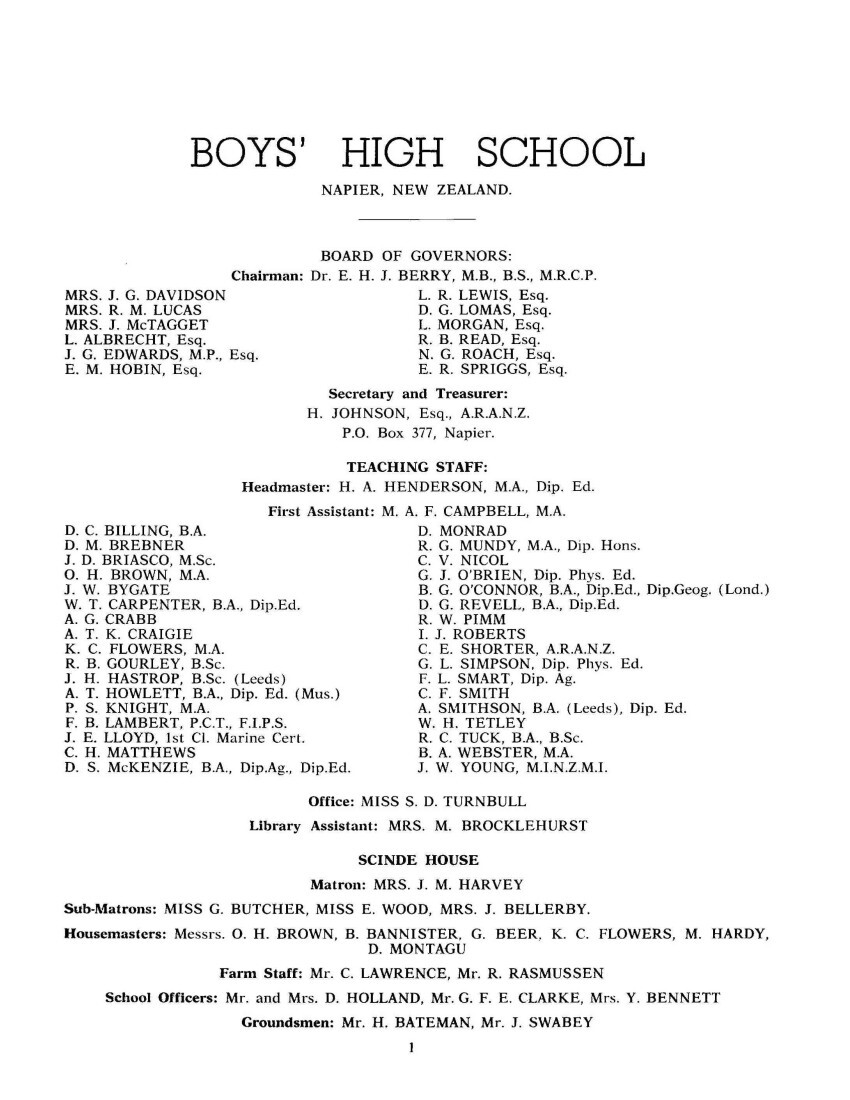
Page 2
SCHOOL OFFICERS
PREFECTS. – E. W. McGregor (Head), R. Chin (Deputy Head), D. H. Angove, C. B. Frame, J. K. W. Isles, W. A. Larsen, D. P. J. Marshall, A. D. McDougall, A. J. Mitchell, W. W. H. Nicholas, A. J. Schmidt, K. F. Seuseu.
SCINDE HOUSE PREFECTS. – E. W. McGregor (Head), N. W. Dobson, B. A. Kells, A. J. Mackintosh, A. J. Mitchell, K. F. Seuseu.
SCINDIAN COMMITTEE. – J. K. W. Isles (Editor), W. W. H. Nicholas (Associate Editor), D. B. Ferguson, C. Lum, E. E. Robinson, Mr. R. G. Mundy (Staff representative), Mr. G. L. Simpson (Business Manager); Photography: Mr. B. A. Webster, B. R. Baudinet, P. Morrin, A. J. Mackintosh, D. O. McDonald, J. W. Sinclair.
LIBRARY. – Librarian: Mr. A. T. Howlett; Assistant Librarian: Mrs. M. Brocklehurst; Senior Assistant: J. W. Potter.
DEBATING. – Master in Charge: Mr. B. G. O’Connor; Leader: A. J. Schmidt.
CRUSADERS. – Leaders: Mr. R. M. Yeoman, Mr. R. G. Mundy; Junior Leader: J. R. Irwin; Secretary: K. W. Barnes.
YOUNG FARMERS’ CLUB. – Adviser: Mr. D. S. McKenzie; Chairman: E. W. McGregor; Secretary: H. T. Pearse; Committee: N. W. Dobson, J. W. Sinclair.
ATHLETICS. – Master in Charge: Mr. C. H. Matthews; Captain: C. B. Frame.
HOCKEY. – Master in Charge: Mr. D. G. Revell; 1st XI Captain: I. T. Turbitt.
INDOOR BASKETBALL. – Master in Charge: Mr. P. S. Knight; Captain: D. P. J. Marshall.
LIFE-SAVING. – Master in Charge: Mr. R. C. Tuck.
ROWING. – Master in charge: Mr. G. L. Simpson; Captain: L. Karatau.
SHOOTING. – Master in Charge: Mr. W. T. Carpenter; Captain: R. Chin.
SOCCER. – Master in charge: Mr. C. Smith; Captain: A. J. Schmidt.
SOFTBALL. – Master in Charge: Mr. J. D. Briasco.
SCINDE HOUSE SOFTBALL. – Master in Charge: Mr. A. T. Howlett; Captain: E. W. McGregor.
TENNIS. – Master in Charge: Mr. C. E. Shorter; Captain: C. B. Frame.
CRICKET. – Master in Charge: Mr. D. G. Revell; House Cricket: Mr. B. G. O’Connor; 1st XI Captain: W. A. Larsen.
RUGBY. Master in Charge: Mr. R. C. Tuck; 1st XV Captain: E. W. McGregor.
DUX LUDORUM COMMITTEE. – Headmaster, Mr. M. A. F. Campbell, Mr. D. G. Revell and Prefects.
SCHOOL CADETS. C. O.: Squadron Leader D. G. Revell, E. D.; R. S. M.: E. W. McGregor.
PIPE BAND. – Master in Charge: Mr. K. C. Flowers; Pipe Major: G. Lydford.
HOUSE CAPTAINS. – Clyde: C. B. Frame; Colenso: J. M. C. Piper; Hawke: L. J. M. Campbell; Heretaunga: M. J. Girvan; Napier: J. K. W. Isles; Scinde: E. W. McGregor.
CONTENTS
Editorial 3
Mr. H. A. Henderson 4
The New Headmaster 7
Royal Garden Party 7
Staff Notes 8
Board News 11
Parents’ League 11
School Diary 12
Visitors to the School 13
Rotary Vocational Talks 15
Examination Results 16
Prize List, 1962 16
Prefects’ Notes 18
6A Notes 21
Debating and Public Speaking 21
Memorial Library 22
Music 23
Pipe Band 23
Art Club 24
Drama Club 24
Crusaders 24
Stamp Club 26
Top Marks Quiz 26
Farm Notes 27
House Notes 28
Military Cadets 31
A. T. C. Notes 32
Rugby 32
Mr. Michael Shrimpton 38
Cricket 39
Athletics 43
Athletic Sports Results 44
Physical Education 48
Harriers 49
Hockey 49
Indoor Basketball 50
Rowing 53
Shooting 53
Soccer 54
Softball 55
Swimming 55
Swimming Sports Results 56
Tennis 58
Acknowledgements 58
Open Column 59
Letters to the Editor 62
School Roll 64
Old Boys’ Notes 67
Obituaries 69
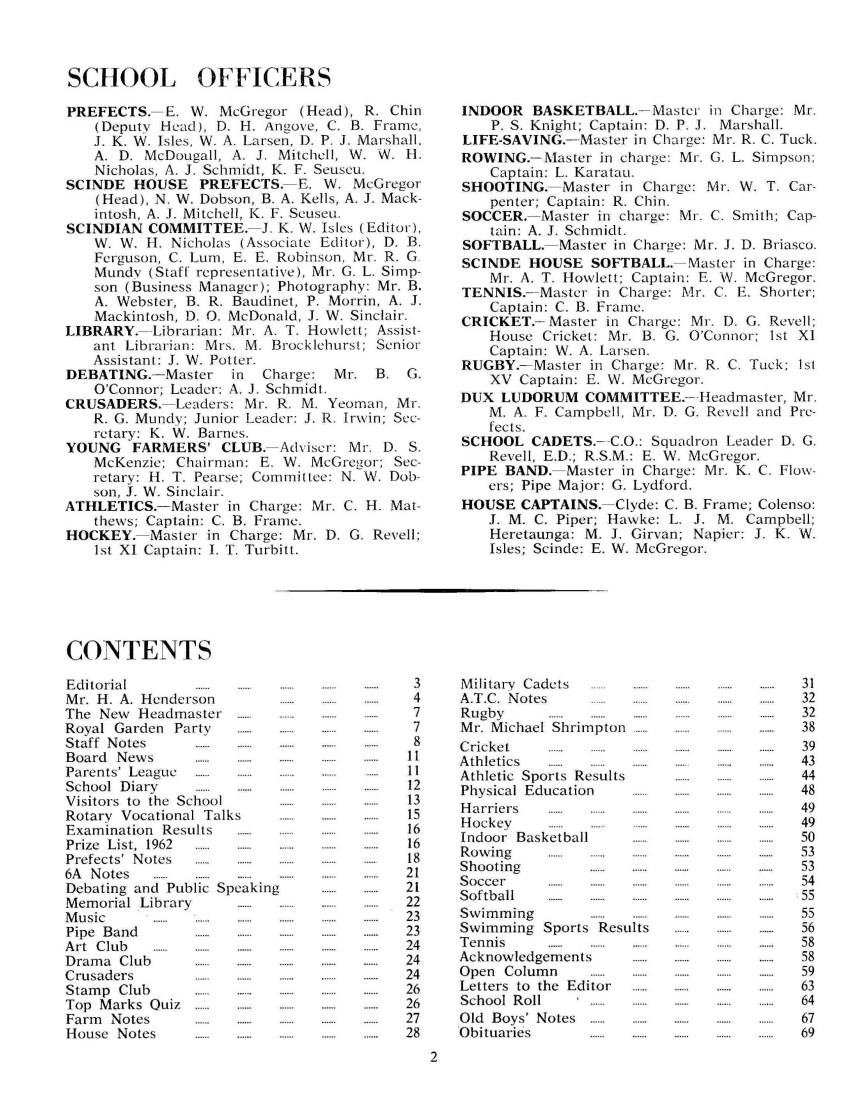
Page 3
EDITORIAL
Racial struggles have been to the forefront of the world’s news for the last year. In the most isolated of communities jealousies and hatreds have become rampant, directed, for the most, against Europeans. However, the brotherhood of black nations is not so cohesive as African Dictators are wont to suggest. The difficulties which have arisen in the Congo are testimony to this, reflecting the futility of imposing Western systems of government on an essentially tribal administration. By devious methods men who are no more than political henchmen have been able to gain power and use it unscrupulously against European and Indian settlers as well as against their political opponents. Rulers such as Nkrumah of Ghana and Kenyatta of Kenya are not only determined to rid their countries of foreign influences be they good or bad, but also to remove any opposition. Cries of Colonialism dominate most United Nations debates yet very few Colonies remain in the world; although Indonesia, one of the strongest opponents of “Colonialism”, has been laying claim to numerous peripheral territories.
As these newer nations come into power, forces of nationalism and religious consciousness are awakened and brought into conflict with a desire for material wealth. In spite of conditions of oppression in South Africa the prosperity of South African natives, as compared with that of neighbouring free states, is such that hundreds of natives cross into South Africa every day. Why is it that these freedom-loving Africans should vote with their feet for South Africa? Communism is such a powerful force at the moment because it offers immediate permanent material benefits to under-developed countries, yet the doctrines of communism do not hold much academic appeal to many Africans, who are attracted by the possibility of a full stomach. South Africa is not a Communist state but it does use totalitarian methods in achieving security within the nation: methods which only slightly offset the desirability of being well fed and well housed. We may not condone the policy of apartheid in South Africa, yet we can only admit that the Government of South Africa is giving its natives a higher degree of prosperity than many other native races in the world.
A different situation exists in the United States where Negroes are a minority race but in areas where most Negroes are resident they form, in many places, the predominant section of the community. Much of the antipathy between the two races is caused by the growing economic power of the Negroes and an accompanying rise in social status. By virtue of their numbers, the Negroes impose a strong influence on the economy of the South. The difficulties forced on Negroes by Governments of the Southern States are a source of justifiable grievances, for Negroes are in most ways equal to their white neighbours, except in the sport and entertainment fields, where they are superior. They have accepted a European mode of living and are educated to a standard equal to those white Americans in a similar economic class. It is absurd to insist on similarities between Africans and American Negroes for the latter have been exposed for too long to another environment to retain many of their former characteristics. Educated Americans realise now that Negroes must be accepted as equals but, unfortunately, the lower classes of Southerners refuse to countenance the idea, partly because of traditional beliefs but more likely for fear of losing their jobs. In essence, fear of loss of material benefits is probably the basic cause of most racial conflicts.
There can be no hope of an end to these struggles until people are prepared to accept members of another race as individuals first and Europeans, Negroids or Asians secondly. It is only too easy to put a tag on people by which they can conveniently be dismissed. To treat other races as equals we must mix more readily with them, to find out their way of living and also to discover them as individuals. With travel so easily made there is far more opportunity for modern New Zealanders to mix with other races as compared with our Grandfathers’ days.
Next year at Napier Boys’ High School we shall have an opportunity to meet two young Malayan students who have come to this country to improve their education. If we can forget that they are Malays and treat them just as friends, then our education will benefit also. Our own Headmaster is to take up an appointment in Sarawak, an appointment, Mr. Henderson feels, which will also improve his education. Dr. Fox, an old boy of the school, needs young men to carry on in the Pacific Islands welfare work amongst the natives. Although the monetary rewards would be negligible the amount of satisfaction gained would more than recompense for this, and help in a small way to iron out racial struggles.
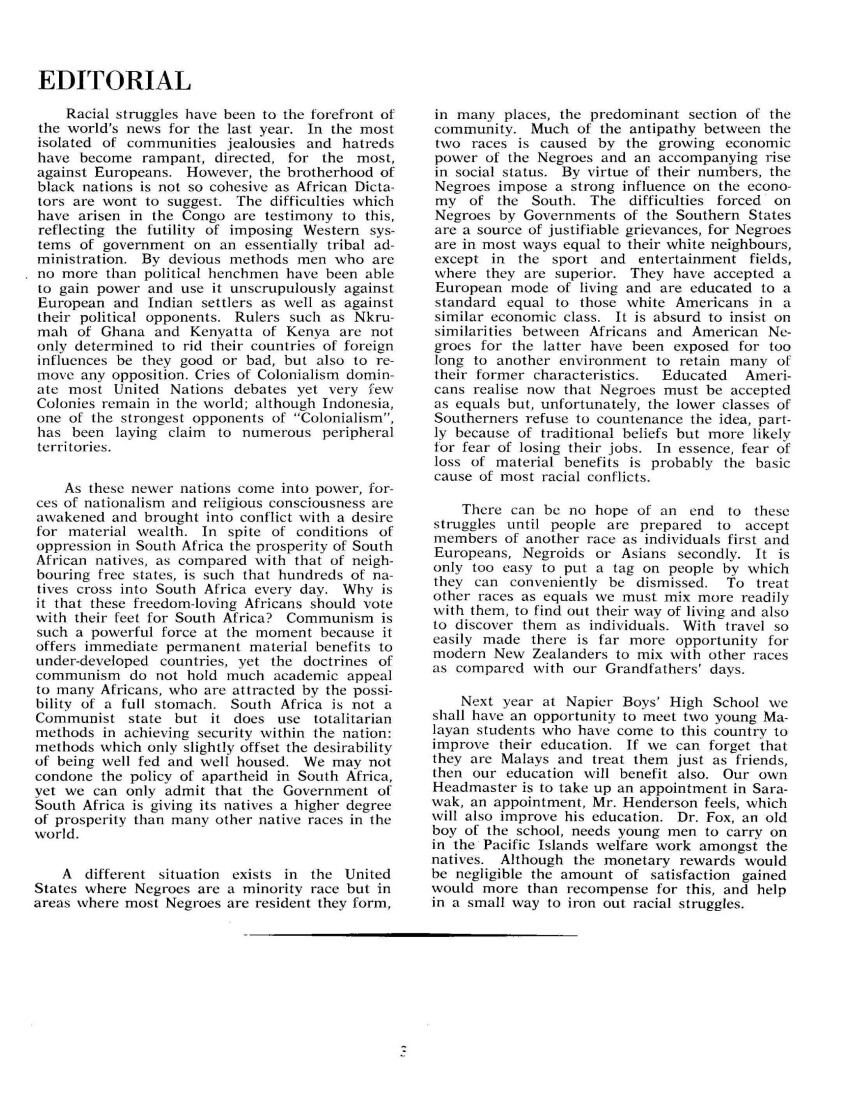
Page 4
A GREAT HEADMASTERSHIP CONCLUDED
“Mr. Snell has been mentioned by me in Hall before. He gives us an example of greatness achieved by tremendous hard work and effort.” So spoke Mr. Henderson in introducing Peter Snell to the school on March 8th, 1963. Mr. Henderson has often made similar stirring statements in assembly about the ideals of sport and life.
Mr. H. A. Henderson, M.A., Dip. Ed., came to the school with an imposing record in sport. He had represented Hawke’s Bay as a forward in rugby, and put the shot in Australia for New Zealand Universities against Australian Universities. He had won singles championships at Dannevirke in lawn tennis and golf. He had also served, and has served again, as President of the Hawke’s Bay Rugby Football Union. From his family, who came as Scots pioneers to Canterbury, he had inherited courageous and manly ideals of character which have exerted a great influence in this school.
During his term of office from February, 1952 to February, 1964, it has been characteristic of Mr. Henderson, our retiring headmaster, that he seized, whenever possible, the opportunity in assembly to make a large-minded and positive approach to questions of tone and discipline in the school. The well-timed witticism or generous speech drawing illustration from the field of sport proved more effective than any sharp complaint could possibly do. When, however, the occasion arose fur a just rebuke it was, by contrast, all the more forceful, dignified and impressive.
In 1952 Mr. Henderson immediately threw himself into the do-it-yourself project of building the school baths. After tremendous hard work by many helpers, the baths were opened in 1954. With the growth of the school. Mr. Henderson has also pushed ahead the building of the Memorial Library and the Gymnasium. It seems not out of keeping with his character that these two buildings, which owe so much to others as well but which have been erected during his head- mastership, should be a place for reverence and a place for vigorous exertion. Since 1960, he has planned and persevered towards an enlargement of the assembly hall, which makes an important contribution to school life. One thinks of the memorable occasion when Mr. Henderson conducted Lord Cobham through the crowded assembly hall, and when these two very considerable speakers addressed the school. Now the assembly hall is soon to be made larger for the school roll which has grown from about 500 to 830 during Mr. Henderson’s term as Headmaster.
While the school’s buildings have grown, Mr. Henderson has not let its educational policy stagnate. In 1954 he introduced bold experiments to classify the third form entrants and to challenge the scholarly and unscholarly alike. His policy has proved itself over the years, being kept up-to- date by constant rethinking and new planning.
In 1955 Scinde House, the school hostel, saw the beginning of extensive new building. Mr. Henderson has built up the hostel from the scattered and temporary buildings left from the earthquake and war years to the present well planned home for 187 boarders. The headmaster’s responsibility for the hostel has called for personal guidance to many boys under his care. In this he has been tireless, genial and resourceful. The present excellent spirit of Scinde House is largely a fruit of his massive understanding of hostel life.
“He has given this and many other schools of of his finest throughout his life,” said the senior member of the team of inspectors in assembly on July 10th, 1963. Our headmaster has also had a long and fine career in Rotary and in numerous committees of service to the public.
At the beginning of the second term, when the school was glad to welcome Mr. Henderson back with his hearing restored, he announced that he would be leaving us. On August 7th, he said that he would hear the result of the next Polson Banner match across the world. On October 7th, he spoke in assembly of new contacts with a Malaysian school opened under the Colombo Plan. We began to understand that with his teaching service completed in New Zealand, he was rising to a fresh challenge with the same spirit that he had so often recommended to us. We expect that his leadership will make an impact overseas, reaching out to different and demanding fields of service.
It will never be known how many newcomers to the staff have been made to feel at home by Mrs. Henderson’s kind and gracious interest. At least one member of the staff can say here that Mrs. Henderson’s words of welcome and friendly conversation made up for much of the strangeness of a new school. The more observant have often noticed how powerful has been Mrs. Henderson’s concern behind the scenes for the school’s well-being.
Now, with twelve successful years of today life completed, Mr. and Mrs. Henderson leave us to take stock of the greatness of their period of service as a whole. Not at least, it will be remembered that they went away from the Napier Boys’ High School with the good wishes of all to face new and challenging horizons.
It was announced on November 12 that Mr. Henderson would take up an appointment as
headmaster of the multi-racial, co-educational school of Tanjong Lobang, in the town of Miri, Sarawak. Mr. and Mrs. Henderson leave for Sarawak in December.
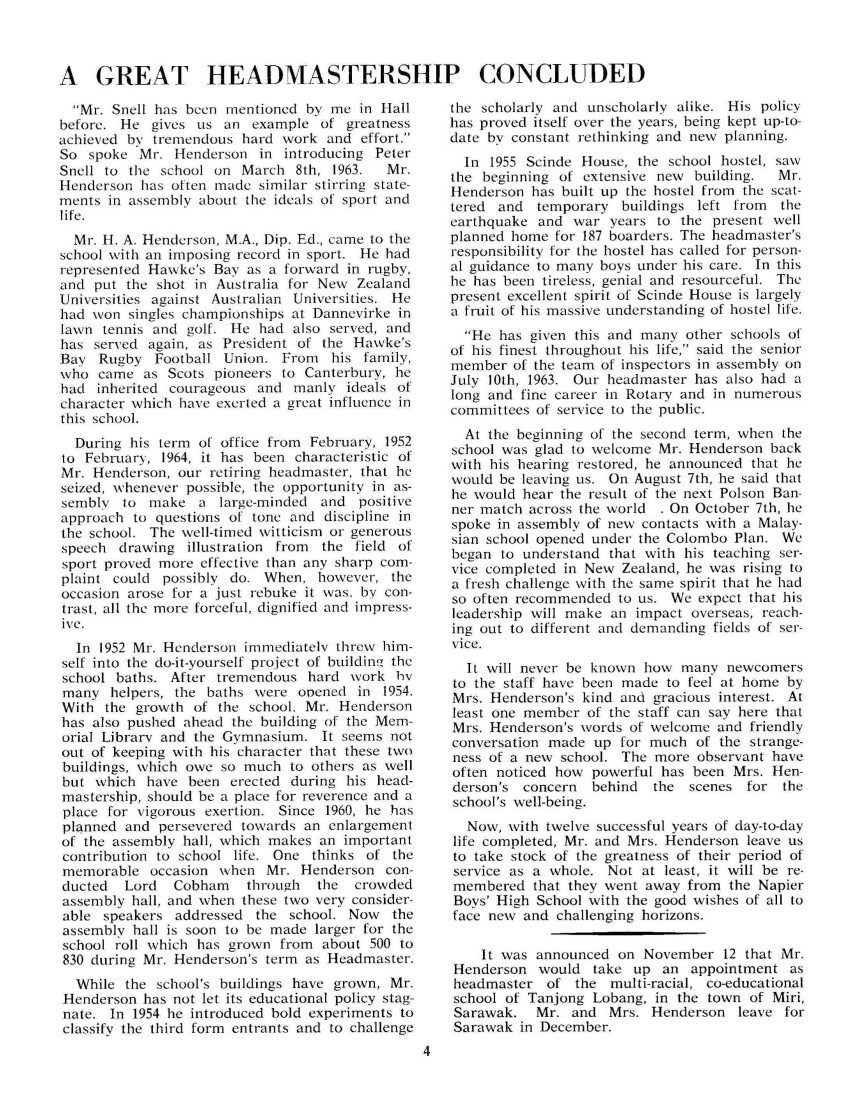
Page 7
THE NEW HEADMASTER
Mr. D. P. CAIRD, B. A., Dip. Ed.
The gift of leadership and an interest in boys as individuals are notable qualities of Mr. D. P. Caird, appointed to be the new headmaster by the Board of Governors on October, 21.
Mr. Caird has been First Assistant and acting Headmaster of the Shirley Boys’ High School. This is a new and modern school in Christchurch, with grey uniform and colours of light blue and yellow.
While a student at Victoria University of Wellington, Mr. Caird coached the Colts Rugby team. He was also a member of the 1st XV and 1st XI at Wellington Teachers’ College.
In 1945, Mr. Caird joined the staff of the Palmerston North Technical High School, where he coached the 1st XV and 1st XI. As careers adviser he was known for his painstaking efforts to help every boy to get a suitable job on leaving school. He was captain of Palmerston North Technical Old Boys’ Senior “A” Cricket team, and joined in amateur play productions with the Repertory Society.
In 1954 Mr. Caird took up a position of responsibility at Feilding Agricultural High School. With his experience in dramatics, he produced major comic operas by Gilbert and Sullivan at the school. Continuing to coach the 1st XI, he helped in management of rugby and cricket.
Since 1958, Mr. Caird has been teaching sixth form English, History and Book-Keeping at Shirley Boys’ High School. He has continued to help actively with school plays, and is president of the East Christchurch-Shirley Cricket Club.
Mr. Caird’s wide sporting interests are already obvious. It will be noticed how much of his time he has given to coaching. Many schoolboys have found him a friendly and approachable sports coach. He has been a phys. ed. teacher and has trained swimming and athletic teams.
The graduation this year of Mr. Caird’s eldest daughter brings the number of graduates in the family to three, for Mrs. Caird also holds a university degree. One son is at university, another is about to enter the sixth form, and two younger children are at primary school.
HE SERVED THE QUEEN FROM A SILVER SALVER
Ewan McGregor was one of 35 head prefects who had afternoon tea with Her Majesty the Queen and Prince Phillip on the front lawns of the Hastings Boys’ High School, the first Sunday after the beginning of the school year. The weather was perfect for an outside function, even though the hall had been prepared in case of wet weather.
The prefects met the Minister of Education, Mr. Tennent, and were interviewed by the N.Z. Broadcasting Corporation. Then, as a special honour to N. B. H. S., Ewan McGregor was briefed to serve tea to the royal couple.
The Napier group were placed at Table No. 1. There were five of them, the head prefects of N. G. H. S., N. B. H. S., Colenso and Hukarere. They heard the royal couple coming by the roars of the crowd, and almost at once Linda Farrell and Kim Jarvis of Hastings, who had dined with the Queen on board “Britannia,” introduced Ewan to the royal pair.
The Queen seemed pale and tired after the public procession across to Hastings. She spoke briefly and moved on. The Duke, however, was in his element, and took twice as long to get round the seven tables. He asked Ewan how big our school was.
The Royal Visitors then moved to the centre table and Ewan McGregor served them.
“I was a bit of an exception, in that I did eat something at our table. Most of the others were too nervous,” said McGregor. “On our table there was a big pavlova cake, four inches thick and cut in big slices. There was nothing to eat it with, and we were not game to try. Then Prince Phillip came round and we explained about it to him. He said he was not game to attempt the pavlova cake either. The Duke asked us about our future, and I was the only one not going to University. I said I was going to be an old farmer, and the Duke was very interested. He asked me where I came from and chatted about farming. Then, with advice to make the most of our education, he moved on. The only adults with Her Majesty were the Minister of Education, a Lady in Waiting and an Aide-de-Camp.”
At the end of afternoon tea, Her Majesty and the Duke said good-bye to the group and walked to their car. The Head Prefects followed them across the lawn. There was strictly no crowd near the gate, as the area was cordoned off for at least 100 yards. The Prefects gave cheers, the Queen and the Duke waved and drove away. Most of the prefects now felt hungry and went back to finish off the afternoon tea, but by this time they were being swamped by the Press.
Lynette Sutton (N.G.H.S.) and Ewan McGregor came back over to Napier, where all the Napier schools were gathered on the wharf to farewell the “Britannia.”
“It was rather amusing,” laughed McGregor. “We went round to the wharf and we were told off at the wharf by the police for being late. The policeman wanted to know where we had been and we said that we had been having afternoon tea with the Queen. He said, ‘Don’t hand me that rubbish,’ and let us go onto the wharf.”

Page 8
STAFF NOTES
We were happy to welcome at the beginning of the year Mr. K. C. Flowers, M.A., who filled one of the vacancies created by Messrs R. Ford and L. Rolls. Mr. Flowers came to us from Christchurch, where he had completed his training, but he is no stranger to Hawke’s Bay, being an Old Boy of Dannevirke High School. As a housemaster he is doubly welcome, since the ranks of the housemasters have been sadly depleted by the loss of Messrs K. Tremain, D. Montague and L. Rolls, whose departures were greatly regretted by the boys of Scinde House. Becoming a housemaster must have played some part in helping Mr. Flowers settle in and find his feet amongst us as quickly as he has. We congratulate him on his engagement, and hope that this happy event presages a long stay with us.
Owing to the rise of the school roll we found ourselves short of masters, but it was not until the start of the second term that the first of these vacancies was filled with the arrival of Mr. F. Smart from Dannevirke High School. An Old Boy of the school and a former school librarian and housemaster, he left us in 1957 to take up full-time teaching in the Dannevirke High School. Even though we were inclined to welcome him as such, it would scarcely be fair to Mr. Smart to refer to him as a prodigal son, since he has put the intervening years to the very best use and returned to us a fully-fledged teacher, specialising in agricultural subjects.
Later in the term Mr. G. O’Brien, who had not accepted a relieving appointment with us. Mr. O’Brien is primarily a physical education specialist, but is also helping with the teaching of social studies and mathematics to junior forms and doing remedial work in reading and mathematics where required. Mr. O’Brien will no doubt have found considerable variations in methods and curricula from those he has been used to in Australia, but we trust he has found the change to his liking and that New Zealand school life will measure up to his expectations.
We shall unfortunately have to say good-bye to Mr. D. Billing, B. A., at the end of the year. We shall be extremely sorry to see him go. We feel sure that he has found his work congenial, particularly his specialist work with senior history pupils during the past three of four years. A short notice about Mr. Billing’s interests while he has been with us appears elsewhere in this issue. We thank him most sincerely for all that he has done.
Miss Turnbull was away on sick-leave for part of this year. We are very glad indeed to see her back again in the office after her stay in hospital. Miss Turnbull’s deputy was Mrs. Mackay, whose cheerful way of coping with unfamiliar office affairs was much appreciated. We congratulate Mr. and Mrs. C. F. Smith on the birth of a daughter on September 29.
Finally, we extend to Messrs. Monrad, Simpson and Shorter our very best wishes for success in the degree examinations they are facing this year.
MR. D. C. BILLING, B. A.
From 1959 to 1961, Mr. Billing lived as a hostel master. He has already adorned the pages of “The Scindian,” photographed as he was striding out from Scinde House in an Austrian hat and snow goggles for a hike. No doubt such hardy sports date from his years in the bracing climate of Otago. There he read proofs for “The Otago Daily Times” and taught at Waitaki Boys’ High School.
In his five years of much appreciated service here, he has coached the third cricket eleven and fifth grade rugby. This year he strengthened the firing-power of our Military Cadets with a mortar group, after qualifying with high marks in a mortar course at Burnham Camp.
There was once overheard, late at night in a storm-battered mountain hut, a whispered conversation between two N. B. H. S. third-formers, warmly praising Mr. Billing as a teacher. Now he joins the staff of Burnside High School, Christchurch, to take special responsibility for sixth form history. We hope that his sturdy sense of humour will survive the change to a coeducational school, and we wish him continued success in his career as a historian and teacher.
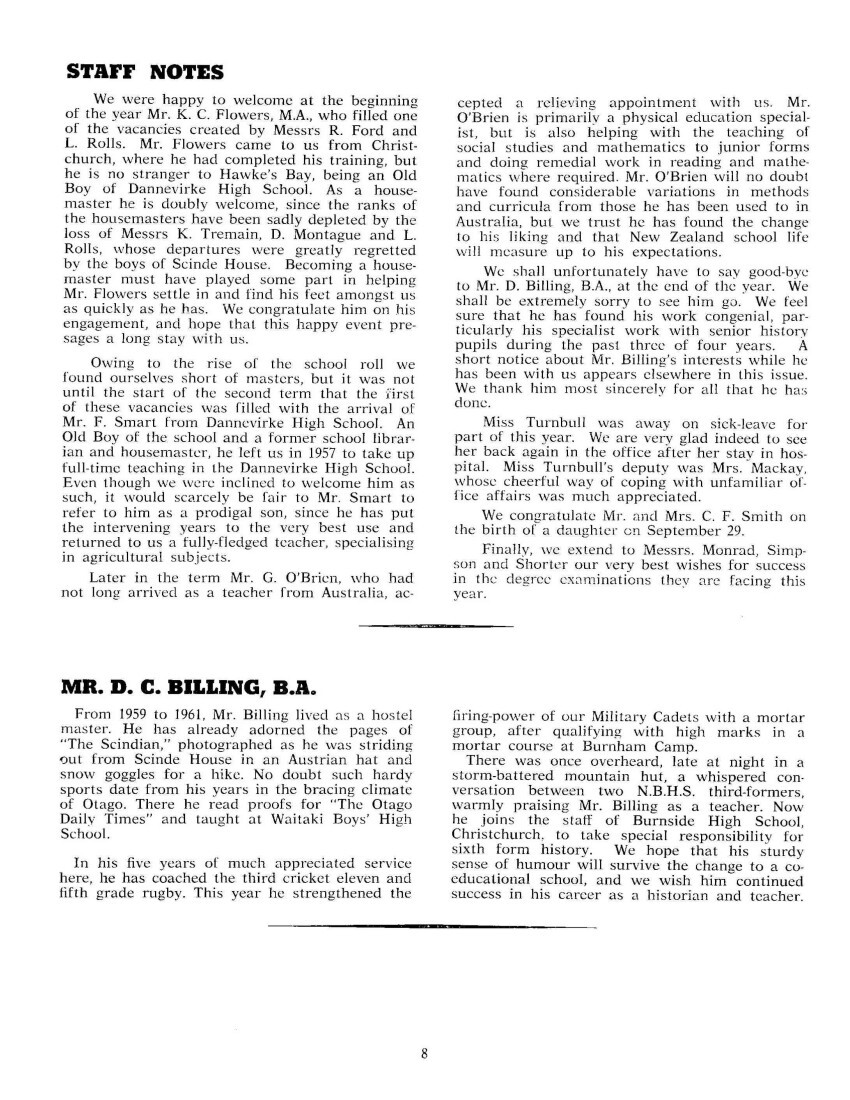
Page 9
THE STAFF
Back Row: Messrs. A. T. Howlett, K. C. Flowers, C.F. Smith, J. H. Hastrop, A. Smithson, A. G. Crabb, D. C. Billing, W. T. Carpenter.
Middle Row: Messrs. D. M. Brebner, P. S. Knight, A. T. K. Craigie, C. V. Nicol, R. B. Gourley, F. L. Smart, J. E. Lloyd, D. Monrad, O. H. Brown, J. W. Young. C. H. Matthews, R. W. Pimm, J. D. Briasco, [. J. Roberts.
Front Row: Messrs. F. B. Lambert, W. H. Tetley, D. G. Revell, D. S. McKenzie, Miss D. Turnbull, Mr. H. A. Henderson, Mrs M. Brocklehurst, Messrs. M. A. F. Campbell, J. W. Bygate. B. G. O’Connor, R. C. Tuck, B. A. Webster.
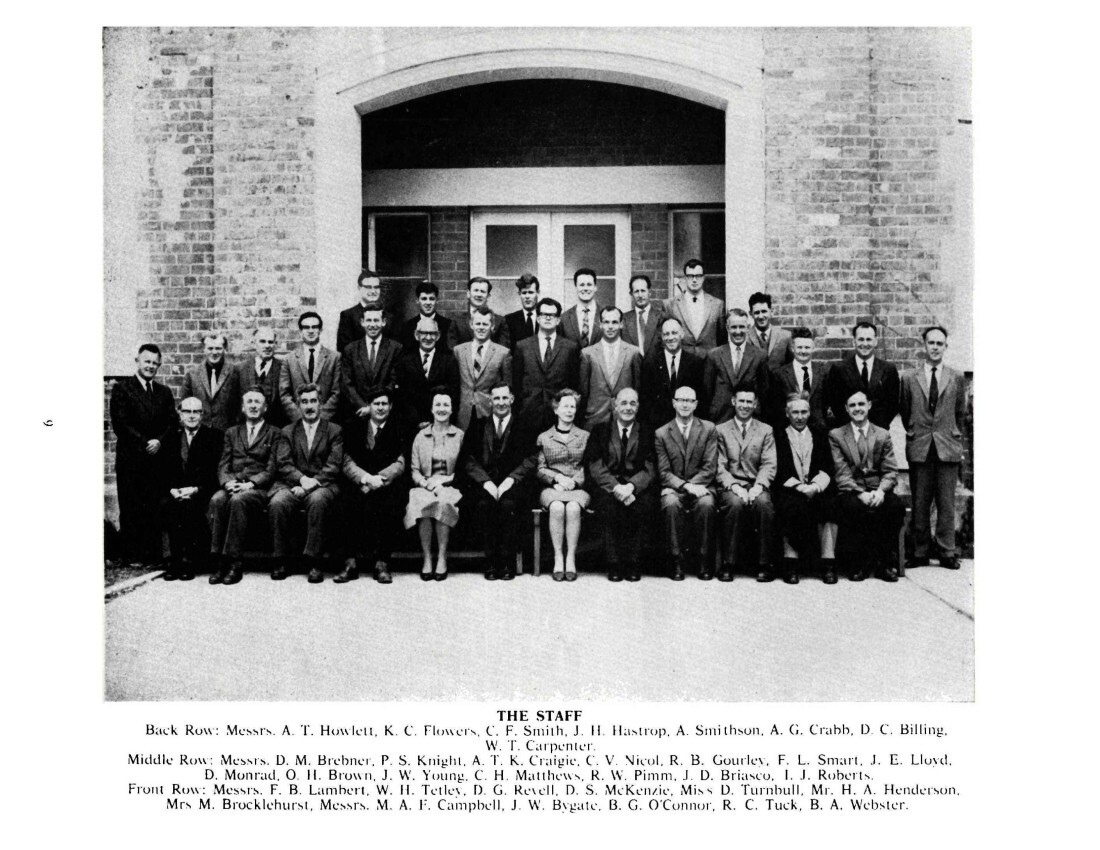
Page 11
BOARD NEWS
This year has seen big preparations for changes planned by the Board of Governors.
In the first term a house was built on the north-west corner of the school grounds, to be available for the Headmaster. The present Headmaster’s residence is being considered for conversion into self-contained flats for married housemasters. In front of this house, the battered old hedge has been replaced with a low concrete-block wall.
At the south end of the grounds, more space is being cleared. The rifle range was demolished early in the year, and a new range is to be built. The groundsman’s shed will be removed and a new one will be built near the pumping station on Te Awa Avenue. Thus a new area of land can be joined to the south sports grounds. These grounds have been rather disturbed by the sinking of a new three-inch well and the digging of drains, but the surface is now settling down again.
Plans for the extension of the Assembly Hall have been approved, and the work is to begin early next year. The auditorium will be enlarged. Additions will comprise a music room, kitchen, changing room and large storage space. Nearby, the wall space which is now used for the notice boards will be taken up for part of the new Assembly Hall, so a large exterior notice board with sliding 1/4” polished plate glass has already been put up in the quadrangle near the Library.
The workshops were ready for full use at the beginning of this year, after modernisation costing approximately £12,000. An Indian lathe has now been purchased for the workshops.
Next, the modernisation of Lab. D has been approved. It will be re-designed for the up-to- date teaching of 5th and 6th form physics, N. Z. C. E. mechanics and strengths of materials. Work is also being done on the Art Room, which is to acquire a potter’s wheel and a pottery kiln.
Valuable work for the school received honour when tribute was paid to Mr. C. F. Payne, who died in July this year. As a member of the Board until 1960, Mr. Payne was active in raising money for the baths, and in helping to obtain the memorial window for the library.
Mr. Harold Holt, a former member of the Board, was honoured by the Queen with the O. B. E. in the Birthday Honours. He received congratulations at a School Assembly on July 2.
PARENTS’ LEAGUE
Officers of the League for 1963 are: President, Mr. J. Tucker; Vice Presidents, Mrs. K. Frame, Mr. F. B. Baudinet; Secretary, Mr. J. W. Schmidt; Treasurer, Mr. J. D. Olsen. Committee: Mesdames Campbell, Bull, Farquhar, Baudinet, Scott, Absolom, Jessep, Carrol, Tolley, Lee, Darragh, Douglas, Heath, Knight; Messrs. Taaffe, Morrin, Darragh, Dobson, Knight, Malcolm, Smith, Farquhar, Campbell.
The League has not had any particular financial objective this year, and activities have been confined to a series of meetings planned to bring parents closer to school affairs, and to a greater appreciation of the work the school is doing for our sons. Of the eight meetings planned for the year, five introduced two or more masters, who either addressed meetings or formed a panel for answering questions.
An innovation in 1963 was the production and distribution to all parents of a card carrying the dates and subject of all Parents’ League meetings, and the main events on the school calendar. This was well received and has helped parents to plan attendance at both League and School events.
The strongest impression of the year’s activities is the association of Staff and Parents in all League affairs. The Masters have willingly given time to help parents to a better understanding of school affairs, and few parents can doubt that their sons are in good hands at our school. Of all the meetings held during the year the best attended was the “Meet the Masters” night during August, when few Masters were free by supper time, and attendance exceeded 200.
On the social side the Ladies’ Committee, under the enthusiastic leadership of Mrs. Frame, has provided afternoon teas and suppers whenever these have been required. The ladies, with their flair for providing tasty and ample suppers, were sadly missed at the July meeting, which was for fathers only, and at which fathers managed to provide tea and biscuits!
Parents, through their Executive, record their sincere thanks to His Worship, the Mayor of Napier, Mr. P. Tait, Mr. K. Tremain (a 1963 All Black), Dr. Overton (Medical Officer of Health), Mr. Henderson (the Headmaster), and all staff members who have contributed to the success of meetings. Those parents who have not attended meetings, for whatever cause, have missed something this year. The Officers of the League commend to all parents the value of membership, and the support of attendance at meetings and other League activities, all of which are planned to. strengthen the bond between school and home.
These notes would be incomplete without reference to the pending retirement of the school’s Headmaster. Parents will no doubt have the opportunity to farewell Mr. Henderson; but it is fitting that we should now record our very real appreciation of his capable leadership of the school, kindly yet firm guidance of our sons, and friendly co-operation with the League. We wish Mr. Henderson well and trust that for some years he will find a rewarding satisfaction in whatever sphere his future activities are directed to.
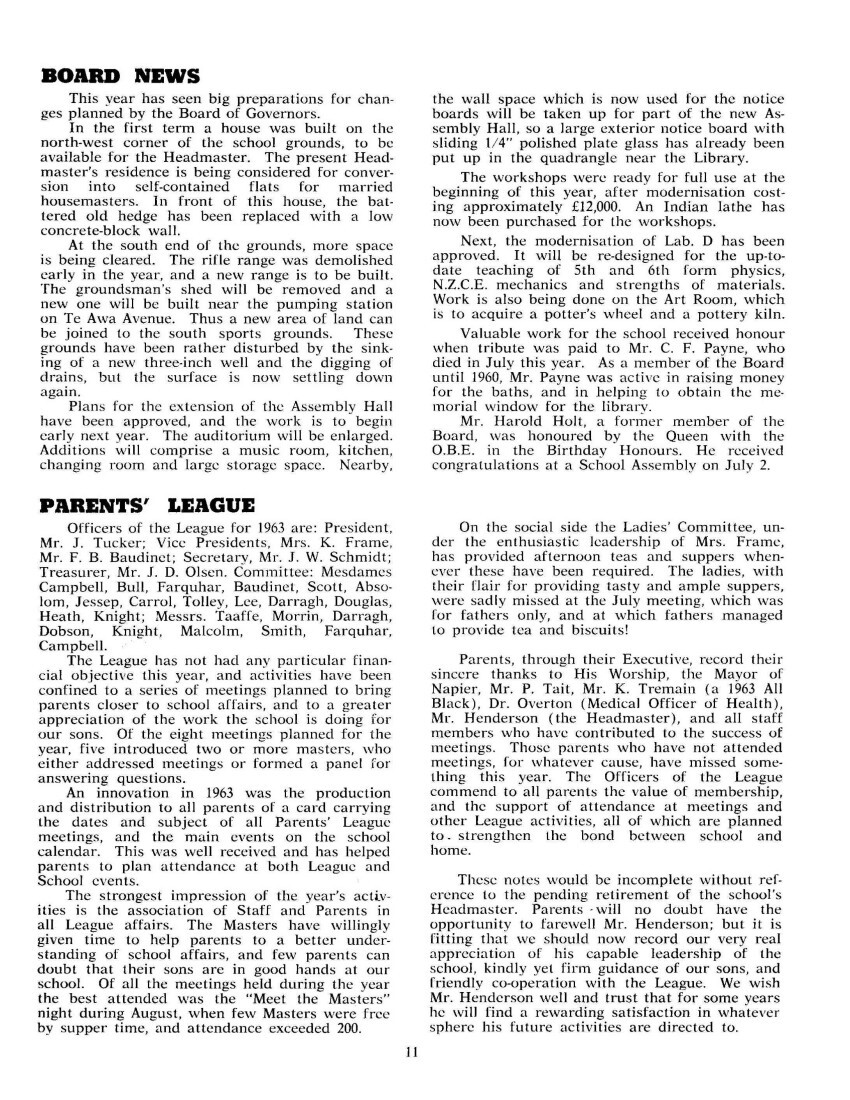
Page 12
SCHOOL DIARY
FEBRUARY –
5 – School opened.
11-15 – Barracks Week.
20 – Swimming Sports Preliminaries
28 – Swimming Sports Final
MARCH –
4 – Visit to school by talented American Pianist, Robert Webber.
8 – Don Clarke and Peter Snell addressed school.
12 – Day Boys v. Boarders Cricket Match.
14 -15 – Athletic Sports.
16 – North Island Secondary School Swimming Sports at Palmerston North.
20 – 21- 1st Cricket XI v. Gisborne B. H. S. 1st XI at Napier.
Tennis Team v. Gisborne B. H. S.
Tennis Team at Napier.
22 – Prefects’ Dance.
25 – 1st Cricket XI v. Palmerston North 1st XI at Palmerston North.
27 – Visit by Mr. and Mrs. Ackert.
28 – New Zealand Players’ Quartet.
29 – Visit by Central Hawke’s Bay College Tennis Team.
30 – Inter-Secondary Schools’ Athletic Sports at Napier.
APRIL –
3 – Inter-House Shoot.
11-17- Easter Break.
18 – School Steeplechase.
24 – School Anzac Day Service.
25 – Anzac Day Break.
MAY –
4 – Secondary Schools’ Music Festival.
8 – Military Drill.
9 – Visit to school by Mr. Ian Axford, Ph.D.
10 – Mr. Tait addressed school. First term ended.
27 – Second term began.
JUNE –
14 – Thirty boys attended concert by cellist, Guy Fallot.
19 – Central Hawke’s Bay College Rugby and Hockey Teams visited school.
25 – Visit to school by Executive Committee of Old Boys’.
26 – Visit to school by Major Collins.
27 -1st XV v. Hastings B. H. S. 1st XV at Hastings.
JULY –
2 – Visit to school by Mr. Harold Holt, O. B. E.
8 -11- Inspectorial Visit.
12 – Half Term break.
15 -18 – Mid-year Examinations.
23 – Visit to school by “Otaki”’ Scholar, Graeme Catto, of Robert Gordon College, Aberdeen.
25 – 1st Hockey XI v. Gisborne B. H. S. 1st XI at Napier.
26 – 1st XV and Debating Team travelled to Gisborne B. H. S.
30 – “She Stoops to Conquer” presented by pupils of school.
AUGUST –
2 – 1st Soccer XI and 2nd XV travelled to Gisborne B. H. S.
7 – Visit to school by Palmerston North 1st XV and Debating Team.
12 – Visit to school by Mr. E. R. G. Steere.
14 – Wairarapa College 1st XV and 1st Hockey XI visited school.
15 – and 4th XV’s played Dannevirke High School’s 3rd and 4th XV’s at Napier.
20 – Field Day with Hastings B. H. S. at Hastings.
21 – Debating Team v. Hastings B. H. S. Debating Team at Napier.
1st Soccer XI v. Masters’ Soccer XI.
22 – Day Boys v. Boarders Rugby Match.
23 – Second term ended.
SEPTEMBER –
16 – Third term began.
18 – Mr. Walsh, M.P. for Tauranga, addressed school.
25 – Visit to school by Mr. Kelvin Tremain.
26 – Impromptu Speech Competition.
27 – Shooting Team travelled to Gisborne B. H. S.
OCTOBER –
3 – Tabloid Sports.
5 – Coleman Shield Shoot. P. T. A. Dance at Napier G. H. S.
9 – Members of H.M.N.Z.S. Royalist played school at Indoor Basketball, Cricket and Softball.
13 – Visit to school by Mr. H. G. G. Fownes.
16 – Visit to school by Mr. Rose, U. N. A. Secretary.
17 – 23 Fifth and Sixth Form Examinations.
25 – 28 – Show and Labour Weekend break.
NOVEMBER –
4 – Senior Prepared Speech. Singing Competition.
5 – Reading Competition.
6 – Chamber of Commerce Arithmetic.
12 – 14 – Third and Fourth Form Examinations.
18 – School Certificate Began.
22 – Physical Education Competition.
DECEMBER –
2 – School Certificate Ended.
3 – University Entrance Examinations began.
6 – Prize Giving.
9 – 10 – Military Drill.
11 – Field Day with Hastings B. H. S.
11-12 – 1st Cricket XI v. Hastings B. H. S. 1st XI at Napier.
2nd Cricket XI v. Hastings B. H. S.
2nd XI at Hastings.
12 – Day Boys v. Boarders Softball Match
13 – End of Term.
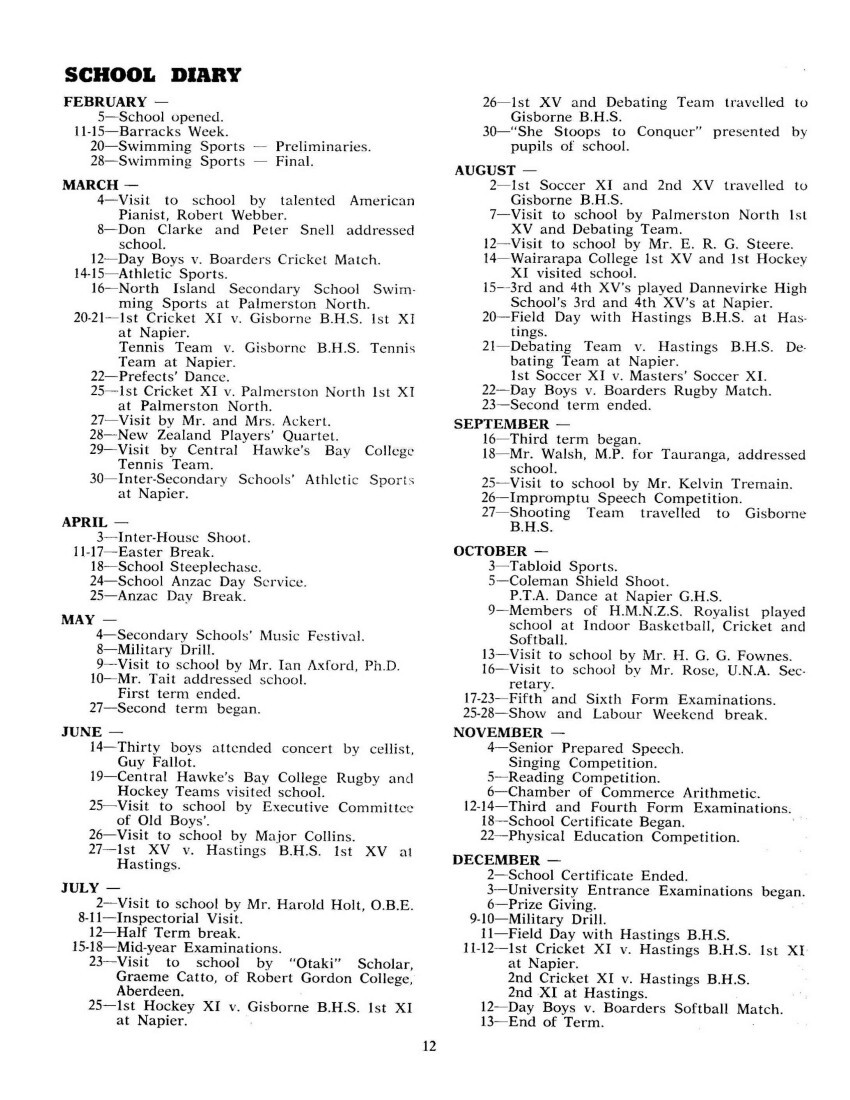
Page 13
VISITORS TO THE SCHOOL
DR. C. E. FOX
This year a visitor to the school handed Mr. Henderson a newspaper cutting titled “Forgotten Great New Zealander.” It told of Dr. C. E. Fox, M. B. E., who was at N. B. H. S. from 1892 to 1895, and who has seen a Melanesian Church arise in the Solomon Islands.
This great New Zealander with a passion for football and for scholarship is by no means forgotten here. In fact, Dr. Fox visited this school on February 21st this year.
The visit stirred Dr. Fox’s memories of the first “Scindian,” for he was its editor. He enlisted the help of Mr. Maurice Harrold, an old boy who was then a member of the staff. Mr. Harrold became probably the first old boy rugby All-Black, and president of the Old Boys’ Association in 1903- 1904.
When looking for a motto for “The Scindian,” Charles Fox approached the headmaster of that time. Mr. Wood suggested “Justum perficito, nihil timeto,” the motto of his own preparatory school in England. Thus originated our school motto, “Do the right and fear nothing.”
The first “Scindian” struggled against money shortage. Dr. Fox recalled that he sold his tennis racquet to get it published.
Dr. Fox only just missed appearing on our honours board as Dux Ludorum as well as Dux Literarum. A fine athlete and games player, he was captain of the cricket XI, a member of the rugby XV and of the tennis team, as well as champion athlete. Things at that time worked out so that the dux ludorum title fell to the winner of the long distance race. Starting from scratch, Dr. Fox lost the title to an athlete with a good handicap. The 1952 “Scindian” records Dr. Fox’s feats as a walker.
Now aged 85, Dr. Fox, M.A., Litt. D., has served Melanesia for 61 years. He played his last game of football when he was 74. It was a game of soccer. The ball came near him, he kicked it and scored a goal. This great scholar remarked that one should keep on playing games actively as long as possible.
“Dr. Fox has given his life to Melanesia, and ends without material possessions or wealth,” said Mr. Henderson, with whom Dr. Fox spent the evening. “But he has had a life of true success. The wealth that Dr. Fox possesses is the wealth of a rich personality. Those who share his company share his wealth too.”
“New Zealanders know something of Polynesians and one Melanesian people (the Fijians). They need to know more and to help more” wrote Dr. Fox for ‘The Scindian’ “This is the time when the people need most help as they take on the ways of civilisation: teachers (most of all), agriculturalists, doctors, geologists, engineers and carpenters, either in the service of the Missions or the Governments, with whom the pay is very good.”
Dr. Fox explained that the people would rather have New Zealanders come to them than any other Europeans, because New Zealand missionaries have been working among them for 100 years and New Zealanders fought for them in the war.
Writing from Taroaniara, British Solomon Islands, on September 15th, 1963, Dr. Fox was outlining for the Napier High School boys of today the need for New Zealanders. Anybody interested may contact the Secretary of the Melanesian Mission, 41 Shortland Street, Auckland.
“It is a very critical time,” continued Dr. Fox, “and it is important to New Zealand that these peoples nearest to them should be the friends of New Zealand. Communists come to them all the time to try to win them. Indonesia may go on taking over peoples and territories who have nothing in common with Indonesia. Now is the time when New Zealand could knit these peoples to herself in lasting friendship.”
Dr. Fox explained that the way to do so was to send men of all sorts who can lead by serving businessmen as well as others. He said that there are about 150 languages spoken by these people, of whom there are about a million, all rapidly coming to self-government. But no New Zealander would need to be a language expert, as English is used in all the schools.
PETER SNELL AND DON CLARKE
“It is not beyond the ability of any boy in this hall to reach top class in athletics,” said Mr. Peter Snell when he and Don Clarke came to assembly on Friday, March 8. “The boys present in this hall carry the future of athletics in Hawke’s Bay. Hostel boys have special opportunities of training in long-distance running.” continued Mr. Snell.
Mr. Snell told something of Arthur Lydiard’s training methods. The success of Murray Halberg after long training runs inspired confidence in John Davies and Peter Snell. The latter said that he was aiming at the running of 14 miles a day, and recently had run to Hastings to give a talk.
Don Clarke also commended this system of training for fitness. He said that he was following it to prepare for the All Black trials.
He went on to describe the forthcoming departure of the All Blacks in October. Their tour would take in Britain and Canada, and then land the players back for the strain of another football season in New Zealand.
“To all you boys I would say that it is not far from being a club representative to international standard,” concluded Mr. Clarke.
GRAEME CATTO
The New Zealand ship “Otaki,” which was sunk with all hands in the First World War, is commemorated by the annual Otaki Scholarship.
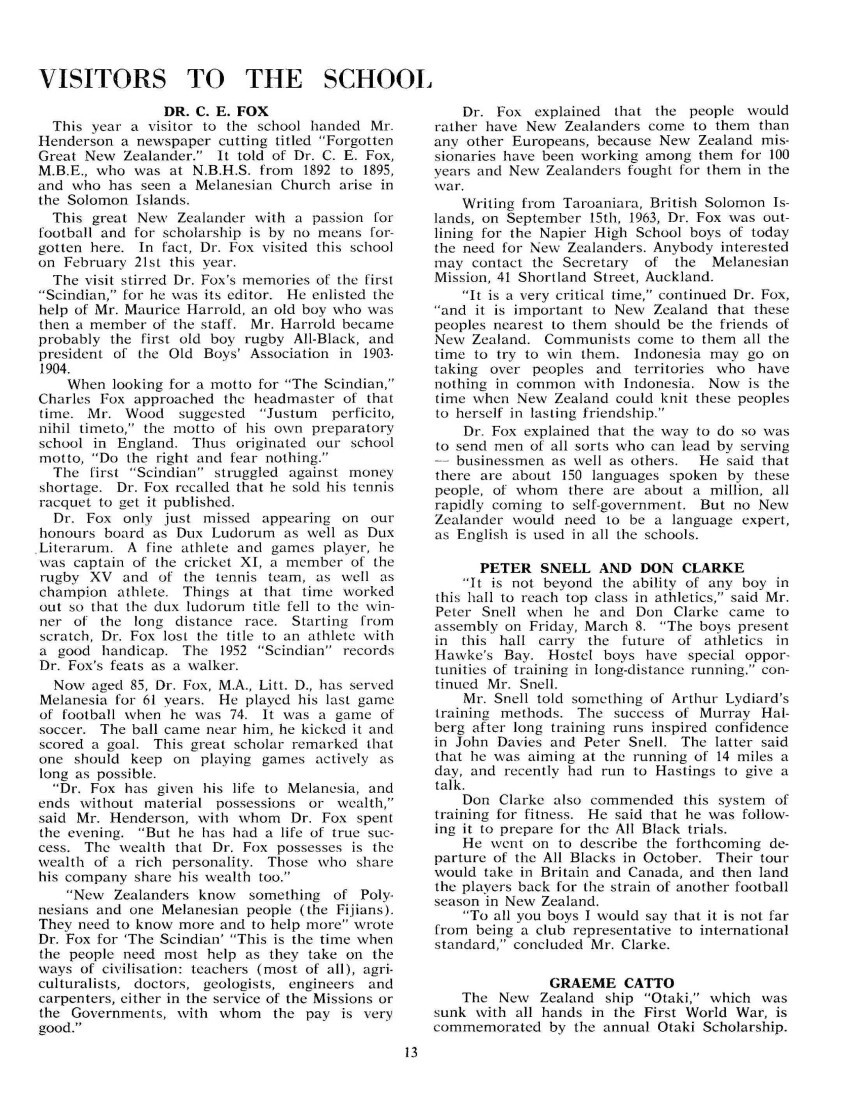
Page 14
The captain of the ‘‘Otaki” was an old boy of Robert Gordon College, Aberdeen, and many of his crew were New Zealanders. So every year the New Zealand Shipping Company and the N.Z. Government arrange a seven-weeks tour of New Zealand for the Head Boy of Robert Gordon College, Scotland.
This year’s Otaki Scholar, Graeme Catto, stayed at the school on July 22 and 23. He raised a laugh in assembly when he said that his school was founded in 1760 as Robert Gordon’s Hospital for Twelve Sons of Gentlefolk, and continued, “We are very proud of our New Block, which was opened in 1820, and our very fine swimming pond.”
Although Graeme said that he had been met at the bus terminus by a policeman who invited him to step into a police car, he preferred to be shown around Napier by our head prefect, E. W, McGregor.
DR. IAN AXFORD
“I’m a space scientist – and that doesn’t mean a land agent,” quipped Dr. Ian Axford when he spoke at assembly on May 9. Dr. Axford is an Old Boy who has reached the highest scholastic attainments of doctor and professor. He was briefly visiting Napier before going to Cornell University as Associate Professor of Astronomy.
Dr. Axford said that he was responsible for the thinking that went on before a satellite was launched – what to put into the satellite, and what conditions it was likely to meet. After several years of work and the spending of several million pounds, some two hundred satellites have now been launched.
“I didn’t understand the purpose of schooling when I was here,” said Dr. Axford. “In the 3rd form I remember being kept in hall by the prefects until we could say the school motto. In the 4th form I remember we escaped a geometry exam because school was closed through a polio scare. In the 5th form, I can remember that 26 runs were hit off one over of my bowling. And in the 6th form I still didn’t know why one was put through all this schooling.”
Dr. Axford then explained that since he had seen nearly 10 per cent unemployment in Canada, he had realised that educational qualifications count. No matter whether you want to be a janitor or a professor, you are asked how long you spent at school and what you learnt there. He therefore advised us not to rush away from school, as these conditions must come to New Zealand.
Mr. WALSH, M.P. FOR TAURANGA
A warning to New Zealand and its youth was given in assembly on September 18 by Mr. Walsh. He has been touring Japan and Europe by air and wanted to get his impressions across to young people in New Zealand schools.
Mr. Walsh argued that New Zealand was basking in a false security of a sure market in Britain, the bygone superiority of the white race, and the vanished British supremacy. He blamed New Zealanders for not being concerned about the population pressure in acutely over-crowded countries.
His line of reasoning for the schoolboy was that world population is increasing, and that therefore we will grow up into a crowded, competitive world. The pace of living will speed up more, and educational qualifications will become intensely important.
“Boys, you will know competition. New Zealand is not adapting itself to competition. It thinks nothing needs to be bettered,” was his concluding note of alarm.
Mr. W. E. ROSE
Here is the classic statement of the year, by Mr. Rose, an Old Boy who is now N.Z. secretary of the United Nations Association. “Forty years ago in our assembly hall on the hill, every breakup speaker said, “Cheer up, boys, your school days are the best days of your life.’ I then took a solemn oath that I would say, ‘Cheer up, boys, there’s a better day coming soon,’ and I’m saying it now.”
Mr. Rose was speaking in Assembly for the United Nations day in October. He urged us to accept with confidence the extending role of the United Nations Organisation.
“U. N. O. can make a difference in our part of the world,” explained Mr. Rose. “Its influence can already be felt here. Already things we propose to do in New Zealand have to be modified or considered in the light of opinions expressed in the United Nations.”
In addition, the visitor said that U. N. O. could begin now to offer new careers to New Zealand boys at present preparing for their future. Several New Zealanders are already serving as senior officials abroad with U. N. O. and Unesco. If we will just accept United Nations with confidence, then we can enter into these new careers.
HIS WORSHIP THE MAYOR
A magnificent tribute was paid to the Scinde House boys by Mr. P. Tait when he came to assembly on April 26 to speak about the annual Corso appeal. He said that the Corso collection could not be successfully carried out in Napier without the help of the hostel boys.
But better was to follow. Mr. Tait urged the boys to contribute as well as assist with the collection so that they might make some personal sacrifice for the sake of starving people. In response, Scinde House collected the magnificent donation of £14/6/11 contributed from the small allowance of hostel boys. The total donation of the school was just under £41.
His Worship the Mayor visited the school again on May 10 to speak about the development of Napier. He said that we are living in an exciting stage of Napier’s history. There are major plans for the harbour, the inner harbour and the sea-front. Building worth two and a half million pounds is planned for the next twelve months.

Page 15
“I ask you to work and plan and live so that Napier will be a better place because you had the opportunity of living in it,” ended Mr. Tait.
Miss M. J. LANG
The memories of Thomas Ernest Lang are particularly numerous in our school. This year his sister, Miss M. J. Lang of Te Awanga, came with her nephew, Mr. F. B. Baudinet, to watch the two Baudinet boys competing in the school sports on March 14.
Miss Lang drew attention to the honours board, where it is recorded that her brother won the Old Boys’ Challenge Cup three years in succession and was both Dux Ludorum and Dux Litterarum [Literarum] in 1902. On the War Memorial board is noted the departure for World War I of Mr. Lang, at that time a chemist in Napier. The headmaster’s chair in the Assembly Hall has a silver plate on the back, commemorating that it was presented in 1950 in memory of T. E. Lang.
It was good to welcome Miss Lang at our sports day and we hope that it will be not the last time that she sees her grand-nephews winning events.
MAJOR R. COLLINS
Thanks to Major R. C. Tuck for many courtesies shown him over the years were expressed in assembly by Major R. Collins, who was paying his last visit to the school as Area Officer of Hawke’s Bay on June 26. In his turn, Mr. Henderson thanked Major Collins for his generosity shown by many favours, such as umpiring cricket matches and assisting with shooting practices.
Major Collins gave a most unusual short talk in which he traced the lives of the eight other men who qualified with him in Trentham 28 years ago.
Mr. ROBERT WEBBER
On Monday, March 4th, the school was greatly privileged to receive a visit from the celebrated American pianist, Mr. Robert Webber. Mr. Webber, who is making his first New Zealand tour, was taught by Rosina Lhevinne, (teacher of Van Cliburn), at the famous Juillard [Julliard] School of Music in New York. He has now obtained the highest qualifications in music.
Before commencing his performance, Mr. Webber explained to the boys what music actually was, and its importance to one’s outlook on life.
He then commented on the Baroque Period (1600-1750) and one of the prominent musicians and composers that existed during that period, J. S. Bach. From this, Mr. Webber began his programme by performing Bach’s “Fantasia in C Minor.”
Following this he told of the composers after the Baroque Period, e.g. Handel, Mozart and Beethoven. Beethoven was the significant one of the three because he was the cause of the Sonata Allegro Form and of the beginning of the Romantic Period. Mr. Webber then played the first movement of Beethoven’s “Sonata in E Flat Major,” No. 4 of this great composer’s brilliant 32 piano sonatas.
After this, Mr. Webber mentioned a little on the Romantic Period and of its composers. Chopin, one of these great men, wrote many quick moving pieces for the piano and Mr. Webber performed two of Chopin’s compositions – “Fantasy in F Minor,” and “The Minute Valse.” These were greatly appreciated by the audience as they listened keenly to the familiar themes that echoed from both these pieces.
Mr. Webber then moved on to the modern composer, Guarnieri and performed his “Dansa Brasiliera [Brasilera],” which has a very modernistic, discordant sound plus a syncopated, rhythmic left hand.
After this, Mr. Webber introduced one of his own compositions; one describing the western United States of America, called ‘Western Serenade.” Finally, he concluded with Chopin’s brilliant “Valse in A Flat Major” and he received a rousing applause from the appreciative audience. I’m sure that it was an hour of music-making that would be remembered for a long time, by those who attended this recital.
C. L.
ROTARY VOCATIONAL TALKS
This year our school has enjoyed one of the most extensive series of business vocational talks that has ever been given in a New Zealand Secondary School.
Throughout the second and third terms, prominent businessmen of Napier have been coming in the Tuesday lunch-hour to explain to voluntary audiences the different branches of business for those who might consider choosing them as a career.
Not only did Managers, Directors and Professional Executives come to speak, but they also returned with junior members of their firms who gave first-hand impressions of the beginner’s experience in business.
The talks covered such subjects as the opportunities in marketing, transport, banking, insurance, accountancy, manufacturing, engineering, wholesaling and retailing. The speakers were always ready to answer questions and were often talking with interested enquirers after their talks.
Besides recording this important innovation, “The Scindian” must very sincerely thank the prominent men who came, their junior employees who gave their side of the story, and the Rotary Committee (Chairman: Mr. W. Nuttall), which organised the series.
The speakers were Messrs. W. Nuttall, E. S. Burkitt, K. W. Bull, D. C. Piper, H. Gordon, W. L. Gray, G. E. Bisson, M. J. Begley, T. A. C. Kyle, J. Stainton, R. K. Briasco, R. C. Dockery and K. Tremain.
No doubt many boys will find the place of their choice in the business community as a result of this enterprising series of addresses.
Mr. Henderson and Mr. Carpenter arranged the practical details for the smooth running of the talks at school.
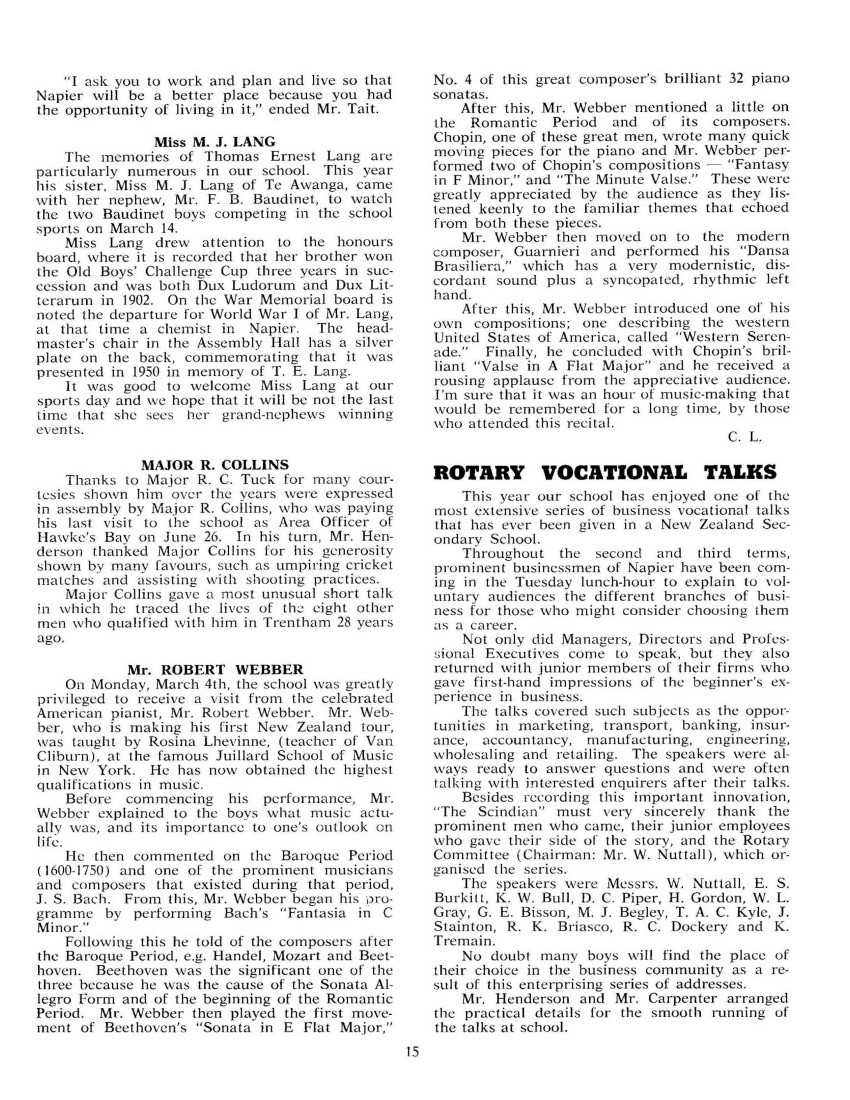
Page 16
EXAMINATION RESULTS, 1962
University Entrance Scholarships: Passed with Credit: Knight, D. H.; McMullan, R.; Jordan. T. W.
Higher School Certificate: Alexander, A. M.; Barnes. G. G.; Blom, A. E.; Bowling, M. C.; Campbell, G. F.; Gahagan, J. M.; Gibson, G, Y.; Grant, R. M.; Jordan, T. W.; Knight, D. H.; Krogh, W. H.; Lyall, R. W.; McMullan, R.; Paxie, D. A.; Ross, A. W.; Wong, T. C.
University Entrance: Angove, G. H.; Baker. I. D.; Barker, T. J.; Barnes, K. W.; Brendon, B. S.; Chin, R.; Dale, G. P.; Davis, B. M.; Dunbar, D. A.; Hobin, R. T.; Irwin, J. R.; Isles, J. K. W.; Kells, B. A.; Kirkham, N. D.; Larsen, W. A.; Macfarlane, D. J.; Macfarlane, N. J.; McGregor, E. W.; Marshall, D. P.; Mitchell, A. J.; Mitchell, G. M.; Nicholas, W. W. H.; Olsen, D. J.; Reid, K. B.; Robinson, J. R.; Schmidt, A. J.; Seuseu, K. F.; Smith, A. F. W.; Tasker, L. B.; Thomson, R. A.; Tutt, B. R.; Wiig, R. L. D.; Williams, G. B.
Endorsed School Certificate: Angove, D. H.; Ashcroft, G. H.; Baker, I: D:; Barker, T. J.; Barnes, K. W.; Bee, P.N.; Bennett, M.M.P.; Brendon, B. S.; Buchanan, A.M.; Chin, R.; Dale, G. P.; Dallas, R.; Daly, T. P.; Davidson, J. R.; Davis, B. M.; Dunbar, D.A.; Dunn, R.S.; Feasey, P.G.; Frame, C. B.; Frehner, I. K.; Gardiner, C. E.; Godfrey, S. C.; Hamilton, R. G. M.; Heath, R. A.; Hobin, R. T.; Irwin, J. R.; Isles, J. K. W.; Jeffares, C. R.; Kells, B. A.; Kirkham, N. D.; Larsen, W. A.; Mc- Arthur, D. D.; MacDonald, D. O.; McDougall, A. D.; Macfarlane, D. J.; Macfarlane, N. J.; Mc- Gregor, E. W.; McLachlan, S. R.; Marshall, D. P.;
Martin, D. W.; Mitchell, A. J.; Mitchell, G. M.; Mitchell, N. C.; Nation, R. W.; Nicholas, W. W. H.; Olsen, D. J.; Paterson, G. R. H.; Potter, J. W.; Reaney, R. S.; Reid, K. B.; Robinson, J. R.; Schmidt, A. J.; Seuseu, K. F.; Smith, A. F. W.; Tasker, L. B.; Taylor, J. T.; Thomson, R. A.; Tucker, N. J.; Tutt, B. R.; White, T. C.; Wiig, R. L. D.; Williams, G. B.
School Certificate Examination: B. K. Baudinet; B. C. Bendall; I. N. Campbell; H. A. Chandler; B. Chrystal; J. R. Cook; D. W. Cormack; R. S. Dallimore; G. L. Dick; N. W. Dobson; G. W. Ebbett; R. F. Elmes; R. W. Farquhar; D. J. Fergusson; R. J. Finlayson; C. A. Forrest; D. R. Gardner; D. W. F. Gilliland; M. R. Girvan; J. B. Guy; G. J. Hall; G. L. Harvey; B. R. Hayden; R. J. Herbert; L. G. Higgens; W. M. Hindmarsh; K. R. Hing; N. J. Hocking; I. R. C. Hood; G. B. Hook; A. C. Horton; D. A. Iorns; L. Jensen; K. Johnson; N. B. Johnstone; R. I. Kells; D. D. Kerr; J. F. Kerr; R. L. King; G. C. Kirby; I. D. Lapsley, G. Liddell, P. C. Loader; J. A. Lynn; R. M. McKelvie; A. J. Mackintosh; J. D. MacLeod; R. K. Malcolm; J. R. Medcalf; B. S. Meredith; T. A. Morrin; B. Paine; V. G. Picone; J. A. Piper; J. M. C. Piper; J. Pishief; N. C. Pritchard; J. N. Read; G. W. Robinson; W. A. Sadler; R. H. Sherwood; B. M. Simmond; J. W. Simpson; J. W. Sinclair; C. R. Smith; C. B. Smith; S. P. Spiller; R. E. Stevens; F. C. Thomas; A. H. Tolley A. G. Tuck; R. W. Tucker; I. T. Turbitt; W. E. Turner; W. K. Turner; A. J. Ware; K. C. Weston; A. W. White.
PRIZE-GIVING, 1962
University Entrance Certificates were presented for the first time at the 1962 Prize-Giving, which began at the Municipal Theatre at 1.15 p.m. on Thursday, December 13th. The new University Grants Committee sent U. E. Certificates to those who had been accredited in time for presentation at the prize-giving.
The Chairman of the Board of Governors, Dr. E. H. J. Berry, presided at the ceremony.
Mr. Howlett conducted the school in some well- rehearsed singing: “Sleepers Wake,” by Bach, “Torches,” a carol, and “Land of Hope and Glory,” by Elgar.
The Headmaster’s annual report stated that, with 186 boarders, the school had the fourth largest boarding establishment in New Zealand. Mr. Henderson gave general thanks to all those who had helped the school by billeting, by attending school functions, and by kindly words spoken of the school.
Colonel Dr. A. Bramwell Cook gave the address. Pleading for more sense of vocation, he quoted the wonderful vocation followed by the school’s famous old-boy, Dr. C. E. Fox.
“He is the Albert Schweitzer of the educational realm,” said Dr. Cook. “The people of the Solomon Islands have been completely transformed in his life-time.”
Dr. Cook, himself an old boy, has been a doctor in India whose work was recognised by the Indian Government.
Mrs. Cook presented the prizes, and the large list was run through smoothly, thanks to the infinite work of Mr. Campbell and Mr. Tuck in organizing the prizes, and Mr. Briasco in organising the trophies.
PRIZE LIST
SPECIAL PRIZES:
READING. (Presented by the Old Boys’ Association):
Third Forms: J. Knight; Fourth Forms: C. Lum; Fifth Forms: H. Chandler; Sixth Forms: R. McMullan.
WRITING (Presented by the Parents’ League.:
Third Forms: N. Thorp; Fourth Forms: C. Lum; Fifth and Sixth Forms: R. W. Tucker.
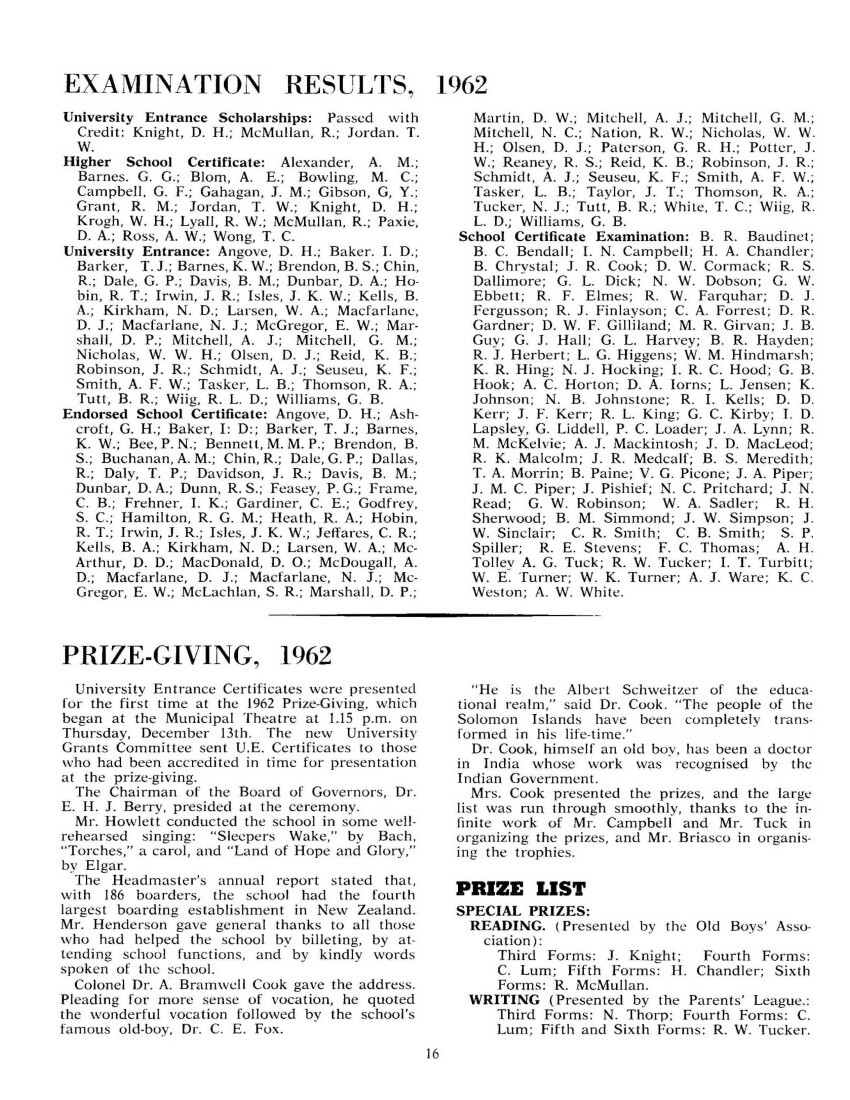
Page 17
SINGING
W. Clothier Cup, Junior: G. M. Phillips. P. M. Williams Cup, Senior: G. F. S. Campbell, D. A. Paxie.
COMMERCIAL
Third Forms: A. W. Hopcroft; Fourth Forms M. Nobilo; Fifth Forms: M. Hocking.
Chamber of Commerce Prizes (Donated by Napier Chamber of Commerce) Commerce (for best commercial student): D. D. Kerr.
Arithmetic: J. A. Piper.
ART
Third Forms: T. K. Davis; Fourth Forms: J. E. Vivieaere;
Fifth Forms: J. Lynn.
Joseph Alexander Memorial Cup (Presented by W. Tucker, Esq.): J. E. Vivieaere.
AGRICULTURE
Third Forms: D. L. Munro; Fourth Forms: H. E. C. Tennent; Fifth Forms: G. W. Ebbett.
Open Shearing Cup (Presented by F. Holt, Esq.): D. K. Thompson.
Fleece-O Competition Cup (Presented by The Federated Farmers): J. W. Kerr.
Southdown Judging Competition (Shield presented by Southdown Breeders’ Soc.): A. C. Horton.
Friesian Breeders’ Cup (Presented by the Hawke’s Bay Branch of the Pedigree Friesian Breeders’ Assn. for the judging of the Friesian Breed): B. C. Bendall.
The R. G. Montgomery Cup (Presented 1962 by R. G. Montgomery, Esq., for Flock Sire Assessment): N. W. Dobson.
The D. G. Begley Memorial Bursary Presented 1961 by the Directors of Farm Products Co-operative (H. B.) Ltd. for the study of Dairying): N. W. Dobson.
AGRICULTURAL SCHOLARSHIP (Awarded annually to a Hawke’s Bay boy boarding in Napier and taking the Agriculture Course. Cup and miniature presented by the A. & P. Society as trustees for the Farming Development Association):
1962: G. Y. Gibson; 1963: E. W. McGregor.
PHYSICAL EDUCATION
Form Competitions:
Third Forms (Neill Challenge Cup): 3G: (Class Captain, T. N. Campbell).
Fourth Forms: (Neill Challenge Cup): 4A: (Class Captain, P. Tuck).
Fifth and Sixth Forms (Dockery Challenge Cup: 6B Gamma: (S. R. McLachlan).
Individual Competitions:
Third Forms: E. G. Bulled.
Fourth Forms: L. H. Karatau.
Fifth and Sixth Forms: G. L. Eddy.
WOODWORK
Third Forms: T. Skews;
Fourth Forms: A. S. Jamieson;
Fifth Forms (Prize presented by Messrs. Robert Holt & Sons Ltd.): B. M. Simmonds.
ENGINEERING
Third Forms: B. T. Darragh;
Fourth Forms: D. M. Willis;
Fifth Forms (Prize presented by Messrs. Henry Williams & Sons Ltd.): B. Paine.
PUBLIC SPEAKING
Debating Cup: (McKay Cup): R. McMullan.
Impromptu Speech (McClurg Cup): D. A. Paxie. Junior Prepared Speech (Storkey Cup): M. D. McSporran. Intermediate Prepared Speech: J. L. Scott. Senior Prepared Speech (Brooks Cup and Rotarians’ Prize donated by the Napier Rotarians): R. L. D. Wiig.
SCINDE HOUSE AWARDS
Scinde House Challenge Cup (for all-round improvement in Scinde House): G. W. Ebbett.
W. B. Ayling Memorial Cup and Prize (for the most thoughtful and conscientious boy in Scinde House): D. H. Knight.
Erroll Tylee Memorial Prize (for neatness in Scinde House): N. W. Dobson.
W. E. Trafford Cup (for best scholar in Scinde House): D. H. Knight.
MILITARY DRILL
Junior Platoon Competition: No. 4 Pln. C. Coy. C. S. M. T. C. Wong.
Senior Platoon Competition: B Flight A. T. C. Set. J. K. W. Isles.
N. C. O. Cup: R. L. D. Wiig.
Junior Shooting Champion (.22): A. R. Wilson.
Senior Shooting Champion (.303): L. J. M. Campbell.
Kiwi Cup for Inter-House Shooting Competition: Hawke (Captain: L. J. M. Campbell).
Winner of Third Form .22 shoot: N. J. Bishop.
Vigor Brown Belt for best shot in the House Competition: L. J. M. Campbell.
Lady Godley Cups for the Best Shot in each House: Clyde, T. J. Barker; Napier, D. P. Marshall; Colenso, J. A. Piper; Heretaunga, R. Chin; Scinde, D. O. MacDonald.
CRICKET
McLernon Clock for the boy who has done most for Cricket in 1962: W. A. Larsen.
Gifford Memorial Cup for Bowling: D. H. Knight.
Geddis Cup for Batting: W. R. Nation.
Monro Cup for Fielding: A. D. McDougall.
FOOTBALL
R. Glendinning Cup for Place Kicking: B. Chrystal.
E. R. G. Steere Cup for Tackling: W. Lawton.
E. G. R. Morley Memorial Cup for Junior Efficiency: R. M. Grant.
SWIMMING
Courtney-Bowen Memorial Cup for most points in Handicap Events: R. Dallas.
Junior Champion: R. A. Fox.
Intermediate Champion: R. J. Finlayson, I. T. Turbitt (equal).
Senior Champion: A. D. McDougall.
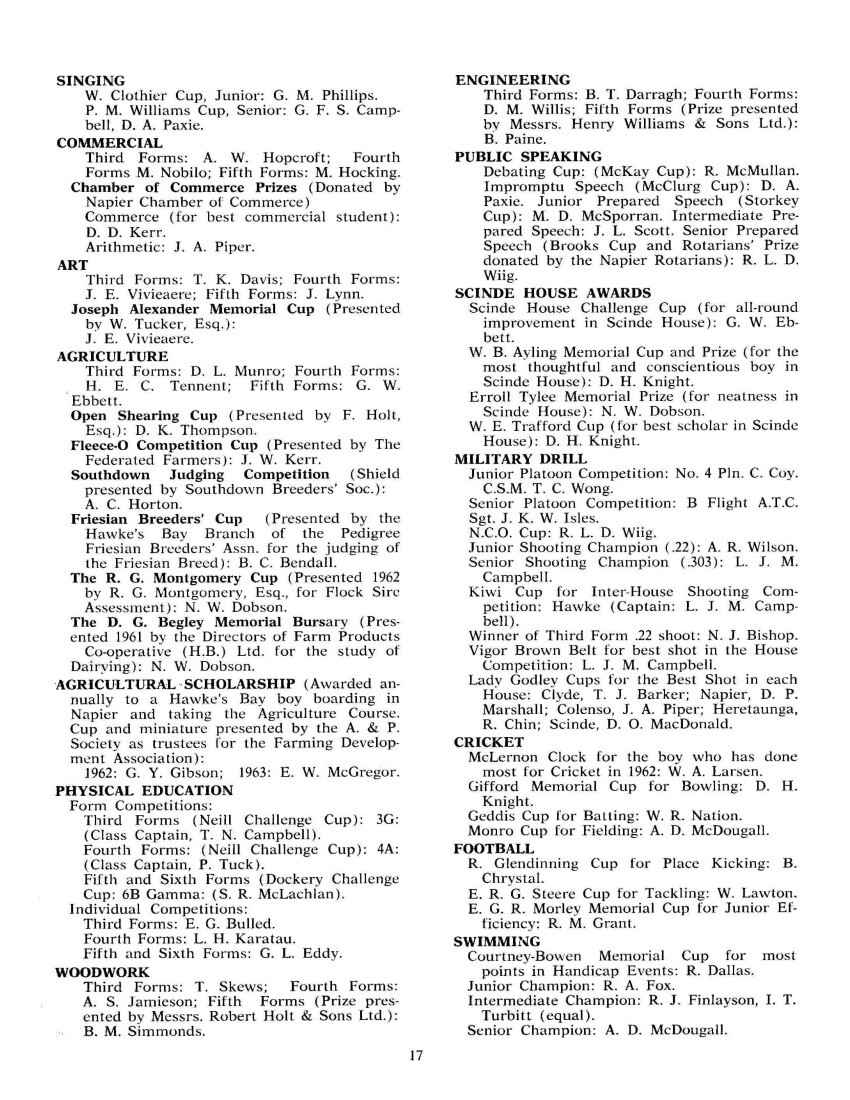
Page 18
TENNIS
Doubles Champions (C. B. Thomson Cup): D. D. Kerr, J. F. Kerr.
Junior Champion (Prime Cup): D. D. Kerr.
Senior Champion (Mendelssohn Cup): J. F. Kerr.
HOCKEY
Brown Cup for Most Improved Player: S. N. Kemsley.
ATHLETICS
Bickerstaff Cup for the most points in Championship Sprint Events: T. C. Wong.
Davis Cup for Open Handicap Hurdles: T. C. Wong.
Cornford Cup for the Senior Handicap Mile: D. J. MacFarlane.
Bryan Smith Cup for Junior Steeplechase: R. W. Irwin.
Brian Derwin Cup for Intermediate Steeplechase: R. A. Hunt.
School Cup for Senior Steeplechase: A. W. Ross.
Prefects’ Cup for most points in Handicap Events: D. J. MacFarlane.
P. F. Martin Cup for High Jumping: K. Seuseu.
Junior Athletic Champion: M. D. Mear.
Intermediate Athletic Champion: H. K. Taylor.
Senior Athletic Champion: T. C. Wong.
Dux Ludorum: T. C. Wong.
SCHOLARSHIP AWARDS
Special Prize for Diligence (awarded by Maori Affairs Department): L. Karatau.
Macfarlane Cup for Scholarship and Conduct in Fifth Forms: J. A. Piper.
Russell Jones Memorial Essay Prize: R. McMullan.
Stopford Memorial Prize for English in Sixth Forms: R. McMullan.
Storkey V. C. Prize for Science and Mathematics in Sixth Forms: D. H. Knight.
PREFECTS’ PRIZES
D. H. Knight, M. M. Bennett, A. E. Blom, G. Y. Gibson, R. M. Grant, T. W. Jordan, G. F. S. Campbell, W. H. Krogh, R. McMullan, D. A. Paxie, A. W. Ross, R. L. D. Wiig, T. C. Wong.
D. A. Wilson Memorial Prize (awarded annually to the Head Prefect): J. H. Gahagan.
Ashcroft Cup (for all-round excellence presented by P. Ashcroft Esq.): J. H. Gahagan.
WILLIAM COLENSO PRIZES FOR FIRST IN FORM
3GP: C. P. Osborne; 3P: J. W. Clifford; 3G: K. Hapi; 3 Modern: D. L. Munro; 3 General: D. B. Glover; 3 Special: P. G. Morrin; 3B: R. K. Tucker; 3A: N. R. Moir.
Special Language Prize (French in Third Forms): D. H. Gempton.
4P: A. Mitchell; 4G2: B. E. Gloyn; 4G1: P. Brown; 4E: L. Watkins; 4D: R. W. Armour; 4C: T. A. Hall; 4B: W. R. McCorkindale; 4A: E. E. Robinson.
Special Language Prize (French in Fourth Forms: C. Lum.
FORM PRIZES
Fifth Form Science: J. A. Piper.
Fifth Form History: I. R. C. Hood.
Fifth Form Geography: J. F. Kerr.
Fifth Form French: J. A. Piper.
Fifth Form Mathematics: J. A. Piper.
Fifth Form English: J. A. Piper, G. Robinson, J. M. C. Piper.
Sixth Form Geography: W. A. Larsen.
Sixth Form Science: N. D. Kirkham.
Sixth Form Mathematics: A. J. Schmidt.
Sixth Form French (presented by the French Legation): G. P. Dale.
Sixth Form History: J. K. W. Isles.
Sixth Form English (W. T. Foster Memorial Prize): N. J. MacFarlane.
Sixth Form Special Prize: Outstanding work in Mathematics and Science: T. W. Jordan.
Proxime Accessit to Dux: R. McMullan.
Dux of the School: D. H. Knight.
PREFECTS’ NOTES
The twelve Prefects of 1963 have functioned well under the leadership of E. W. McGregor, with R. Chin as Deputy. We are indebted to the masters for their co-operation and, to a certain extent, to the boys. Having had our badges presented by Don Clarke and Peter Snell, we were greatly inspired in tackling the pile of duties which came our way. From our ranks came six members of the First XV, three from the First XI, two from the Shooting Team, of which R. Chin was captain, two members of the Athletic Team, captained by C. Frame, two from the Tennis Team, also captained by C. Frame, and one member of the Swimming Team. As well as these sporting stalwarts, the more academic side has been looked after by three members of the Debating Team and one taking part in the combined drama production with our sister school. In the first term a very successful Prefects’ Dance was held, and our thanks go out to all those who helped. New year will see the introduction of another group of completely new faces to the Prefects’ Room and we wish them all the best.
A. J. M.
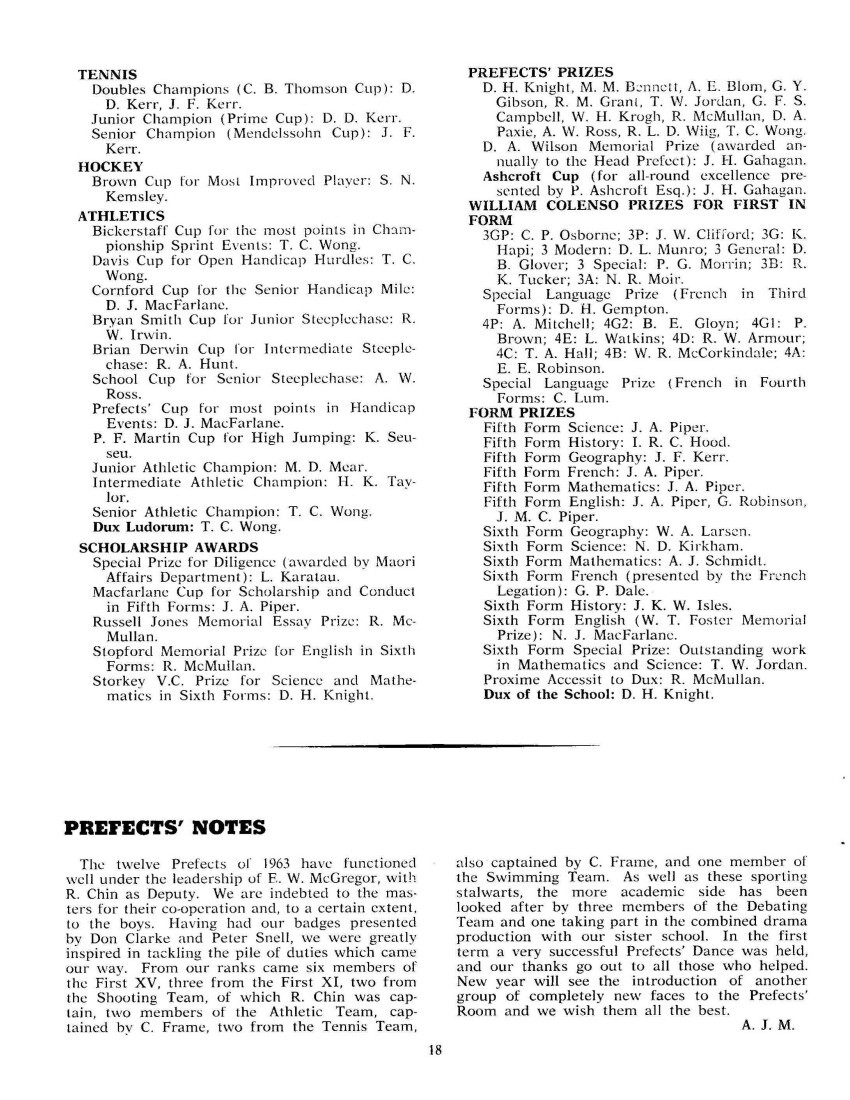
Page 21
6A NOTES
Dave Angove is a scout so keen
And also fond of the T. V. screen.
Then we have Barnes, Kevin by name;
His religions cause his class-mates pain.
Brett Brendon is a larky lad;
Behind a wheel he turns quite mad.
Chin hails from Bay View way;
At shooting and hoeing he’ll make his way.
Now comes Dale from England’s shore;
A mention of Homeland makes him sore.
Hobin is a tennis fad;
At hitting balls he’s not too bad.
Jim Irwin is of the Crusader fleet;
Under hard work he’ll find his feet.
Then we have Isles who’s often away;
He prefers beer and women any day.
From Bulls we have a lad called Kells;
In mathematics he excels?
Larsen is hailed as the best;
But by himself, not by the rest.
Marshall troubles all our minds
Shooting pigs and deer and lines.
McGregor is our head-boy;
Piles of food bring him joy.
Mitchell is a farmer’s son;
Mention maths and he’s on the run.
Nicholas is a lad with zest;
He’ll grace the All Blacks for a Test.
Adrian Schmidt is the teachers’ pet;
A scholarship he’s bound to get.
Seuseu comes from the Samoan land;
His future is in a rock ‘n’ roll band.
Now comes Thomson a keen basketballer;
We sincerely hope he doesn’t grow taller.
Last of all is that Williams man;
He is the smallest of our band.
This, then, is the elite of the school,
A group which makes the juniors drool.
Our form master was Mr. Tuck;
And to all for next year the best of Luck!
A. J. M.
DEBATING AND PUBLIC SPEAKING
The senior Debating Club started off with a flourish this year but exams and football trips soon forced the club to close down during the winter term. Mr. O’Connor presided over the Club, assisted by J. Isles, as president and B. Ferguson as secretary. Many interesting debates within the club were held, helping the selection of the School Debating Team.
This year the team, A. Schmidt (leader), J. Isles, E. McGregor, first travelled to Gisborne with the 1st XV to do battle over Communist China’s admission to the United Nations. Our team took the positive side and defeated Gisborne.
The second debate was held in Napier against Palmerston North B. H. S. Against very skilled and experienced opponents our team ran out the winners by virtue of having better teamwork. The subject was: That the nuclear deterrent is a better means of ensuring peace than nuclear disarmament.
Hastings provided worthy opposition, halting our run of successes with three learned and thoughtful addresses on the cost of space research. We congratulate Hastings on the very convincing victory. A trophy has been presented for each debate, so the teams feel that something is at stake and are inspired accordingly. The club would like to thank Mr. O’Connor for the time he put into organising activities and coaching the team to success. With a strong junior club the future of school debating appears brighter that it has been in the past.
J. K. I.
Junior Debating Club
“That this meeting declare the male to be the superior sex” was the title of our debate with a team from the Girls’ High School. This was the climax of our seven meetings during the winter term. The Girls’ High School team and their supporters were entertained in the Memorial Library by the twenty-five boys in the club. Miss D. Carr, of Colenso High School, awarded the victory to the boys’ team, M. McSporran, J. Knight and G. Lydford. We were very grateful to Miss M. Sinclair of the Girls’ High School for bringing a team and their supporters for this wind-up debate on 21st August.
Senior Prepared Speech
G. R. H. Paterson, who won this year’s Senior Prepared Speech Competition, demonstrated an unusual opening gambit. He came on with his cards of notes neatly cupped in his hand. Then something seemed to go wrong, and an embarrassing scroll slipped, unfurled to the floor, and displayed the words “Vote Social Credit.” After a roar of laughter, when the audience expected further fun, Paterson spoke very seriously and extremely well on the problem of World Population Explosion.
The judge, Mr. D. Welch, said that all speeches were of a high standard. Second was E. W. McGregor and third was A. J. Schmidt.
Impromptu Speaking
Mr. Henderson judged the impromptu speaking on September 26. He said first that he had always recognised the value of oratory and informal speaking, and had keenly encouraged them. Before listening to the speakers, he passed on some ideas about the techniques of communication to a large audience.
The contest was won by J. K. W. Isles, who spoke with polished disrespect about Women’s Liberties. Another notable speaker was A. Tolley, whose subject of War Comics led him to make comical war on the love pulp read by school-girls.
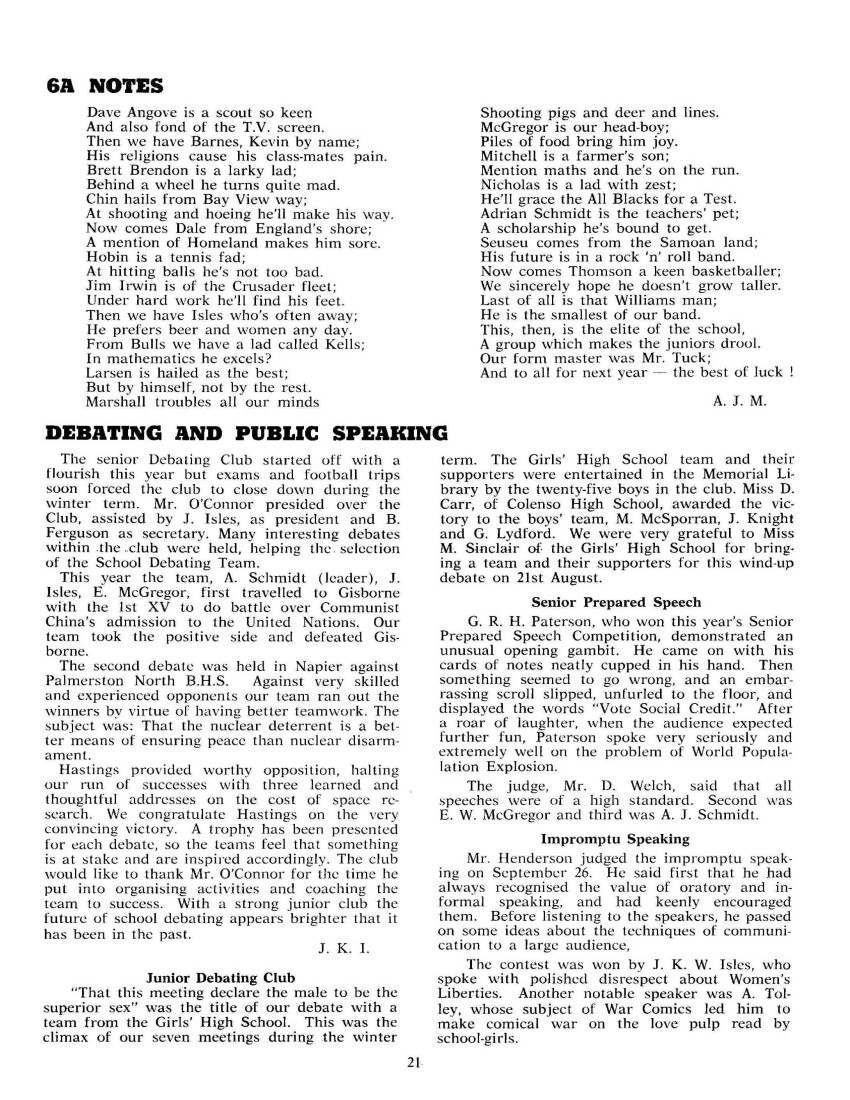
Page 22
MEMORIAL LIBRARY
The Memorial Library is gradually becoming the reference centre of the School. As the Library must serve every branch of the school curriculum the range of book buying is very wide in an endeavour to provide up-to-date references on the latest developments in this rapidly expanding age.
The use of the Library has expanded as will be seen from figures given later in this report, and it is encouraging to know that the services provided are appreciated as indicated by the increasing numbers who have given books or 5/- donations to the Library. This is marred by those boys who approve our choice to such an extent they remove books to start private libraries. All boys please check your book shelves and other hiding places.
Every form is time-tabled for one period a week in the Library, but because of numbers it has been necessary to continue the policy of restricting entrance at lunchtime and interval to specific groups on different days.
The Library has been used for a number of meetings by teacher-organisations and also by school stamp and debating clubs. It is a place of which every boy should be proud, and it is hoped that every boy in the school takes time to appreciate and sacrifice made by those old boys for whom the Library is a memorial.
During the year we have been able to add 453 new books to the shelves, bringing our total stock to 8676. We are grateful for 95 books presented to the Library by the following: Australian Department of the Interior, Mr. W. Bluck, Mr. J. Bygate, Department of External Affairs, Department of Internal Affairs, Mrs. R. E. Evans, Form 3 General 1962, Dr. C. E. Fox, Mr. D. Holland, W. Krogh, N. Macfarlane, S. Macfarlane, Mr. W. McGregor, E. Martin, Phillips Technical Lib., J. Potter, A. H. and A. W. Reed, Rigby Pub. Co., S. Romans, Mr. T. Scott, G. Veale, V. U. C. Student Assn., Mr. Walsh M.P., R. D. Westerman, Whitcombe and Tombs, Hastings.
The 5/- donation system is developing and we acknowledge the following: – I. Baker, G. Barnes (4), P. Bee (2), G. Campbell (4), Central Hawke’s Bay Members Scinde House (24), M. Collins, R. Dallas, B. Davis (4), I. Frehner, Mr. R. Ford (6), J. Gahagan (4), G. Gibson (4), R. Grant (4), J. Kerr, R. McMullan (4), D. Paxie, J. Price, J. Rumbal, L. Tasker (2), G. Watkins (4).
This donation system enables any boy to share in the cost of purchasing a book and providing a lasting contribution from which others may benefit. It is hoped that this system will continue to grow and more boys yet will make a contribution to the Library after all the Library should be the learning centre of the school. It is still recommended that boys leaving should donate the refund they receive on the return of their text books.
Further books have also been added to the Foster and Holt Memorial shelves.
Of the new books purchased 61.5 per cent have been non-fiction and divide as follows: English language and literature: 15 per cent; Travel and Biography: 12 per cent; History: 12 per cent; Science: 6 per cent; Reference: 6 per cent; Sport: 6 per cent; General Arts: 4.5 per cent.
To augment our own stock 1,128 books have been borrowed from the Country Library Service, on the following topics: senior reading, junior reading, hobbies, geography, music, woodwork, agriculture, social studies, French, sports, stamp collection, animals, as well as individual requests on a variety of subjects.
This year our total issues for the year have increased from 14,244 books in 1962 to 17,061, of which 54 per cent have been non-fiction. The sections of the non-fiction library have been popular in the following order: Travel and Biography, History, English language and literature, War and Crime, Science, Sport.
In addition to coping with all the work involved with new books, handling Country Library Service loans, the Library Staff have continued to keep the book stock in repair. Older books in constant use are reinforced and given new covers and given general repairs as required. A total of 1,188 books have been reconditioned.
Displays have been a regular feature and all new books have been displayed for a week before going on to the shelves. Special displays have been arranged on United Nations, World Health Organisation, Britain, Japan, Chinese Republic. We are grateful to the people who have kindly loaned materials for these displays.
A critics corner has been used to feature book reviews by senior boys.
During the year the Library assistants have worked well under the leadership of J. Potter. Each boy has specific duties in the workroom and Library, and their co-operation and willingness contribute largely to efficient running of the Library. Form librarians have continued to deal with issues and returns during Form library periods.
The standard of Library training and behaviour is still not perfect, but the majority of the boys have developed an intelligent approach to the Library and the books, and are making the most of the facilities and information available.
Library Staff: Librarian, Mr. A. T. Howlett: Assistant Librarian, Mrs. M. Brocklehurst; Library Assistants: J. Potter (senior), G. Holdsworth, B. McCorkindale, S. Nation, G. Phillips, R. Scott, R. Westerman, J. Ferguson, D. MacEwan, A. Masemann, K. Smith.
“A library is not a luxury, but one of the necessaries of life.” – H. S. Beacher.
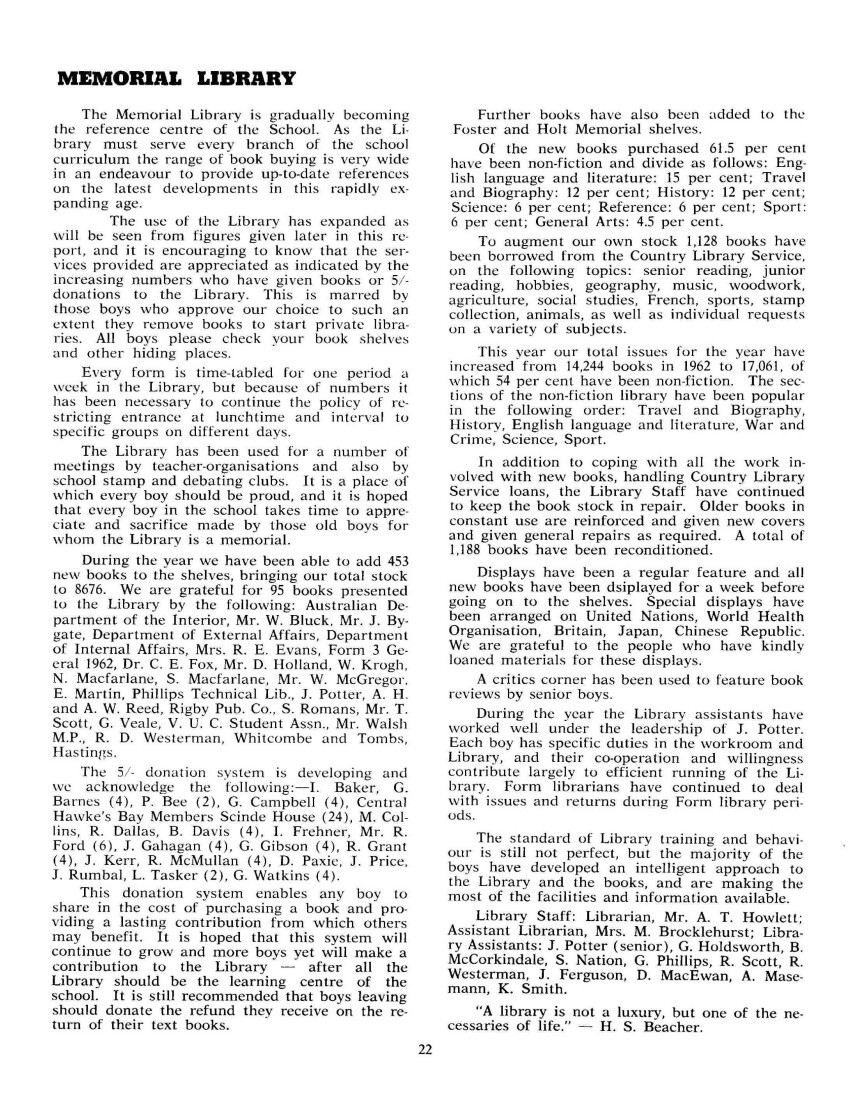
Page 23
MUSIC
“The exercise of singing is delightful to nature, and good to preserve the health of man” William Byrd, 1588.
This year the fourth Post Primary School’s Music Festival was held in the Centennial Hall, Napier, on Saturday, May 4th, with Mr. W. Walden-Mills, National Adviser on School Music, as guest conductor. The following schools took part: Colenso High School, Hukarere School, Napier Boys’ High School, Napier Girls’ High School, St. Joseph’s Maori Girls’ College, Sacred Heart Convent, Woodford House.
The School Choir sang the following: “The Earth is the Lord’s,” (arranged Sykes), “Raise your voices, raise your hearts,” (arranged Mitchell), “Old King Cole,” (arranged Dunhill). The Bass Choir sang in the following massed items: “Tramping Song” (Gilbert), “You Gentlemen of England” (arranged Griffiths), “Praise My Soul” (arranged Griffiths), “Now is the Month of Maying” (arranged Ritchie), “With a Voice of Singing” (by Shaw), “Laus Deo” (by Galway), and “God Defend New Zealand” (arranged Griffiths).
For the School Anzac Service held in the Hall the school sang “Let us now praise famous men” (Galway), and the Crimond arrangement of Psalm 23.
At the 1962 Prize Giving the following songs were presented by the school: “Sleepers, Wake” (Bach), “Torches, Torches” (Joubert), “Land of Hope and Glory” (Elgar), as well as “God Save The Queen,” “Gaudeamus,” “Forty Years On” and “God Defend New Zealand.” We were grateful to Mrs Quarrie and Mr. Mundy, who played the accompaniments.
Ten boys, Bluck M.; Buchanan, A.; Chapman, P.; Cowan, W.; Elliott, J.; Ferguson, J.; McEwan, D.; Revell, S.; Smith, K.; Smith, M. and Worsnop, B., were trained at school to take part in the New Zealand Opera Company’s production of “La Boheme,” presented in Hastings and Napier at the beginning of the second term.
Several boys were selected to take part in a series of “Youth Programmes” organised by Station 2¥Z of the New Zealand Broadcasting Corporation. As guitar playing is so popular, a small class was formed in the second term to help beginners extend their ability on this instrument.
Because of the heavy timetable of engagements for the first official visit of the Governor- General to Napier the School Prize-Giving has had to be shortened to one hour. In order to do this, the programme of music has been reduced to the National Anthem, Gaudeamus and Forty Years On.
The 1963 Singing Competition was judged by Mr. Fitzwater of the New Zealand Broadcasting Corporation. The results were: senior section: R. King, K. Seuseu and G. Williams; junior section: M. Waite, T. Masemann and D. McEwan.
THE PIPE BAND
This year the melodic sounds of the bag-pipes echoed across the school grounds for the Battalion Parade and March Past at the beginning of the year. This successful turn-out was the result of four days of conscientious practice during Barracks Week. It was suitably rewarded by many favourable comments passed afterwards, and by the request to turn out once again at the end of the year to provide suitable music for a special battalion parade and inspection.
Throughout the year the membership of the band has remained at about 6-7 playing members, together with a few learner drummers. Small though it may seem, this is nevertheless a strong, keen group. The band has limited opportunities to play in public, but the outlook for next year is very promising.
The membership of the band as at November 1963 is as follows: –
Drum Major: K. Flowers.
Pipe Major: G. Lydford.
Drum Sergeant: G. Warman.
Pipers: K. Astwood, D. Jenkinson, T. Wharton.
Drummers: G. Crarer (side), J. May (bass), P. Smeath (side).
K. C. F.
SONG TITLES
“All things bright and beautiful.”
The Prefects !
“Friendly persuasion.”
The corvee system !
“Baby, you’re so square.”
Geometry !
“With a little bit of luck.”
No homework !
“Please help me, I’m falling.”
The Gymnasium.
D. H. M. and J. P. S.
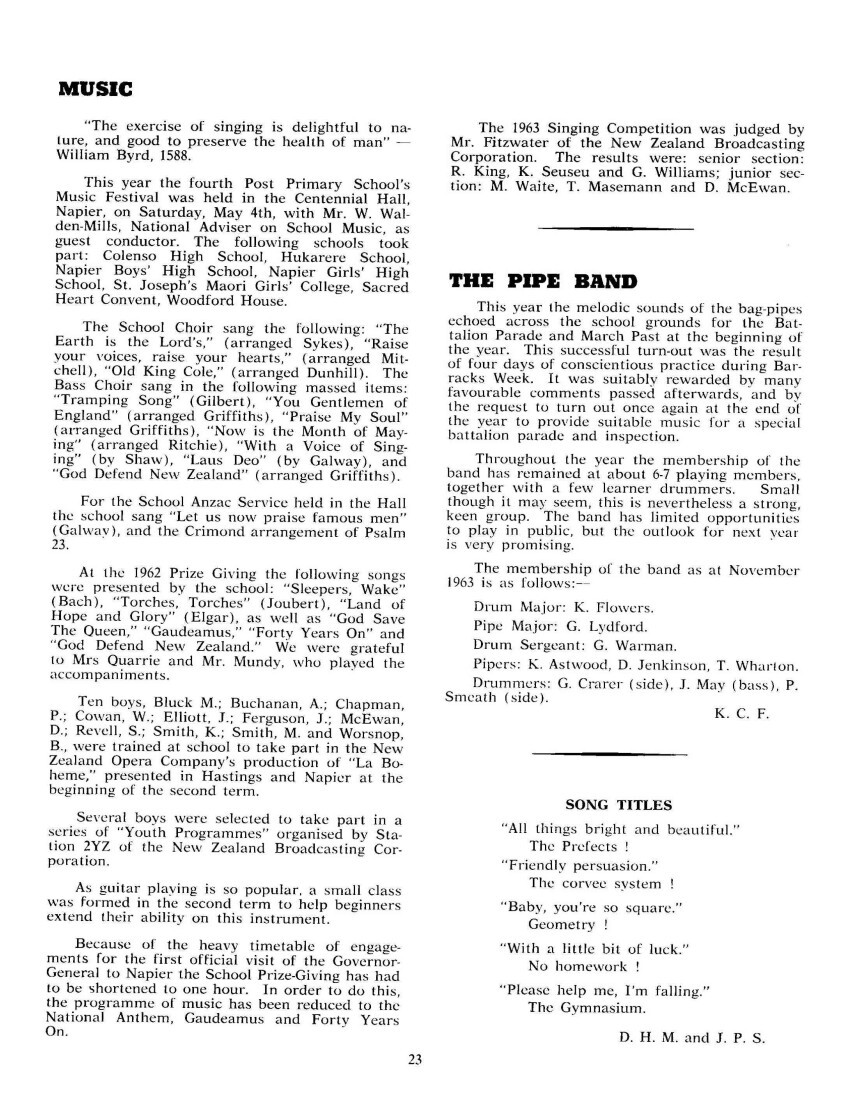
Page 24
CLUB NOTES
THE ART CLUB
Earlier this year, due largely to the enthusiastic guidance of Mr. I. Roberts, the school Art Club was formed. The club, which has some twenty members, (mainly from the fourth and fifth forms), meets in the Art Room during Wednesday and Friday lunch-times.
The activities of the club cover ink and charcoal drawing; oil, tempera and water colour painting; clay modelling and plaster carving. Experimentation in all media has been encouraged, and many of these ventures have been highly successful. Added incentive was given to members during the second term by the organisation of an art exhibition and competition, which proved well worthwhile. We are most grateful to Messrs. Peter Liley and Russell Williams for their valuable assistance in judging this competition.
Results of Art Competition:
Senior: J. Vivieaere, 1; J. Thornburrow, 2.
Intermediate: J. Stayt, 1; A. Parker, 2; A. Davis (highly commended).
Junior: B. Mortensen, 1; B. Taaffe, 2.
Modelling Prize: D. Miller.
In conclusion, members would like to thank all those who have so generously given their time and talents to assist the club.
J. Stayt.
DRAMA CLUB NOTES, 1963
This year the Drama Clubs of the Boys’ and Girls’ High Schools made school history by staging a combined production of “She Stoops To Conquer,” by Oliver Goldsmith. Auditions were held at the Boys’ and Girls’ High Schools, and rehearsals started after the May holidays. These took place from four to six o’clock every Monday, Wednesday and Friday, at the Girls’ High School, and every Sunday, from two to five o’clock, at the Boys’ High School.
Our special thanks go to Mr. Henderson and Miss Wilson for allowing us to stage the play which, I am sure, will become an annual event. Thanks also to Mr. Monrad and Miss Allen for producing the play, Mr. Roberts and his Art classes for painting the scenery, and the public for coming along to the play.
The cast of the play were: Wendy Nelson as Mrs. Hardcastle; Huon Chandler as Mr. Hardcastle; Allan Tolley as Tony Lumpkin; Beverley MacIntyre as Kate Hardcastle; Juliet Walker as Constance Neville; Geoffrey Williams as George Hastings; Robert Dallas as Charles Marlow; Annabel Wright as Pimple; Ralph Thomson as Sir Charles Marlow; Ashley Kells as Roger; Colin Lum as Diggery; Allan Mitchell as Stingo; and June Irwin as Bet Bouncer.
Some of the costumes were loaned by Mana College, and to them we extend our heartiest appreciation. Thanks also to Mr. T. Cardo, Mrs. M. Campbell, and Mr. J. Thomas, for make-up, and all those people who gave up their weekends to help build the flats. George Ebbett accomplished a most difficult task as Stage Manager of a cramped stage.
After a most enjoyable time, it is with pleasure and anticipation that we look forward to next year’s production.
R. Dallas.
CRUSADERS
Once again Crusaders have been meeting together in the Cinema Room on Wednesdays. Our purposes in meeting together have been to show that the Bible has an important message for people today, and to see how its truths can be applied in daily life at school. We have endeavoured to fulfil these aims by various activities, besides the usual weekly meetings.
All new boys to the school were invited personally to the first meeting of the year, when an outline of Crusader work was given, including coloured slides of Crusader holiday camps. Most of the meetings throughout the year have been in the form of Bible Studies, led by Mr. Yeoman and Mr. Mundy. These studies give a clear understanding of the basic principles of the Christian faith to all who are interested. Outside speakers have included Dr. Martin (Crusader Travelling Secretary), Mr. Kay Liddle. of New Guinea, Rev. Gray of Indonesia and Mr. Peter Shearer of the Lebanon Mission. These speakers have aroused our interest in Missionary work, showing us the importance of Christian work overseas. Two films have been shown this year, “Souls in Conflict,” a Billy Graham film, and “City of the Bees.” Both these films aroused widespread interest throughout the school.
Outside activities have included a combined hike with the Napier Girls’ High School Union to Te Mata Peak in March. We passed through Moore’s Bush on the way to the peak and refreshed ourselves with a swim in the Tuki Tuki river on the way home. A combined barbecue was held on the Marine Parade in April, and this was followed by a “squash” (party evening) at the Clive Square Baptist Hall, when Dr. Martin showed slides of Crusader Camps.
In August our annual snow camp was held In the Kawekas. We are again grateful to Mr. Henderson for leave on the last Friday afternoon of the term. Our thanks are also extended to Mr. Pat Magill for the use of his house at Puketitiri. The camp was led by Dr. Martin and we are indeed grateful to him for his contined [continued] interest in our Union. A number of boys joined us from Hastings Boys’ High School and Colenso High Schools, making a total of twenty-seven campers and six officers. The weather was excellent and we all succeeded in reaching the highest point in Hawke’s Bay, Kaweka “J”. This camp was a time of physical and spiritual benefit for all, and a new sense of unity was given to our Union.
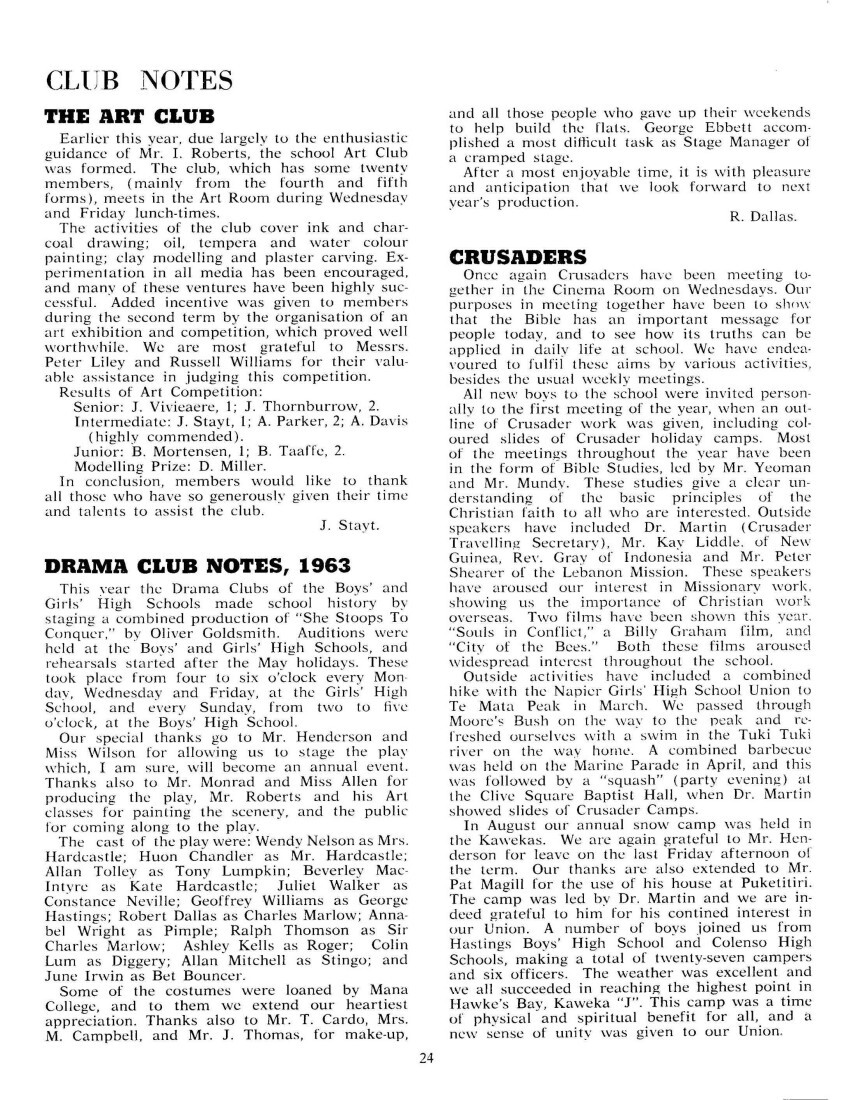
Page 26
The annual meeting of the Crusader and Scripture Union Movement was held on 8th October in the Anglican Synod Hall. Mr L. G. Becroft B. E., the General Secretary of the Movement, was the speaker, and brought us face to face with the tremendous challenge of Crusader work both in New Zealand and in South East Asia.
We are all very grateful to Mr. Mundy and Mr. Yeoman for their leadership of the Union, and the trouble they have taken to organise many outside activities. Our best wishes go to all Crusaders, both to those leaving school, and those returning next year. We are also very grateful to Mr. Henderson for the interest he has shown in our Crusader Union over the years.
J. R. Irwin.
STAMP CLUB
The N. B. H. S. Stamp Club was formed for the first time during the second term. The membership at approximately seven members was disappointing, however, we carried on. It was decided to hold lunchtime meetings on Friday, and evening meetings every month. We are indebted to Mr. Howlett for the use of the Memorial Library.
Small attendances were the characteristic of all meetings, and owing to this, Friday meetings proved unsuccessful. Two evening meetings were, however, enjoyed by all who attended.
Mr. Snadden, the chairman of the H. B. Philatelic Society, gave us some very useful hints on the running of the club. He also donated some magazines and showed us his well set-out collection with a theme of “Stamp Centenaries.” All agreed it was a most enjoyable meeting.
Mr. Whincop was the guest speaker at our second evening meeting, and unfortunately very few
people were present to hear his excellent talk on “specialist” collecting. His talk was centered around the showing of slides.
If to be carried on, the stamp club must be boosted by the school, or otherwise an attempt will be made to carry the club on in Scinde House.
S. Nation.
“TOP MARKS” QUIZ TEAMS
“Top Marks,” a quiz for school teams of three seniors and one junior as spelling champion, was again conducted this year by station 2ZC. Under the very capable organisation of Mr. R. Mundy, N. B. H. S. entered two teams in the programme. The No. 1 team consisted of A. J. Mitchell (leader), R. Tucker, M. Howell, with W. Vautier as speller, while the members of the No. 2 team were G. Dale (leader), B. Brendon, K. Hing, with R. Porter as speller.
These teams did not achieve the success of former representatives of the school, having very mixed fortunes. The No. 2 team did slightly the better of the two, gaining the highest marks of the series in one contest. However, we must congratulate the Sacred Heart team on winning the series.
The series conducted in term I also attracted two teams from N. B. H. S. Again the No. 2 Team did better, scoring three wins. The teams for this series were:
No. 1 Team: J. A. Piper, R. McKelvie, B. R. Baudinet, M. McSporran.
No. 2 Team: N. Jackson, A. Tolley, R. Malcolm, J. Knight.
A. J. M.
THANK YOU, BILLETERS
Mr. Campbell, the first assistant seldom fails to mention in assembly that boys who take visitors to stay at their homes get the day off school to act as hosts. But, surprisingly, this is not the real motive of those who offer billets to hockey, debating, football, tennis and athletic teams visiting the school.
The demand has been particularly heavy this year, when the Inter-Secondary Schools’ Athletic sports were held in Napier. In one week of March, very numerous billets were required twice in the same week, and some families offered each time. Mr. Campbell, the prefects and other sports masters went to a great deal of trouble to obtain billets within the school. Otherwise our activities’ fund would be seriously drained to pay for accommodation.
We do indeed thank parents who, in a quiet way, give their generous hospitality. At times, when there happened to be a vacant bed or two in the hostel, visitors have even been billeted there,
thanks to the generous provision of Mr. Brown and the Scinde House staff. We have wondered which of the boarders gets the day off school to act as host in that case!
Perhaps it may be by standing around waiting for the visitors to arrive, or by transporting them in and out from some distance away, or providing for the visitors’ evening entertainment. In all these ways, the hosts are serving our school by their hospitality.
Many families naturally hesitate at first, but people who take billets seldom refuse to do it again. They usually feel well rewarded. We do not mean that they profit from the toothpaste and odd gear that always seems to be left behind, but that the bright breeze of a visit in the family is an enriching experience. Boys who come away on sporting visits are normally of excellent character and manage to convey their genuine appreciation in a way that makes their hosts feel it was worthwhile.
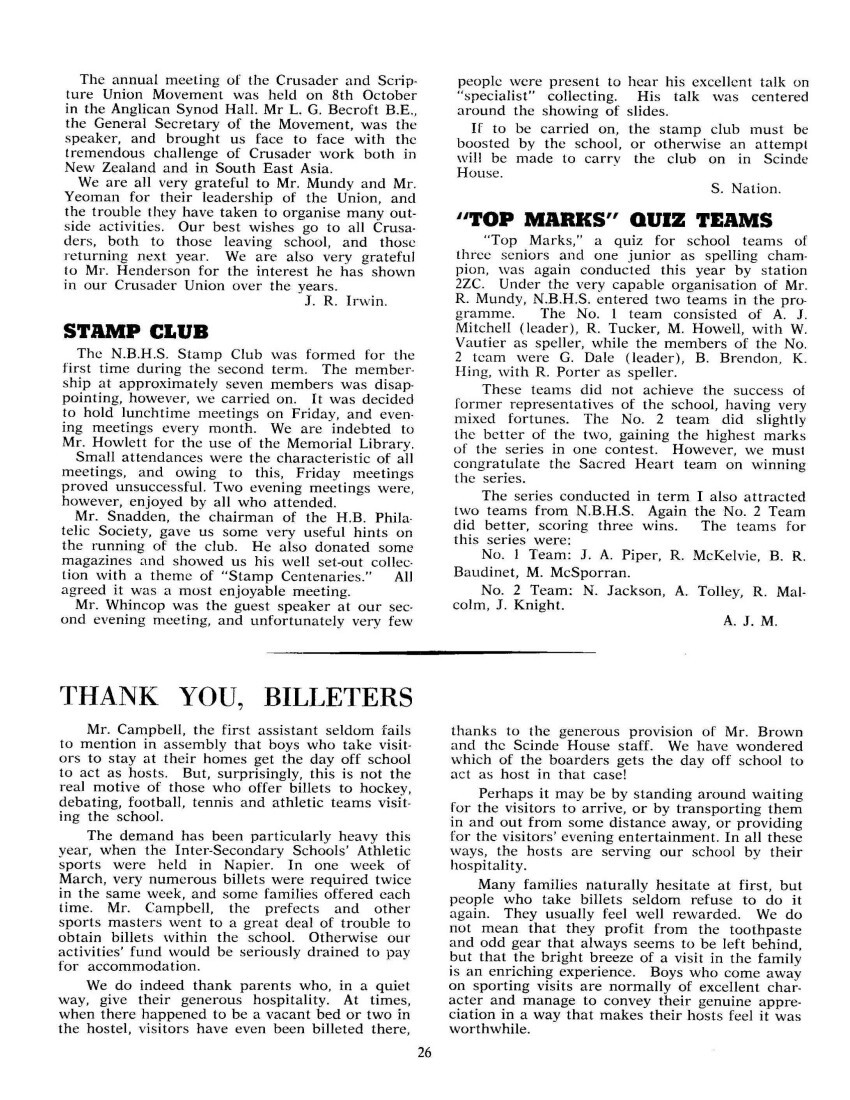
Page 27
FARM NOTES
SHEARING ON THE SCHOOL FARM
This year, as usual, a week was devoted on the school farm to the introduction of shearing and wool-handling. Included in the class was 5 Prac. Ag., 6 Ag., and McGregor of 6A, giving a total of ten.
The new woolshed provided excellent facilities for the task. Mr. Leo Sutton, of the New Zealand Wool Board, instructed in shearing and Mr. R. G. Montgomery, Sheep and Wool Instructor to the Department of Agriculture, aided by Mr. George Davies, a retired farmer, covered the wool handling side.
Mr. Sutton taught what is known as the ‘Bowen Technique’ of shearing. This style, developed by W. Godfrey Bowen and other top shearers of the country is being instructed throughout N.Z., and indeed many other wool producing nations of the world, including the Soviet Union, by 32 Wool Board shearing instructors. The chief aims of this technique are quality and ease of shearing.
The week concluded with competitions in shearing and wool handling, and the results were:
Open Shearing: 1st, E. W. McGregor; 2nd, A. Forrest.
Wool Handling: 1st, A. Forrest; 2nd, E. W. McGregor.
Shearing and woolhandling certificates were awarded to A. Forrest, R. Wooster and E. W. Mc- Gregor.
Great progress was made by all those who attended the class in these two extremely important skills which should prove invaluable when they leave school.
YOUNG FARMERS’ CLUB
The year 1963 was one of the most successful years in the history of the school’s Young Farmers’ Club. With a record roll of nearly 100 members, a total of eight meetings were held. Ewan McGregor was the club chairman and Hugh Pearse was the secretary, and with Nigel Dobson (vice-chairman) and John Sinclair, made up the committee. Mr. D. S. McKenzie filled the capacity of club adviser.
During the year the club was visited by a number of very interesting speakers, most of whom supplemented their talk with coloured slides. Subjects included “Safety with Firearms,” “Pig Husbandry and Piggeries,” “The work of the Catchment Board,” and “Woolshed Design.” All of these talks were received by nearly a full attendance, and the club is very grateful to those gentlemen who made themselves available. Also a very interesting evening was spent watching a total of five films on rugby tests. These were made available by Caltex Oil (N.Z.) Ltd.
The club was honoured with the presence of Mr. Peter McNeil (District Chairman), Mr. Curtis (District vice-chairman) and Mr. Blackwell District Advisory Officer), at one of the monthly meetings. Mr. McNeil spoke on the Y. F. C. movement and the advantages it has to offer its members.
The club once again had a successful year’s debating. Three teams were entered and the “A” team, consisting of E. W. McGregor, (leader), D. D. Kerr, and S. Nation, won the district junior debating competition when it defeated the “C” team in the final. It was unfortunate, however, that this team was unable to debate against other districts owing to examinations, as it was expected that further success may have been their lot.
In rugby the club distinguished itself by winning the district ten-aside rugby tournament held at Havelock North. After a series of hard matches the club met a Patoka-Eskview team in the final, and this game proved a battle royal, with the school side rising to the top.
It is hoped that all those members of the club who are leaving school this year join their local clubs and strive to do as much for the movement as they are able. For those members who are returning, may 1964 be for them a happy and successful year.
PIGS ON THE SCHOOL FARM
This year saw the introduction of pig-keeping on the school farm. As well as increasing the facilities for instruction and practical illustration in the agricultural course, they serve as an additional source of income and so make the farm even more diversified than it already is.
A new, modern barn-type piggery has been built at the cost of approximately £800. This piggery has been designed by the New Zealand Pig Council and offers up-to-date pig-keeping facilities. It has a capacity of about 100 pigs. In addition to the barn, there has been built a cookhouse, as it is intended that hostel garbage will be used to feed the animals.
During Labour Day weekend two National Hybrid sows were purchased from Massey College at the cost of £30 each. One has been mated to a Landrace and the other to a large white, and they are due to furrow on December 14. The National Hybrid pig was developed several years ago by the Pig Producers’ Council, through careful breeding and selection and offers many desirable characteristics required in a pig which is to be used for either bacon or pork production.
Preparation has been made for the purchase of two further large white sows from the Wairarapa late in January of next year.
E. W. McG.

Page 28
HOUSE NOTES
CLYDE HOUSE
Once again we have an opportunity to thank the House Masters, Messrs. B. G. O’Connor, D. C. Billing, C. E. Shorter, D. M. Brebner and R. B. Gourley, for their leadership of our House. The house officials this year were C. B. Frame (capt.), W. W. H. Nicholas (vice captain) and A. J. Schmidt (secretary).
The House provided six of the 1963 Prefects, which is felt to reflect honour on our endeavours.
In sports we have had our usual success. Early in the year we had our first triumph when our House gained first place in the School Swimming Sports, and A. McDougall won the Senior Swimming Championship.
The School Athletic Sports saw the House achieve second place, a position which was much helped by B. Duncan gaining the Junior Championship. C. Frame led the School Athletic Team at the inter-secondary school sports.
The captain and vice-captain of the school eleven, W. Larsen and A. McDougall respectively are also members of our House.
In the last of the summer sports, Clyde House was well represented on the tennis courts and in the rowing team, in which we had J. W. Potter and L. H. Karatau.
The vice-captain and five members of the First XV, together with a good representation in the lower grades, plus some excellent barracking from the side-line prove the House’s interest and ability in New Zealand’s national game.
We also provided the soccer and hockey teams with useful members; Captain A. J. Schmidt and B, Duncan of the former and C. Svendsen and T. Bates in the latter.
In the academic field Clyde House gained a large number of passes in School Certificate and U.E. for 1962, and with the large numbers of the senior forms who belong to the House, we have no doubt that these successes will be repeated this year.
The Debating Club had experience of our prowess in the field of contention; A. Schmidt led the team to two victories out of the three contests held during the year.
The Sub-Editor of “The Scindian,” who had the pleasure of trying to make sense of these notes, is one more of our illustrious members.
C. B. F.
HERETAUNGA HOUSE
“First we honour the School, then the House.”
The outstanding marching of our House teams in the tabloid sports was again commented on, and showed the excellent team spirit in Heretaunga House.
We are not big in numbers, but for two years the junior swimming champion has been a member of Heretaunga House. After R. Fox in 1962, R. Harding took this title in 1963 and became the Junior member of the school swimming team.
Prefect R. Chin has again brought distinction to the House by being captain of the school shooting team. The Heretaunga team came second in the inter-house shoot, R. Chin being top scorer and winner of the Vigor Brown belt.
In 1961, Heretaunga House had three of its members in the 1st XV. One of them, Mike Mohi, this year presented a cup to be awarded for ability and enterprise to a member of the 1st XV. However, the best that the House could do in 1963 was to provide four Heretaungans for the 3rd XV.
Heretaunga was well represented at hockey, with R. Campbell in the 1st XI, N. Campbell in the 2nd XI, and other keen players in the lower grades.
The House congratulates J. Hawkins, who was runner-up to the Junior Athletic Champion. He was chosen for the school athletic team.
At the beginning of 1963, M. Girvan was elected House Captain, R. Chin, vice-captain, and C. Jeffares, secretary. We thank our staunch band of housemasters, Messrs. Matthews, Crabb, Smart, Smith and Young, who have helped us with the management of our affairs.
M. R. G.
HAWKE HOUSE
Hawke has again had a good year in all school activities. We sincerely thank Messrs. Tuck, Pimm and Roberts for the work they have done.
Elected unanimously to the executive of Hawke House for 1962 were: S. Godfrey (captain), A. Tuck and L. Campbell in support.
Owing to the fact that there was only a handful of seniors (four 6th formers), there was no representation of the house among the prefects. However, we did have one member in 6A, J. R. Irwin, two members of the 1st XV, P. Tuck and S. Godfrey, one member of the 1st XI, L. Campbell, and one from the tennis team, B. Baudinet. So it can be seen that Hawke House is endowed with members who are Interested in all school activities.
The athletic and swimming sports again witnessed good Hawke entries and several boys gained distinctions, both for themselves and for their house. M. Mear performed well for the house and was intermediate athletic champion. R. Bell, I. Baudinet and B. Ennor also have represented the school in tennis.
Shooting has always been the strong point of the house, but unfortunately we lost the House Shoot for the first time in many years. Again Hawke House has had the strongest representation in the shooting team, fielding L. Campbell for the third year, P. Tuck for the second, and A. Jamieson for his first year.
Taking all into consideration, this house has had a very successful year, and with a surfeit of up-and-coming juniors, eager to do battle with the other houses next year, the future looks bright.
L. J. M. Campbell.
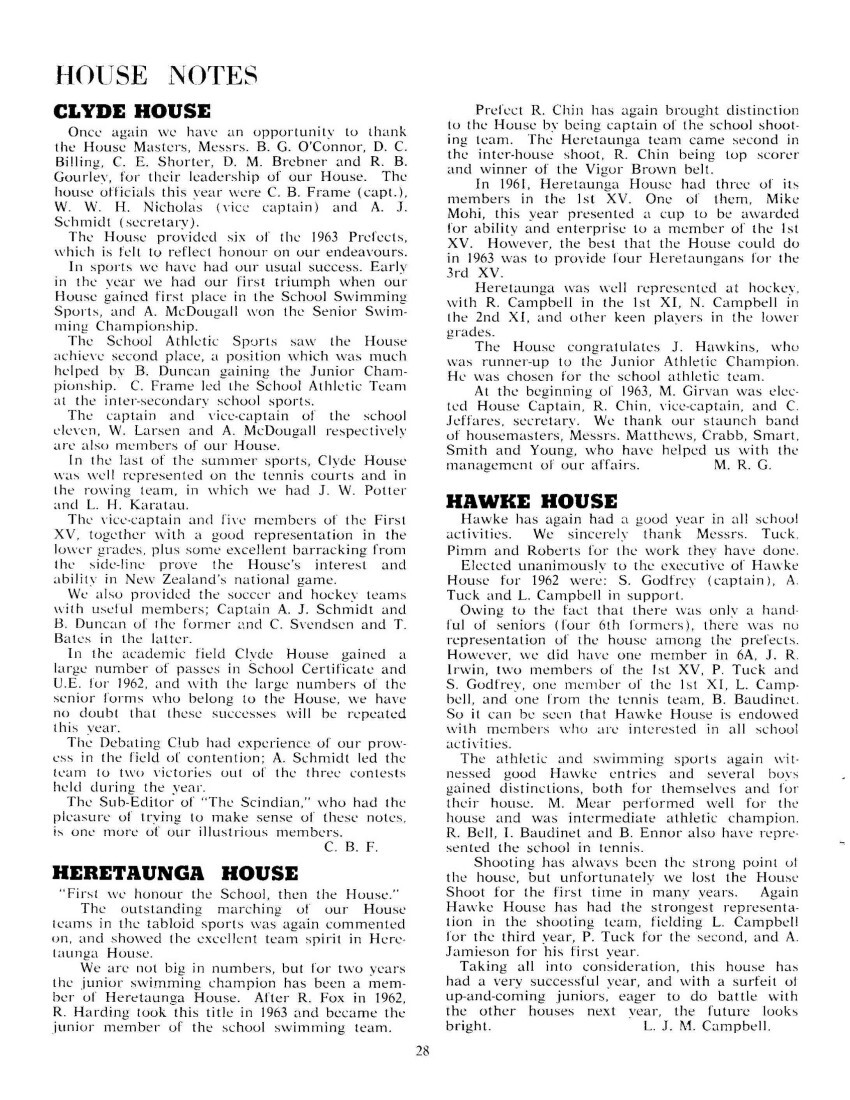
Page 29
COLENSO HOUSE
Although Colenso House is small as far as members are concerned, the absence of school prefects left a heavy burden on the shoulders of our head house-master, Mr. Webster. Mr. Webster, however, seemed to revel in these conditions and as the results below suggest, this has been another successful year for Colenso. Mr. Webster was ably assisted by Messrs. Monrad, Simpson and Nicol. We are all very grateful for their assistance and encouragement.
The year commenced with the election of J. M. C. Piper as House Captain and G. Paterson and I. T. Turbitt as Vice-Captains. W. E. D. Turner, R. L. King, and J. A. Piper were able assistants during the various activities of the year.
The House did well in the swimming sports, gaining second place in all over points, as well as having many outstanding individual successes. I. T. Turbitt, P. Loader and D. Gempton were selected for the school swimming team, Turbitt being runner-up to the senior champion and Gempton the intermediate champion. Paul Gempton won the Courtney Bowen Cup for most points in non- champ. events. The House topped off this activity by easily winning the Senior Relay.
The House did well in both the athletic sports and cross-country run, being placed second in the latter event. G. T. Wiig broke the intermediate javelin record in Athletics. We congratulate Ian Turbitt on his win in the steeplechase and C. Clark also performed well.
W. E. D. Turner and J. M. C. Piper were members of the 1st Cricket XI, with P. Exeter showing promise in one of the lower grades. R. K. Malcolm and J. A. Piper were in the school shooting squad, Malcolm winning the House Shooting Cup.
Once again Colenso House provided the backbone of the 1st Hockey XI with I. Turbitt, in his second year as captain, W. E. D. Turner, P. Loader and E. J. A. Alford representing the House. We had no members in the 1st XV, but J. M. C. Piper, T. Smart, R. Moody and J. Exeter playing well for the 2nd XV. W. A. Sadler and R. Roberts were prominent members of the 1st Soccer XI, both gaining representative colours.
Team spirit was illustrated in the annual tabloid sports, where both senior and junior teams were placed second.
In our personal opinion, Colenso once again keeping up the tradition of Hawke and An- sell, has produced the cream of the school’s intellect, with J. A. Piper, R. K. Malcolm, W. A. Sadler and several others all being prominent members of 6B. In the field of art J. Vivieaere shows great talent and is developing quickly in this field.
Thus it has been shown that the traditions of the focus of Napier the Hill have been well maintained by the Colenso House of 1963.
J. M. C. P.
NAPIER HOUSE
FLOREAT NAPIERA
Leading a small but faithful band of men have been Mr. Carpenter, Mr. Mundy, Mr. Smithson, and Mr. Hastrop, assisted by our House Captain, J. K. W. Isles and Vice Captain D. Marshall. Under their leadership and inspiration, Napier House, again the smallest in the school, has achieved some of the biggest successes.
For many years now, N.B.H.S. has produced powerful and impressive tennis teams. This year is no exception, largely through the contribution of the three top players who hail from this House, J. Scott, D. Marshall and B. Manson. It is fitting that the Senior Tennis Championship final should be fought between Marshall and Scott from our House. Our congratulations go to Scott, who becomes the Senior Tennis Champion is only his third year at High School. As if this were not enough, B. Manson emerges as the Junior Tennis Champion.
Keeping wicket for the 1st XI is T. Hall, whose safe hands are a consolation to any battered bowler. The promising youngster, R. Le Quesne has forced his way into the team, and assures Napier House of a bright representative in the future.
D. Cormack is a prominent member of our up-and-coming soccer XI, which is now a good match for Colenso. Nobody will question the supremacy of our hockey team. As can be expected, Napier House is again well represented with J. Scott and A. Rowe, both enjoying their second year in the team. R. Schofield gained a place in the athletic team, and J. Sutton shot well in the inter-house shoot, gaining most points for Napier.
For the second year now, J. K. W. Isles has been in the 1st XV. He also represented the school in the debating team, rounding off his public speaking successes for the year by winning the impromptu speech competition. Last year Napier House drew both associate editors, D. A. Paxie and J. K. Isles. This year J. K. Isles is the editor and C. Lum the sub-editor, so we see that the production of the “Scindian” is now even more directly due to the work of members of this House. Hence the careful planning and thoughtful editing of this school magazine reflect the high standard throughout Napier House. Our leaders and prefects, Marshall and Isles, gave us the incentive to maintain this standard.
Showing keen interest and striving together with obvious enjoyment, both the junior and senior teams in the Tabloid Sports gave creditable performances. Opposition was strong, as is shown by the House receiving fourth place, but the unity and determination in mutual support throughout our ranks is shown by both the junior and senior teams gaining fourth place in their respective competitions.
K. Barnes.
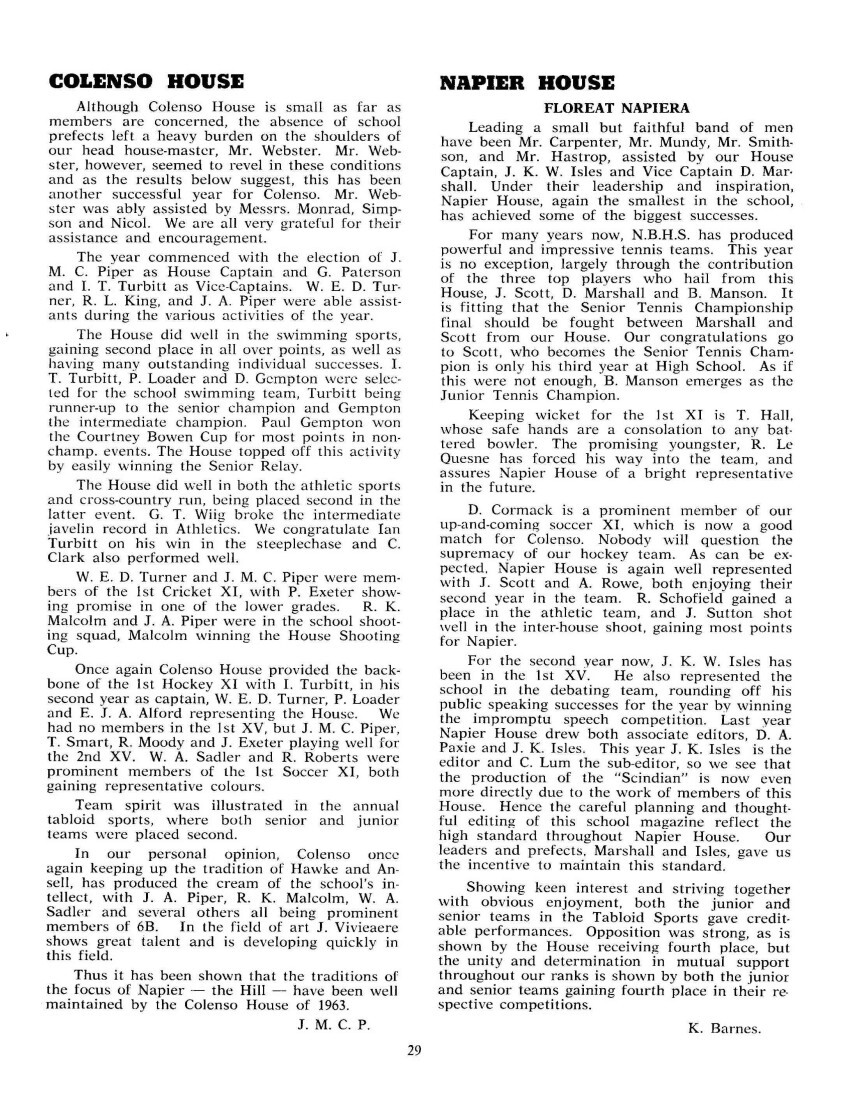
Page 30
SCINDE HOUSE
FLOREAT SCINDIA
Of the six school Houses, Scinde is unique in that it is made up solely of boys who reside in the boarding establishment. They therefore have at their disposal added facilities and opportunities for both sport and study, and a high spirit prevails.
The housemasters this year were Messrs. O. H. Brown, k. C. Flowers, G. Beer, B. Bannister and M. Hardy. During the first and second terms the boys farewelled Messrs. B. Thoms and D. Montagu respectively. Many will remember Mr. Montagu with pleasant feelings and for the sound advice that he gave to some of the boys as he left.
The prefects were E. W. McGregor (head), K. F. Seuseu (deputy head), A. J. Mitchell, B. A. Kells, N. W. Dobson and A. J. Mackintosh. Of these the first three were school prefects also.
Once again the boys are very grateful to the domestic staff for the way in which they handled this very important department. In particular, thanks must go to the matron, Mrs. Harvey, and to Miss Butcher, Miss Wood and Mrs. Bellerby who were the sub-matrons.
In scholarship the House can boast of an 87 per cent pass in U.E. accrediting, with 13 out of 15 successful. It is anticipated that a large portion of the School Certificate candidates will read their names in the newspaper towards the end of January of next year.
As usual Scinde House had many successes on the sporting field, the most notable of all being in rugby and athletics.
Twelve of the twenty members in the First XV were House boys. These were McGregor (captain), Seuseu, Mackintosh, Dobson, Pearse, Thornton, Robinson, Morrin, Carney, DeDenne, Herbert and Taylor. The Dayboys-Boarders match resulted in a victory to the House by six points to three. In addition to those members of the First XV, Chrystal, Jensen and Goulding made up the team, and all played well.
Over 130 of the 187 boarders chose rugby as a winter sport and made up a notable portion of all the 15 teams who played on Saturdays.
In athletics, as a result of the devoted training of many of the boys, the House scored many successes. Fourteen of the 23 in the school athletic team were boarders. In the school athletic sports, A. Mackintosh was senior champion with D. Taaffe runner-up. R. Nant was runner-up in the Intermediate Championship, and D. Munro was first equal in the junior championship. B. Mackintosh won the junior steeplechase after running extremely well. The House won both the Senior and the Junior Tabloid Sports.
The Scinde House sports were an outstanding success. These were held at the beginning of the third term on a glorious day. Taaffe (senior), Nant (intermediate) and B. Mackintosh (junior) won their respective grades. The House was very grateful to Mr. Simpson, Mr. Matthews and other day masters for their generous help.
D. Taaffe and G. Dick were both members of the extremely successful 1st Hockey XI. Seuseu, Thornton, Taaffe, Chrystal and Pearse all played cricket for the 1st XI. In softball the school team, made up wholly of boarders, played regularly in the H.B. competition.
The House shooting team won the Kiwi Cup in the annual house shoot. This team consisted of MacDonald, Kerr, R. Kells, McGregor, A. Mackintosh, J. Lancaster and T. Morrison (reserve). The first three of these represented the school at this sport.
B. A. Kells and R. Thomson both played for the school “A” basketball team. In rowing, six of the school eight were boarders. Scinde House members once again provided the backbone of this worthwhile sport and their keenness is a credit to them.
Over half the house were members of the Young Farmers’ Club and nearly all attended regular meetings held in the lounge. Because nearly all the boys in the house hail from farms, a special interest is taken in the agricultural course, and all the agricultural prizes were won by house boys. McGregor was successful in the shearing competition and A. Forrest in the wool- handling.
During the second term, Bible Classes were once again conducted, the Presbyterian by the Rev. W. R. Hay, and the Anglican by Captain Coughlan of the Church Army.
Films were regularly featured on Saturday evenings and these were thoroughly enjoyed. The house had several nights out, both to highly recognised films and to stage productions in town.
May the spirit and traditions of Scinde House live not only through 1964 but for as long as the House exists.
E. W. McG.
ASSEMBLY GEMS
“If you come without sports gear tomorrow, you’ll simply be shot! straight! inside!’’ (Mr. Campbell, 10th July, 1963).
“At our visit to Colenso they turned on for us magnificent weather, an international Rugby match, which we attended, and the Cherry Blossom Girls who were staying in our hotel.” (Senior Inspector, 10th July, 1963).
“At my first inspection, Miss Hetherington asked my 5R History class what was the first event of the French Revolution. The class were all primed, and said the Taking of the Bastille. Miss Hetherington asked if it was the VERY first event, and every eye turned accusingly at me because I had given them a false answer.” (Mr. Henderson, 8th July, 1963).
“The Second Fifteen leave for a match with Gisborne to-day. At the back of the scum is Skjottrup.” (Mr. Henderson, 2nd August, 1963).
“Boys’ Schools are unknown in the United States, as everybody believes in growing up naturally.” (Miss Robinson, American Field Service Scholar, 19th August, 1963).

Page 31
MILITARY CADETS
Major R. C. Tuck retired after being Commanding Officer for nearly five years. He has poured enthusiasm and interest into the cause of military cadets, and has spent countless hours in paper-work and organisation. His successor as C.O. is Squadron Leader D. G. Revell, who is very keen to keep the reputation and usefulness of this activity up to a high standard. Special N.C.O. classes have been organised, directed by Sgt. Parsons of the Regular Force, at the end of Term 2. N.C.O. training sessions have prepared for military days.
There has been a large N.C.O. Training Unit, commanded by Lt. Monrad. A good spirit has existed in this unit, and members have had to work for a high standard to hold their place in it.
With the cadet battalion growing all the time (this year about 800 cadets), the fine body of N.C.O.’s has wonderfully met the demands for leadership and instruction. The N.C.O. training done this year will produce a valuable supply of N.C.O.’s for 1964. Many from the unit have already attended training courses at Linton, and more will do so in January, 1964.
Barracks Week, 11-15 February, 1963, concluded with a Parade and March Past inspected by the Headmaster. In the first term, military days were held on April 3 and May 8. The last week of the school year will allow for two more days on December 9 and 10. The C.O. plans to make extensive use of the rotational system of training for these two days. In addition, the shooting teams have spent the afternoon at Roys Hill Range on June 19, July 24 and September 24.
Specialist units have worked with particular enthusiasm this year. Their interest has again proved the value of having specialist instruction available. The specialist units are: Signals, Lt. Gourley; Medical, Lt. Mundy; Mortars, Lt. Billing; N.C.O.T.U., Lt. Monrad. These provided demonstrations on the Friday morning at the close of Barracks Week.
The Pipe Band did credit to Mr. Webster and to Mr. Flowers, who has taken over from him. The band played extremely well during the Battalion Parade at the beginning of the year.
2/Lt. Lloyd joined the staff of officers this year: Lts. Mundy, Monrad and Nicol attended officers’ courses at Linton in the first week of the May holidays. W.O.I. E.W. McGregor went through the R.S.M.’s course at Burnham on January 4-14, and was very well commended by the Chief Instructor, Major Ponanga.
Elsewhere in this magazine we express thanks to Major Collins, who retired as area officer of Area 7. Major Kearney, his successor, has already visited the school to advise about the new small bore rifle range.
Thanks are extended to Sgt. Major Gleeson and Staff Sgt. Hood of the Regular Force, who have generously secured films and training equipment. Thanks also to the Radiography and Pathology Departments of the Napier Public Hospital, who have helped with training medical personnel.
Finally we thank all masters not attached to military cadets who have organised the recreation periods, and provided many enjoyable games of soccer and softball, as well as training in the techniques of resuscitation for all cadets. In this they had the assistance and equipment of Mr. Angove (St. John Ambulance Assn.).
ORGANISATION
C.O.: Squadron Leader D. G. Revell.
2 I.C.: Capt. J. W. Bygate.
Adjutant: Lt. R. Gourley.
R.S.M.: W.O.I. E. W. McGregor.
Records: Sgt. R. Thomson.
Shooting: Capt. W. T. Carpenter, Major R. C. Tuck, Sub. Lt. D. S. McKenzie, Flt. Lt. D. M. Brebner.
Armoury: Captain J. W. Bygate, Sgt. R. Chin.
Pipe Band: Mr. K. C. Flowers.
H.Q. COMPANY
O.C.: Lt. D. Billing.
C.S.M.: W.O.II. W. W. Nicholas.
Mortars: Lt. D. Billing, Set. R. Sherwood.
Medical: Lt. R. Mundy, Sgt. D. Cormack.
Signals: Lt. R. Gourley, Sgt. R. Malcolm.
N.C.O.T.U.: Lt. D. Monrad, Sgts. J. MacLeod and
O.C.: Capt. J. D. Briasco.
A Company:
G. Liddell.
Lieut. G. Crabb.
C.S.M.: W.O.II. K. F. Seuseu.
No. 1 Platoon: Sgt. W. Larsen.
No. 2 Platoon: Sgt. A. McDougall.
B Company
O.C.: Capt. B. G. O’Connor.
2/Lt.: J. Lloyd.
C.S.M.: W.O.II. Robinson.
No. 1 Platoon: Sgt. D. Marshall.
No. 2 Platoon: Sgt. A. Mitchell.
No. 3 Platoon: Sgt. R. Hobin.
C Company
O.C.: Capt. C. H. Matthews.
Lt. C. F. Smith.
C.S.M.: W.O.II. J. A. Piper.
No. 1 Platoon: Cpl. A. Wilson.
No. 2 Platoon: Cpl. G. Mackay.
No. 3 Platoon: Cpl. G. Coombes.
No. 4 Platoon: Cpl. P. Marshall.
D Company
O.C.: Capt. O. H. Brown.
Lieut. C. V. Nicol (Field Craft Instructor).
C.S.M.: W.O.II. A. J. Schmidt.
No. 1 Platoon: Sgt. D. Fergusson.
No. 2 Platoon: Cpl. E. Karatau.
No. 3 Platoon: Cpl. R. Cross.
No. 4 Platoon: Sgt. P. Anderson.
A.T.C. Squadron
O.C.: Fl. Lt. D. M. Brebner.
Adjutant: F.O. R. W. Pimm.
S.W.O.: F/Sgt. J. K. W. Isles.
A Flight: F/Sgt. S. Godfrey.
B Flight: F/Sgt. L. Karatau.
C Flight: F/Sgt. P. Spiller.
D Flight: F/Sgt. A. G. Tuck.
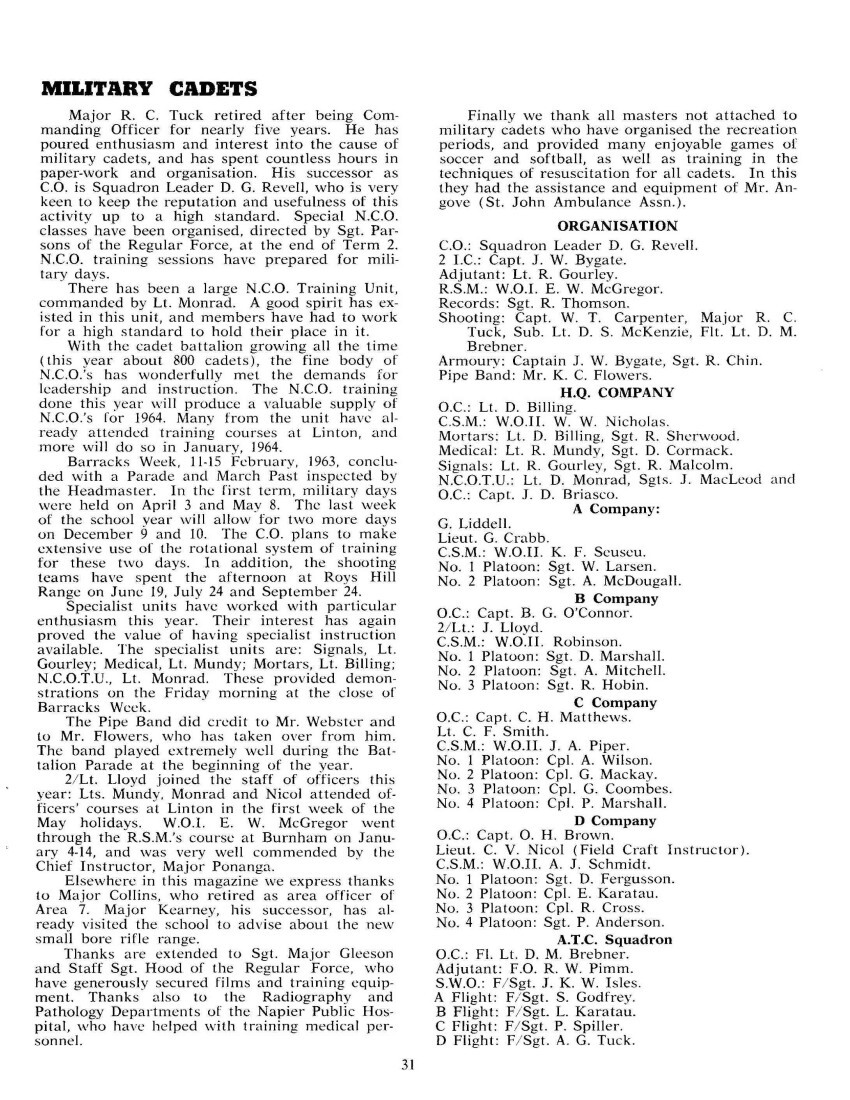
Page 32
A.T.C. NOTES
This year the A.T.C. has continued its good work of supplying leaders for the school. Squadron Leader D. G. Revell has been appointed C.O. School Cadet Corps, following the retirement of Major R. C. Tuck. N.C.O.’s and cadets of the A.T.C. join in congratulating Squadron Leader Revell on his deserved promotion, knowing that he will bring his customary efficiency and tact to the whole cadet unit. Throughout his years with the A.T.C., Squadron Leader Revell has taken a particular interest in the drill competitions, with the result that the A.T.C. has been the most frequent holder of both Senior and Junior cups in recent years. His appointment follows on from Roger Wiig’s transfer to the Army last year as R.S.M.
Sgt. L. Karatau represented No. 20 S.U. in the Central Area rugby team at tournament this year. He distinguished himself by being selected as first five-eight for the New Zealand A.T.C. team against Palmerston North Boys’ High School.
Several of our up-and-coming Junior N.C.O.’s and cadets attended a course at Ohakea during the Christmas and May holidays.
Squadron Leader Revell attended an interesting senior officers’ course in Lauthala Bay, Fiji, during January.
Although the roll increased this year, it was decided to limit the number of flights to four. In charge were Sets. S. Godfrey, L. H. Karatau, A. G. Tuck, S. P. Spiller. S.W.O. was J. Isles, ably guided by Flt. Lt. D. M. Brebner, and Adjutant F.O. R. W. Pimm. The unit is grateful to these officers for their help and co-operation which makes officers closer to the ranks than in the other school units. Also we record our appreciation of the manner in which Flt. Sgt. Stowell carries out his duties: no Army “bull-ring” tactics, but the end result, as shown in the Drill Competition, is far superior.
J.K.W.I.
RUGBY FOOTBALL
The year 1963 can in many ways be regarded as a successful season. It is true that we won no trophies, supplied no Hawke’s Bay Representatives and did nothing spectacular; but we did play good football.
Furthermore we fielded more teams in Saturday competitions than ever before. We are often criticised for entering teams in grades where they have little chance of success; but surely the game can be enjoyed without always winning, and surely the more that can be encouraged to take part the better. Would it not be true that the lower the ability, the greater is the room for improvement? This is our policy, and we shall stick to it until we are proved wrong.
Teams were entered in the Rugby Union competition as follows: – First XV playing in the Junior Grade; 2nd and 3rd XV’s in the Third Grade: four teams in the Fourth Grade; four in the Fifth Grade; two in the Sixth Grade; and two in the Seventh Grade.
Junior, third and fourth Grades have no weight or ability limit, and any age limit that there is certainly never favours school boys. The fact that our Third and Fourth Grade teams survived in such high class competition should be of great benefit when we are seeking our senior teams next year.
We still have with us the problem of the large number of boys who, for various reasons, do not wish to play for school teams on Saturdays, but still say that they want their mid-week football.
Two problems arise out of this. The most vexing and contentious problem is made by the boys who have been brought up through the lower grades by the city clubs, and who have no wish to be weaned away from the club for their few years at High School. An agreement was reached that no school boy would play outside the school in Fourth Grade or higher, or if he was a senior boy at school. This agreement was between the Clubs and the School, but in several cases it was broken because some parents still do not concur.
The other problem is made by those who have no wish to play on Saturdays at all, but still want their mid-week school game. This year a determined attempt was made to cater for them.
They were grouped, teams organised, jerseys supplied, matches arranged, but the response was most discouraging. They like unorganised fun (just watch them at interval and lunch time!), but the moment you try to plan for them and make a few rules, it seems that you kill the enthusiasm. This is certainly a problem, and it will have to be faced again next year. If you think you have a solution, let us have it, please.
R. C. Tuck.
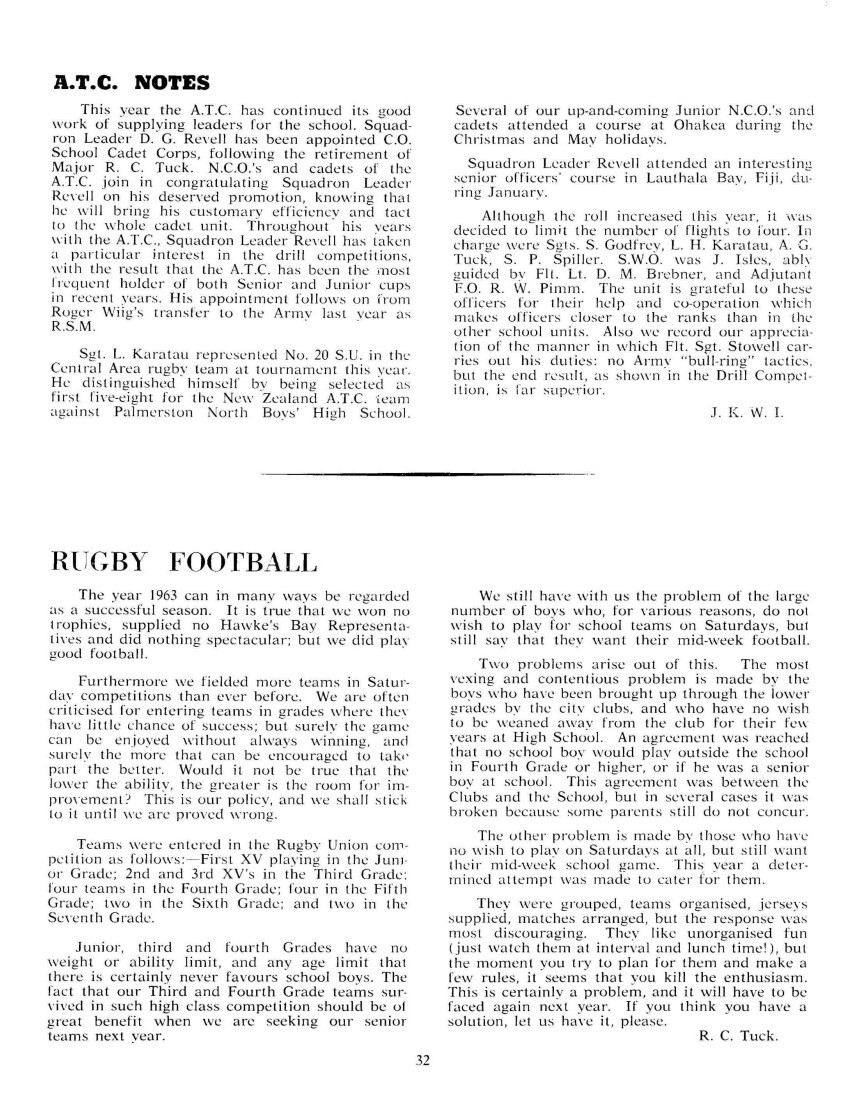
Page 34
FIRST RUGBY TEAM
Back Row: P. Carney, J. Isles, A. Tolley, H. Taylor, H. Pearse.
Middle Row: K. Seuseu, W. Larsen, J. Thornton, N. Dobson, C. Frame, A. Mackintosh, P. Tuck. Front Row: G. Robinson, W. Nicholas, Mr. J. D. Briasco (coach), E. McGregor (captain), L. Karatau, J. DeDenne, T. Morrin.
SECOND RUGBY FIFTEEN
Back Row: B. Chrystal, D. Goulding, L. Campbell, B. Baudinet, J. Piper, D. Kerr.
Middle Row: J. Potter, B. Ennor, J. Exeter, D. Skjottrup, R. Sherwood, W. Lawton.
Front Row: R. Forrest, E. Karatau, Mr. D. M. Brebner (coach), R. Elmes (captain), T. Smart, R. Moody.
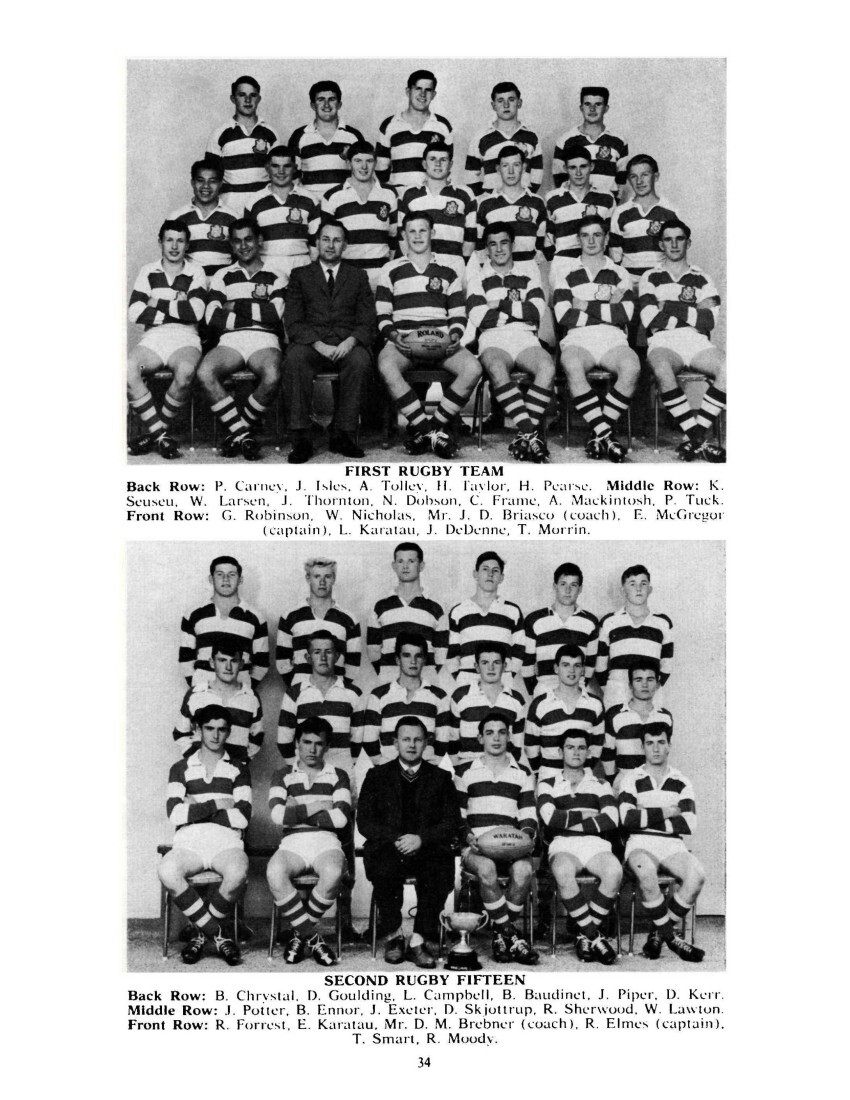
Page 35
FIRST FIFTEEN
This year the first fifteen had a very enjoyable season’s rugby and a considerably successful one. The team was able to beat Wairarapa College and draw with Hastings B.H.S., but lost to the Gisborne and Palmerston North Boys’ High Schools. It came second to a very strong Clive side in the local junior competition. In the 19 matches played throughout the season, six of which were lost and two drawn, it scored 158 points and had 131 registered against it.
A pleasant feature of the season was the closeness of all the matches. At no stage could the team afford to take its opponent lightly and half of the games played resulted in a score with a difference of 3 points or less.
Seven of the members were old caps and provided a core of experience to begin the season. Of the new players, many showed considerable improvement as the year progressed and we hope will go on to bigger things.
Of the backs, Karatau, who was vice-captain, Carney, Mackintosh and Seuseu are all worthy of particular mention. Karatau was of considerable danger close to the scrum and initiated many valuable back movements. Carney at fullback, another young member, played well throughout the season and his sure play won him the confidence of his team-mates. Mackintosh, with a ton of pace, was of constant danger on the wing and the fact that he won the tackling cup this year speaks for his defence. Seuseu and de Denne in the five-eighths both improved as the season progressed, with the latter gaining much experience which should be invaluable to him in the future. His handling, however, was a serious failing. It was unfortunate that Frame broke his ankle in the first match and his season was ruined. Certainly a blow to the team, as Frame is capable of good rugby.
The forward pack this year was very strong and heavy, at one stage weighing over 100 stone, with Tolley, Larsen, McGregor and Thornton all well over the 13 stone mark. In the loose Robinson demonstrated grand rugby and dedicated himself to every game he played in. His four tries made him the top scoring forward. Nicholas also turned in some good games. Of the tight forwards, Larsen, Godfrey, Dobson and Morrin were all toilers, the former being perhaps the find of the season. In the line-outs Tolley, with Thornton and McGregor, jumped well, but his general play unfortunately slipped a little as the season progressed. On the other hand, Thornton’s rugby improved markedly. Pearse hooked constantly throughout and Tuck’s hooking improved considerably as he gained experience. His all-round play was also very good.
Ewan McGregor captained the side this season and once again Mr. Briasco was the team’s coach. The team would like to thank him, not only for the way in which he prepared the side, but also for his attitude towards the game of rugby, which is one of good sportsmanship and spirit.
Individual record:
Games Tries Cons. P.G. Total
Carney 18 0 8 10 46
Mackintosh 18 7 – – 21
Karatau 18 4 – – 12
Robinson 15 4 – – 12
Seuseu 18 3 – – 9
Thornton 14 1 1 1 8
Herbert 18 2 – – 6
McGregor 18 2 – – 6
de Denne 18 2 – – 6
Taylor 7 2 – – 6
Larsen 18 2 – – 6
Tuck 8 2 – – 6
Isles 18 1 – – 3
Frame 4 1 – – 3
Dobson 12 1 – – 3
Morrin 9 1 – – 3
Pearse 10 – – – –
Tolley 12 – – – –
Godfrey 15 – – – –
Nicholas 17 – – – –
Thornton and Pearse were brought up from the second fifteen shortly after the start of the season. Chrystal played the first two matches and Piper played at centre for one match during the holidays.
v. Hastings Boys’ High School.
27th June. Drew 6 – 6.
This game was played at Hastings in conditions which were not particularly suitable for good rugby. A southerly breeze brought with it slight showers and recent rain made the surface of the ground very slippery. The 6-all draw was certainly a good indication of the run of play and the game was a torrid battle from go to whoa but both sides, however, lost many opportunities.
There was little between the forward packs, with Hastings being a shade quicker to the loose ball, but Napier dominated the tight. This was very noticeable in the second spell. Nicholas was the best Napier loose forward, while Tolley and Larsen, buried in the tight all day, toiled endlessly. In the backline Karatau played his usual sound game but the midfield backs suffered from handling lapses, which were often costly.
The first points of the match came our way late in the first spell, when Mackintosh went over in the corner from a miss-kick by Hastings. Shortly after half time Karatau scrambled over to score. Once again Carney failed to convert. This was the extent of our scoring and a good try and penalty by Hastings brought the score to 6 all. Hastings would have also scored again but for a dropped pass.
The team: Carney, Mackintosh, Herbert, Isles, Seuseu, de Denne, Karatau, Godfrey, Robinson, Nicholas, Tolley, Dobson, McGregor, Larsen and Pearse.
v. Gisborne Boys’ High School.
27th July. Lost 21 – 11.
The morale of the team in Gisborne had fallen noticeably from previous matches and its display was disappointing. On the day the 21 – 11 win

Page 36
to Gisborne was undoubtedly deserved, but had the team played as it did in most other matches, the result could have been a different story.
The match was played on Rugby Park in front of a large crowd. A very strong wind blowing diagonally across the ground hindered enterprising rugby, and the game was not the spectacle that was expected.
Throughout the match Napier never really settled down, the forwards in particular failing to live up to their previous form. The pack lacked co-ordination and drive in the tight, while in the backs, handling and tackling were undoubtedly weak. Because of the high wind the ball had to be thrown short to McGregor at No. 2 and he took a heavy pounding.
Of the back play, the “Gisborne Herald” said, “Seuseu, the second five-eighths, was dangerous at times, but things were by no means happy closer in. In what play he did see, the left winger, A. Mackintosh, shaped well and was the only Napier back to look as if he was really running. Better served, Mackintosh could have been a headache to the Gisborne defence.”
Our points came from a try by Isles, which was converted by Carney, who also kicked two penalties.
Gisborne scored four tries, three conversions, and a penalty.
The team: Carney, Mackintosh, Isles, Frame, Seuseu, de Denne, Karatau, Thornton, Godfrey, Nicholas, Tolley, Dobson, McGregor, Larsen, Pearse. The referee was Mr. R. Harris.
v. Palmerston North Boys’ High School.
7th August. Lost 14 – 6
Palmerston North B.H.S. is noted for its very strong and heavy rugby teams, and this year was no exception. Also no exception was their definite win-at-all costs attitude. However, their 14-6 victory in the annual Polson Banner match was well deserved.
Palmerston North played the game in their forwards throughout and their line-out play and set scrummaging was definitely superior to Napier’s. However, their backs could have done more damage had they been used to better effect. Palmerston North had many well drilled moves from their line-outs and these had their Napier counterparts baffled on numerous occasions, especially when we were hard on defence.
At half time Palmerston North had scored all their 14 points and, being a team reputed to be very fit, it appeared as if Napier was in for a heavy defeat. However, this was not to be the case. The lighter Napier team fought back with spirited determination and drive, and were able to score 6 points to none in those 40 minutes. These came from a good try by Karatau and a penalty by Carney.
The team: Carney, Mackintosh, Herbert, Isles, Seuseu, de Denne, Karatau, Godfrey, Robinson, Nicholas, Thornton, McGregor, Larsen, Pearse, Morrin. Isles retired injured in the first spell and was replaced by Frame. The referee was Mr. Ivan Versalko.
v. Wairarapa College.
14th August. Won 16 – 0.
Until this game the team had yet to win a school match and we were thus determined to clasp a victory against Wairarapa College. This we were able to do, and our 16 nil win improved our record considerably. However, at half time with the board reading nil all and with Wairarapa College a shade unlucky not to have scored the situation left nothing to be desired.
In this match Karatau, Carney, and Mackintosh all turned in sound games with Seuseu and de Denne playing good rugby in the second spell. In the forwards no individual really stood out, although Robinson deserves special mention for his aggressive game.
At no stage did Napier settle down in the first spell, but after half time it was a different team. This was illustrated immediately after the restart of play when the blue and white jerseys made a thrust deep into Wairarapa territory, which almost resulted in a try. It was not until about the 15th minute, however, that Napier scored when Herbert went over in the corner following a jinky run. Robinson then went in for a good try, which was begun by de Denne, who scored the next points soon afterwards, when he went over after gathering up the ball from loose play. Then in the last minute of the match Seuseu carved up the Wairarapa backline nicely and passed infield to McGregor, who scored under the posts. Carney converted this and Robinson’s try.
The game was exciting and enjoyable, played in pleasant conditions.
The team: Carney, Mackintosh, Herbert, Isles, Seuseu, de Denne, Karatau, Godfrey, Nicholas, Robinson, McGregor, Thornton, Larsen, Morrin, Pearse. The referee was Mr. Craig.
E. W. McG.
DAYBOYS – BOARDERS MATCH
This year the boarders retained the Stewart Shield with a 6-3 win over the dayboys. The match was played in rainy conditions, and the ground was muddy. The boarders’ team, with 12 members in the First XV, took the field as the favourites to win. However, the dayboys rose to the occasion, especially their forwards, who gave their heavier boarder counterparts a ton of trouble.
In the first half the boarders had a decisive territorial advantage and were able to score two unconverted tries, one by Seuseu and one by Carney. However, in the second spell the situation was completely reversed, with the dayboys taking the territorial honours. In spite of this, they were able to score only once, when Lawton forced following a line-out, but were a little unfortunate perhaps on one or two other occasions. Marshall, brought into the side for his kicking, had numerous attempts at goal, but was unable to put the sodden ball between the uprights, much to the relief of 15 weary boarders.
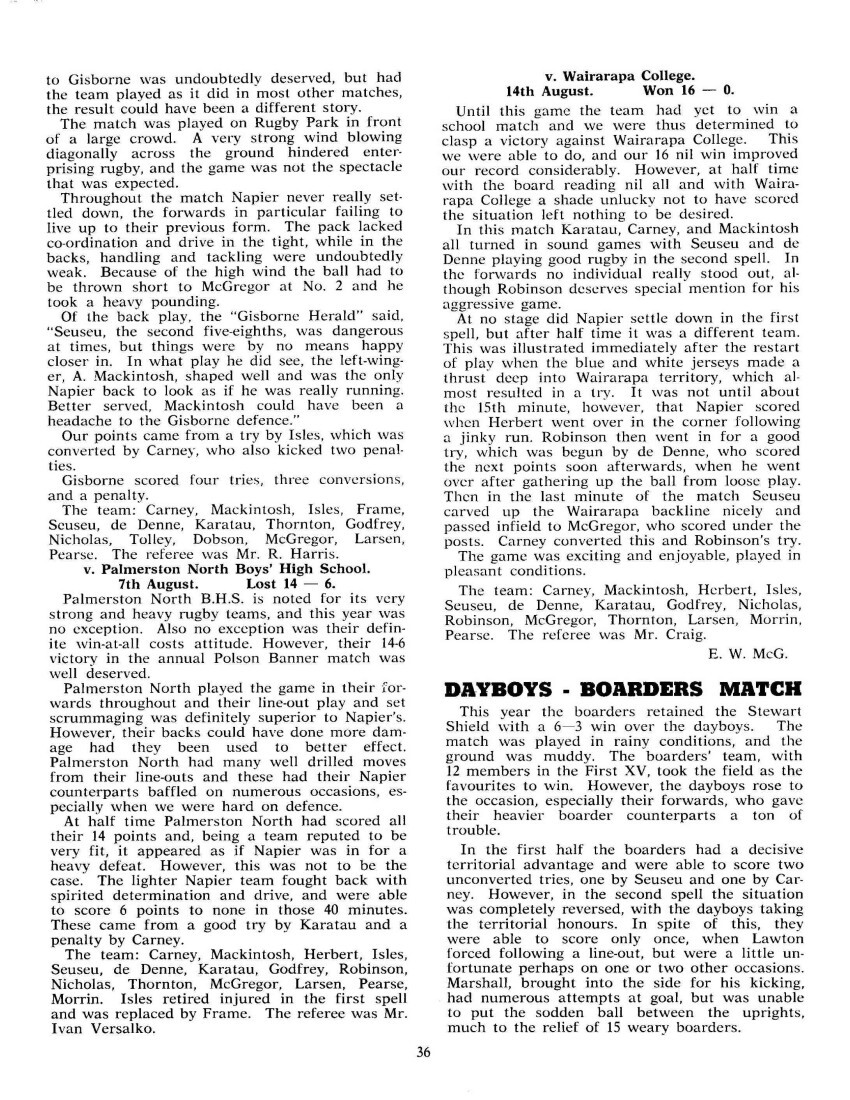
Page 37
In the dayboys’ team Karatau, playing at 1st five-eight, used the line to advantage with lengthy kicks. His brother at half-back gave him good service from scrums and line-outs. Larsen and Godfrey worked throughout in the tight and Tolley played an unusually fiery game.
For the boarders Seuseu was a constant danger but could have been used to better advantage had the day been fine. Carney, playing at half-back, handled conditions well, and Mackintosh looked dangerous at moments. The loose men, Robinson, Goulding and Thornton, handled their task exceptionally well.
The game was a battle royal throughout, as the score suggests. A game enjoyed by all thirty players representing their respective sides and it was a pleasant note to wind up the season on.
The teams:
Boarders: Taylor, Mackintosh, Herbert, Jensen, Seuseu (vice-capt.), de Denne, Carney, Thornton, Robinson, Goulding, Dobson, McGregor (captain), Chrystal, Morrin, Pearce.
Dayboys: Baudinet, Frame, Lawton, Piper, Isles, L. Karatau (captain), E. Karatau, Marshall, Godfrey, Nicholas, Tolley, Campbell, Larsen (vice-capt.), Elmes, Tuck. The referee was Mr. Boston.
E. W. McG.
SECOND FIFTEEN
The 1963 season began for the Second XV with promise, and a squad of 17 was selected from the trials. The team was: B. Baudinet, L. Campbell, R. Elmes, B. Ennor, J. Exeter, D. Goulding, P. Jensen, E. Karatau, W. Lawton, R. Moody, H. Pearse, J. Piper, R. Sherwood, B. Skjottrup, T. Smart, J. Thornton.
After the first few games H. Pearse and J. Thornton were promoted to the First XV, and B. Chrystal and D. Kerr joined the squad to replace them. Because of injuries, R. Forrest joined the team about half-way through the season. The team played extremely well in the second round of the competition to bring their season’s statistics to eight wins and six losses, and to finish fourth equal on the ladder, with Colenso.
The team played six school games this year, and travelled to Gisborne on a Friday and returned the following night.
The results of the school games are:
Wairoa 1st XV at Napier: Won 19 – 5
Central H.B. 1st XV at Napier: Won 18 – 5
Gisborne 2nd XV at Gisborne: Lost 3 – 16.
Palmerston North 2nd XV at Napier: Lost 3-12
Hastings 2nd XV at Hastings: Lost 3-14.
Colenso 1st XV at Napier: Won 12-9.
In conclusion, we would like to thank Mr. Brebner for his keenness in coaching and his guidance throughout the season.
R. F. E.
THIRD FIFTEEN
The Third Fifteen again played in the local third grade competition. Captained by A. Godwin, we experienced a season of very mixed fortunes, losing heavily to some teams, yet managing to defeat N.H.S.O.B., who were second in the competition.
The team was: A. Godwin (captain), A. Mitchell, D. Avenell, R. Bell, L. Bennett, C. Brunton, E. Campbell, G. Field, A. Ferguson, M. Girvan, M. Gudgeon, B. Harvey, R. Nant, J. A. Piper, J. Prince, A. Sherwood, J. Sinclair, B. Tucker, G. Exeter, R. Carberry.
We had a successful series of school games, in which we were undefeated. These games were:
Wairoa 2nd XV: Won 8-3.
Dannevirke 3rd XV.: Won 28-0.
Hastings 3rd XV.: Drew 9-9.
A game was also played against the cadets of the training ship “Durham,” and we won 9-3.
There was a great spirit present in the team, and we must thank Mr. D. McKenzie for his valuable coaching.
A. J. M.
FOURTH GRADE
Four teams were fielded. An attempt was made to have at least one best team, and possibly a second best. Of course, some very good players found themselves in the lower teams, so that when the Fourth XV was fielded against other schools, it was not the original “A” team by any means. [misplaced text in original corrected in transcript – HBKB]
For the most part, team spirit was high, practices were well attended, and the improvement in the standard of play remarkable. The best example was provided by the Scinde Team, which, under the enthusiastic guidance of Mr. D. Montagu, a non-teaching housemaster, rose from being virtually a scrap-end team to one which could have tested any other team in the competition.
Early season losses were many, and in some cases very heavy, but when the grade was re organised, all teams were more successful.
“A” Team: Coach: Mr. G. Simpson; Captain: D. O. MacDonald, R. LeQuesne, M. Mear, J. Andrews, T. Smith, D. Bassett, S. Wilson, W. Cameron, M. Simpson, G. Stevenson, R. Treseder, H. Trafford, K. Wallace, J. Forrest, B. Martin.
The team won its way into the “A” section, consisting of the six top teams, and was very successful. Played 15, won 9, lost 6.
“B” Team: Coach: Mr. J. Lloyd; Captain: K. Hing; P. Tutt, D. Angove, D. Stevenson, R. Perry, J. Hanlen, A. Richards, C. Walker, K. Turner, R. Scott, T. Morrison, L. Simmonds, G. Johnson, G. Delugar, R. Jessep, R. W. Farquhar, A. Wilson. Played 15, won 6, drew 1, lost 8.
“C” Team: Coach: Mr. R. C. Tuck; Captain: G. Liddell; F. Craig, R. Castles, K. Johnstone, D. Fergusson, I. Ware, R. Bell, G. Mackay, J. McLeod, R. Lee, D. Hills, S. Romans, W. Archibald, T. Maru, S. Masters, D. Jamieson. Many others played a few games. Played 15, won 2, drew 1, lost 12.
Scinde Team: Coach: Mr. D. Montagu; Captain: G. Harvey; G. Lawrence, R. Peddle, D. Munro, B. Marshall, D. Monk, R. Meaclem, D. Oliver, J. Lancaster, R. Kells, I. Campbell, D. Malthus, F. Cameron, J. Wright, H. Johnstone, M. Jensen, S. Alder, J. Agnew, P. Robinson. Played 15, won 8. lost 7.

Page 38
FIFTH GRADE COMPETITION
This year we had four teams in the competition. We met with very strong opposition from Tech. and H.S.O.B.; but in other games our ‘Green,’ ‘White,’ and ‘Red’ teams had their fair share of victories. The ‘Blue’ team suffered some rather heavy defeats, but its younger and lighter players are to be complimented for the plucky way they stood up to their more experienced and heavier opponents.
Six of our players were selected for a schools’ representative team which drew 5-5 with a clubs’ representative team. Our congratulations to W. McCorkindale, B. Gloyn, M. Howell, A. Brown, C. Clark and J. Ross on obtaining representative honours.
The captains of the teams were: W. McCorkindale (Green), B. Gloyn (White), E. Castles (Red), S. Phillips (Blue).
The teams were coached by Mr. D. Billing, Mr. O. H. Brown, Mr. J. Hastrop and Mr. B. G. O’Connor.
SIXTH GRADE COMPETITION
The school entered two teams: a Day Boys’ Team (coach: Mr. K. Flowers; Captain: K. R. Jones) and a Scinde House team (Coach: Mr. G. Beer; Captain: W. M. McLaren).
The final result of the competition was: 1st, St. John’s; 2nd, N.B.H.S. Day Boys; 3rd, Tech; 4th, N.B.H.S. Scinde.
Day Boys: played 13, won 11, drew 2, lost 0.
Scinde: played 13, won 8, drew 2, lost 3.
The following members of the school 6th Grade were chosen for the Napier Representative Team: Chapman, Fuller, Barrie, Redshaw, Merritt, Pettigrew and Wong.
SEVENTH GRADE “A” COMPETITION
The school had two teams in the “A” Division: White team (Coach: Mr. R. Pimm; Captain: A. Maru), and Blue team (Coach: Mr. T. Carpenter; Captain: A. M. Connor).
The results of the competition were: 1st, Colenso; 2nd, N.B.H.S. White; 3rd N.B.H.S. Blue.
White Team: played 13, won 10, lost 3.
Blue Team: played 13, won 9, lost 4.
A combined 7th Grade team played a visiting Lindisfarne team and won 6-3. On our trip to the field day at Hastings on August 20, both our teams won.
Congratulations to the following members who were chosen for the 7th Grade Representative team which played a Hastings Representative team and won 6 – 3: Maru, Baudinet, Mildon, DeDenne, Bergman, Fleming and Macdonald.
CRICKET
Mr. MICHAEL SHRIMPTON
Earlier in the year the School was honoured in the cricket field when Michael Shrimpton, an Old Boy, was selected to play for his country against the touring M.C.C. team, at the end of their Australian tour. Michael Shrimpton came to us from Fielding Agricultural High School in 1956 to spend two years at N.B.H.S. As a primary schoolboy Michael was a bowler rather than a batsman. At Feilding A.H.S. he figured in a few matches against such good cricketers as Scots College and Palmerston North B.H.S., still as a bowler but moving slowly up the batting list.
When Michael came to N.B.H.S. he became a batsman. His bowling was still effective (taking 7 wickets for an average of 5 runs apiece), but it was taking second place. He was a member of the most successful First Eleven in the School’s history, the 1957 team, which won all of its matches under the captaincy of another future Central Districts player, Robin Schofield.
Mr. Shrimpton went to Ardmore Teachers’ College in 1958-59, being in the First Eleven there for both seasons, and topping the Counties’ batting averages both times. Starting with his score of 78n.o. against Hastings B.H.S. Michael then carried a long sequence of high scores, once he returned to the Bay. From Whatatutu, in the Urewera country where he was teaching, he had to travel several hundred miles to play in Napier each weekend. His persistence was rewarded, though, when in 1961 he was selected to play for Central Districts. There followed a series of higher honours at a national level, when he scored an unbeaten 178 for H.B. Colts against Manawatu, top-scoring for Hawke’s Bay against Dennis Silk’s MCC team receiving warm praise from the former) and being selected for the New Zealand Colts to play the Englishmen at Ashburton.
A series of good scores in Plunket Shield Cricket, culminating in 119 against Canterbury, saw Mr. Shrimpton well established by the end of the 1961-62 season. The start of the 1962-63 season really thrust Mike Shrimpton into prominence when he scored a brilliant 150 against Canterbury, which, more than anything, prompted his selection for the three Tests against the MCC. As he is the second Old Boy to have represented New Zealand at cricket the School will follow Mike Shrimpton’s progress with particular interest and hope that he goes to England in 1965.

Page 39
CRICKET, 1963
The 1st XI
The Team: W. A. Larsen (captain), A. D. McDougall (vice captain), L. J. Campbell, B. Chrystal, T. R. Hall, R. L. LeQuesne, J. M. C. Piper, K. Seuseu, D. Taaffe, J. P. Thornton, W. E. Turner.
This team finished high up in the points table of the local inter-town competition and performed with distinction in two of the three school games played. Strength in both batting and bowling departments was present at the beginning of the season and from this a well balanced team has evolved.
Mention must be made of notable outstanding individual performances during the season. In the first innings of the school match against Palmerston Boys’ High, Campbell and Turner provided an opening stand, realising 105 runs. This was an exceptionally fine effort, the partnership being instrumental in establishing a first innings total of 267 runs. Seuseu in his first game following his promotion from the second XI took eight wickets for 24 runs and following this, ably assisted by Chrystal and Taaffe, he provided the mainstay of the attack on many occasions.
In the field our performances left much to be desired at times but two who stood out fielding close to the wicket were Turner and Seuseu.
As this stage the team wishes to thank Mr. R. Gourley, the coach, who has given up much of his own time in rendering assistance and advice to the team. He has achieved much for the 1st XI, building up a good team spirit and moulding what was once a weak team to one that it is hoped will in the future win many games.
School Matches
N.B.H.S. v. Gisborne Boys’ High School.
G.B.H.S. 1st Innings: 215 (Chrystal 3 for 56; Seuseu 3 for 72).
N.B.H.S. 1st Innings: 112 (Thornton 35; Hall 20).
N.B.H.S. 2nd Innings: 67 (Hall 21 not out).
Result: Outright win to Gisborne by Innings and 33 runs.
Gisborne batted first on an easy paced wicket and reached a grand total of 215, due mainly to a fine innings of 95 by P. Beuth. Chrystal and Seuseu bowled steadily and well. In school’s first innings the batting collapsed badly, realising a total of only 112. This was one run short of the total to avoid a follow on. The batting effort in the second innings was worse than the first, with only 67 runs scored.
Gisborne thus had an easy victory and the performance of the 1st XI left much to be desired.
N.B.H.S. v. Palmerston Boys’ High.
N.B.H.S. 1st innings: 267 (Turner 59; Campbell 54; Hall 46).
P.N.B.H. 1st innings: 395 (Chrystal 3 for 77; Taaffe 3 for 61; Larsen 2 for 98).
N.B.H.S. 2nd innings: 175 (Turner 55; McDougall 24; Chrystal 24).
P.N.B.H. 2nd innings: 4 for 42.
Result: Palmerston won by eight wickets.
School won the toss and took first strike on a very easily paced wicket. Campbell and Turner provided an opening stand of 105 runs, and further good batting by Hall, McDougall and Thornton saw the total reach a very respectable 267.
Palmerston, however, replied with the huge total of 395, due mainly to a fine innings of 210 not out by their captain, V. Pollard. All the Napier bowlers tried hard on an unresponsive wicket without any spectacular success.
Napier in the second innings scored a further 175 runs with Turner once again to the fore, scoring another half century with further support from McDougall and Chrystal, both scoring 24.
This left Palmerston 41 runs needed to win in twenty minutes. This they achieved on the second to last ball of the last over of the game after losing two wickets. The game was an eventful one, played in a good spirit, with the result in doubt right up until the last minute of the game.
N.B.H.S. v. Hastings Boys’ High School
H.B.H.S. 1st innings: 144 (Seuseu 5 for 65; Nation 3 for 16).
N.B.H.S. 1st innings: 141 (Larsen 53; Nation 32).
H.B.H.S. 2nd innings: 81 (Chrystal 5 for 23; Seuseu 4 for 38).
N.B.H.S. 2nd innings: 85-8 (McDougall 28; Turner 15 not out).
Result: Outright win to N.B.H.S. by 2 wickets.
Hastings won the toss and elected to bat on a good batting wicket, which contained little life for the bowlers. Hastings reached a total of 144.
In Napier’s first innings, after a good start, the batting began to collapse badly with seven wickets falling for only 69 runs. However, the tailend batsmen provided a spirited resistance to the Hastings attack with a 10th wicket partnership, yielding 31 valuable runs. Nation batted soundly in this innings.
Hastings in their record innings scored only 81, due to some fine bowling by Chrystal and Seuseu, backed up by excellent fielding.
This left Napier 85 runs to score to win, which was accomplished for the loss of eight wickets, but not until after some very anxious moments.
The performance of the Napier team in this game was highly creditable. The fielding was of a very high standard, with Seuseu and Nation shining out conspicuously in this department. In all, the match provided a very pleasant end to the 1962 school year.
v. T. O. B.
N.B.H.S. 1st innings: 139 (Nation 46).
T.O.B. 1st innings: 260 (Nation 3 for 35).
N.B.H.S. 2nd innings: 8 for 129 (Nation 29, Knight 28).
Result: 1st innings win to T.O.B. by 120 runs.
v. Midland Rugby
N.B.H.S. 1st innings: 217 (Nation 61; Chrystal 32 not out; McDougall 27; Piper 27).
Midland Rugby 1st innings: 62 (Larsen 4 for 6).
Midland Rugby 2nd innings: 74 (Larsen 4 for 11;
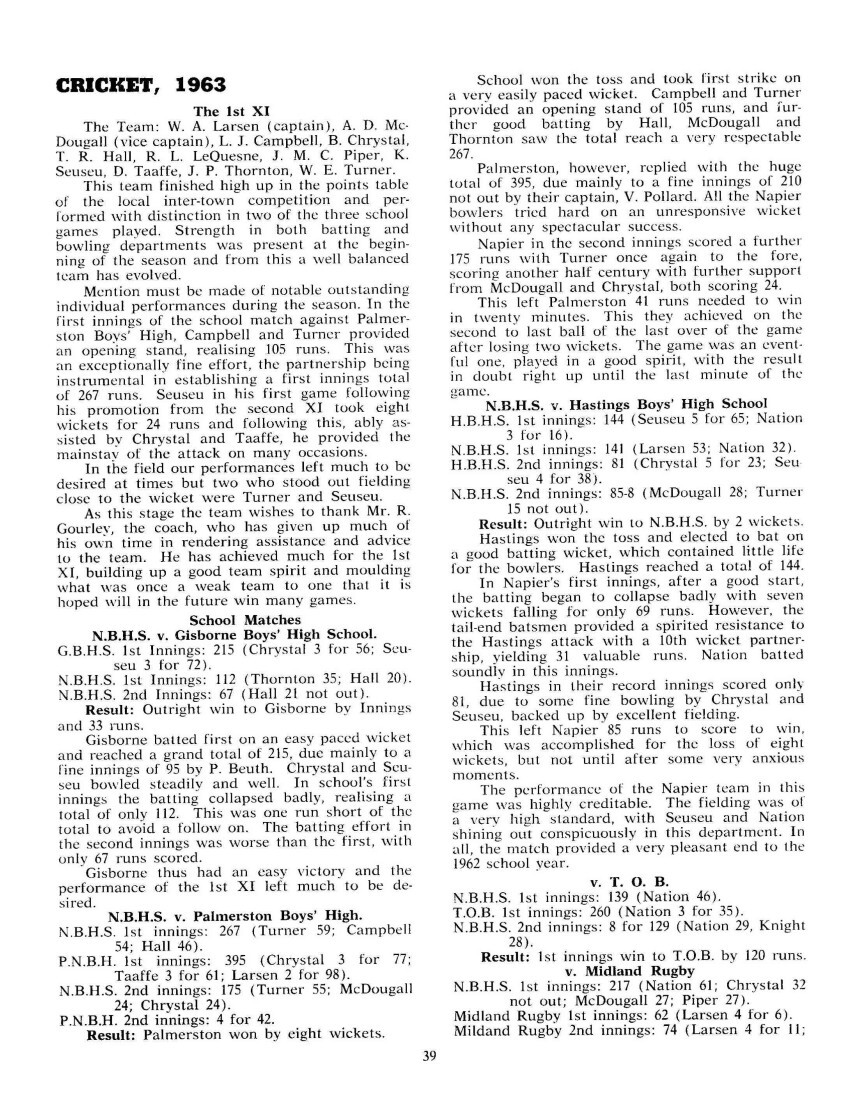
Page 40
Nation 3 for 21).
Result: Outright win to N.B.H.S. by an innings and 81 runs.
v. Colenso United.
N.B.H.S. 1st innings: 130 (Campbell 37, McDougall 26; Seuseu 23).
Col-United 1st innings: 65 (Seuseu 8 for 24).
N.B.H.S. 2nd innings: 5 for 234 declared (Nation 99: Larsen 92).
Col-United 2nd innings: 9 for 121 (Larsen 3 for 35; Seuseu 3 for 50).
Result: 1st innings win to N.B.H.S. by 65 runs.
v. Whakatu Mahora
N.B.H.S. 1st innings: 75 (Piper 26).
Whak-Mahora: 78 (Nation 4 for 4; Knight 3 for 19).
N.B.H.S. 2nd innings: 129 (Piper 29).
Whak-Mahora: 58 (Larsen 2 for 4; Nation 3 for 11).
Result: Outright win to N.B.H.S. by 67 runs.
v. Havelock North
N.B.H.S. 1st innings: 35 (Larsen 13).
Havelock North 1st innings: 121 (Taaffe 4 for 13; Turner 3 for 35).
N.B.H.S. 2nd innings: 159 (McDougall 57; Chrystal 32).
Havelock North 2nd innings: 73 for 3 (Turner 3 for 17).
Result: Win to Havelock by 3 wickets.
v. Marist
Marist 1st innings: 111 (Larsen 6 for 14).
N.B.H.S. 1st innings: 91 (Larsen 24; Gourley 21).
Marist 2nd innings: 142 (Larsen 4 for 33; Chrystal 3 for 31).
N.B.H.S. 2nd innings: 148 (Turner 34, Gourley 41).
Result: Outright win to Marist by 10 runs.
v. Taradale
N.B.H.S. 1st innings: 176 (Turner 69; Larsen 24).
Taradale 1st innings: 162 (Chrystal 5 for 3]; Taaffe 3 for 31).
N.B.H.S. 2nd innings: 8 for 126 declared Campbell 46; Turner 30).
Taradale 2nd innings: 76 (Seuseu 3 for 18; Chrystal 3 for 26).
Result: Outright win to N.B.H.S. by 64 runs.
v. Whakatu-Mahora
Whak-Mahora 1st innings: 61 (Chrystal 6 for 17; Taaffe 3 for 17).
N.B.H.S. 1st innings: 7 for 165 declared (Gourley 37; Larsen 25; Piper 23; Thornton 22 not out).
Whak-Mahora 2nd innings: 91 (Chrystal 5 for 45).
Result: Outright win to N.B.H.S. by an innings and 14 runs.
v. Midland-Rugby
Midland Rugby 1st innings: 76 (Chrystal 3 for 26; Gourley 4 for 15).
N.B.H.S. 1st innings: 86 (Hall 23 not out).
Midland Rugby 2nd innings: 111 (Chrystal 4 for 25; Larsen 3 for 37).
N.B.H.S. 2nd innings: 105 for 4 (Piper 50).
Result: Outright win to N.B.H.S. by 6 wickets.
v. H.M.N.Z.S. Royalist
Royalist 1st innings: 62 (Seuseu 4 for 5; Taaffe 2 for 12).
N.B.H.S. 1st innings: 7 for 139 declared (Hall 37; Campbell 32.
Royalist 2nd innings: 115 (Seuseu 4 for 35).
Result: Win to N.B.H.S. by 77 runs on 1st innings.
Summary
Played 14. Won 7 Outright.
Won 2 on 1st Innings.
Lost I on 1st Innings.
Lost 4 Outright.
Second Eleven
The members of the second eleven wish to thank Mr. Knight for the coaching he has given us during the last year. The team has been very successful during the past season, and are looking forward to the beginning of the new season.
At the beginning of the 1963 season we lost five of our members, leaving Pearse, Morrison, Field, Eddy, Dick, Forrest, Cotterill and de Denne to carry on the good work. Because of this loss, Goulding, Taaffe, Donaldson, Piper and Castles were promoted as replacements.
This new team travelled to Gisborne where they were beaten in a good game by sound batting and accurate bowling, and so lost by five wickets.
J.P.D.
Third Cricket XI
This year the Third Eleven again had a very good tally of successes in. Saturday matches. AI- though the team has changed greatly, due to pro. motions, the original keenness and team spirit of members has remained. For this we are grateful to our coach, Mr. Billing, who has sacrificed much of his spare time in order to assist the team in both coaching and transporting boys to Hastings for matches. His presence will be sorely missed by 3rd XI’s of the future and on behalf of the team I would like to thank him for his help during the year.
G. W. R.
Fourth Cricket XI
This year the fourth cricket XI has had much fewer successes than the thirds, who play in the same competition. The team was: P. G. Morrin (captain); G. Barrie; J. Bergman; R. Bray; S. Bray; R. Fleming; W. McCorkindale; R. Nicol; M. Willis and R. Yates. We are grateful to our coach, Mr. B. A. Webster, because Tuesday and Thursday practices and Saturday afternoon matches are a big claim on his time. R. Yates has been a promising bowler and J. Bergman a good batsman.
Colts Cricket Team
Twenty-three boys were coached by Mr. Rev- ell. Two teams were formed for games on the School grounds on Saturday mornings in the first team a boarders’ team and a day-boys’ team. Officers were elected as follows: R. Young, captain); J. Cartwright (vice captain); Gear Committee: J. Fearn, J. Harris, G. Nielsen, N. Macaulay, G. Barrie.
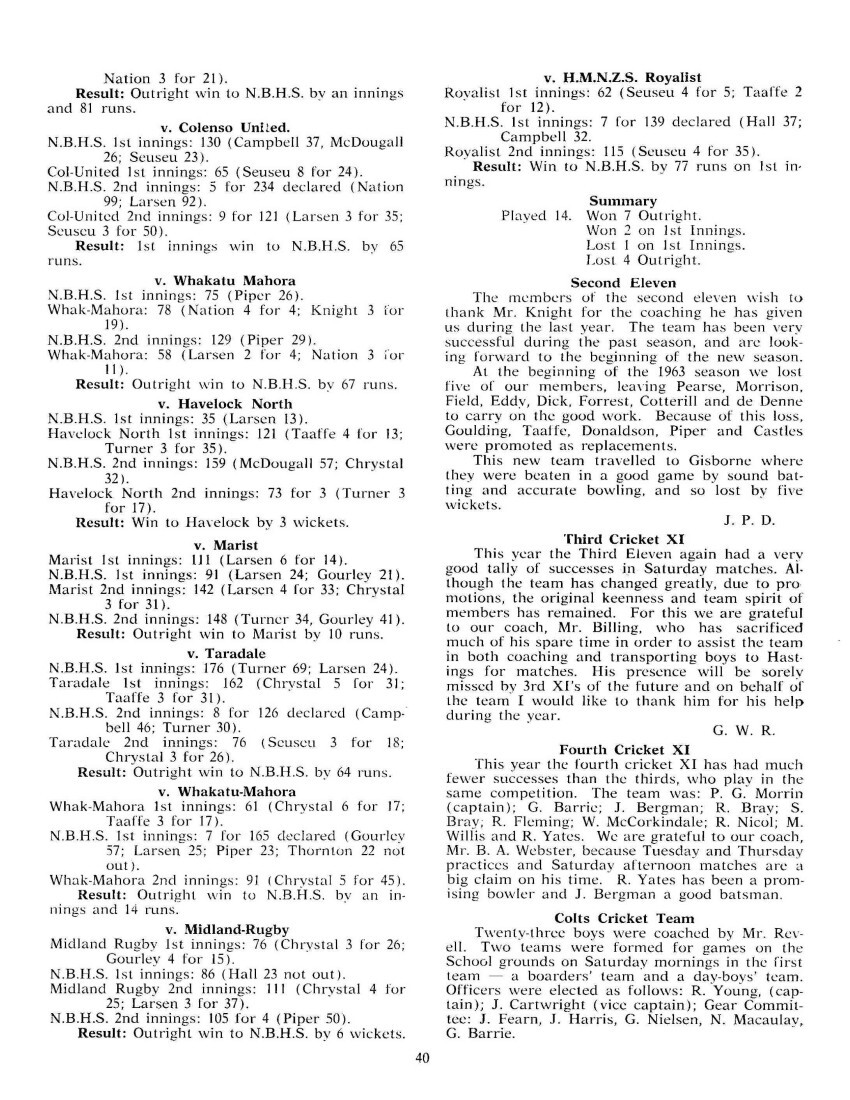
Page 41
CRICKET FIRST ELEVEN
Back Row: R. J. LeQuesne, B. Chrystal, L. J. M. Campbell, D. M. Taaffe, W. F. D. Turner.
Front Row: K. F. Seuseu, J. P. G. Thornton, Mr. R. B. Gourley (coach), W. A. Larsen (captain), A. D. McDougall, J. M. C. Piper, T. A. Hall.
CRICKET SECOND ELEVEN
Back Row: E. M. J. Castles, R. V. Cottrell, D. J. Goulding, T. R. Morrison, G. I. Dick.
Front Row: J. A. Piper, C. A. Forrest, Mr. P. S. Knight (coach), H. T. Pearse (capt.), J. P. deDenne, G. M. Field, I. K. Donaldson.

Page 42
SCHOOL ATHLETIC TEAM
Back Row: Mr. C. V. Nicol (Coach), M. Mear, B. Duncan, B. Baudinet, R. Parmer, G. Wiig, A. Ferguson.
Middle Row: Mr. T. J. Roberts (Coach), R. Schofield, R. Robertson, R. Forrest. R. Nant, B. Mackintosh, W. Vautier, B. Taaffe, Mr. C. H. Matthews (coach).
Front Row: H. Taylor, K. Seuseu, J. Thornton, C. Frame (capt.), A. Mackintosh, J. DeDenne, D. Taaffe.
In Front: T. McLennan, S. Herbert. G. Robinson.
FIRST HOCKEY ELEVEN
Back Row: Mr. D. G. Revell (coach), F. Hyde, A. Rowe, E. Alford, T. Bates.
Middle Row: D. Taaffe, W. Turner, Turbitt (captain), P. Loader, J. Scott, N. Foote.
Front Row: G. Dick, C. Svendsen, R. Campbell.
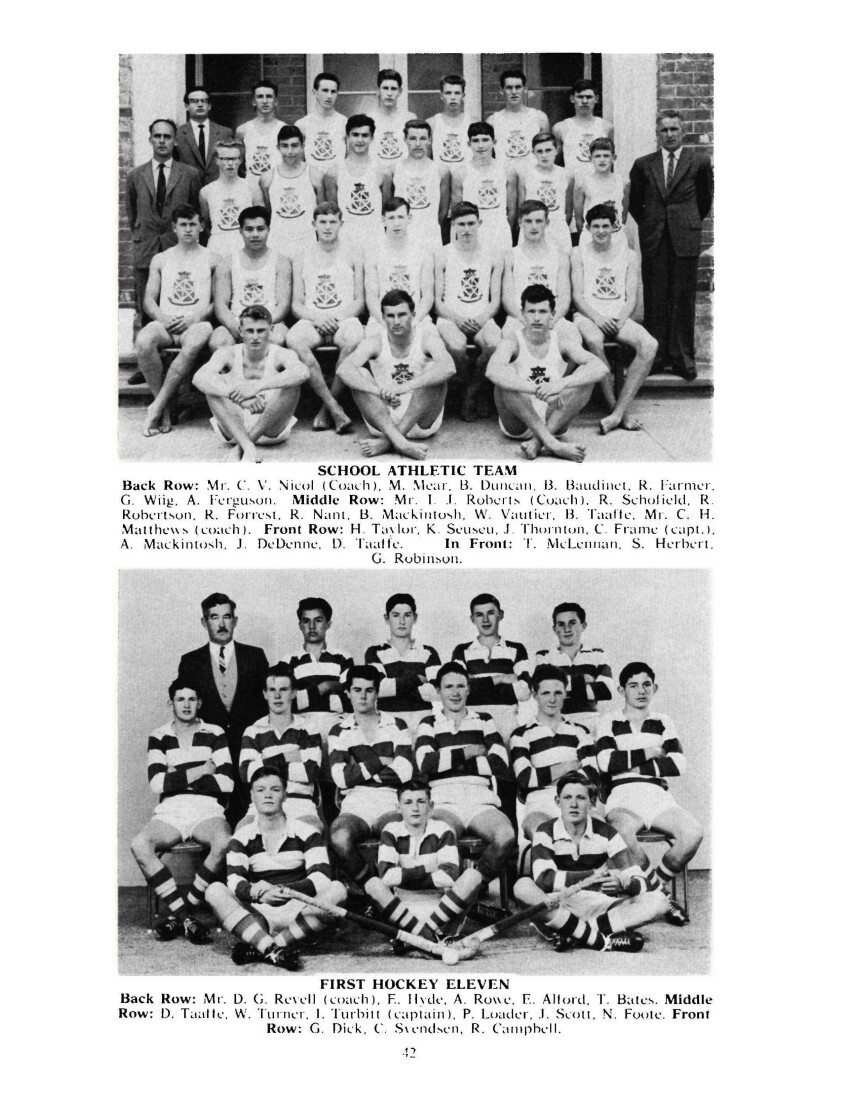
Page 43
ATHLETICS
COACHING
The Hawke’s Bay Coaches’ Association held a three hour session in training methods and techniques on the school grounds in October. Sixty pupils received instruction in sprinting, hurdling, middle distance running, pole vaulting, shot putting, discus and javelin throwing. This was so successful that we sincerely hope these coaching experts will visit the school more frequently.
The athletic enthusiasts have now been given an area of the field all to themselves. They have a marked track, throwing circles and pits in use for the summer season.
Inter-school competitions were arranged, with a visit from St. John’s High School (Hastings) on November 2 and Lindisfarne College on November 16. The school team were victorious on both occasions and look forward to the visit, next term, of other school athletic teams.
Performances worthy of mention, even at this early stage in the season, are:
100 yards senior: D. Taaffe, 10.4 seconds.
High jump, intermediate: M. Mear, 5ft. 2ins.
Long jump, intermediate: M. Mear, 18ft. 3ins.
Discus, intermediate: G. Wiig, 128ft. 3ins.
ATHLETIC TEAM
This year the annual inter-secondary school sports meeting was held at McLean Park in overcast weather. At times the surface tended to be a little slippery, and so hampered the attempts made at records. However, the meeting provided an excellent standard of competition in all sections.
The strength of our team was very evenly spread in junior, intermediate and senior events.
Perhaps the most outstanding win was that of A. Mackintosh over A. Saunders, of Gisborne in the 880 yards. This race was truly a great battle of endurance and it depended on the final sprint home in which Mackintosh showed his superiority. In the intermediate section, M. Mear had an unfortunate day as he did not reach the form he had shown us in the school athletic sports.
The most outstanding junior was B. Duncan, who gained first place in the 220 yards and second in the 100 yards, this too being a great achievement. R. Schofield, another junior, gained third place in the 220 yards. In the junior boys’ relay, our boys managed to take second place in a keenly fought tussle with Dannevirke.
In the Intermediate section R. Nant ran well to come in second position in the mile event. In the discus event G. Wiig took third place. The intermediate relay team ran very convincingly to take first place in their race.
A. Mackintosh was the best of the seniors, gaining first place in both the 880 yards and 440 yards, this being a credit to his training methods. In the 440 yards A. Ferguson also ran a good race to take third place. In the Javelin event K. Seuseu was up against tough opposition, but nevertheless he out-threw most of the contenders to gain second place. Finally, in the long jump C. B. Frame managed to clinch third place.
It can be seen by these results that our school acquitted itself very ably and produced some good wins.
On behalf of the team I wish to thank Mr. Nicol and Mr. Matthews for their interest and the time they spent in coaching us.
C. B. F.
STEEPLECHASE
The Annual Steeplechase was held on Thurs day, April 18, in excellent weather.
Individual Placings:
Senior (45 miles): 1, I. Turbitt (Col); 2, A. Mackintosh (Sc); 3, G. Robinson (Sc); 4, C. Clark (Col); 5, C. Forrest (Sc); 6, E. McGregor (Sc); 7, J. Sinclair (Sc); 8, D. Hay (Col); 9, N. Dobson (Sc); 10, D. Marshall (Na).
House Points: Scinde 156; Colenso 74; Clyde 68.
Intermediate (3 miles): 1, W. Lawton (Cl); 2, R. Nant (Sc); 3, A. Strachan (Sc); 4, E. Hodgkinson (Col); 5, P. Tuck (Ha); 6, K. O’Rourke (Ha); 7, G. Northe (Col); 8, R. Pawluk (Col); 9, L. Watkins (He); 10, D. Boardman (Cl).
House Points: Scinde 46; Clyde 32; Hawke 23.
Junior (14 miles): 1, B. Mackintosh (Sc); 2, D. Munro (Sc); 3, B. Eden (Ha); 4, B. Duncan (C1); 5, J. Moore (Ha); 6, J. Hawkins (He); 7, B. Gardner (Sc); 8, W. Vautier (Sc); 9, C. Clark (Col); 10, J. Parker (Col).
House Points: Scinde 54; Hawke 30; Clyde 19.
House Competition: 1st Scinde; 2nd Clyde; 3rd Hawke.
ATHLETIC SPORTS
Conditions on the first day of this year’s athletic sports, which were held on March 14 and 15, were rather windy, although the sun made its presence felt on the following day. It was pleasing to see so many parents present at our sports this year, and we hope that many more will come along next year.
Although conditions were difficult, three records were broken, and one equalled. We congratulate the following on their success:
K. Seuseu, who broke his own 1962 record of 146’ 8” and set a new mark of 158’ in the Senior Javelin Throw.
R. Nant, who broke the Intermediate Mile record of 5 mins. 2.7 secs. by 9.4 secs., thus setting a new record of 4 mins. 53.3 secs.
G. Wiig, who created a new record of 141’ 6 1/2” in the Intermediate Javelin, exceeded the old mark by 19’ 3 1/2”.
M. Mear, who equalled the Intermediate High Jump record of 5’ 4 1/2”.
House points were: Scinde 619; Clyde 475; Colenso 398; Hawke 365; Napier 360; Heretaunga 341.
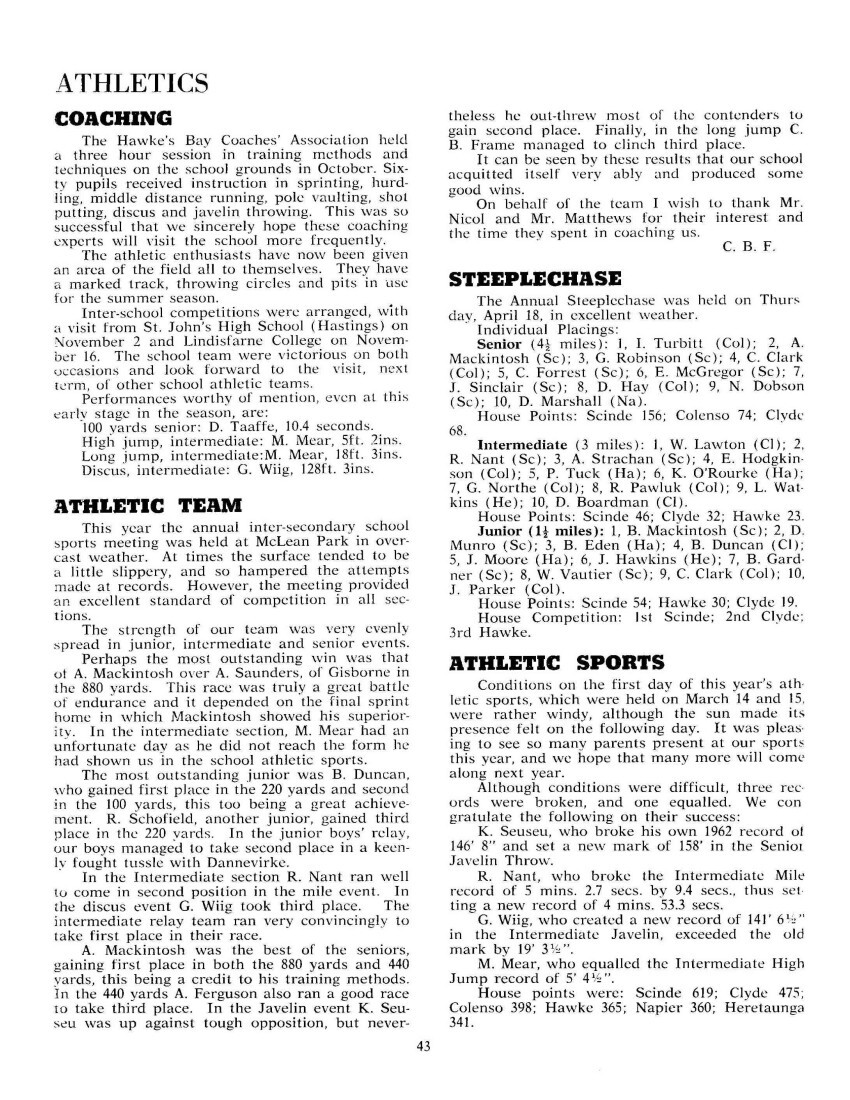
Page 44
ATHLETICS SENIOR CHAMPIONSHIP
EVENT FIRST SECOND THIRD PERFORMANCE
880 yards A. Mackintosh (Sc) G. Robinson (Sc) C. Clark (Col) 2min. 11.1secs.
440 yards A. Mackintosh (Sc) G. Robinson (Sc) H. W. Taylor (Sc) 54.8secs.
220 yards H. K. Taylor (Sc) J. Thornton (Sc) C. Frame (Cl) 24.8secs.
100 yards D. Taaffe (Sc) H. K. Taylor (Sc) J. Thornton (Sc) 11secs.
1 Mile A. Mackintosh (Sc) G. Robinson (Se) C. Clark (Col) 4min. 49.6secs.
120 yards Hurdles J. Thornton (Sc) K. Seuseu (Sc) P. Jensen (Sc) 16.9secs.
Long Jump D. Taaffe (Sc) P. Jensen (Sc) K. Seuseu (Sc) 18ft. 1½ins.
High Jump D. Taaffe (Sc) K. Seuseu (Sc) J. Prince (Cl) 5ft. 4ins.
Hop, Step and Jump J. Sinclair (Sc) C. Frame (Cl) D. Taaffe (Sc) 38ft. 5ins.
Shot Put J. Thornton (Sc) A. Tolley (Cl) D. Avenell (Sc) 31ft. 9¾ins.
Javelin Throw K. Seuseu (Sc) R. Chin (He) A. Mackintosh (Sc) 158ft. (record)
Discus A. Mackintosh (Sc) G. Robinson (Sc) K. Seuseu (Sc) 106ft. 5½ins.
House Relay Scinde Napier Colenso 48.8secs.
INTERMEDIATE CHAMPIONSHIP
EVENT FIRST SECOND THIRD PERFORMANCE
880 yards R. Nant (Sc ) R. Peddle (Sc ) Avenell (Sc) 2min. 13.4secs.
440 yards R. Nant (Sc) R. Peddle (Se) Avenell (Sc) 56.6secs.
220 yards D. Oliver (Ha) R. Peddle (Se) Robertson (N) 25.5secs.
100 yards D. Oliver (Ha) T. McLennan (Col) Robertson (N) 11.2secs.
l mile R. Nant (Sc) W. Lawton (Cl) R. Peddle (Sc) 4min. 53.3secs. (record)
80 Metres Hurdles M. Mear (Ha) J. de Denne (Sc) Robertson (N) 12.7secs.
Long Jump M. Mear (Ha) W. Lawton (Cl) B. Baudinet (Ha) 18ft 5¾ins. (record)
High Jump M. Mear (Ha) J. Andrews (Sc) D. Hills (He) 5ft.4½ins.(equals record)
Hop, Step and Jump M. Mear (Ha) B. Baudinet (He) C. Lum (N) 39ft. 9ins.
Shot Put G. Wiig (Col) K. Johnstone (Sc) T. Hall (N) 35 ft. 2½ins.
Discus D. Oliver (Ha) R. Pawluk (Col) J. de Denne (Sc) 105ft. 2ins.
Javelin Throw G. Wiig (Col) B. Baudinet (Ha) D. Hamilton (N) 141ft. 6ins (record)
House Relay Scinde Colenso Hawke 50.0secs.
JUNIOR CHAMPIONSHIP
EVENT FIRST SECOND THIRD PERFORMANCE
880 yards B. Mackintosh (Sc) E. Vautier (Sc) C. Clark (Col) 2min. 25.6secs.
440 yards D. Munro (Sc) J. Hawkins (He) M. Pearse (Sc) 61.7secs.
220 yards B. Duncan (Cl) R. Schofield (N) J. Hawkins (He) 27.4 secs.
100 yards B. Duncan (Cl) J. Hawkins (He) R. Schofield (N) 11.7secs.
80 Metres Hurdles D. Munro (Sc) A. Jensen (Ha) B. Harvey (Sc) 15. 1secs.
Long Jump R. Forrest (Sc) B. Taaffe (Sc) J. Ross (Sc) 15ft. 7ins.
High Jump B. Taaffe (Sc) C. Walker (Ha) G. Galgey (Col) 4ft. 5ins.
Hop, Step and Jump R. Schofield (N) R. Farmer (Sc) G. Greeks (N) 31ft. 11ins.
House Relay Scinde Clyde Napier 55.2secs.
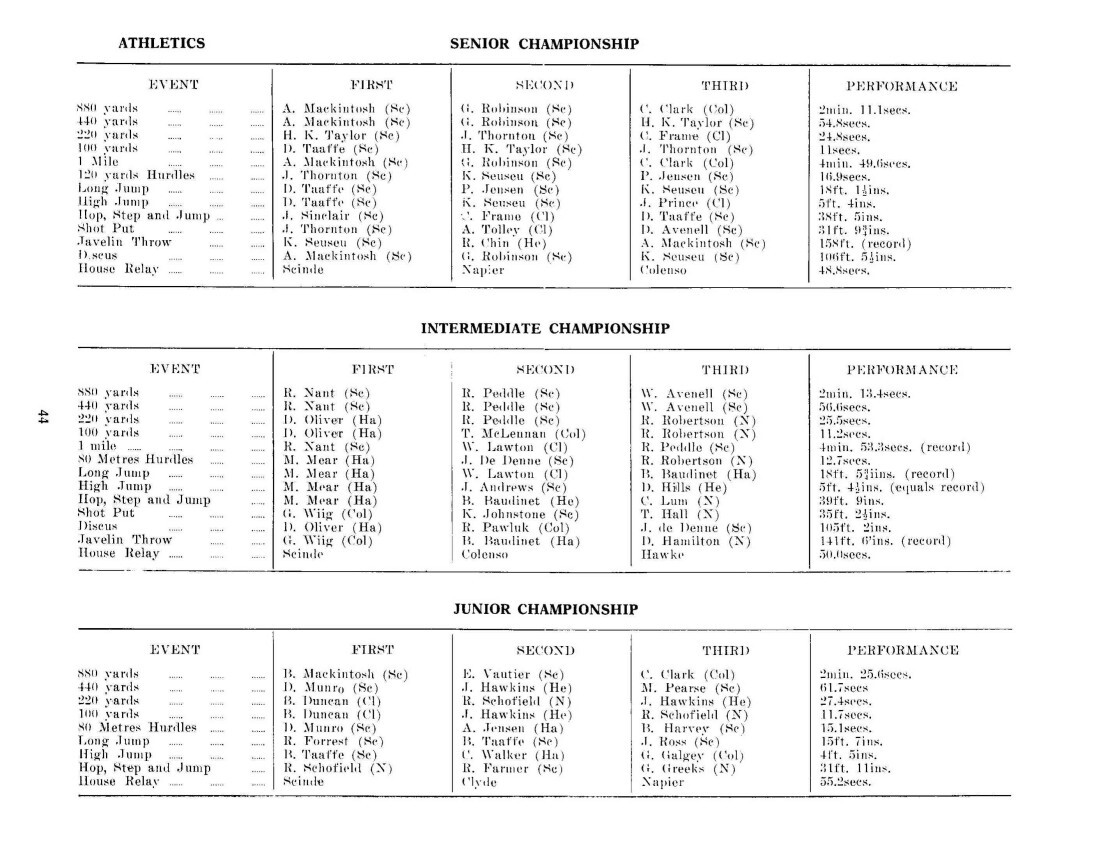
Page 45
ATHLETICS
OVER 17 YEARS NON-CHAMPIONSHIP EVENTS
EVENT FIRST SECOND THIRD PERFORMANCE
100 yards “B” J. Isles (N) N. Dobson (Sc) R. Chin (He) 11.5secs.
100 yards “C and “D” R. Dallas (Sc) R. Thomson (Sc) J. M. Piper (Col) 11.9secs.
220 yards “B” J. Isles (N) N. Dobson (Sc) R. Chin (He) 26secs.
220 yards “C” and “D” R. Thomson (Sc) R. Dallas (Sc) M. Piper (Col) 26.9 secs.
440 yards “C and “D” R. Thomson (Sc) R. Sherwood (Sc) B. Kells (Sc) 57.6secs.
880 yards “B” R. Sherwood (Sc) G. Hook (Cl) E. McGregor (Sc) 2min. 22.6sec.
Cricket Ball Throw D. Marshall (N) R. Sherwood (Sc) R. Chin (He) 234ft. 2ins.
Davis Cup Hurdles J. Thornton (Sc) K. Seuseu (Sc) A. Tolley (Cl) 17.4secs.
Cornford Cup Handicap Mile A. Ferguson (Sc) K. Wallace (Sc) G. Johnston (He) 4 min. 38.3secs.
High Jump N. Dobson (Sc) A. McDougall (Cl) S. Godfrey (Ha) 4ft. 6ins.
Hop, Step and Jump D. Marshall (N) A. McDougall (Cl) T. White (He) 36ft 2ins.
Long Jump T. White (He) R. Thomson (Sc) R. King (Col) 16ft. 6½ ins.
880 yards Walk (Open) B. Kells (Sc) R. Malcolm (Col) R. Thomson (Sc) 4mins. 0.6 secs.
UNDER 17 YEARS
EVENT FIRST SECOND THIRD PERFORMANCE
100 yards “B” S. Herbert (Sc) T. Smart (Col) R. Elmes (N) 11.4secs.
100 yards “C” K. Johnson (Sc) K. Wallace (Sc) G. Johnston (He) 12secs.
100 yards “D” G. Liddell (Cl) D. Mathus (Sc) G. Ebbett (Sc) 12.5secs.
220 yards “B” A. Ferguson (Sc) S. Herbert (Sc) H. Prosser (Col) 26secs.
220 yards “C” K. Johnson (Sc) G. Johnston (He) G. Stevenson (Cl) 27.4secs.
220 yards “D” D. Simonsen (Ha) D. Mathus (Sc) G. Harvey (Sc) 28.5secs.
440 yards “B” A. Ferguson (Sc) I. Turbitt (Col) S. Herbert (Sc) 54.5secs.
440 yards “C” P. Carney (Sc) J. A. Piper (Col) G. Nuttal (Col) 60.3secs.
440 yards “D” D. Simonsen (Ha) G. Harvey (Sc) D. Gardner (Sc) 62secs.
880 yards “B” T. Turbitt (Col) R. Elmes (Na) D. Avenell (Sc) 2min. 24.7 secs.
880 yards “C” G. Johnston (He) K. Wallace (Sc) P. Carney (Sc) 2min. 22secs.
High Jump A. Ferguson (Sc) D. Fergusson (Cl) D. Avenell (Sc) 4ft. 10ins.
Cricket Ball Throw J. Thornton (Sc) C. Clark (Col) J. Lancaster (Sc) 229ft. 2ins.
Hop, Step and Jump S. Herbert (Sc) D. Fergusson (Cl) P. Carney (Sc) 36ft. 7ins.
Long Jump S. Herbert (Sc) K. Wallace (Sc) D. Fergusson (Cl) 17ft.
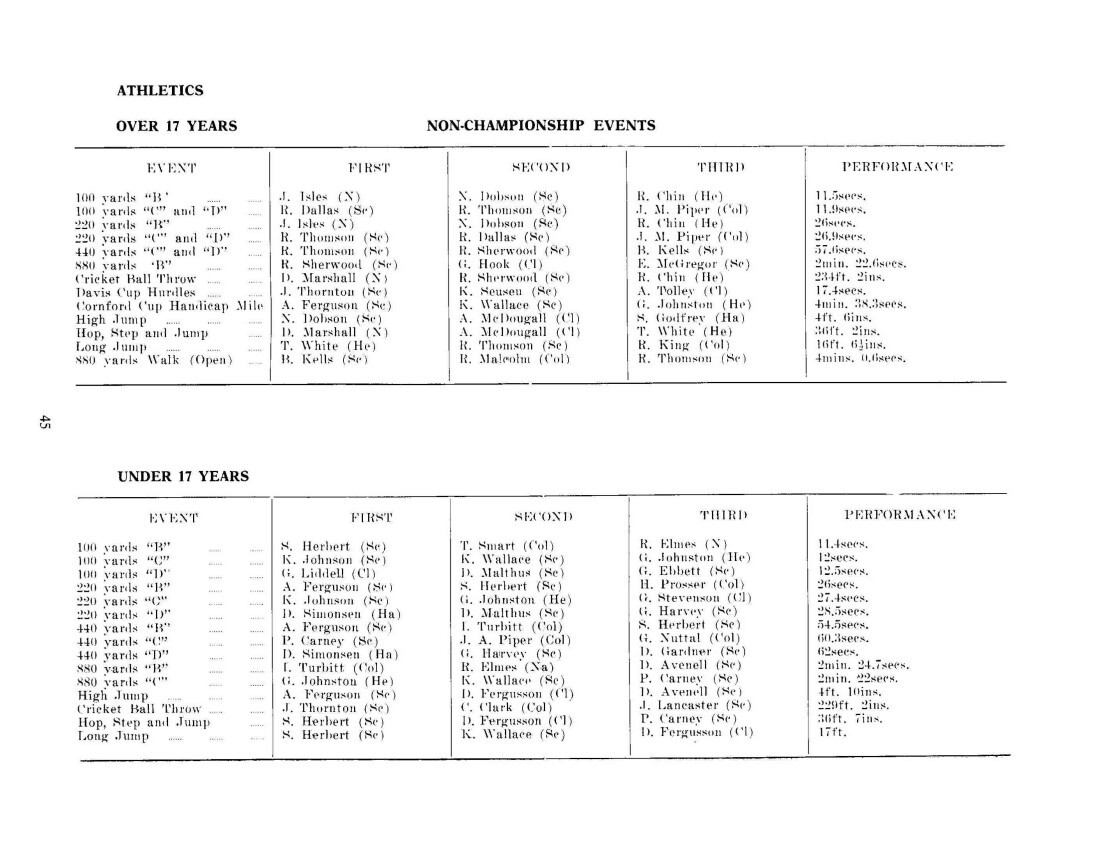
Page 46
ATHLETICS
UNDER 16 YEARS
EVENT FIRST SECOND THIRD PERFORMANCE
100 yards “B” R. Moody (Col) G. Field (Sc) N. Jackson (Col) 12secs.
100 yards “C” A. Thornburrow (Ha) D. B. Ferguson (Ha) J. Scott (N) 12.1secs.
100 yards “D” E. Hyde (Ha) G. Kohlis (N) A. Simpson (Cl) 12.5secs.
100 yards “E” G. J. Harvey (Sc) A. Jamieson (Ha) S. Nation (Sc) 13.2secs.
220 yards “B” G. Field (Sc) J. Slight (Ha) G. Exeter (Ha ) 27.4secs.
220 yards “C” T. Smith (Cl) J. Scott (Na) L. Beattie (Sc) 28.0secs.
220 yards “D” G. Kohlis (Na) M. Wiig (Ha) N. Foote (Cl) 28.7secs
220 yards “E” G. J. Harvey (Sc) S. Nation (Sc) R. Roberts (Col) 30.1secs.
440 yards “B” K. Weatherley (Ha) T. Smith (Cl) G. Raitt (C1) 60.3secs.
440 yards “C” H. Trafford (Se) K. Cameron (Sc) 61.4secs.
440 yards “D” B. Lambert (Cl) F. McGregor (Cl) R. Peterson (Sc) 67.2secs.
440 yards “E” G. Harvey (Sc) S. Nation (Sc) I. McKay (He) 67.3secs.
880 yards “B” K. Weatherley (Ha) M. Lambert (Cl) D. Kerr (Sc) 2min. 25.7secs.
880 yards “C” H. Trafford (Sc) P. Marshall (Ha) P. Tuck (Ha) 2min. 23.5secs.
880 yards “D” S. Wilson (Sc) B. Lambert (Cl) F. McGregor (Cl) 2min. 37.3secs.
880 yards “E” S. Nation (Sc) G. Harvey (Sc) I. McKay (He) 2min. 46.5secs.
Long Jump P. Walker (Sc) G. Field (Sc) S. Wilson (Sc) 15ft.
Hop, Step and Jump M. Simpson (Sc) J. Briggs (Cl) G. Exeter (Cl) 33ft. 6ins.
Cricket Ball Throw G. Ball (Cl) K. Hyde (N) J. Scott (N) 226ft. 9ins.
High Jump J. Vivieaere (Co) H. Trafford (Sc) K. Weatherley (Ha) Height: 4ft. 9ins.
UNDER 15 YEARS
EVENT FIRST SECOND THIRD PERFORMANCE
100 yards “B” D. Oliver (Sc) I. Buckley (Ha) H. Black (Cl) 12secs.
100 yards “C” I. Brown (Sc) R. Jessep (Ha) W. August (Sc) 12.7sees.
100 yards “D” G. Robertson (He) K. McClure (N) B. Joll (Sc) 13.1sees.
100 yards “E” P. Skews (Cl) C. Williams (Col) S. Fraser (Sc) 14.1secs.
220 yards “B” D. Oliver (Sc) M. Bull (Cl) R. Treseder (Sc) 27.6secs.
220 yards “C” W. McCorkindale (Sc) I. Brown (Sc) N. Lister (He) 29 secs.
220 yards “D” G. Crarer (Ha) G. Robertson (He) K. McClure (N) 29.5secs.
220 yards “E” T. Skews (Cl) E. Bulled (Ha) S. Fraser (Sc) 31.7secs.
440 yards “B” D. Oliver (Sc) P. Robinson (Sc) R. Treseder (Sc) 60.9secs.
440 yards “C” W. McCorkindale (Sc) I. Brown (Sc) B. Gillespie (N) 64.3secs.
440 yards “E” G. Crarer (Ha) G. Robertson (He) I. Richardson (Sc) 65.6secs.
Hop, Step and Jump M. Gudgeon (He) R. Pawluk (Col) L. Bennett (He) 33ft. 11ins.
High Jump M. Willis (Sc) M. Gordon (Ha) P. Morrin (Sc) 4ft. 8ins.
Long Jump H. Black (Cl) R. Pawluk (Col) I. Buckley (Ha) 14ft.in.

Page 47
ATHLETICS
UNDER 14 YEARS
EVENT FIRST SECOND THIRD PERFORMANCE
100 yards “B” W. Smith (He) G. Galgey (Col) R. Gattsche (Cl) 12.5secs.
100 yards “C” J. Harris (Col) J. Cartwright (Sc) P. Denford (Col) 13.0secs.
100 yards “D” D. Kennerley (He) D. Little (Sc) A. Hopcroft (N) 13.0secs
100 yards “E” R. Tuck (Ha) S. Curtin (Na) M. Waite (Cl) 14.3secs.
220 yards “B” B. Mackintosh (Sc) W. Smith (He) F. Cameron (Sc) 28.8secs.
220 yards “C” T. Zame (Col) R. Tucker (Sc) J. Cartwright (Sc) 30.1secs.
220 yards “D” A. Hopcroft (N) S. Cross (Cl) N. McAulay (Sc) 30.3secs.
440 yards “B” B. Mackintosh (Sc) M. McGregor (Cl) G. Mills (Sc) 63.3secs.
440 yards “C” J. Cartwright (Sc) M. Nichol (Sc) J. Fearn (Ha) 68.1secs.
440 yards “D” D. Little (Sc) A. Buchanan (Sc) P. Northe (He) 67.7secs.
75 yards “B” R. Schofield (Na) A. Hopcroft (N) W. Smith (He) 9.4secs.
75 yards “C” J. Harris (Col) J. Cartwright (Sc) P. Denford (Col) 9.8secs.
75 yards “D” D. Little (Sc) A. Hopcroft (N) G. Chittenden (Col) 9.9secs.
75 yards “E” R. Tuck (Ha) T. McKenzie (Na) – 10.1secs
Long Jump R. Schofield (N) R. Turner (Cl) J. Hawkins (He) 15ft. 8ins.
High Jump G. Veale (Col) W. Heap (Cl) W. Pendlebury (He) 4ft.3ins.
UNDER 13 YEARS
EVENT FIRST SECOND THIRD PERFORMANCE
100 yards “B” D. Elliott (Ha) I. Baudinet (Ta) P. Stothart (Col) 13.3secs.
75 yards “B” S. Pishief (He) P. Stothart (Col) T. Baudinet (Ha) 10.0secs.
75 yards “D” W. Foster (N) R. Binnie (Col) K. Smith (Col) 11.3secs.
220 yards “B” D. Elliott (Ha) I. Baudinet (Ha) C. Thomsen (Sc) 30.4secs.
Long Jump T. Baudinet (Ha) R. Wright (Sc) B. Wiig (Col) 13ft. 8ins.
High Jump B. Wiig (Col) S. Pishief (He) I. Baudinet (Ha) 4ft. 1in.
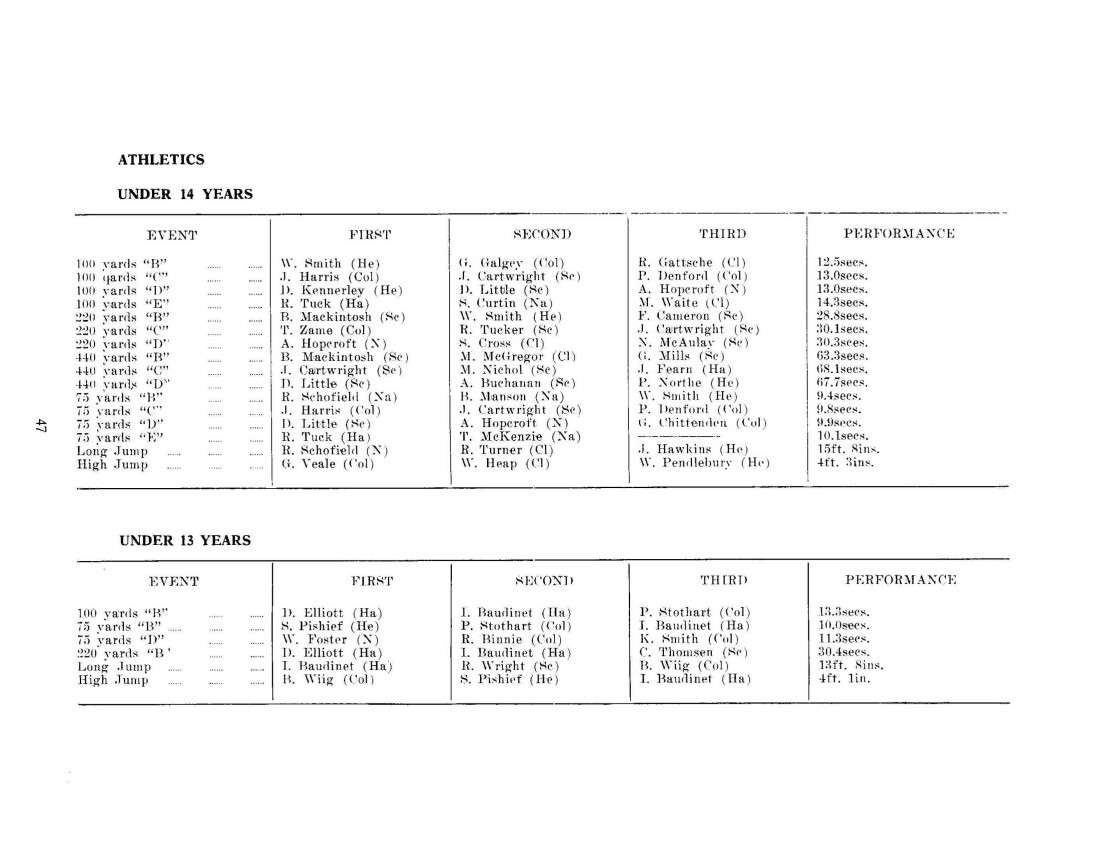
Page 48
PHYSICAL EDUCATION
GYMNASTICS
Last year a group of 60 boys practised twice a week, and presented an item in the “Cavalcade of Sport” demonstrating a variety of skills. By contrast, this year the club has not met as frequently and has not given displays.
This is the second year that the school has put in entrants for the New Zealand Gymnastic Association’s incentive awards. In April Mr. Henderson presented badges to nine boys who passed their tests.
M. Wiig and R. Yates gained badges. Bronze Bar to their badges were won by G. Coombes, D. Martin, P. McKee, G. Mackay, M. Sawyer, B. Smith-Holley, R. White.
It is hoped to continue preparing these awards next year, and to advance as far as Silver and Gold Bar level when more apparatus becomes available.
JUNIOR INTER-FORM MINOR GAMES COMPETITION
Minor games that are well-known to all through phys. ed. periods formed the basis of an organised contest between third form and fourth form classes on the afternoon of Thursday, 21st November, 1963.
The results were:
Third Form: 1, 3G, 80; 2, 3 Gen, 79; 3, 3A, 71.
Fourth Form: 1: 4A, 85; 2: 4B, 80; 3 equal: 4Gen and 4G, 79.
The games went well, with much enjoyment. Twenty minutes at each game did not seem too long. The successful idea was the brainchild of Mr. Simpson and the Phys. Ed. department.
There was a third form circuit at the north end of the grounds, with eight games for the eight classes, and a fourth form circuit with seven games for the seven classes. Each class was divided into two teams, and “A” team started by playing “B” team. Then the two class teams followed the opposite direction round the circuit, meeting other class teams.
The games were long ball, scragg, corner ball, spider soccer, Danish rounders, dodge ball and hand soccer, with circle dodge ball added on the 3rd form circuit. Courts were laid out in white on the grass and were supervised by sixth formers, who knew the rules and umpired. When the whistle blew for the change-round, scores were sent to a central point. At the end of the afternoon the results of Team “A” and Team “B” for each class were combined to make a class total.
PHYSICAL EDUCATION COMPETITIONS
The 5th and 6th Form physical education competition was held on November 8, and the 3rd and 4th form competition on November 22, in very cold conditions.
The judges were Messrs Cotterill and Hogge.
Results:
Third Form Class Competition: 1: 3A, 48; 2: 3 Mad, 41; 3, 3B, 40.
Fourth Form Class Competition: 1: 4B, 392; 2: 4 Mod, 363; 3, 4 Gen, 32.
Fifth and Sixth Form Class Competition: 1: 5A, 39; 2: 5D, 37; 3: 5S, 3428.
As the results largely depend upon neat, formal movement, the leaders of all classes are to be particularly congratulated.
TABLOID SPORTS
The senior results were very close indeed in this year’s tabloid sports, Scinde House being strongly challenged by Colenso, who were only one-tenth of a point behind.
On the afternoon of Thursday, October 3, the grounds looked very well, with Junior and Senior teams of the six Houses turned out in whites in front of the school. There were twelve events at which each team proved what proportion of their members could qualify at that particular games skill.
The numbers in Scinde House are growing so much that the Scinde team could not always get through completely in the time allowed. However, this did not handicap their proportional results, and their impressive marching again won them extra points.
The senior results were: 1st, Scinde; 2nd, Colenso; 3rd, Hawke; 4th, Napier; 5th, Heretaunga; 6th, Clyde.
The junior results were: 1st, Scinde; 2nd, Colenso; 3rd, Clyde; 4th, Napier; 5th, Hawke; 6th, Heretaunga.
The Phys. Ed. masters are to be congratulated on the smooth organisation of the many events, which were put through in just over an hour.
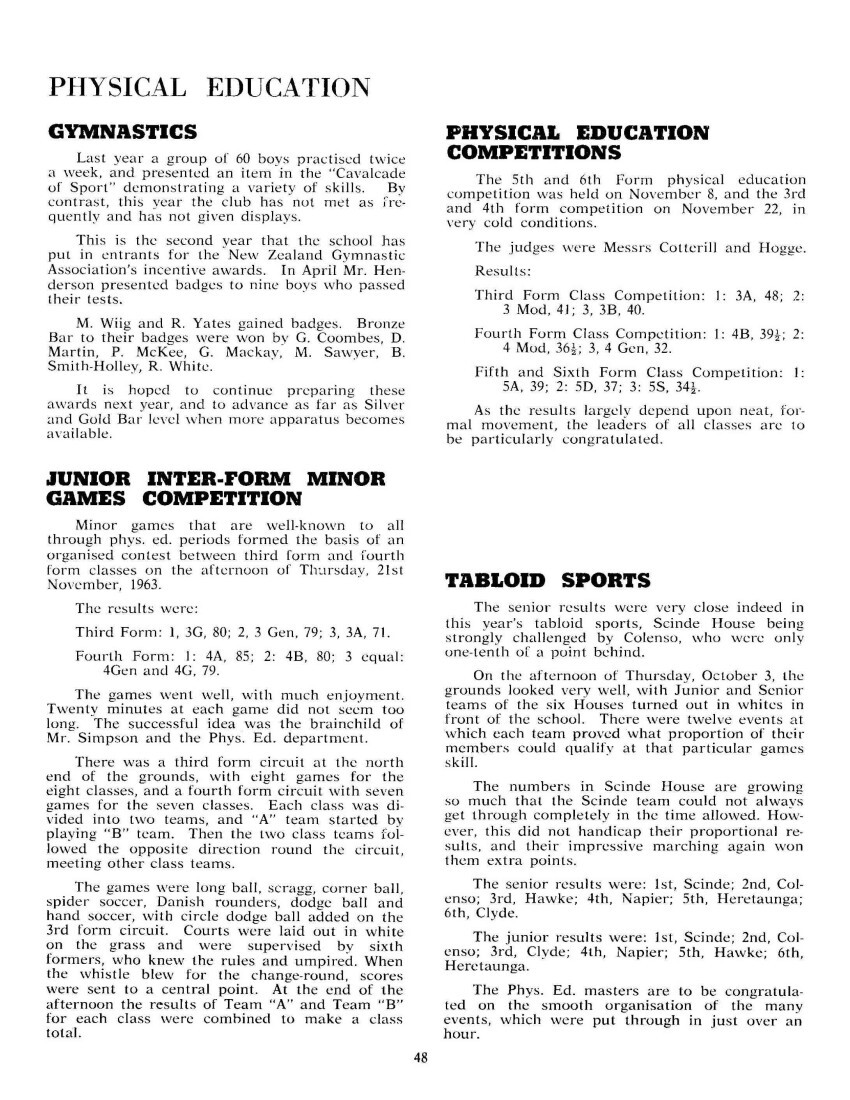
Page 49
SPORTS NOTES
HARRIERS
Forty or fifty boys join in harriers in the winter term, with Mr. Tetley in charge. The longer sports period once a fortnight has allowed runs from three miles to six miles. R. Pawluk, G. Northe and E. Hodgkinson, school harriers, came in among the first ten in the school steeplechase. Running for the Napier Harriers Club, R. Pawluk and E. Hodgkinson were in the first ten at the H.B.-P.B. championships held at Waipukurau. About four other school harriers are also in the Napier Harriers Club.
R. P.
HOCKEY
The First Eleven
With the return of seven caps from last year’s successful Tournament Team, prospects for the 1963 hockey season appeared bright. New additions to the team were R. Campbell, G. Dick, N. Foote, T. Hyde, C. Svendsen and T. Alford, all of whom played well throughout the season. The stronger combination assured us a place in the Senior Men’s Grade.
Inter-Town Competition
The First XI gained second place in the Senior Men’s Grade Competition having won six games, drawn three and lost three to total 15 points out of 24. From these games played against fast and experienced players we developed a keen appreciation of positional play, combination and quick movement necessary for success in Inter- School matches.
versus Wairarapa
The annual match was played on the school grounds under almost perfect conditions. The school team was superior in every department of the game. J. Scott at fullback persistently broke up the attacks led by W. Thompson, Wairarapa Senior Hockey Representative. A. Rowe and W. Turner were sound in the half line. C. Svendsen at right wing displayed good positional play and penetration. I. Turbitt was the spearhead of the attack, and with T. Bates scored the majority of the goals. The final score was Napier 7, Wairarapa 1.
versus Gisborne
Weather conditions for the match against Gisborne were wet, cold and windy. After about 20 minutes of play the ground was reduced to a sea of mud and the cold was so intense that players found it difficult to maintain a firm grip of their sticks.
In the first half play was fairly even, with Napier establishing a slender lead by one goal. Because of the shocking conditions combined play became impossible, and players had to rely chiefly on their individual ability. Throughout the second half play was confined almost entirely to the Gisborne half of the ground.
The Napier players appeared to adapt themselves more readily to the conditions, some indeed revelling in the mud. Two more goals were added and the match ended 5-2 in our favour.
Auckland West Secondary School Tournament.
In the first week of the August holidays the First XI travelled to Auckland to compete in a Tournament at Avondale College Grounds. We played five games, losing only the last to Auckland Grammar. This placed us second in our section. Auckland Grammar went on to win the Tournament, defeating Linwood 5-0 in the final. The following are the results of the games which we played:
Napier 3, Onslow College 2.
Napier 4, Wanganui Technical 1.
Napier 3, Tauranga 1.
Napier 5, Mt. Roskill 1.
Napier 2, Auckland Grammar 5.
This was the largest of the Secondary Schools’ Tournaments held in New Zealand this year, with 18 teams taking part, and from it a Representative Team was chosen, I. Turbitt being the only selection for this team from Napier Boys’ High School. We would like to thank Mount Albert boys for billeting us during our stay.
Northern Zone Colts’ Tournament
During the week following the Secondary School Tournament, two players from the Napier Boys’ High School were selected for the Hawke’s Bay Colts’ Team, which played in this tournament, held in Napier. These were I. Turbitt and T. Hall, goalie for the Second Eleven.
The only other occasions, after the August holidays, that First XI players had to play together were in the two seven-a-side aside at Waipukurau and Napier.
Teams came from Gisborne in the North and from as far south as Palmerston North to compete in the Waipukurau Tournament.
A seven-a-side aside from Napier Boys’ High Schools’ First XI won the Junior Men’s Under 18 Final, from Dannevirke High School.
A Closing Day Hockey Tournament was held at Napier by the Hawke’s Bay Hockey Association. First XI seven-a-side aside played in Senior Men’s and Junior Men’s Sections, and in both were runners-up. The team playing in the Senior section was defeated by Napier Technical Old Boys’ by two points.
The team for the Waipukurau Tournament was: J. Turbitt, T. Bates, D. Taaffe, G. Dick, R. Campbell, A. Rowe, N. Foote and J. Scott.
The Senior team for the Napier tournament was: I. Turbitt, D. Taaffe, T. Bates, R. Campbell, W. Turner, A. Rowe and J. Scott.
This year the Napier Boys’ High School First eleven’s play was of a high standard. In goal P. Loader filled the position well. J. Scott and R. Campbell playing in the backs proved a formidable combination, tackling and clearing with cool efficiency. The halves consisting of W.
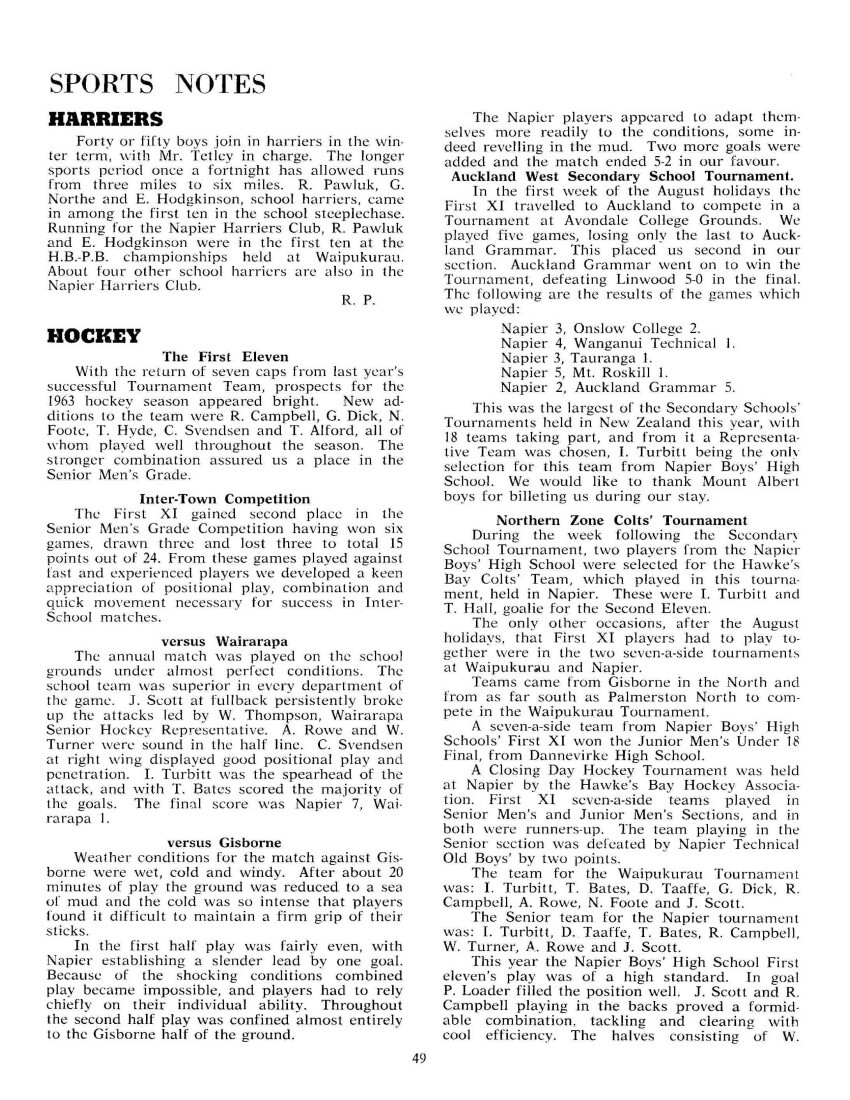
Page 50
Turner, A. Rowe, N. Foote and T. Hyde marked their opposing numbers well and distributed the ball judiciously among their forwards. C. Svendsen and G. Dick, on the wings, were fast and maintained good positional play. The inside forwards consisted of I. Turbitt (capt.), T. Bates and D. Taaffe, who displayed contrasts of speed, ball-control and combination.
Finally, I would like to thank those who have supported the team throughout the season, Umpires who have controlled our games and especially Mr. Revell, First XI Coach, Mr. Nicol, Second XI Coach, and Messrs. Matthews, Webster and Mundy, for giving up their time to coach and guide our teams.
I. T. T.
The Second Eleven
The second hockey eleven went up to 2nd grade competition, which they found very difficult to start with. They improved in all skills of hockey throughout the season, and eventually defeated a few of the stronger teams. Coach: Mr. C. V. Nicol; Team: E. Alford, T. Butler, N. Campbell, G. Dick, G. Ebbett, D. Gardner, T. Hall, E. Hyde, J. McDonald, J. May, G. Nuttal.
The Third Hockey Eleven
The Third Hockey Eleven coached by Mr. Matthews, had a successful season. They were beaten only by the Colenso team, which was later put up to a higher grade. The team was: G. Dale (Captain), K. Campbell, T. Bourgeois, R. Bray, B. Ferguson, R. Gattsche, D. Riddell, E. Robinson, I. L. Smeath, B. Taaffe, R. Vautier.
The Fourth Eleven
Promoted to the Third Grade Competition, the team found the standard tough, and did not score many wins. We are grateful to Mr. B. A. Webster for his coaching and regular attendance at matches. The team was: G. Barlow; S. Bray; M. Dallimore; K. Eagle; R. Faulknor; R. Jeffares; A. Olsen; W. Rongo; E. Simmons; N. Thorp and B. Worsnop.
The Fifth Eleven
Although the team lost six games and won three, it showed great improvement in the course of the season. It played in the 4th grade competition on Saturday afternoons at Marewa Park. The team was: A. M. Mitchell (Captain); P. J. Anderson; L. W. Black; M. V. Bluck; P. D. Chapman; R. P. Chatterton; J. R. Davidson; L. R. Dixon; N. A. Hazlewood; T. R. McKenzie; P. J. Spence; C. C. Thomsen. Coach: Mr. R. Mundy.
INDOOR BASKETBALL
The numbers playing Indoor Basketball this year have increased from six teams to nine. These nine teams were made up of an “A” team, which played in the men’s “B” grade, a “B” team which played in the men’s “C” grade, four teams in the under sixteen grade, and three teams in the under fourteen grade. Next year it will be impossible to cope with more than ten teams because of the lack of coaches. Practices were held after school on Tuesdays and Thursdays, with competition matches being played on Monday nights. Practices were well attended, most teams, however, coaching themselves.
The “A” team this year consisted of Mr. P. Knight, R. Chin, S. Kingi. A. Kells, C. Lum, J. Vivieaere, P. Dallimore and R. Thomson. The team had considerable success beating Colenso “A” and the team from the Royalist, but was unsuccessful in the “B” grade competitions. Thomson playing as shoot was responsible for many of the team’s points.
The “B” team consisted of D. Marshall, B. Marshall, D. Hay, T. Fox, E. Karatau, L. Karatau and A. Pritchard. By the end of the season this team was playing well and was successful in winning the cup for the “C” grade knock-out championships. The team lost narrowly to Colenso and was well defeated by the Royalist team. The team members are grateful for the services of Mr. Ruru, who coached the team on Saturdays and during the matches on Monday nights.
The Junior teams played well, two teams from their number being picked to play for the school for the first time in the Wellington Indoor Basketball tournament. The players benefited greatly and it is hoped that next year the school will be represented by senior teams as well. The development of the juniors, and their keenness, shows promise for the future.
Coaching was handled efficiently by Mr. P. Knight, who concentrated on the “A” team and on the Wellington tournament teams. He was assisted by Mr. O’Brien, who was often seen on Monday nights encouraging the juniors, and Mr. Smithson during sports periods. The members of the Indoor Basketball teams would like to thank these coaches, especially Mr. Knight, for the hours they have spent with the teams.
D. M.
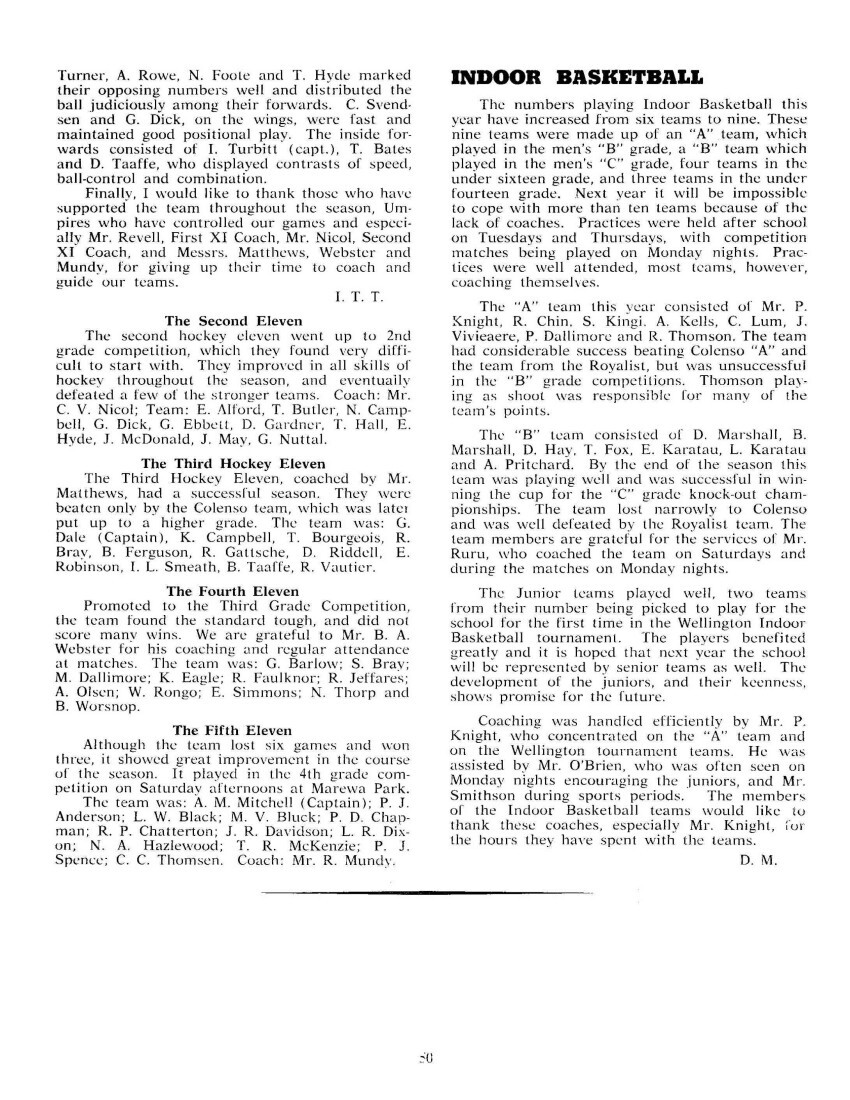
Page 51
SCHOOL ROWING TEAM
Back Row: R. T. Cowan, S. C. Masters, Mr. G. L. Simpson (Coach), H. M. Trafford, J. W. Potter. Front Row: R. H. Sherwood, L. H. Karatau, J. W. Sinclair, K. B. Wallace:
In Front: A. T. Castles.
SCHOOL SHOOTING TEAM
Back Row: J. D. Waterhouse, R. I. Kells, L. J. M. Campbell, D. D. Kerr, P. J. C. Tuck
Front Row: Mr. D. S. McKenzie (Coach), A. J. Schmidt, R. Chin (Captain), Mr. W. T. Carpenter (master in charge), D. O. MacDonald, A. S. Jamieson, Mr. D. M. Brebner (Coach).
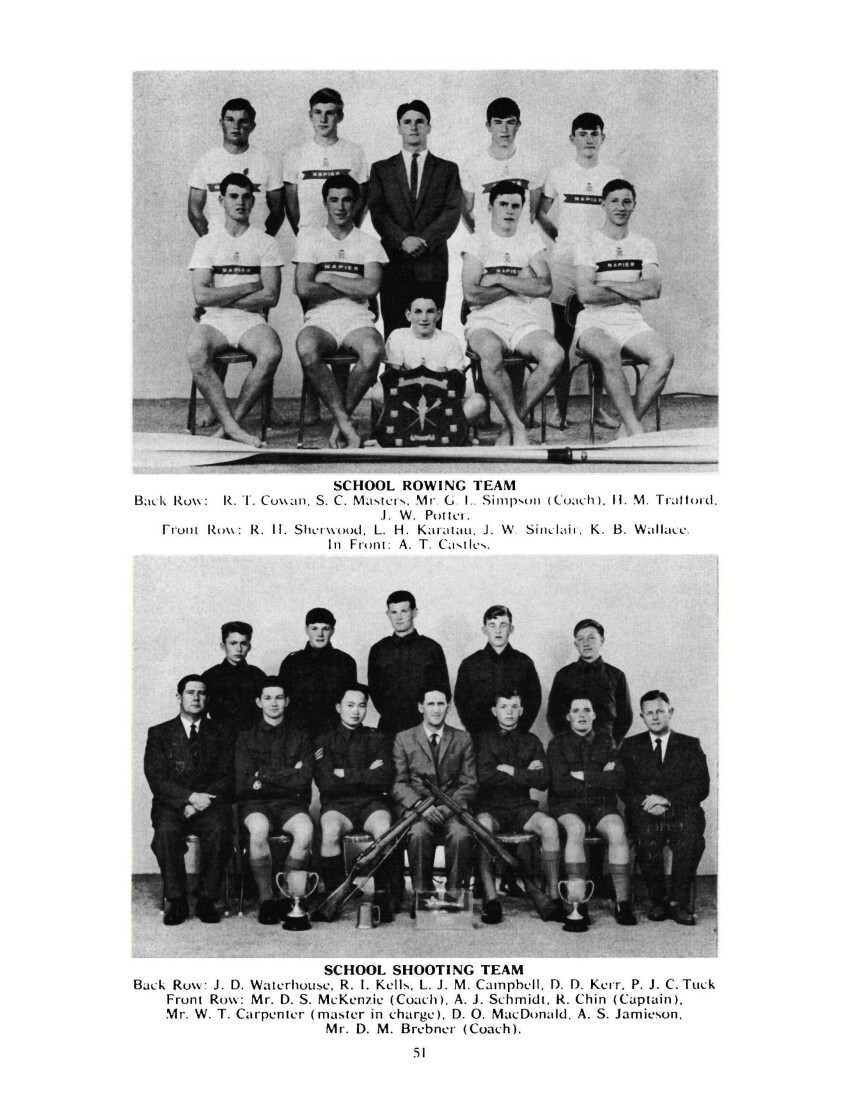
Page 52
SOCCER FIRST XI
Back Row: Mr. I. J. Roberts (coach), D. L. Simkin, W. A. Sadler. M. E. Wiig, Mr. C. F. Smith (coach).
Middle Row: M. B. Bull, S. R. Porter, A. J. Schmidt (captain), J. A. Kay, B. M. Duncan, G. M. Scholes.
Front Row: D. W. Cormack, R. t. Roberts, P. J. Paterson.
SCHOOL TENNIS TEAM
Back Row: B. R. Baudinet, Mr. C. E. Shorter (coach), D. D. Kerr,
Front Row: B. R. Manson, C. B. Frame (captain), D. P. J. Marshall, J. L. Scott.

Page 53
ROWING, 1963
The third year of rowing in the school proved most successful, with a group of eighty boys and several crews competing both at Lake Karapiro and Wanganui.
The first races the school competed in were at the Waikato-Bay of Plenty Secondary Schools regatta held at Lake Karapiro. The crews left early on the morning of the regatta, relying on the generosity of the clubs to lend them boats and equipment.
The eight were successful in the main race of the day, winning the Thompson Memorial Shield, with a top class eight borrowed from St. George’s Club, Auckland, and oars borrowed from Hamilton Rowing Club. King’s College and Wanganui Collegiate were placed second and third respectively.
The following Thursday crews travelled to Wanganui for the Maadi Cup Regatta. Friday was spent in training on the Wanganui River and sight-seeing trips around the city. On Friday night the eight, together with all the other competing eights, attended a dinner at Wanganui Collegiate and were afterwards entertained with rowing films.
Once again rowing in a borrowed eight, this time from the Aramoho Club, the eight was not so successful and came in fifth in a field of nine.
The members of the eight this year were: L. H. Karatau (stroke), R. H. Sherwood, R. J. Cowan, H. M. Trafford, S. C. Masters, J. W. Sinclair, J. W. Potter, K. B. Wallace, and A. Castles (cox).
With a number of these boys returning to school next year, and many of the more junior rowers progressing, the prospects for next year’s rowing look quite bright. Again the group will be competing in a number of inter-secondary school regattas, and with the support of the boys’ parents these trips are sure to be of much benefit to the group. Many ideas are gained from these trips: racing procedure, new styles, and in some cases the opportunity to use other clubs’ training equipment.
However, next year, with a donation from the Golden Kiwi and the Hawke’s Bay Rowing Club, the school hopes to have the use of a new high class eight and oars from Australia. Already plans are being made for the school to raise money to assist with the finance. The boat is on order, and should arrive in time for next year’s rowing season, and the Maadi Cup, 1964.
Once again the school group must express their sincere gratitude to Mr. Simpson, the school Rowing master and coach of the group, also Mr. Tony Austin, and Mr. Tony Bone, who spent much of their time in coaching. Also our thanks to the boys’ parents who showed so much support to Rowing this year, and to the Hawke’s Bay Rowing Club, for, without their support, rowing would not be possible in the school.
L. H. K.
SHOOTING
The 1963 shooting team was successful in winning the Wild Trophy from Gisborne Boys’ High School. This is the fourth successive year Napier has won. In the Coleman Shield Competition the team won the Runner-up Cup.
The team and training squad thank Mr. Carpenter, Mr. McKenzie, Mr. Brebner and Mr. Lloyd for giving up much of their own time in coaching and supervising our practice sessions.
Earl Roberts’ Competition.
Three teams fired in this shoot, but failed to qualify for the final shoot. Results: “A” team scored 265 out of 320; “B’” team scored 251; “C” team scored 244.
Best individual scores out of 80 were: D. Kerr, 74; R. Chin, 73; J. Piper, 72; L. Campbell, 70.
Inter-House Shoot.
The Kiwi Cup awarded to the top house was this year won by Scinde.
1 Scinde 571
2 Heretaunga 541
3 Napier 501
4 Hawke 480
5 Clyde 457
6 Colenso 446
The Vigor Brown Belt for the highest individual score went to R. Chin (Heretaunga), scoring 118 out of 125.
Winners of Lady Godley Cups for topscorers in the other houses went to:
D. Kerr (Scinde) 116
H. Black (Clyde) 110
A. Jamieson (Hawke) 106
R. Malcolm (Colenso) 97
J. Sutton (Napier) 95
Wild Trophy.
This annual shoot is always held in Gisborne, and is always popular. The match was shot on the Sponge Bay Range on Saturday, September 28. The weather was ideal for shooting. Napier put up a record score for this match, scoring 1251 points to Gisborne’s 1042 points. Eight boys shot, the top seven scores counting towards the team’s total.
Individual scorers were:
L. Campbell 187
A. Schmidt 186
R. Chin (capt.) 184
D. MacDonald 180
A. Jamieson 177
R. Kells 176
P Tuck 161
D. Kerr 143
Coleman Shield.
Held on October 5 at Roy’s Hill Range, the Coleman Shield was shot for in sunny weather. The hot weather seemed to affect some of the shooters and the team failed to reproduce its Gisborne
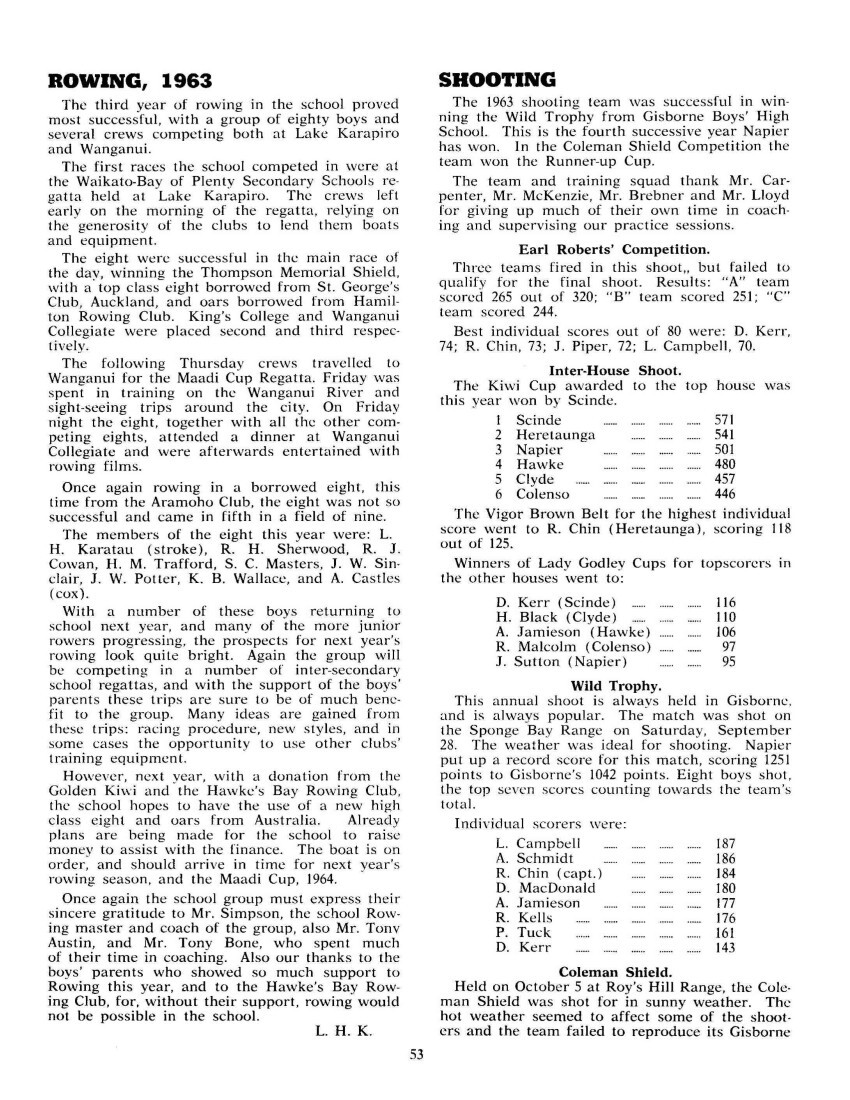
Page 54
score. Napier started off well and at lunch had a six point lead over Hastings. The lead changed after each practice, but at the end Hastings won the shield by six points. For the third successive year the Napier B.H.S. team has had to be content with second place.
In the falling-plate shoot we were eliminated by a team from Poverty Bay. The team was unlucky in that one of the shooters hit and turned a plate side on.
The officers’ shoot was again won by Mr. Brebner, and Mr. Lloyd was runner-up. The masters at this school seem to have steady arms and will be hard to beat next year.
L. Campbell won the runner-up cup for the second time. This year he was beaten by only one point. J. Waterhouse won the emergencies’ prize.
Individual scores:
Ap. Sn. Rap. Ap. Rap. Ttls.
200 200 200 300 300
Sgt. L. Campbell 24 49 46 21 45 185
Sgt. R. Chin (capt.) 24 44 48 24 41 181
Sgt. P. Tuck 23 47 46 21 40 177
Cdt. D. MacDonald 25 49 36 22 36 168
Cdt. R. Kells 23 42 44 22 37 168
Cdt. A. Jamieson 23 40 39 21 35 158
W.O.II A. Schmidt 24 31 31 21 43 150
Cdt. J. Waterhouse 25 41 44 22 41 173 (res.)
Team total: 1187
Senior Championship.
The senior shooting champion is decided on the highest aggregate score over the Inter-House Shoot, Wild Trophy and the Coleman Shield.
Senior Champion: R. Chin (483 pts. out of 525)
Runner-up: L. J. M. Campbell (473 pts.)
Junior Championship.
This year the school’s .22 rifle range was pulled down and so the Junior Champion and Third Form Champion have not yet been found. However it is hoped that the championship will be decided before the end of the term.
Rifle shooting should again reach a high standard next year, with four or possibly five of this year’s team returning. With a little luck, the Napier Boys’ High School shooting team should next year bring home the elusive Coleman Shield.
R. C.
SOCCER
This year over 80 boys chose Soccer as their winter sport. Of these, however, only 30 elected to play Soccer for the school on Saturday with the rather disappointing result that only two teams were fielded in the local competition. The First XI played in Division 1 and the Second XI in Division 2.
This year the “round ball code” was fortunate in. acquiring the services of Mr. I. Roberts, who,
with Mr. Smith, worked extremely hard for the promotion of Soccer in the school. Once again Soccer players were given a ground and the use of the Gym on Tuesdays after school. All players used these to the best advantage.
Congratulations must go to the captain of the First XI, Adrian Schmidt, who this year became the first player in the history of the school to receive his colours for Soccer. Schmidt, giving three year’s service to the First XI, including one as captain, is a worthy recipient of the award.
The First Eleven: This year’s First Soccer XI consisted of: A. Schmidt (captain), T. Kay (vice- captain), W. Sadler, B. Duncan, G. Scholes. D. Simkin, D. Cormack, R. Porter, G. Wiig, M. Bull, R. Roberts and R. Paterson.
From the outset the team resolved itself into a strong combination, both in attack and defence. The skilful short-passing which developed between the half-backs and forwards was extremely gratifying to supporters of the First XI and resulted in the team winning a good proportion of its games in the first half of the season. In the second half of the season, however, the team seemed to lose its initial winning streak, losing several of its games, and finishing in a low position in the competition. Although the team did not generally progress as had earlier been anticipated, there is consolation in the following facts:
(a) The biggest loss suffered by the First XI this season was by five goals compared with 13 goals last season.
(b) Eleven of this year’s 12 First XI players will be returning to school thus brightening the prospects for next season.
(c) The awarding of Soccer colours to the captain of the First XI, A. Schmidt. Although disappointment must be expressed that the whole of the First XI did not receive colours, the awarding of these to its captain is welcomed as at least a step in the right direction.
The results of this year’s Inter-School games proved decidedly more successful than in previous years, with the First XI registering its first win ever in an Inter-School match by defeating Hastings on the annual field day.
Versus Gisborne at Gisborne: Gisborne ran out the winners, 6-1. T. Kay at centre-half played well on defence for Napier. We thank the Gisborne boys for their hospitality and congratulate them on their win.
Versus Hastings at Hastings: The game was played under wet, unpleasant conditions, which were not conducive to the playing of constructive Soccer. The Hastings team adapted themselves to the conditions better, in the early stages of the game, and succeeded in scoring twice in the first 20 minutes. Napier’s persistent attacking paid dividends, however when inside-left R. Porter scored the “goal of the season” just a few seconds before half-time. His brilliant left foot shot from a good centre by R. Roberts, gave the Hastings
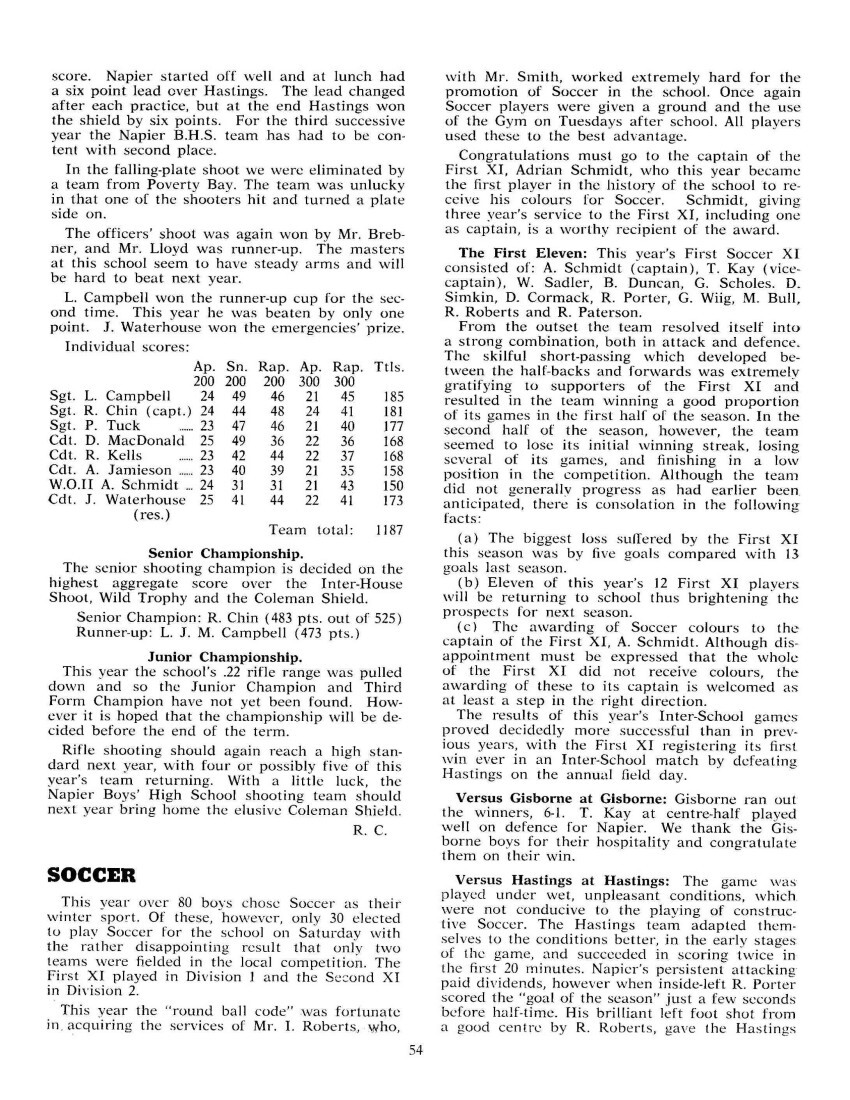
Page 55
goalkeeper no chance. In the second half, Napier generally had the edge over its Hastings opponents. After 15 minutes, from a free kick inside the Hastings penalty box, the ball was pushed to inside forward G. Wiig, who from 10 feet out made no mistake with his shot. Ten minutes later Wiig scored his second and the winning goal, by flicking the ball over the head of the advancing Hastings goalkeeper from a difficult position. The Hastings team showed more cohesion and determination for the remainder of the game, but the Napier defence, particularly the captain, A. Schmidt at left-half, played soundly and there was no further scoring. Final result: Napier 3, Hastings 2.
The First XI rounded off a season of somewhat mixed success by participating in an enjoyable game with the masters. D. Cormack played well for the First XI, scoring twice, but the masters’ half-back line of Messrs. Smith, Smithson and Roberts overshadowed their First XI opposites and paved the way to a 4-3 victory for their side.
The Second Eleven. This year’s successful Second Soccer XI was: J. Forsyth (captain), J. Briggs, P. Spiller, G. Scott, M. Lambert, R. Armour, K. Butler, M. Johnson, R. Shuker, R. Cowdell, P. Rutter.
The team played with determination and consistency throughout the season, scoring some big wins and being placed second in its competition (Division 2). On the field day at Hastings the team played a hard match with the Hastings Second XI. Our team generally played the better soccer and won the hard fought encounter by one goal to nil.
Representative Honours. The following players gained places in representative teams: R. Roberts (H.B. under 18 year XI; H.B. under 16 years XI); T. Kay (Napier under 18 years XI; H.B. under 16 years XI); B. Duncan (H.B. under 16 years XI); M. Bull (H.B. under 16 years XI); W. Sadler (Napier under 18 years XI); D. Simpkin (Napier under 18 years XI).
In conclusion our sincere thanks go to Messrs. Smith and Roberts, for their untiring efforts in coaching and organising the teams. Special thanks also to parents who have transported boys to games and who have given the teams support during their matches. The First XI members extend their thanks to Mr. Schmidt, who once again generously supplied them with oranges during the season.
W. A. S.
SOFTBALL
It is usual that a very large portion of the school choose softball as their summer sport, and this year was no exception. With all Houses entering teams many games were played every sports period during the summer months. Messrs Briasco, McKenzie, Pimm, Howlett and Flowers organised the games and their generous help was very much appreciated.
Scinde House once again entered a team in the Hawke’s Bay softball competition at Hastings. Here it met with considerable success and had many enjoyable games in spite of the fact that the competition was poor. However, the 1963-64 season saw the entry of several new teams in the senior B grade, which is very encouraging, and has added strength to the competition.
The side had a most enjoyable game against the cruiser H.M.N.Z.S. ‘Royalist’ when it visited Napier. Their team, in spite of its difficulties in practising, proved too skilful for the school side and won 20-17.
Last season Scinde House beat the Dayboys in the annual Wetzel Shield match. This game, as is usually the case, was a pleasant one and a good note to wind up the season on.
The Scinde House team this year was: E. W. McGregor (Capt.), D. O. Macdonald (vice capt.), S. C. Herbert, H. K. Taylor, N. W. Dobson, R. J. Carberry, J. R. Lancaster, A. Ferguson, R. A. Thomson, G. M. Phillips. As most of these members are leaving, the prospects for next year’s side are not bright, but it is hoped that the new members improve rapidly and develop the skills of the game.
E. W. McG.
SWIMMING
Tremendous barracking from Scinde House whipped up suspense for the Senior House Relay, the climax to the swimming sports at the Municipal Baths on the morning of Thursday, February 28. However, Clyde House came in first, having a stronger combination, and Scinde House came second.
T. Bates created a new record for the 33 1-3 yards Intermediate Butterfly. His time of 22.3 seconds lowered G. Waite’s 1962 time of 22.5 seconds.
A. McDougall won the senior championship. D. Gempton won four events to take the Intermediate Championship. R. Harding became Junior Champion. Clyde House won the house competition with 74 points, and Colenso House came second with 69 points.
Thanks go to Mr. G. Simpson and his team of helpers, who did a tremendous task in organizing the entries. The whole morning was run with particular care.
Swimming Team, 1964
Representing us at the North Island Secondary Schools’ Swimming Tournament at Palmerston North on Saturday, March 16th, were G. Fuller (220 yards under 15 freestyle), R. Harding (100 yards under 15 freestyle), A. McDougall (100 yards senior freestyle) and I Turbitt (100 yards senior breast-stroke). There were 30 schools competing, and our team secured no places in their events. Mrs. Turbitt kindly accompanied the team to Palmerston North.
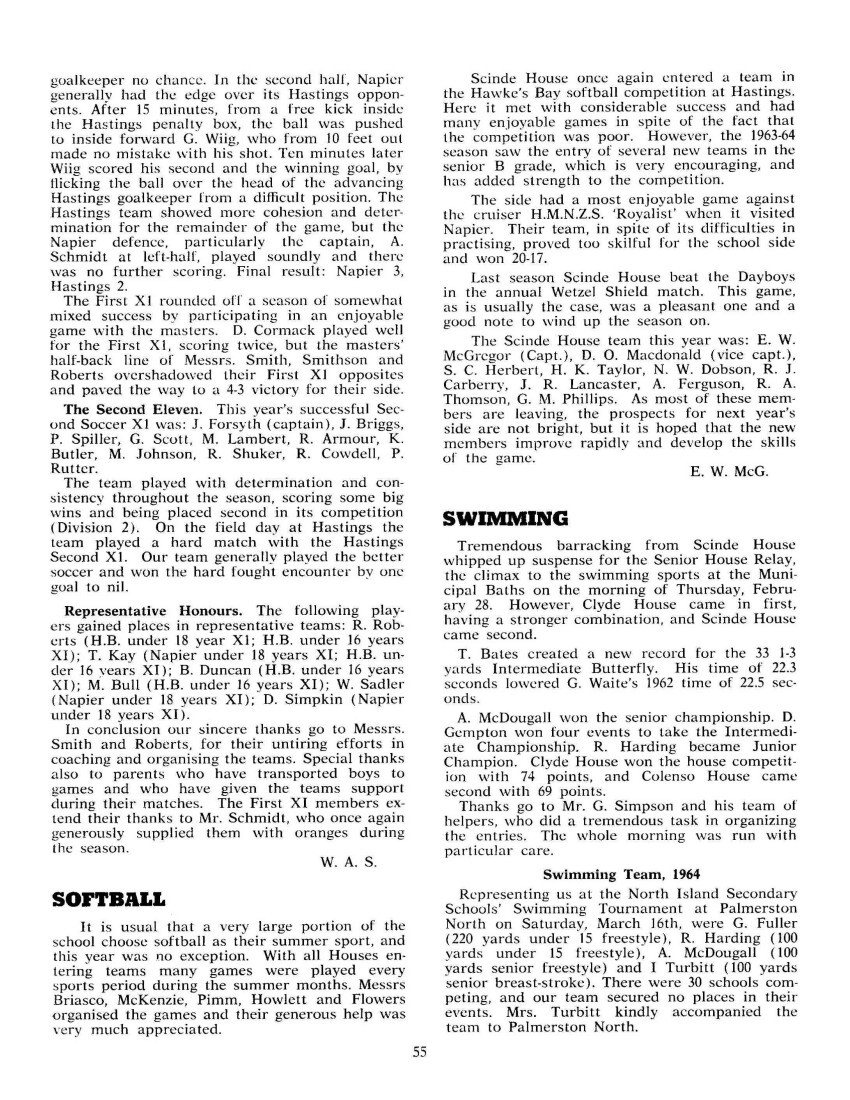
Page 56
SWIMMING
SENIOR CHAMPIONSHIP
EVENT FIRST SECOND THIRD PERFORMANCE
33 1/3 yards Freestyle A. McDougall (Cl) I. Turbitt (Col) G. Johnson (Here) 17.0secs.
66 2/3 yards Freestyle A. McDougall (Cl) I. Turbitt (Col) P. Loader (Col) 37.9secs.
100 yards Freestyle A. McDougall (Cl) P. Loader (Col) W. Cleary (Ha) 63.0secs.
220 yards Freestyle A. McDougall (Cl) P. Loader (Col) P. Gempton (Col) 2mins. 40secs.
33 1/3 yards Butterfly P. Loader (Col) I. Turbitt (Col) P. Gempton (Col) 21.9secs.
33 1/3 yards Backstroke A. McDougall (Cl) I. Turbitt (Col) R. Dallas (Sc) 21.2secs.
66 2/3 yards Breaststroke I. Turbitt (Col) K. Seuseu (Sc) 55.4secs.
Diving Karatau (Cl) I. Turbitt (Col) P. Loader (Col) 19 1-2 points
INTERMEDIATE CHAMPIONSHIP
EVENT FIRST SECOND THIRD PERFORMANCE
33 1/3 yards Freestyle D. Gempton (Col) G. Scott (Cl) T. Bates (Cl) 17.9secs.
66 2/3 yards Freestyle D. Gempton (Col) G. Scott (Cl) B. Johnston (Ha) 39.9secs.
100 yards Freestyle D. Gempton (Col) G. Scott (Cl) T. Bates (Cl) 66.28secs.
33 1/3 yards Butterfly T. Bates (Cl) J. Vivieaere (Col) B. Baudinet (Ha) 22.3secs. (record)
33 1/3 Yards Backstroke D. Gempton (Col) P. Tuck (Ha) K. Bird (Here) 21.58secs.
33 1/3 yards Breaststroke B. Baudinet (Col) G. Scott (Cl) J. Vivieaere (Col) 24.5secs.
Diving J. Vivieaere (Col) E. Karatau (Cl) F. McGregor (Cl) 26 points
JUNIOR CHAMPIONSHIP
EVENT FIRST SECOND THIRD PERFORMANCE
33 1/3 yards Freestyle R. Harding (Here) G. Fuller (Ha) B. Brown (Na) 17.7secs.
100 yards Freestyle R. Harding (Here) G. Fuller (Ha) B. Brown (Na) 64.7secs.
33 1/3 yards Breaststroke R. Hellyer (Here) I. Baudinet (Ha) R. Jones (Na) 27.8secs.
33 1/3 yards Backstroke R. Harding (Here) R. Turner (Cl) G. Fuller (Ha) 22.8secs.
Diving B. Brown (Na ) T. Butler (Cl) S. Horton (Na) 21 1-2 points
OPEN EVENTS
EVENT FIRST SECOND THIRD PERFORMANCE
Junior Relay Heretaunga Hawke Scinde 1 min 22secs.
Intermediate Relay Clyde Scinde Colenso 1 min 17.5secs.
Senior Relay Colenso Scinde Hawke 1 min 12.1secs.
Long Plunge W. Larsen (Cl) M. Hunt (Ha) R. Lee (Col)
SENIOR “B”
EVENT FIRST SECOND THIRD PERFORMANCE
33 1/3 yards Freestyle H. Taylor Sc) G. Robinson (Sc) J. M. Piper (Col) 19.4secs.
66 2/3 yards Freestyle P. Gempton (Col) L. Karatau (Cl) H. K. Taylor (Sc) 40.3secs.
100 yards Freestyle P. Gempton (Col) L. Karatau (Cl) G. Robinson (Sc) 66.1secs.
33 1/3 yards Backstroke R. Malcolm (Col) G. Robinson (Sc ) J. Sinclair (Sc) 24.8secs.
33 1/3 yards Breaststroke M. Girvan (Here) G. Robinson (Sc) 28.3secs.
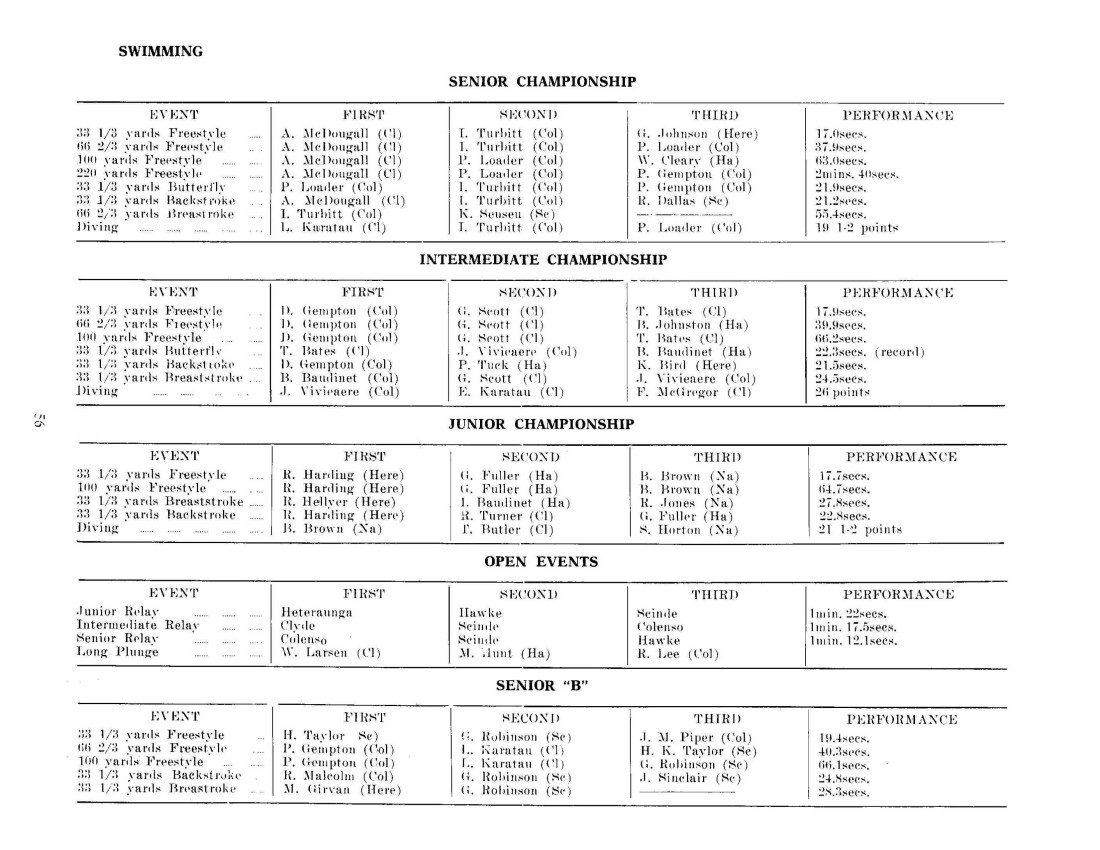
Page 57
SWIMMING
SENIOR “C”
EVENT FIRST SECOND THIRD PERFORMANCE
33 1/3 yards Freestyle D. Iorns (Ha) J. McLeod (Na) J. Isles (Na) 17.6secs.
66 2/3 yards Freestyle J. Isles (Na) W. Nicholas (Cl) R. Sherwood (Sc) 44.6secs.
33 1/3 yards Backstroke A. Isles (Na) J. A. Piper (Col) J. Spence (Ha) 23.8secs.
33 1/3 yards Breaststroke D. Gardner (Sc) C. Smith (Na) D. O. McDonald (Sc) 27.9secs.
INTERMEDIATE “B”
EVENT FIRST SECOND THIRD PERFORMANCE
33 1/3 yards Freestyle G. Mackay (Na) P. Tuck (Ha) M. Gudgeon (Here) 20.3secs.
66 2/3 yards Freestyle A. Godwin (Na) D. Skjottrup (Cl) M. Gudgeon (Here) 43.0secs.
100 yards Freestyle D. Skjottrup (Cl) M. Gudgeon (Here) G. Bigg (Na) 73.1secs.
33 1/3 yards Backstroke D. Bicknell (Cl) D. Skjottrup (Cl) S. Kingi (Ha) 24.2secs.
33 1/3 yards Breaststroke G. Harding (Here) R. Stuart (Ha) G. Weaver (Cl) 24.6secs.
INTERMEDIATE “C”
EVENT FIRST SECOND THIRD PERFORMANCE
33 1/3 yards Freestyle J. de Denne (Sc) R. Shuker (Ha) M. Simpson (Sc) 18.3secs.
66 2/3 yards Freestyle E. Campbell (Na) M. Simpson (Sc) B. Marshall (Sc) 44.8secs.
33 1/3 yards Breaststroke A. Morrison (Cl) K. Jones (Cl) G. Exeter (Cl) 27.5secs.
33 1/3 yards Backstroke J. de Denne (Sc) M. Simpson (Sc) R. Wallis (Na) 22.8secs.
JUNIOR “B”
EVENT FIRST SECOND THIRD PERFORMANCE
33 1/3 yards Freestyle G. Mills (Sc) A. Sherwood (Sc) G. Galgey (Col) 19.7secs.
100 yards Freestyle M. Martin (Here) L. Dixon (Cl) P. Tutt (Cl) 79.1secs.
33 1/3 yards Breaststroke A. Sherwood (Sc) R. Young (Col) N. Fenwick (Col) 30.6secs.
33 1/3 yards Backstroke B. Wiig (Col) M. Martin (Here) J. Hawkins (Here) 25.4secs.
JUNIOR “C”
EVENT FIRST SECOND THIRD PERFORMANCE
33 1/3 yards Freestyle G. Fahey (Cl) P. McCallum (Col) W. Bell (Ha) 21.0secs.
66 2/3 yards Freestyle G. Fahey (Cl) A. Golds (Ha) C. Lee (Ha) 47.1secs.
33 1/3 yards Breaststroke M. Martin (Here) G. Deakin (Here) G. Fahey (Cl) 29.5secs.
33 1/3 yards Backstroke W. Bell (Ha) N. Sawyer (Col) L. Glock (Cl) 27.6secs.
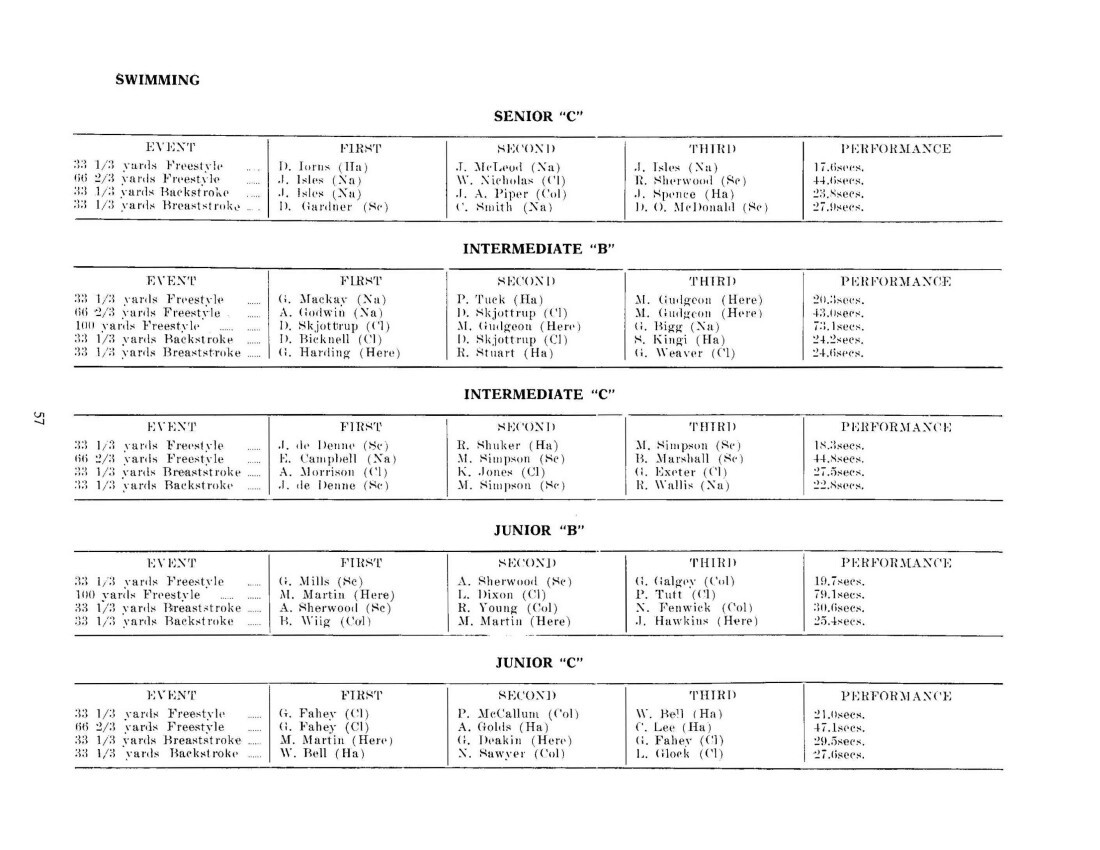
Page 58
TENNIS, 1963
The standard of tennis this year has proved to be as strong as ever, and is likely to remain so because of the continued high standard of our juniors. Each year the number of students playing tennis has increased to a point where the school courts cannot keep pace with the demand, so this year a successful innovation was made, whereby tennis players were given permission to play at outside club courts on Thursday afternoons instead of playing at school. Most of the Juniors played under this system, leaving the school courts free for intensive coaching of the tennis team by Mr. Owen Bold. The result of this coaching can be seen in the record of our tennis team, which has not lost a school match. It must be added though, that if the younger players are to be encouraged, the further courts are urgently needed.
The tennis team for 1963 consisted of B. R. Baudinet, D. D. Kerr, C. B. Frame (capt.), D. P. Marshall, J. L. Scott, B. Manson and was coached by Mr. Shorter. The following received the distinction of representing Hawke’s Bay: B. Baudinet, D. D. Kerr, B. Manson, and the team was captained by C. B. Frame.
During the 1962-63 season the team did not lose a match in playing Hastings, Colenso, Gisborne, and Central Hawke’s Bay. Against Hastings Boys’ High School we lost only one game and so ran out the winners by eight matches to 2. In our game against Colenso High School we combined with the Girls’ High School, resulting in a satisfactory win by 15 games to 9. For the second year in succession we won the newly- presented tennis shield from Gisborne Boys’ High School by winning 16 out of 18 games. This shield has only been in existence for two years. We won the last school game of the season, against Central Hawke’s Bay College, by 19 games to 2.
This year’s tennis championship saw many surprising and unexpected results, especially in the senior section, where J. Scott eventually won after scoring many good wins. In the final, Scott defeated the powerful D. Marshall 6-4, 2-6, 6-0, in an exciting and hard-fought match. In the Junior Championship Single, B. Manson defeated I. Baudinet after a keenly fought game in which long rallies were a feature. The result was 6-2, 5-7, 7-5. The doubles championship has yet to be played; the contestants being C. B. Frame and B. Baudinet against D. Kerr and D. Marshall. This year a tennis ladder was introduced, providing a further stimulus to competition and maintaining interest in tennis in the school.
On behalf of the tennis team I would like to thank Mr. Shorter for the interest he has taken and the time he has given to improving the standard of our tennis. The team is also most grateful to Mr. Owen Bold for leaving his shop on Thursday afternoons to come down to school and give us the benefit of his international experience.
C. B. F.
ACKNOWLEDGEMENTS
We wish to thank the following schools for copies of their magazine: –
Arana Hall, Dunedin; Ashburton High School, Ashburton; Auckland Grammar School, Auckland; Australasian Missionary College, Cooranbong, N.S.W.; Central Hawke’s Bay, Waipukurau; Christchurch Boys’ High School, Christchurch; Christ’s College, Christchurch; Colenso High School, Napier; Dannevirke High School, Dannevirke; Epsom Girls’ Grammar School, Auckland: Gisborne Boys’ High School, Gisborne; Hastings Boys’ High School, Hastings; Hastings Girls’ High School, Hastings; Hobart High School, Tasmania; Horowhenua College, Levin; Iona College, Havelock North; Jeppe High School, Johannesburg; Kamo High School, Kamo; Kuranui College, Greytown; Loretto School, Scotland; Marlborough College, Blenheim; Matamata College, Matamata; Melbourne Church of England Grammar School, Melbourne; Melville College, Scotland; Mount Albert Grammar School, Auckland; Mount Roskill Grammar School, Auckland; Naenae College, Lower Hutt; Napier Girls’ High School, Napier; New Plymouth Boys’ High School, New Plymouth; Palmerston North Boys’ High School, Palmerston North; Papakura High School, Auckland; Queen’s College, Hong Kong; Robert Gordon’s College, Aberdeen; Rotorua High School, Rotorua; Sacred Heart College, Auckland; Saint Andrew’s College, Christchurch; Saint Patrick’s College, Silverstream; Scotch College, Melbourne; Scots College, Wellington; Southland Boys’ High School, Invercargill; Tararua College, Pahiatua; Taumarunui High School, Taumarunui; Tauranga Boys’ College, Tauranga; Te Awamutu College, Te Awamutu; Timaru Boys’ High School, Timaru; Wairarapa College, Masterton; Wairoa College, Wairoa; Waitaki Boys’ High School, Oamaru; Wanganui Technical College, Wanganui; Wellington College, Wellington; Whangarei Boys’ High School, Whangarei.
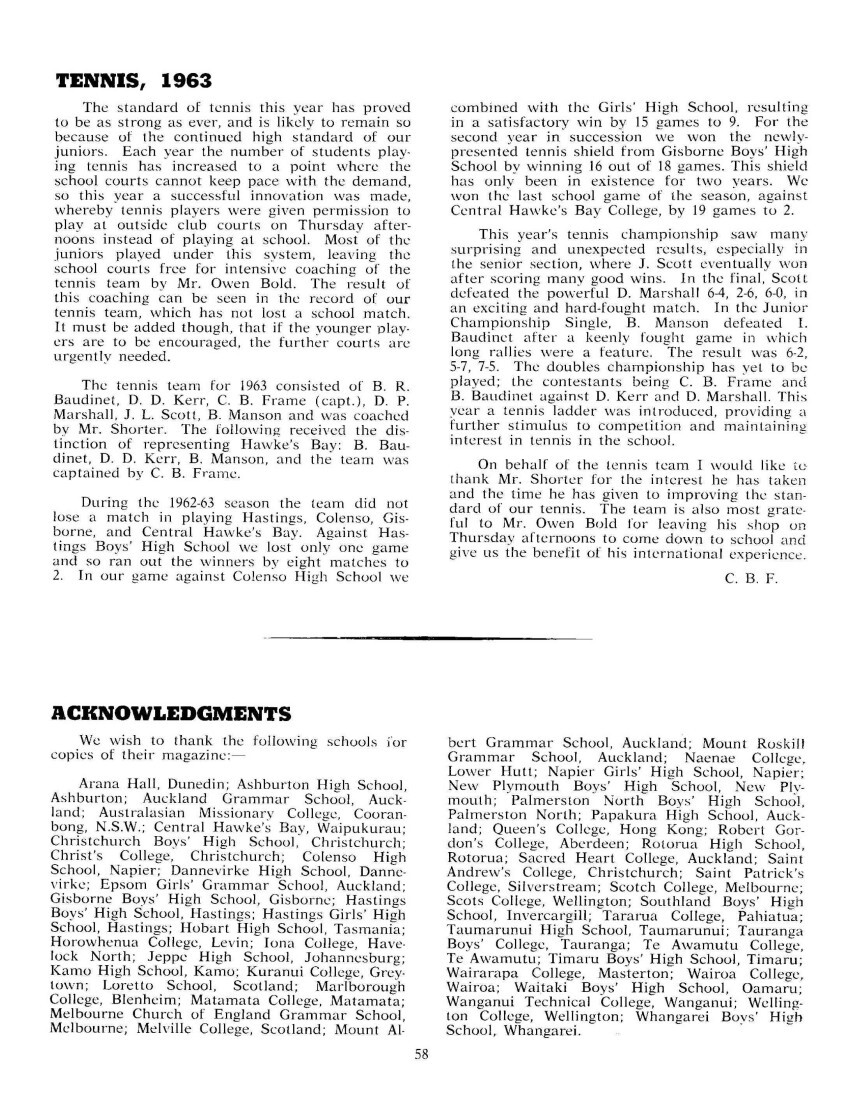
Page 59
OPEN COLUMN
WHY PATRONISE THE PICTURES WHEN YOU HAVE SEEN THE SCHOOL CINEMA ?
You really cannot compare the school cinema with, say, the Odeon. You only have to visit each of them once, and you will see for yourself that the school cinema, in design, in choice of films, in everything, is years ahead of the Odeon.
To illustrate this, there is the matter of exit doors. There are half a dozen exit doors in the Odeon, covered only by a curtain when a film is showing. Think of the draughts that must come whistling through those doors on a cold, wintry night. If there’s a film about Antarctica showing the people near the doors just about believe that they are part of the picture, and the warm currents from the central heating are immediately blown straight to the roof, where, as you know, nobody sits. Just compare that with the school cinema. There, there is only one little door, made of solid wood, and that is more than likely locked (in case of an emergency?). Admittedly, draughts do come in, but only from one direction, and not all points of the compass, as is the case with the Odeon. Then there is the matter of choice of films- the very dullest and most boring pictures are shown at the Odeon (“Lolita,” “Saturday Night and Sunday Morning”), whereas at school you can see such epic films as “Geological Structure of the Isle of Man” (in colour), “The Life Cycle of a Moth,” or the award winning (1929) film, “Henri va a Paris.”
The seats in the Odeon are another problem. They are so comfortable that you fall asleep, which is surely not the correct way to watch a film. Whereas the seating accommodation in the school cinema is, I feel, designed to keep the viewers awake, and if someone behind you is putting his feet into your back, or beating you about the head with his ruler, then so much the better.
Another device for your enjoyment at the school cinema which the Odeon does not provide, is the stopping of the projector every three minutes or so, or the slipping of the film a few feet. 1 cannot help feeling that this is planned to stimulate your interest in the film. The most wonderful benefit, however, has not yet been mentioned. As well as those marvellous features already outlined, to enter the school cinema, you do not have to pay.
When you add all these things together, you can’t help but feel proud of our school cinema, which is one of the more striking examples of the privleges [privileges] students receive when they live in a welfare state.
Bruce Ferguson, 6B beta.
(Prize for Best Entry)
NOVEMBER 15
Another year! another deadly blow
Is struck: cherished hopes are overthrown!
And those unfortunates left, alone
Must struggle with the Varsity foe.
‘Tis well! from this day forward they shall know
That in themselves their future must be sought;
That in their own hands it must be wrought;
That they must unaided stand, or be laid low,
O poltroon whom such a challenge doth not inspire !
We shall exult, if they who must prepare,
Plunge forth undismayed, and thus conspire
To present their true worth; but beware
The sluggard, for he will fall into the mire,
And perish in terror and despair.
J. A. Piper.
HALF PAST TEN.
The bell has rung, the rush is on,
A human river flows,
One aim is in the mind of each:
To join the swaying rows.
The tuck-shop is a smallish room
Which fills to overflow;
There’ll be no dough-nuts left quite soon,
This everyone does know.
And many people seem to think
That if they push like mad,
They’ll reach the counter quicker and
Dough-nuts will still be had.
Without a thought for those in front,
They shove and trample on
The one who bends beneath the weight,
The floor to sit upon.
But let him scrape the dirt away
That hangs upon his face;
And let him eat, for well he may
Be in a hungry case.
J. G. Knight, 4A.
A MASTER’S VIEW
Shiver, oh, splendid cane, thy long body shivering,
Lying across his rump, nigh but not in jest;
Who fearest nor the hiding, nor the rebuking;
Twitch, away, fair but twitch, and what thy quest.
Ah, soon when it’s all over, all our deeds are opprest,
When skies are cold and misty, and pain is swirling,
And it eddies on in shame, honour supprest,
In a quiet corner lonely, thy head low bowing,
I before thee in position that thou knowest …
Thinking slowly o’er thy mind, quietly standing there;-
I watch thee stand unerringly where thou stayest,
I wonder what thy head doest in the corner there.
(A parody from “A Passer By.’’)
A. J. Parker, 4A.
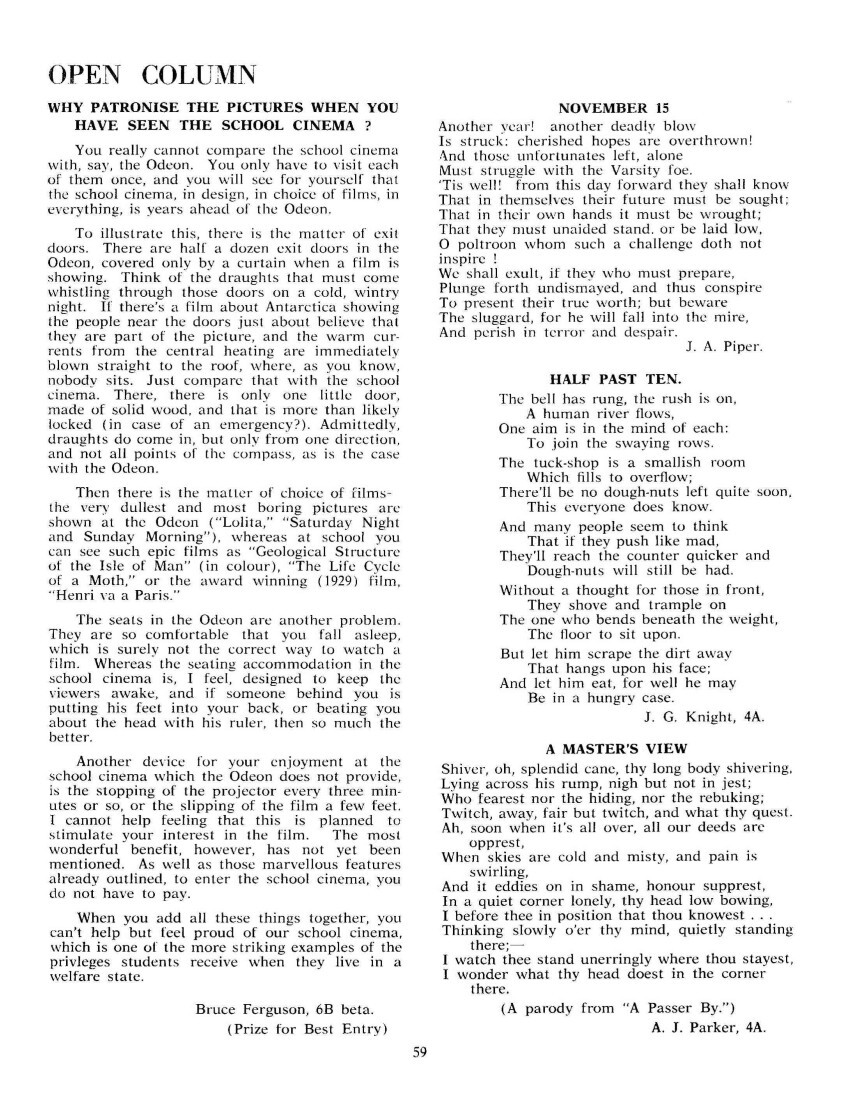
Page 60
WHAT IS SCIENCE ?
What does the word science conjure up in your mind? Undoubtedly it is a vague image, for this word now covers a very large area of meaning. The radio and newspaper exhort us to buy product X with its scientifically proven food value, or scientifically proven brand Y. Farming, and many other activities, have become more scientific of late. In fact, the “art” has gone out of sport and a good athlete is now a scientific boxer, cricketer or runner. In the modern world it is necessary to have some definite knowledge of what is truly science. The smear of emotionalism and commercialism must be wiped away, and the prejudices of classicism removed so the aim of science may stand clear and be understood.
At the heart of science lies the Scientific Method. This is a method of investigation and classification and explanation which has proved extremely successful in revealing the secrets of Nature. To understand science it is necessary to understand the Scientific Method. The first step of the method begins in the laboratory where a series of observations is made under varying experimental conditions. These results form the material for the second step which takes place in the study. The data is examined, classified and correlated, and a generalised statement made summarising the observations. This is known as a natural Law and is usually expressed in a mathematical form. For example the law usually known as the universal gas equation, PV = nRT, (the product of pressure and volume is proportional to the product of absolute temperature and mass of gas) is a quantitative description of the behaviour of an ideal gas. The third step of the method also occurs in the study. The scientist takes a group of interrelated laws and attempts to co-ordinate and explain them by constructing a mental picture of a mechanism, which would account for the behaviour described by the laws. Such a mental picture is called an hypothesis. For example, the hypothesis that a gas is an enormous number of extremely small elastic particles can be used to explain the behaviour of pressure and temperature, and other effects, of a gas. Usually an hypothesis will suggest other effects not yet observed, that is, it has a certain predictive value. These deductions are then subjected to laboratory testing when the hypothesis is either verified or not. If there is a deviation between hypothesis and fact the hypothesis must be modified to account for these new facts, or rejected. When an hypothesis has withstood every experimental attack, and proved an adequate explanation of the facts, it is elevated to the status of a Theory. The hypothesis that a gas is a number of small particles, has now developed to the Kinetic-Molecular Theory. The theory is the end result of the scientific method for it fulfils the aim of science a description of the behaviour of Nature. But the theory is also a beginning to the scientific method for it has a “predictive value,” the ability to predict certain effects not yet observed. The process now moves to the first step as these predictions are experimented on, and new avenues of research and knowledge opened up. Thus, through gradual application of this method, the jigsaw of nature is pieced together. The process of observation and expert-mentation, law, hypothesis, theory is the scientific method, and any branch of knowledge that uses the method can truly be called a science. The usual classes of science are Physics, Chemistry, Biology, Geology, Anthropology, Psychology and Medicine, each capable of further subdivision. Some of these subjects are not usually thought of as sciences, but since each uses the scientific method to some extent, each is considered a science.
The scientist places greater emphasis on quantative [quantitative] than qualitative description, on a numerical rather than an adjectival description. To quote from Lord Kelvin: “I often say that when you can measure what you are speaking about, and express it in numbers, you know something about it; but when you cannot express it in numbers, your knowledge is of a meagre and unsatisfactory kind; it may be the beginning of knowledge, but you have scarcely in your thoughts advanced to the stage of science, whatever the matter may be.” The scientific description therefore is often stated in the language of mathematics. For example a physicist does not say “when an object is pushed it moves.” “Force is proportional to the product of mass and acceleration,” a quantitative statement which (to the initiated only, unfortunately) conveys much more information and is much more useful. This emphasis on quantitative work is more evident in Physics and Chemistry, but is also important in all branches of science. Often the description is more statistical than mathematical, as in sciences such as Genetics, Anthropology, Psychology, Medicine. In fact science would not exist without numbers, and the greatest achievements of science, for example Relativity and Quantum Theory are conceivable only in numbers.
The major difference between the scientific method and any other philosophic method is the emphasis on experiment. The Greek philosophers, for example, concerned themselves only with the theory, and provided their theory “sounded right,” they did not particularly worry if it did not agree with fact. This led to impressive theories, but often absurd conclusions. The scientist, however, is always ready (or should be) to alter his theory if it does not agree with the facts. His aim is simply “a quantitative description of the behaviour of Nature.” His method allows progressive development, and is a closer approach to Truth, the true goal of all Knowledge.
A. J. Schmidt, 6A.
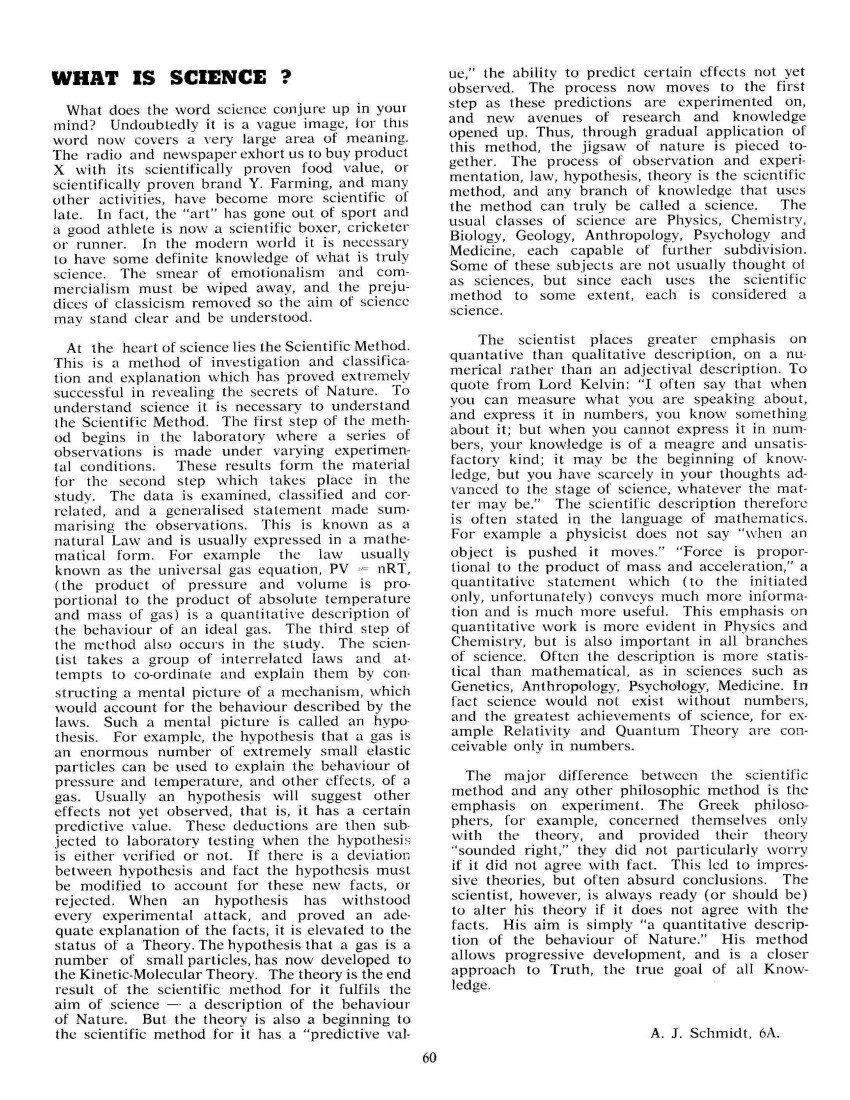
Page 61
B. S. BRENDON ATTACKS “CRUSADERS”
In our fine school near the prefects’ shed
Lies the cinema room, but oft instead
The Crusader League use this air-conditioned hole
To discuss philosophies, while many heads loll.
May I suggest a few new views,
So one may perhaps a little brain use?
Could you not venture forth, and show the right way
To those many atheists who sit outside and play?
Perhaps you could DO instead of much DECLARE
If only others knew what solace lies there;
It would be very pleasing if Crusaders all would squash
The rumours that their leader nearly someone did slosh.
The Crusader League has expounded much the view
That one does to others as they should do to you,
Why is it then that once inside free speech at once must stop
So that one can so clearly hear a T.T.2 stick drop?
The Crusader League throughout the year much busy talk has done
But only when a film is shown do numbers exceed one,
For I cannot call true Crusaders those who only go
To escape cold and other things and polish their halo.
MR. MUNDY REPLIES TO B. S. BRENDON
Although this doggerel verse scarce merits publication,
The claim to have free speech ensures its acceptation.
The thinking of Crusaders will stand examination,
And satisfied newcomers prove we have no segregation.
It is nonsense to suggest that a Christian should not fight
If someone should be sloshed to defend the cause of right;
And to claim we only go to escape the winter’s bite
Is ridiculous, in view of that cold hole, black as night.
6A GRAMMAR PROBLEMS
And so I sit there pondering,
I don’t know what to do.
This sentence has me wondering;
Is it ‘whom’ or is it ‘who’?
The seconds they tick quickly by.
My eyes move round the room,
But the answer is not in the sky;
Is it ‘who’ or is it ‘whom’?
In desperation now I choose
And quickly make a switch.
But later I find no ‘whom’s’ or ‘who’s’;
The right word, it is — ‘which’!
A. J. Mitchell, 6A
WHILE DEER-STALKING
It all began when we decided to go deer-stalking.
I was asleep in the hut when all of a sudden my brother hit me and woke me up. He said there was an opossum in the hut. I lit the candle and my brother hopped out of bed and tried to kill it with a piece of firewood. He threw a piece of firewood at it, but it missed, and the wood hit the table. Crash! That was one cup gone. After my brother having a few more wild shots at the opossum, I asked him to bring me over some fire wood.
His next shot hit the frying pan and knocked it off the bench. It had fat in it. The opossum then jumped on my bed, so I hit it with a piece of wood which I had, and killed it. My brother put it outside and went back to sleep. Then we woke up at 5 o’clock to go out deer-stalking. When I lit the candle, all we could see was wood all over the floor.
Dad said it was a good week-end hunting.
R. B. Neill, 3T.
A BOARDER PINES FOR COUNTRY LIFE
In the town you almost choke
Because of all the industrial smoke;
In the country the air’s a nice smell,
And all the people are healthy and well.
S. J. Macdonald, 3Gen.
THE NOBLE EIGHT HUNDRED
Half a minute, half a minute,
Half a minute onward !
Into the playground
Charged the eight hundred.
Forward and fight, Boys’ High!
Run for the tuck shop nigh !
Into the playground
Charged the eight hundred.
Teachers to right of them,
Teachers to left of them,
Teachers in front of them,
Shouted and thundered,
Prefects dispersed like smoke,
Right through their line they broke,
Into the tuck shop,
Charged the eight hundred.
B. L. Mackintosh, 4A.
THE NEW NOTICE-BOARD
I felt rather flattered,
The first to have shattered,
The glass of the new notice-board.
My heart gave a leap,
As I saw that big sheet,
Come scything down like a sword.
It hit my big toe,
Like a shot from a bow,
And a few naughty words did I utter.
But the words born of pain,
That I felt from the cane,
You wouldn’t even hear in the gutter.
T. W. Skews, 4A.
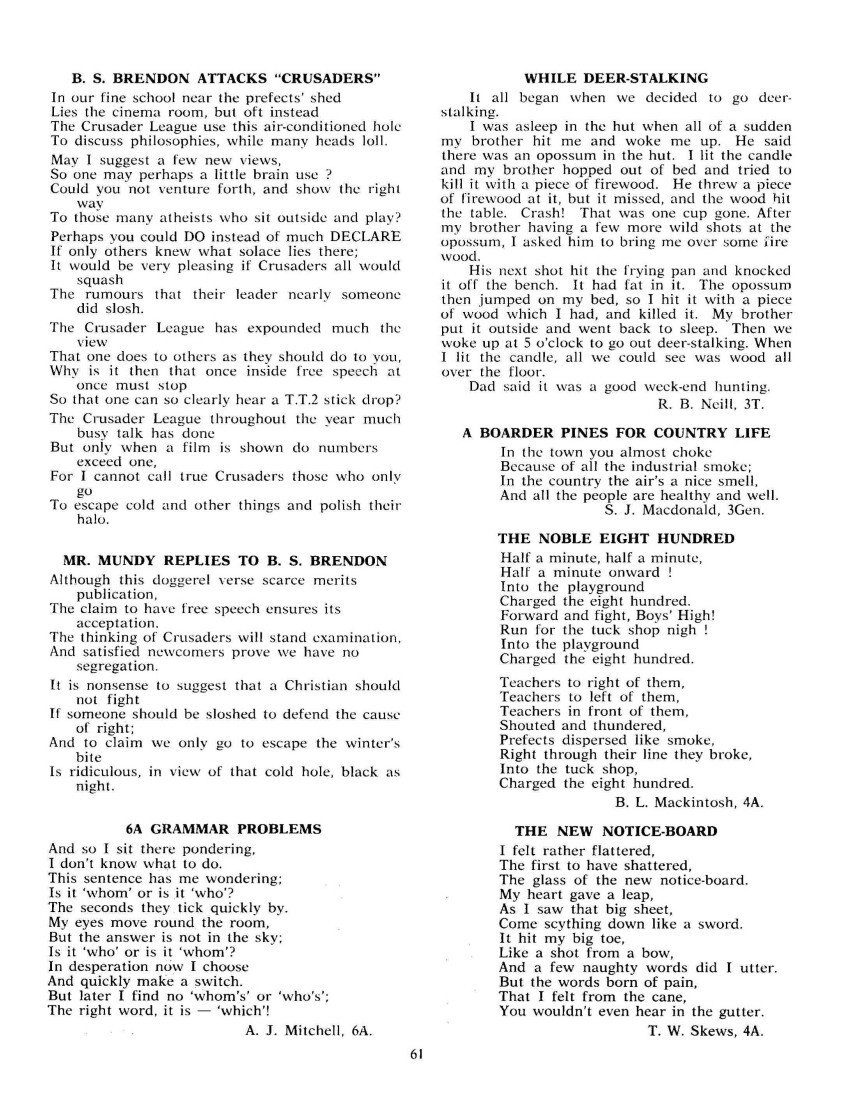
Page 62
SILENT SPRING
“Silent Spring,” a book written by Rachel Carson, is her contribution to the anti-insecticide campaign. This book has shown up the poisonous insecticide sprays and powders in a different light. They are not the modern day marvel anymore, but a deadly campaign. People are beginning to realize the lethality of what they use in the garden, and with what they spray their fruit trees for codlin moth. You probably don’t relise [realise] how toxic these insecticides are. Take for example the most common one, dichloro-diphenyltrichloro-ethane, or just D.D.T. as we know it. A certain Dr. Hargreaves in America sprayed his quarters for cockroaches with 25 per cent D.D.T. and as a result suffered from haemorrhages to the extent that he had to have 59 blood transfusions. Even then he was not cured and developed leukemia nine years later. What would you rather have? Leukemia or a few cockroaches for company? The United States Health Service sampled several meals from various restaurants, etc., and found that every meal they tested contained D.D.T. So next time you pick up a sandwich just bear in mind that you’re eating D.D.T. Not very much of course, but it builds up inside the body, as it did in some grebes at Lake Clear, California. The lake was sprayed to control gnats, with D.D.D. (a close relative of D.D.T.) at the rate of 1/50 of a part per million. This spraying had no lasting effect on the gnats, but the plankton absorbed the D.D.D., the fish in the lake ate the plankton, and the grebes ate the fish, with the result that some thousands of birds were reduced to about 100 pairs. The D.D.D. content in their bodies had risen from the 1/50 p.p.m. sprayed to 1600 p.p.m.
D.D.T. and D.D.D. are, however, only mild poisons when compared with others, such as dieldrin, endrin and aldrin. Aldrin is approximately 300 times as toxic as D.D.T., and is one of the most deadly chemicals known. An example of the stupidity of the authorities in the use of such substances as aldrin, was the attempted extermination of the Japanese beetle, which was accidently introduced into America. Aldrin was not used because of its lethality, but because it was cheap. The result of the pellet distribution was devastating, 80 per cent song birds were sacrificed and 90 per cent farm cats were lost, not to mention large numbers of rabbits, musk rats, possums, etc. Endrin was used to kill mice in Pennsylvania, and it caused the death of many fish in surrounding waters and endangered the shrimp industry. The lethal dose for shrimps being 1/2 of a part per billion.
Not only do the various authorities spray using dangerous chemicals, but they direct them at the wrong pests. The fire ant is a good example. This insect is at the bottom of the list of the twenty worst pests in the southern states of U.S.A. It does little damage, and its mounds or anthills help to aerate the soil, yet once the idea was conceived nothing would stop the authorities from declaring a full scale war on these creatures. Twenty million acres in nine Southern States were sprayed using dieldrin and heptchlor. Poultry, livestock and pets were killed, armadillos disappeared from Texas and 90 per cent song birds were lost in Alabama. In other words, havoc was created.
Animals are not the only victims of such spraying. Besides the Dr. Hargreaves mentioned earlier, two boys were killed after playing with an empty Parathion sack, and a farmer’s wife was poisoned after drinking water contaminated with sprays. Even the laundress of workmen’s clothes are in danger of poisoning. An experimenter once rubbed some pesticide contained in an acetone solution into his arm to study its effects. He found out what effects it had, all right, and lost ten weeks’ work in the process.
There is another method to rid the earth of its pests, a method both tried and proved. This is to liberate sterile male insects. The eggs become infertile, and so the population naturally falls. An insecticide might kill 90 per cent of the insects, which means that after three more generations there would be 125,000 left, whereas using the above method only 125 insects would remain. This method was used in Curacan, Florida, and screw-worms were completely eradicated.
Don’t these examples show the futility of man’s effort to upset the balance of nature?
C.B.S.
LAMENT OF THE MASTER’S CANES
Fain would I change that note
To which dread cane hath charm’d me
Long, long to wail by rote,
Knowing that that harm’d me:
Yet when this thought doth come
“Cane is the only sum
Of wickedness,”
I have no other choice
Than to stand and hold my voice
Or to confess.
O Cane! They wrong thee much
That say thy stroke is needed,
When their good season’s bought,
As nothing can be heeded.
Fair masters of the staff,
Where truest pleasure is,
I do implore thee:
I know thee what thou art,
I serve thee with my heart,
And bend before thee!
R. Porter, 4A.
(with apologies to “Omnia Vincit”
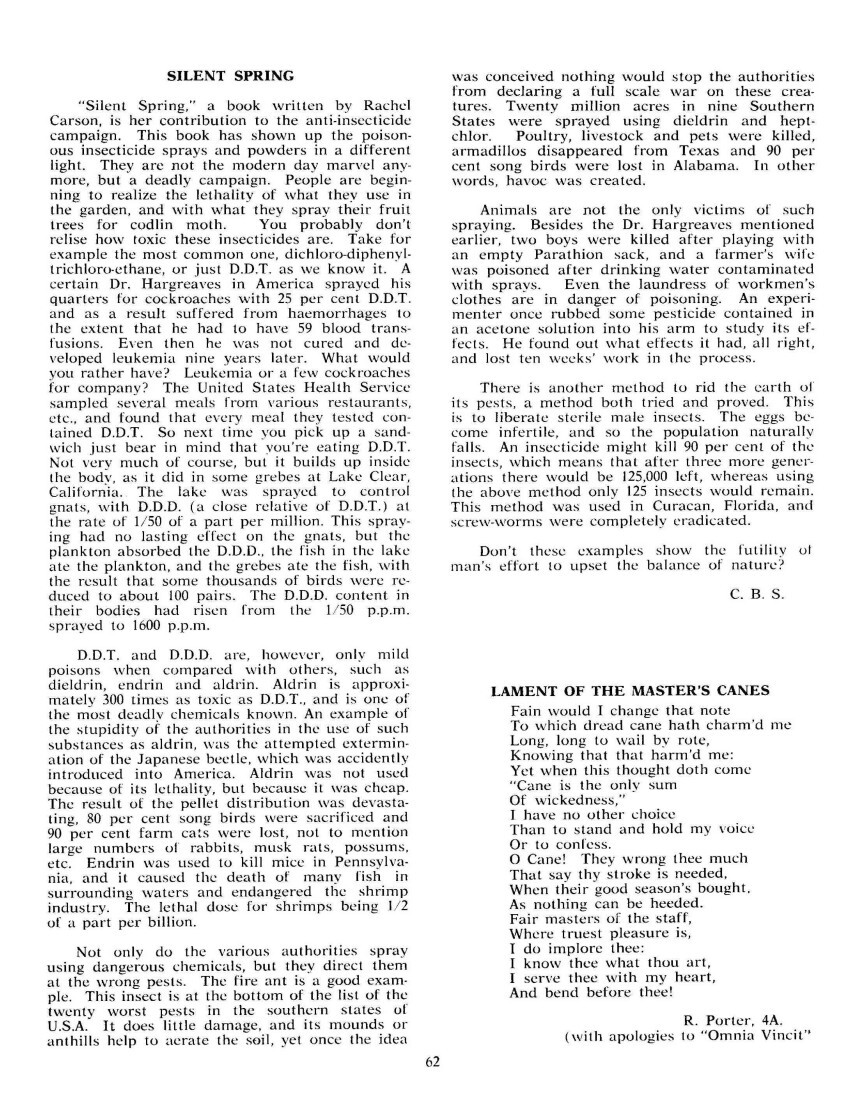
Page 63
THE E.E.C. AND N.Z.’S ECONOMIC FUTURE.
By the terms of the 1951 Treaty of Paris and the 1957 Treaty of Rome, a large economic bloc known as the E.E.C. was established. Its aim was to unite Western Europe economically and politically. During the last six years the E.E.C. has made outstanding progress. The members, France, Western Germany, Italy, Luxembourg, Belgium, and the Netherlands have moulded themselves into the largest single trading area in the world. The E.E.C. is the world’s largest importer. It is also Europe’s largest producer of steel, cars, and manufactured goods. The E.E.C. operates by progressively abolishing all customs duty and other trade restrictions between the members.
Britain, after many unsuccessful attempts to break up the community is now faced with the question if whether or not she should become a member. If Britain does join, she will prosper economically, but she will also break up the centuries old traditions which survive between her and the countries of the Commonwealth. The Commonwealth, however, can never become a suitable economic alternative to the Community, and so it is evident that Britain will enter the Community in the near future. The effects that Britain’s joining will have on New Zealand’s economy will be disastrous unless certain measures are adopted by New Zealand.
The importance of the British market to New Zealand is emphasised by exports of primary produce. Approximately 93 per cent of butter exports, 92 per cent of cheese and 94 per cent of mutton and lamb have gone to the United Kingdom over the last few years. Fifty per cent of the total exports go to the United Kingdom. The 1959 Trade Agreement with the United Kingdom promised New Zealand unrestricted entry to the British market for meat and dairy produce until 1967. But what will happen after 19672 New Zealand is not popular on the Continent, and il New Zealand wanted to trade on the European market, she would have to pay tariffs ranging up from 20 per cent to 24 per cent. Quantitative restrictions would also be unfavourable. These facts seem to rule out any chance of trade with Europe.
It is evident that New Zealand must create new markets and expand its present markets other than those in Europe. Supplementary markets for lamb and mutton have been established in Canada, the U.S.A., Japan, and Greece. These countries could divert some of the flow from an economic break with Britain. India and the Far and Middle East could provide markets for dairy produce, but these countries are relatively poor, and might not be able to afford all the produce we could give them. Beef will be even more important, however, than mutton and lamb as the U.S.A. and Canada can absorb as much as we can produce. A break with Britain would hardly influence the wool situation.
As well as creating new markets, there is a need for the development of New Zealand’s secondary industries. Pulp and paper, plastics, aluminium, steel, oil refining, and tourism will have to be encouraged. There is great potential in all these industries, but capital is needed for their full exploitation.
Thus the next five or six years could be a significant step in New Zealand’s economic history. Whether the country can overcome the approaching challenge or not, only the future can tell.
W. Nicholas, 6A.
LETTERS TO THE EDITOR
Dear Sir,
Don’t you think the situation on a cold and wet day is appalling? Imagine, for example, at lunch-time on some day in June or July, a cold, icy southerly cuts across the quad. What is there to keep boys warm? Oh, yes, the seats at the south end of the quad are out of the wind, but how many of the boys do they seat? About a fifth, and even then tiny whirl-winds raise the dust into eyes and sandwiches. The other four- fifths of the boys huddle together in groups on the cold concrete of the quad, collars turned up, crouched behind cases, and blue with cold. We are even kicked out of. the corridors. Only when it’s really raining do the masters, who, incidentally, enjoy the comfort of a well padded, centrally heated common room, let the boys into the hall. Wouldn’t it be better to let the boys into rooms, under the charge of a senior boy? Why don’t the smug masters go out on a cold day and enjoy their lunch with the boys?
I am, etc.,
“Jack Frost.”
Dear Sir,
Each year a catalogue of individual successes spreading over three or four pages and paragraphed under various heading as Floreat Napiera, Floreat Scindia, The Golden House . . . is printed in The Scindian. As a close and intelligent examination of the mentioned pages will show, these eulogies consist for the most part of lists of the achievements of individuals, who, by accident or otherwise, happen to live in a particular area. Spread liberally over these catalogues, by the writers, is a layer of “house spirit,” which is suggested motivates these individuals to greater efforts. But such authors only bow to a convention which dictates that there must be a house spirit, and therefore attempt to find such a thing. With the possible exception of Scinde House, there exists no feeling, no esprit de corps among the boys, which makes the House mean something. Even in the tabloid sports, the only time that a house competes as a body, there is very little, if any, ‘house spirit” demonstrated, despite the exhortations of the leaders. A disinterested
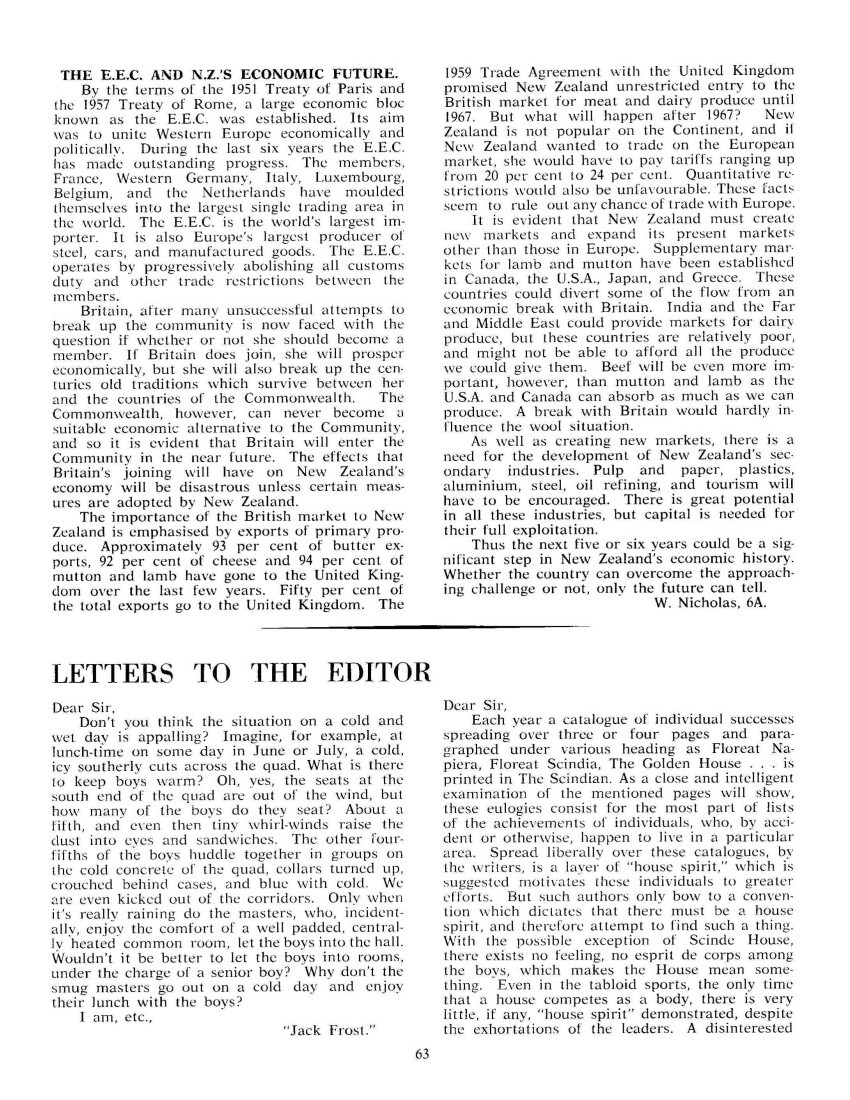
Page 64
observer watching on the day will find little connection between the “fact” and the Scindian reports.
While it may be argued that the house system is necessary to provide a focus to the swimming and athletic sports, once again there is little evidence of the elusive house spirit. In fact the only occasion when anything like house spirit is shown is in the interest and enthusiasm for the house relays. It is doubtful whether the house spirit intrudes anywhere else; possibly the Thursday cricket may find a little creeping in, and probably the inter-house shoot, where the intense feeling for a short time follows the expected pattern. I doubt that sitting in houses in assembly had any effect when it was done, nor is it likely to.
In short then, the “house spirit” is too volatile to remain long enough to have any effect. The only house which exhibits any spirit is Scinde House, and only because they are exposed to it all the time. For the remainder of the school there just isn’t enough of it to have any effect The “house spirit” is drunk but three times a year by the whole school; at the swimming sports, the athletic sports and the tabloid sports; and possibly at isolated times by other individuals.
I do not advocate any sort of reform, though more prominence for house affairs would not be out of place. Rather I seek to counter those glib-tongued people who speak glowingly but unknowingly of “house spirit”; and to provide an interpretation of three or four pages of the Scindian. In fact, the lauded Heretaunga House motto: “First we honour the School, then the House”, (quoted in the last four, possibly more Scindians), provides the key to the catalogues and sums up neatly the attitude of most, except the house comes a very bad second.
I am, etc.,
A. J. Schmidt, 6A.
(Prize for best letter)
Dear Sir,
It is evident that the Debating Club is one of the most important cultural influences in the school. In the last two years the standard and enthusiasm of the Debating Club has not been what it could have been. I believe that this is due to the infrequency of meetings and the awkward time that these are held. May I suggest these points, which I think may restore the club to its rightful place in the school life.
1. The club should be started at the beginning of the first term.
2. The club meet on Monday afternoons, between say 3.40 and 5 p.m.
3. Outside debates be held in the evenings.
The reason for starting early in the year is to allow enough meetings for a reasonable standard of proficiency to be reached by all members. With the club commencing later in the year, as has been the case, there cannot be enough meetings held. The second point covers the question of clashing with other activities. Firstly, an after-school meeting is more convenient than an evening one. Secondly, there is no other activity (football, etc.) on Mondays, and if the Debating Club laid claim to Monday early in the year other interests would be forced to different days. Outside debates with Jaycees, etc., are more conveniently held in the evening and would provide an added extra interest.
My suggestions are of course open to criticism, but I hope that whatever actions are taken the Debating Club will stand on the pedestal that rightfully belongs to it.
I am, etc.,
A. J. Schmidt, 6A.
Dear Sir,
I wish to protest respectfully yet energetically against the unfortunate recurring coincidence of 6th Form English classes with the mowing of the lawn on the school side of the drive. The noisy machine, often operating in one place while it circumnavigates shrubs and trees, though effectively checking the luxuriance of the grass, also effectively disrupts our “differentiation by antonyms.”
May I suggest that the gardener reserve school time for the quieter jobs on his agenda, and mow the lawns along the school front after 3.25 p.m.
I am, etc.,
S. P. Spiller.
SCHOOL ROLL, 1963
FORM 6A. Angove, D. H.; Barnes, K. W.; Brendon, B. S.; Chin, R.; Dale, G. P.; Hobin, R. T.; Irwin, J. R.; Isles, J. K. W.; Kells, B. A.; Larsen, W. A.; McGregor, E. W.; Marshall, D. P. J.; Mitchell, A. J.; Nicholas, W. W. H.; Seuseu, K. F.; Schmidt, A. J.; Thomson, R. A.; Williams, G. B.
FORM 6B Alpha. Dallas, R.; Dick, G. L.; Fergusson, D. J.; Frame, C. B.; Godfrey, S. C.; Higgens, L. G.; Hood, I. R. C.; Kells, R. I; Kerr, D. D.; Macdonald, D. O.; Mackintosh, A. J.; Malcolm, R. K.; Martin, D. W.; McDougall, A. D.; McKelvie, R. M.; Paterson, G. R. H.; Piper, J. A.; Pishief, J.; Potter, J. W.; Robinson, G. W.; Sadler, W. A.; Smith, C. B.; Spiller, S. P.; White. T. C.
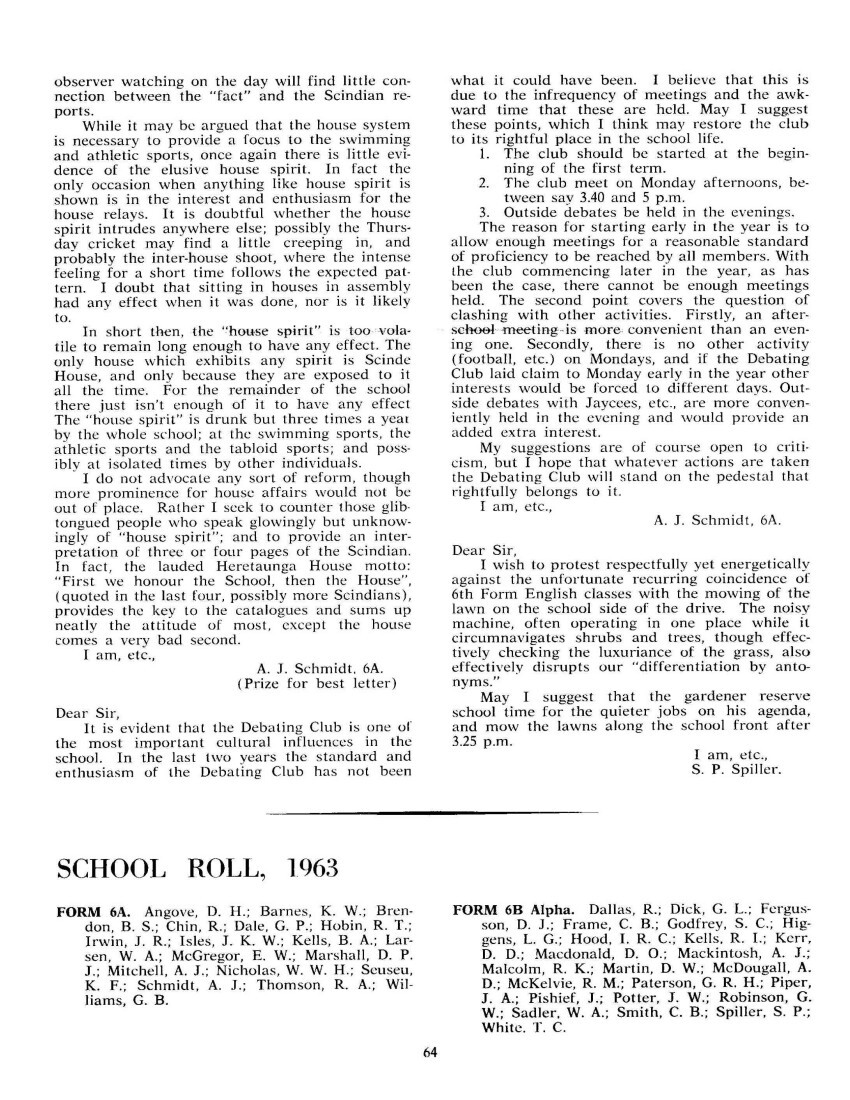
Page 65
FORM 6B Beta. Baudinet, B. R.; Cormack, D. W.; Dobson, N. W.; Ebbett, G. W.; Farquhar, R. W.; Ferguson, D. B.; Gardner, D. R.; Girvan, M. R.; Hook, G. B.; Jackson, N. T.; Kay, J. A.; King, R. L.; Lee, A. R.; Lum, C.; Morrin, T. A.; Piper, J. M. C.; Robinson, E. E.; Sherwood, R. H.; Sinclair, J. W.; Smith, T. A. Tolley, A. H.; Tuck, A. G.; Tucker, R. W,; Turner, W. E. D.; Turner, W. K.; Wilson, A. R.
FORM 6B Gamma. Campbell, I. N.; Chandler, H. A.; Chrystal, B.; Elmes, R. F.; Forrest, C. A.; Guy, J. B.; Hall, G. J.; Harvey, G. L.; Hing, K. R.; Jensen, M. L.; Johnson, K.; Kirby, G. C.; Liddell, G.; Loader, P. C.; MacLeod, J. D.; Picone, V. G.; Pritchard, N. C.; Stevens, K. E.; Thomas, F. C.; Turbitt, I. T.; Weston, K. C.
FORM 5S. Alford, E. A.; Campbell, K. S.; Campbell, L. J.; Carberry, R. J.; Clark, C. R; Crowley, R. M.; Delugar, J. T.; Dick, P. M. W.; Forsyth, J. G.; Herbert, S. C.; Johnston, G. O.; Lancaster, J. R.; Martin, R. H.; Masters, S.; McBeath, D. J.; McLay, D. L.; Moffitt, G. H.; Morrison, A. K.; Neville, R. D.; Nuttal, G. K.; Pearse, H. T.; Peddle, R. G.; Prince, J. O.; Prosser, H. W.; Riggs, A. K.; Simcox, R.; Simkin, D. L.; Simmonds, L.; Smart, T.; Taaffe, D. M.; Taylor, H. K.; Thornton, J. P G.
FORM 5A. Barlow, G. W.; Carney, P. R.; Cross, R. L.; Daley, B. W.; DeDenne, J. P.; Donaldson, I. K.; Eddy, W. D.; Exeter, G. L.; Exeter, J. D.; Harrison, B. H.; Harvey, G. J.; Hills, D. J.; Howell, M. J.; Lambert, M. L.; Mackay, G. A; McCorkindale, W. R.; McGhie, G. A.; Marshall, P. G.; Mellor, K. J.; Nation, S. I.; Peterson, R. L.; Pitt, W.; Rowe, A. J.; Scott, J. L.; Smith, A. P.; Tuck, P. J.; Tucker, B. W.; Vivieaere, J.; Wallace, K.; Willis, M. W.; Wilson, S. J.
FORM 5B. Armstrong, N.; Bell, V.; Cameron, K. J.; Connor, A. M.; Cottrell, R. V.; Hall, T. A; Hamilton, D. V.; Jamieson, A. S.; Johnson, B. L.; Karatau, L. H.; Kohlis, G.; Lambert, B. A.; Lawton, W. H.; May, J. L.; McDougall, B. A.; McLennan, T.; Mear, M. D.; Phillips, G. M:; Pritchard, A. P.; Rieper, V. J.; Rutter, P. A; Scott, G. J.; Scott, R. S.; Shearn, D. M.; Simpson, M. B.; Smeath, I. L.; Stevenson, G. C.; Sutcliffe, C.; Turner, B. D.; Westerman, R. D.
FORM 5C. Bell, R. H.; Braid, R. B.; Campbell, R. A.; Cleary, W. L.; Field, G. M.; Foote, N. D.; Gilray, I. J.; Hanlen, J. H.; Hay, D. J.; Hyde, K. J.; McBride, I. A.; Mackenzie, A. B.; Malthus, D. J.; Millar, D. M.; Monk, D.; Morrison, T. R.; Norris, M. J.; Pattison, E. D.; Perfect, B. F.; Raitt, G. R. W.; Simpson, A. J.; Steed, B. F.; Sutton, J. A.; Tennent, H. E. C.; Thorn- burrow, A. J.; Trafford, H. M.; Waterhouse, J. D.; Wiig, M. E. N.
FORM 5D. Armour, R. W.; Brown, H.; Coombes, G. R.; Dunlop, R. K.; Ennor, B.; Hewson, C. A. Y.; Holdsworth, G.; Hyde, E. D.; Jessep, R. C.; Jones, K. R.; Kinniston, R.; Lavery, J. A. Lawrence, B. J.; Lowe, B. B.; McGregor, F. J.; Nobilo, M. A.; Northe, G. D.; Pohio, A. J.; Pond, G. J. C.; Simonsen, G. R.; Skjottrup, D. A. B.; Slight, J. C. N.; Spence, G. R.; Stuart, G. E. C.; Van den Bemd, B.
FORM 5G. Agnew, J. R.; Avenell, D. J.; Alder, S. F.; Bassett, D. A.; Beattie, I. A.; Brown, P. D.; Castles, R. J.; Craig, F. R.; Davis, J. R.; De Denne, W.; Ferguson, A. R.; Gloyn, B. E.; Godwin, A. E.; Goulding, D. J.; Heremia, A.; Lincoln, J. J. H.; MacDonald, D. G.; McDonald, J.; Nant, R. H.; Neill, R. A.; Schofield, M. G.; Schofield, P. D.; Shearsby, C. B.; Sorensen, C. J.; Stephens, W. N.; Smith, D. M.; Walker, P. J.
FORM 5T. Anderson, P. J.; Ball, G. C.; Briggs, J. A.; Butler, K.; Doidge, H. A.; Exeter, T. C.; Heiford, R. L. H.; Jones, I. C.; Leslie, A. R.; Lyon, M. V.; Lyver, D. O.; Moody, R. O.; McClure, W.; McCutcheon, M. O.; Mitchell, A. M.; Overend, D. A.; Quinn, S.; Reid, P.; Sands, B.; Stimpson, P. E. F.; Vautier, R. E.; Wallis, R. H. J.; Wyndham, T. E.
FORM 4A. Archibald, W. I.; Bates, T. J.; Bishop, N. J.; Black, H. C.; Boardman, D. A.; Castles, E. M. J.; Dallimore, L. W.; Davis, T. K.; Denford, P. V.; Farmer, R. A.; Gempton, D. H.; Hopcroft, A. W.; Johnstone, K. L.; Knight, J. G.; Lee, C. J.; Lee, R. McL.; Lydford, G. R.; Mackintosh, B. L.; McSporran, M. D.; Moir, N. R.; Olsen, A. G.; Olsen, J. C.; Parker, A. J.; Paterson, R. J.; Porter, S. R.; Roberts, R. I; Romans, S. T.; Skews, T. W.; Stayt, J. P.; Thorp, N. F.; Vautier, E. W.; Wharton, T. A.
FORM 4B. Avers, M. E.; Bigg, G.; Bray, S. J.; Clark, C. N.; Dallimore, P. A.; Davey, T.; Donovan, R. E.; Gardner, C. B.; Gudgeon, M. W.; Heap, W. N.; Hunt, M. H.; Jackson, R. G.; Joll, C. C.; Kingi, S. M.; Langworthy, R. L.; Layton, M. W.; McIntyre, D. E.; McLaren, M. W.; Manning, L. R.; Martin, M. A. Munro, D. L.; Pawluk, R.; Read, W. B.; Reed, J. S.; Sawyer, M. K.; Scarrott, I. J.; Scholes, G. M.; Smith, P. R.; Thompson, N. S.; Tucker, R. K.; Weaver, G. H.; White, J. R.; Wiig, G. T.; Young, P. M.
FORM 4 Spec. Andrews, J.; Atkinson, B. D-.; Avenell, W. R.; Bell, R. V.; Bell, W. D.; Brock, N. D.; Brown, M. E.; Cameron, F. E.; Darragh, B. T.; Eagle, G. E.; Fahey, G. P.; Harvey, B. H.; Hill, C. R.; Hope, T. M.; Joll, B. H.; Karatau, E. M.; Lawrence, D. G.; Macdonald, G. J.; Manning, J. P.; Marshall, B. M.; Martel, R. D.; Matcheson, R.; Morrin, P. G.; Pearse, M. T.; Robertson, R. B.; Shuker, R. W.; Simonsen, D. L.; Single, K. R.; Smith-Holley, B. K.; Spain, D. R.; Svendsen, C. O. B.; Webster, N. R.; Yates, R. W.
FORM 4 Mod. Amner, W. E.; Bennett, L.; Bird, K. C.; Bishop, R. J.; Bourgeois, T.; Brooker, K. A.; Brown, B.; Brown, I. J.; Bull, M. B.; Bulled, E. G.; Burn, E. J.; Castles, A. T.; Chapman, N. C.; Cowdell, R. N.; Douglas, C. G.; Gillespie, B. J.; Hodgkinson, E. H.; Irwin, R. W.; Lane, M.; McMillan, J.; McTavish, G. A.; McVicar, A. J.; Martin, D. L.; Meaclem, R. O.;

Page 66
Munro, D. L.; Oliver, D. T.; Ramsay, D. P.; Rowe, A. R.; Schofield, B.; Sherriff, S.; Shipman, G. R.; Teihi, R.; Tutt, P.; Ware, L,; Williams, C. A.
FORM 4 Gen. August, W. P.; Bennett, E. A,; Blair, I. A.; Browne, D.; Campbell, E. K.; Clifford, W. J.; Crarer, G. M.; deGaris, N.; Duncan, B. M.; Earnshaw, G. R.; Glover, D. B.; Grant, G. D.; Hart, R. L.; Harwood, R. J.; Kenah, M. C.; King, D. T.; Martin, J. M.; McKay, I. D.; McGowan, A. J.; Montgomery, W.; Orr, M.; Phillips, S. R.; Puna, W. J.; Robinson, P. S.; Sherriff, C.; Simmons, E. R.; Stevenson, D. J.; Strachan, A. P.; Thomsen, R. H.; White, R. J.; Whitfield, S. R.; Wong, C.; Young, D.
FORM 4G. Alford, D. A.; Astwood, K. G.; Bray, R. M.; Brunton, C. G.; Campbell, N. T.; Clayton, R. R.; Davidson, D. B.; Ewart-Jones, D.; Ferguson, T. G.; Fraser, K. S.; Frogley, R. H.; Gordon, M.; Hapi, K. K.; Huata, J.; Kennerley, D. A.; Kyle, G. E.; Laing, D. J.; Le Quesne, R. J.; Lawrence, G. A.; Mackintosh, J. M.; McNicol, D.; Raku Raku, T.; Osborne, C. P.; Parker, J.; Read, D. S.; Rule, M. G.; Robertson, G. D.; Scrimgeour, R.; Sherwood, A. B.; Tong, R. C.; Treseder, R.; Wilson, J. R.
FORM 4P. Baird-Smith, R. W.; Basher, A. D.; Bergman, J. W.; Bicknell, D. J.; Bower, R. K.; Bullivant, P. K.; Bunce, P. D.; Coldicutt, D. E.; Cribb, T.; Christoffersen, O. N.; Dean, G.; Diack, K. R.; Dobson, W.; Fleming, R. S.; Harding, G.; Humphreys, R. W.; Johnston, G. J.; Littleford, W. E.; Martin, D. L.; McKee, P. C.: Meredith, D.; Mooney, C. J.; Otter, D. P.; Pedersen, I. L.; Reid, P. W.; Richards, A. A; Rooderkerk, C. R.; Sullivan, G.
FORM 3A. Bailey, R. G.; Baudinet, I. L.; Chapman, P. D.; Chittenden, A. W.; Chute, B. D.; Cook, S. R.; Cross, S. J.; Davidson, J. R.; Dixon, L. R.; Eastwood, K. C.; Exeter, P. R.; Forrest, R. B.; Galgey, G.; Halliday, M. M.; Harris, J. W.; Harrison, R. A.; Healy, J. R: Heath, J. M.; Johnstone, H. E.; Lemin, R. H.; Lemmon, N. P.; Leslie, P. G.; Longney, R. T.; MacEwan, D.; McIntosh, D. N.; Manson, B. R.; Pattison, R. A.; Pendlebury, W. J.; Pishief, S.; Revell, S. G.; Stothart, P. G.; Thomsen, C. C.; Tuck, R. A.; Waite, M. D.; Wright, R. H.
FORM 3B. Beard, P.; Bissell, J. J.; Bluck, M. V.; Chambers, G. N.; Clayton, E. K.; Curtin, S. W.; Donaldson, K. D.; Elliott, J. D.; Fearn, R. J.; Fenwick, D. N.; Girvan, W. K.; Godwin, S. J.; Greeks, G. E.; Gregory, R.; Harris, W. G. J.; Heays, K. H.; Jeffares, B. R. S.; Jones, R. A; Kyle, L. C.; Lee, M. J.; Lemmon, R. A.; Love, C. B. J.; McGregor, M. G.; Manning, K. A.; Merritt, D. J.; Mills, G. E.; Mortensen, B. N.; Pepper, L. F.; Pearse, P. T.; Pettigrew, K. J.; Rye, S.; Smeath, P. B.; Taaffe, B. J.; Worsnop, B. J.; Young, R.
FORM 3 Spec. Absalom, G.; Barrie, G. R.; Bramley, R. A.; Carroll, J. F.; Chatterton, R. P.; Chittenden, G. C.; Cook, I. D.; Dallimore, M.; Deakin, G. S.; Eddy, R. D.; Glockling, A. J.; Golds, A. R. R.; Goldfinch, R. W.; Harper, R. C. S.; Iremonger, R.; Lancaster, F.; LeProu, K. A.; Limbrick, B. J.; Little, D. J.; Lloyd, J. R.; Martin, G. R.; McIntyre, M.; Mills, W. F.; Mildon, D. A.; O’Brien, B. J.; Rattray, B. J.; Smith, J. H.; Spivey, A. G.; Stephens, W. G.; Thompson, S. H.; Tuck, G. R.; Vaughan, M. W.; Yee, A. K. C.; Yelverton, K. B.; Zame, T. P.
FORM 3 Mod. Addis, P. S.; Buchanan, A. G.; Cartwright, J. B.; Cowan, W. N.; Faulknor, R. R.; Ferguson, J. S.; Fuller, G. R.; Fisher, W. G.; Goulding, E. G.; Harwood, G. D.; Hazlewood, N. A.; Houkamau, J. H.; McCallum, P. T.; Maru, A.; Masemann, T. A.; Moore, J.; Marshall, S. C.; Neilsen, G. D.; Pryce, R. D.; Phillips, A.; Radford, A. P.; Ralfe, L. H.; Rid- dell, D. G.; Rongo, W. T.; Ross, M. J.; Sawyer, N. A.; Smith, K. S.; Smith, M. S.; Spence, P. J.; Symons, R.; Thessman, T. J.; Tuck, R.; Waide, R. A.; Wiig, B. L.; Wyndham, A. G.; Young, I. J.
FORM 3 Gen. Armstrong, D. J.; Barham, P.; Campbell, C. N.; Cavanagh, A. D.; Cullen, K. R.; Doole, D. J.; Dyer, K. D.; Eagle, K. W.; Field, P.; Gerrard, K. W.; Glock, L. R.; Hellyer, R. A.; Johnson, M. P.; Johnson, K. J.; Jones, E. D.; Karatau, D. G.; Kohlis, W.; Macdonald, S. J.; Macan, S. G.; Machin, R. B.; Maru, T.; Newham, P. E.; Parker, N. J.; Parker, S.; Redshaw, S. I.; Richards, E. L.; Robinson, K. A.; Sheeran, A. F.; Snaith, S. J.; Te Kira, R. W.; Thomas, T. D.; Turner, R.; Walker, C.; Warman, G.; Winkley, K
FORM 3G. Andrew, J. R.; Binnie, R. G.; Bolingford, D. C.; Bray, D. R.; Cave, I. M.; Cawston, N. P.; Christoffersen, A. A.; Curtis, D. L.; Elliott, D. S.; Elsmore, W. B.; Ennor, M.; Fraser, S. H.; Germain, G. O.; Herdman, K. J.; Houia, R. H.; Hunt, K. P.; Jenkinson, D. S.; Kennedy, Cc. H. K.; Masters, R. G,; Macaulay, N. L; Nichol, R. M.; Northe, P. R.: O’Donnell, T. J.; Richardson, L B.; Schofield, R. I.; Struthers, H. H.; Sutherland, M. J.; Weatherley, B. K.; Whatarau, E. R.; Winter, J. S.
FORM 3T. Brown, K.; Butler, T.; Coldicutt, G. C.; Dean, A. L.; Eden, B. H.; Flett, G. J.; Foster, J. E.; Gattsche, R. L.; Harding, R. A; Horton, S. R.; Jensen, A.; Marshall, B. S.; Miller, P. L.; McClure, K. D.; McKenzie, T. R. J.; MacLean, N. A.; Neill, R. B.; Rankin, D. J.; Skews, K. P.; Spooner, R.; Stephens, D. P.; Takiwa, W.; Uriarau, A. C.; Veale, G. S.; Walker, D. J.; Wilson, H.; Wong, M.; Young, S.
FORM 3R. Black, L. W.; Boardman, A. D.; Bond, B.; Buckley, I. K.; Bulled, G. O.; Chapman, A. D.; Collins, T. A.; Cunningham, E. G.; Fraser-Jones, A. D.; Gilder, C. G.; Gilder, G.; Gray, A. J.; Hawkins, J. O.; Hellyer, L. J.; McCutcheon, H. L.; Nicolls, M.; O’Brien, L. K.; Parker, W. A.; Porter, C. C.; Quinn, K. N.; Rae, M. A.; Reid, R. S.; Robottom, P. H.; Sellers, L.; Smith, W. D.; Tucker, R.; Uren, J.; Whip, P.; Willis, G.
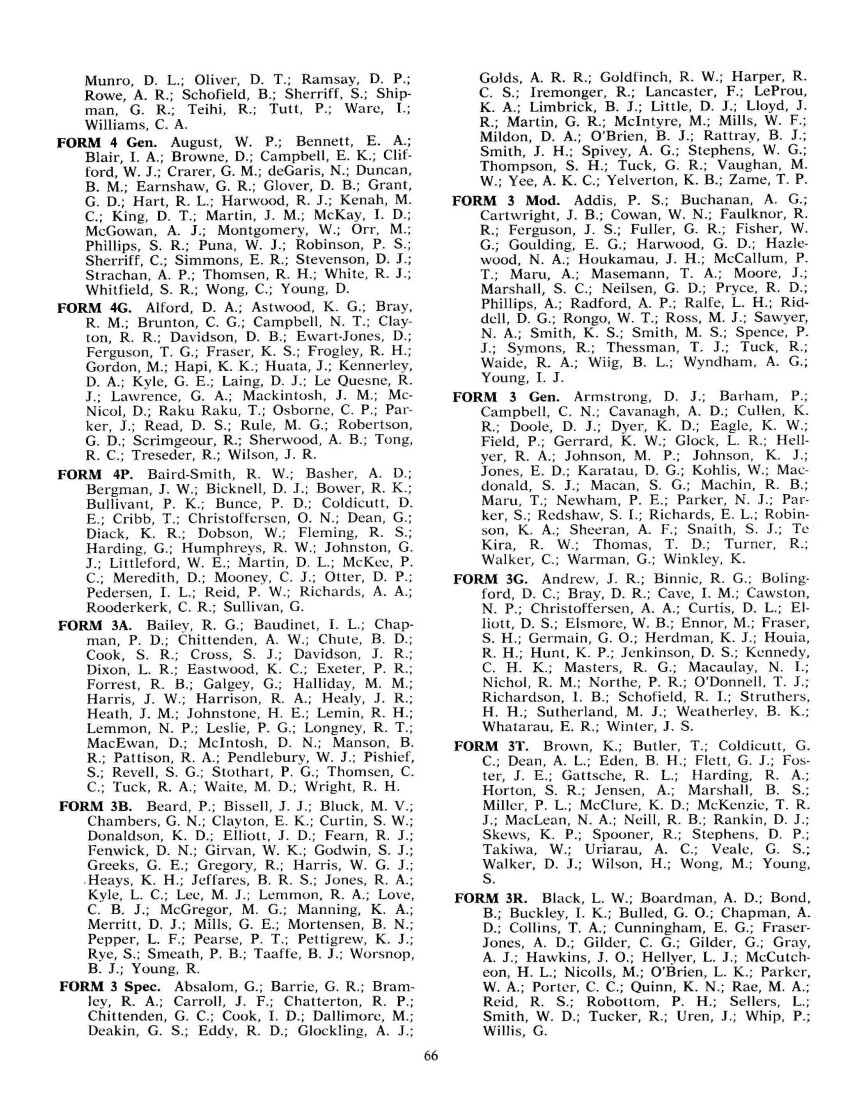
Page 67
OLD BOYS’ NOTES
1963 Executive
President: Mr. Clyde Jeffery; Vice-Presidents: Mr. Brian McKay, Mr. Neville Roach. Committee: Messrs John Gray, R. Clinton Holt, Brian Mahony, Doug. Scoble, John Struthers. O.B. Cricket Club Representative: Mr. Murray Wall. O.B. Football Club Representative: Mr. Barry Milburn. Auditor: Mr. Fred Sanders. Secretary-Treasurer: Mr. Len Morley.
Annual Meeting
The following new officers were elected at the 1963 Annual Meeting: Incoming Vice-President: Mr. Murray Wall; Elected to Committee: Mr. Len Morley, Mr. Alan Plested; Secretary-Treasurer: Mr. Murray Holland, Colenso Chambers, Emerson Street, Napier.
Anzac Service
At the school Anzac Service on April 24th, the Roll of Honour (Boer War and 1914-1918 War) was read by Mr. E. N. H. Stewart. Mr. Clyde Jeffery (President of the Association) read the Roll of Honour, 1939-1945 War.
Assembly Visit
Members of your executive attended school assembly on June 25th. Messrs. Jeffery, Holt, Milburn, Struthers and Wall conveyed the greetings of the Old Boys’ Association to the school, and later met the staff for morning tea.
Annual Dinner and Reunion
Sixty-two Old Boys enjoyed an evening of relaxation and talking over old times at the annual dinner and reunion, held in the Hawke’s Bay Club on Saturday, October 19.
Mr. W. W. Bate, barrister and solicitor, and former Mayor of Hastings, proposed the toast to the School. He paid tribute to the masters, and to the standards set by the school.
Mr. H. A. Henderson replied to the toast, showing very evident attachment to the School and to all associated with it.
Wing Commander G. L. Stedman proposed the toast to Kindred Associations, and Mr. H. Heaps (Nelson College Old Boys) replied.
Mr. E. N. H. Stewart proposed the toast to Absent Friends.
Jubilee 1972. The Old Boys’ Association has adopted the Centenary Project of erecting a combined grandstand, pavilion and changing rooms on the School grounds. The new Executive is to consider ways and means of raising finance for this Old Boys’ contribution to the School Centenary. Donations are appealed for, and these may be sent to the Secretary, Mr. M. W. Holland, Colenso Chambers, Emerson Street, Napier.
Wellington Branch. At the reunion this year of the Wellington Branch there was a very good muster of over 70. Mr. L. A. Meads, 11 Pitarua Street, Wellington, is secretary. On this occasion, July 20, Old Boys who are university students at Vic. bade farewell to Mr. Henderson, who was present.
Palmerston North Branch. The next reunion is due on the night of the Polson Banner Match, 1964, which will be held in Palmerston North. The organiser of these pleasant functions is Mr. Bernie Whitehead, Public Accountant, Palmerston North.
GENERAL NEWS AND NOTES
Ian Axford is Associate Professor of Astronomy at Cornell University in the United States.
Teddy Bennett, now married to “Miss Gold Coast,” is still singing for an income in Australia. He says he is coming back to New Zealand next year.
J. E. Berry, B.E., has gone to work at Broken Hill, Australia.
Graeme Buist is at the Adolescent Dental Clinic, Invercargill.
Warwick Bull is Assistant Engineer to the Horowhenua County Council. Jim Burton. Congratulations to this World Champion archer.
Mr. T. R. Clarkson, assistant chief engineer of the N.Z. Post Office, called on Mr. Henderson on November 10 and donated £50 to endow a special prize in applied science. He explained that he won the School’s Henry Hill special prize for interest in applied science in 1923. This was an incentive which encouraged him to embark on his highly successful career in Telecommunications. Mr. Clarkson has visited the South Pole, fulfilled a Unesco Mission in Malaya, and attended world conferences. He recalled contemporaries of his at school, John Fullarton of New Plymouth, and Dr. Henley of Auckland.
P. B. L. Crisp, with B.A. degree competed, has been working for the N.Z.B.C. in Napier this year.
John Cullen is a house surgeon at Palmerston North and a N.Z. hockey representative.
E. S. Diack is now teaching at John McGlashan College, Dunedin.
Major I. R. Diggle, M.B.E., R.N.Z. Artillery, who went from the school to Duntroon in 1942, has been appointed Chief of Staff, Northern Military District.
Robin Douglas, civil engineer at Otematata since 1958, has left on a travelling scholarship tor study overseas.
Harold Fownes, former President of the Wellington Old Boys’ Branch, spoke in school assembly on October 14.
Mr. Rodney Gallen, Napier Barrister, returned to school to judge this year’s debate with Palmerston North High School.
Mr. Les. J. Goodall has been appointed to Amalgamated Brick and Pipe Company, Wellington, and is now living in Tawa.
Group Captain Colin Gray, an old boy of the early 30’s, was guest speaker at Napier’s Anzac Service this year. Colin is now employed at Lever Bros., Lower Hutt.
Mr. John Gray (1963 O.B. Committee) has joined the Merchant Navy and is working on a vessel running to North America.
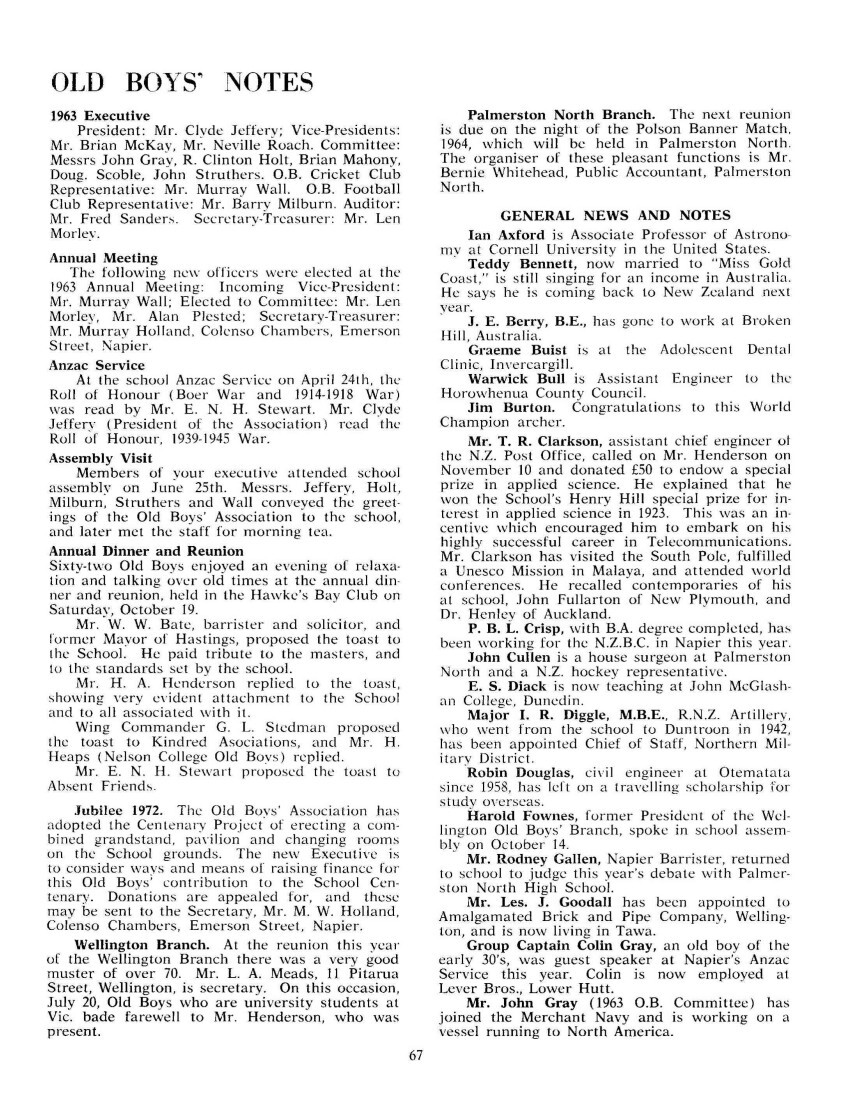
Page 68
Jim Haskell is second-in-charge of operations for Spanz in Auckland.
Don Henderson is a dental surgeon at Dunedin Public Hospital.
Mr. Ken Hodgkinson, M.Ag., is at the University of Armidale, Australia.
Mr. Murray Holland, 1964 Secretary of the O.B. Association, is a dental surgeon in Napier.
Jim Howell is working in the Department of External Affairs, Wellington, and studying part-time at Victoria University.
Graeme Leadbetter is now teaching in England.
Mr. Brian McKay, 1963 Vice-President, is partner in Denton, Denton and McKay, Public Accountants of Hastings.
Mr. Barry Milburn, who lives out near Waimarama, is not deterred by distance from supporting meetings of old boys.
Mr. Len Morley has been appointed secretary of Stewart Greer Motors Ltd.
Andrew Pawley, Auckland University-trained anthropologist, has been studying Pacific languages in New Guinea and Hawaii.
Mr. Alan Plested, junior executive at Rothmans, has been on a business trip to South Africa.
Dr. H. D. Purvis is doing exceptionally well in the advance of the medical profession.
Cricketer H. E. I. Reaney was ordained in St. John’s Cathedral on March 24, 1963.
Peter Riden is teaching at Te Karaka, and standing as Labour candidate for Bay of Plenty.
Brian Rittey is working for BP and attending Canterbury University part-time. He hopes next year to join the R.A.F.
Mr. Neville Roach, farmer at Korokipo, spends a lot of time for the school as a member of the Napier High School Board of Governors.
W. E. Rose is secretary of the United Nations Association, New Zealand.
Mr. Fred Sanders is a master accounting machine salesman for Burroughs, and auditor of the O.B. Association, but he doesn’t seem to have found a machine for that.
N.Z. Test Batsman Michael Shrimpton won this year’s H.B. Trophy for the most outstanding player under 23.
Colin Simmonds headed this year’s graduation list at the R.N.Z.A.F. Boy Entrants’ Training School, Woodbourne.
Former All Black Dick Steere was one of the guest speakers at a combined association function. He told of exciting moments of his recent world trip. He is living in Hutt Valley and still vitally interested in the question of scrum formation.
Mr. John Struthers, 1963 member of O.B. Executive, is going up near Taihape to further his farming experience.
Congratulations to Kelvin Tremain, former Scinde House Master, upon his selection for the All Black Team. He received a farewell from the school on September 25th.
Mr. Murray Wall has gained public account. ant status in the firm known as White and Wall.
Eddie Whatarau is teaching in Southern Bay of Islands.
Mr. P. J. Wishnowsky, Otorohanga, is leaving in December, 1963 for Edinburgh, Scotland, there to stay for an indefinite period.
Auckland University:
A. Ross is doing 1st year science subjects. G. A. Chappell passed his 1st year law exams. C. R. McKenzie, A. Collow, and L. S. Goldsmith passed three science units in 1962, and are taking three more units in 1963.
Ardmore Teachers’ College:
In their first year are: T. Daly (2nd Hockey XI), D. Macfarlane (1st Cricket and Hockey XI’s), B. Tasker (1st Hockey XI, Harriers Team, Choir), A. Smith (College Jazz Club), J. Barker (1st Cricket and Soccer XI’s (1st Cricket and Soccer XI’s, Senior Soccer Referee).
In their second year are: D. Alexander (1st ket and Soccer XI’s) Senior Soccer Referee). Hockey XI, Tennis Team), B. Liddell (1st Cricket XI), D. Hyde (Drama Club), D. Lennox, G. Cowie, (Athletic Team). This year’s Men’s President is A. Reedy (1st Rugby, Tennis, and Table Tennis Teams).
Canterbury University:
In their second year of B.Sc. are L. Purchas, T. Wharton. Axel Blom (violinist in Christchurch Civic Orchestra and the National Youth Orchestra) and M. Bowling took 1st year science subjects. Budding engineers are: J. Millar (final year), G. Harrison (2nd Professional), B. Tuck (1st Professional) and T. Wong (Engineering Intermediate).
J. Bluck, (2nd year for B.A. studies) was a member of the Debating Team and selected for the N.Z. Universities’ Debating Team. R. Kohere is at Christchurch Teachers’ College.
Massey University:
Doing Stage I English extra-murally are: D. Macfarlane, T. J. Barker, and B. Liddell.
Otago University:
Mike Cotter and Rex Bartlett are well advanced in dentistry.
Peter Martin is in his final year at the Medical School. Paul Berry (O.U. Tennis Rep.), Trevor Young, Arthur Young, Andrew Campbell and Doug. Knight are at various stages of their way through the Medical School. Gregory Campbell is flatting with his brother and studying Law.
Ian Dean, Doug. Callaghan and George Ngaci are completing their Medical Intermediate Year. The two latter are in the same 2nd grade rugby team.
Keith Sawyers is studying English at M.A. level, while Nicol Macfarlane and David Jackson are studying for B.A.
Roger Wiig, David Carmichael and Rex McIntyre are all at Knox College as Divinity students.
Kim Morgan is at the Phys. Ed. School.
Victoria University of Wellington:
Peter Tong and Kerry Irwin are working for LI.B. Malcolm Walker is progressing towards the degrees of B.A., LLB.
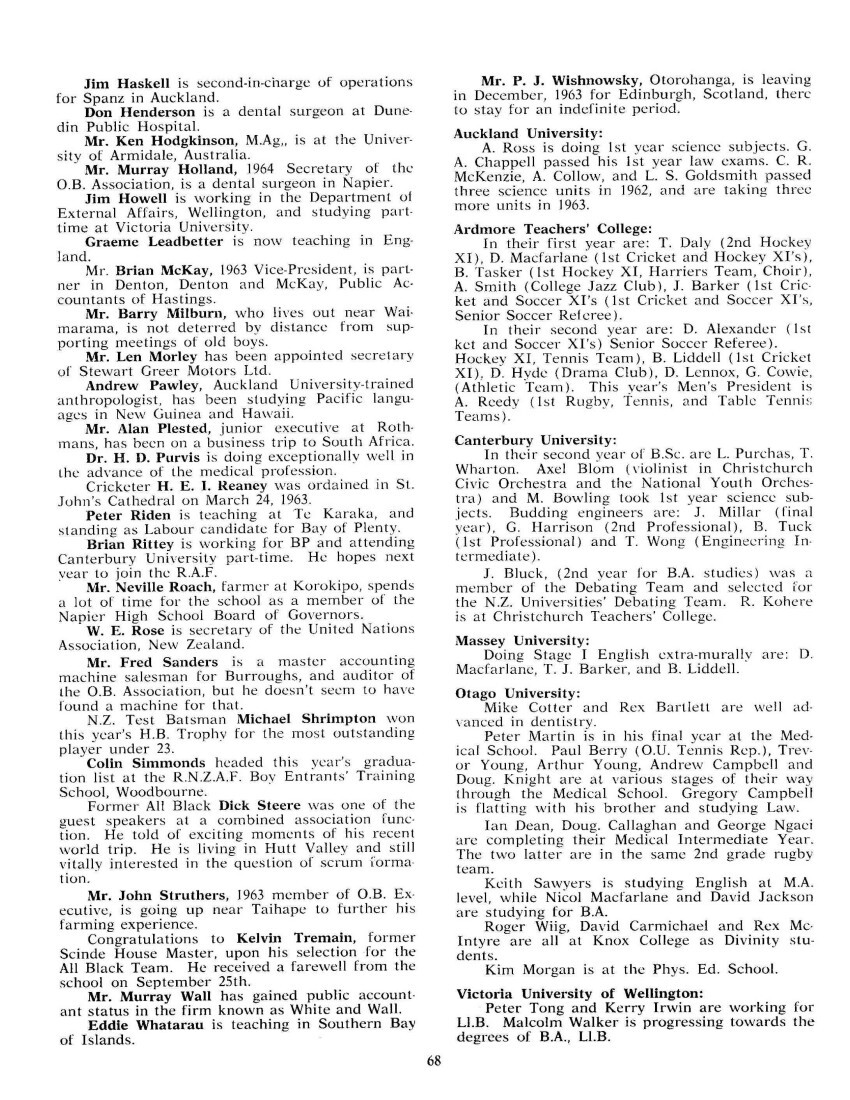
Page 69
David Hill is working on his M.Sc. degree. Colin Eagle and Jim Ansell are completing their B.Sc. Degrees. Gary Hawke is “passing units with frightening regularity”’ to complete his BA., B.Comm. degrees.
OLD BOYS’ CRICKET CLUB
Club Captain Tom Reaney this year completed his 40th season in senior cricket. This bowler of in-swingers, when he was a fourth former at school in 1924, was selected for the 1st XI. At that time it was playing in senior cricket. As the veteran of the side, Mr. Reaney gives wonderful encouragement and help to younger members of the team, many of whom were in the School 1st XI comparatively recently.
Last season the senior team, ably led by Brian Spooner, won the inter-town competition for the first time in approximately 25 years.
Outstanding players coming on (most of them old boys) are: John Howell (now teaching at Nelson Park School), Bob Husheer, Roy Clement, Robin Schofield, and Dennis Irwin.
OLD BOYS’ FOOTBALL CLUB
Four members of the senior team have been in the news this year. Kelvin Tremain is away with the All Blacks. Gordon Love was very close to inclusion with the All Blacks, and must surely have been considered had any of the team fallen out through injury in the course of the tour. Barry Neill has been playing as good football as ever, and played as a trialist in the early and late trials. Rod Abel played in the early trials for the N.Z. team to play against the touring English team.
Among the younger players were Ian Bishop and Doug. Curtis in their first year of senior football. Jan Bishop played extremely well and his thigh injury alone prevented him from claiming the position of H.B. full back. Doug. Curtis made the Napier Rep. Team.
The Senior Team was runner-up in this year’s competition, and the fifth grade team won their competition.
Mr. Bruce Hawkins is the Club Captain, and Mr. Pat Magill the Club President.
OBITUARIES
Mr. William Douglas Corbett, E.D.
A foundation member of the O.B. Football Club in 1910, Mr. Corbett died in July, 1963.
He was a member of the 1st XV at school, the first secretary of the O.B. Football Club, and later a life member. Besides this, Mr. Corbett was chief field events judge of the Napier Amateur Athletic and Cycling Club from 1926 to 1939, and a keen member of the Bluff Hill Bowling Club.
Mr. Corbett’s working life was spent in close association with Napier, as a surveyor, town planner, and engineer. When Napier was declared a city, Mr. Corbett became first city engineer.
Dr. James Allan Berry, M.S.
Dr. Allan Berry, a distinguished surgeon and brother of the present chairman of the Board of Governors, died this year.
While at school, he was a member of the 1st XV, and later a foundation member of the Old Boys’ Football Club.
He was medical superintendent at the Napier Public Hospital, and on his retirement volunteered to be a medical officer in the Pacific Islands.
Mr. Charles Cornwall Sorrell
A prominent lawyer of Napier, and keenly interested in Old Boys’ affairs, Mr. Sorrell died in May, 1963.
After leaving school in the post-World War I period, he joined a legal firm in Napier, and later became a partner in the firm. For some years he was President of the Old Boys’ Football Club. He was also keenly interested in Old Boys’ Cricket.
Mr. Dudley Walker Ashcroft, M.B., Ch.B., F.R.C.S.
Dux of the school in 1921, Mr. Ashcroft died in Sussex, England, on May 7th. His father, Mr. Peter Ashcroft, presented the Ashcroft Cup.
Mr. Ashcroft was a well-known doctor in Britain. For a time he was a lecturer in the University of London, and later a senior consultant surgeon at the Westminster Hospital. Mr. Henderson had the pleasure of welcoming Mrs. Ashcroft and Dr. Ashcroft’s son at the school on August 19th.
Mr. George Ian Bickerstaff, N.Z.I.C.S.
Mr. Ian Bickerstaff was at school 1929-1934. He was a prefect and an outstanding athlete. He became captain of the N.Z. Secondary Schools’ Athletic team which competed in Melbourne at the 1934 centenary games. He won the Ashcroft Cup and three times won the Old Boys’ Challenge Cup, while at school.
Mr. Bickerstaff served on the Old Boys’ Association Executive, O.B. Football Club, H.B.-P.B. Athletic Centre and the H.B.-P.B. Swimming Centre. He was honoured for his service with the St. John Ambulance Assn.
At the time of his death, he was an accountant with the Maori Affairs Department in Rotorua.
We extend our sympathies to the relatives of the following Old Boys who passed away in 1963: Mr. Ian D. Balfour, Mr. Stanley Bennett, Mr. C. D. Cornford, Mr. H. G. Harvey, Mr. A. D. McCleland, Mr. A. M. McMillan, Mr. N. R. Rolls, Dr. R. V. Shaw, Mr. F. C. Twigg, Dr. J. W. Wray.

Page 70
[Advertisement]
GOING TO UNIVERSITY?
YOU will hear of the …
WORLD UNIVERSITY SERVICE
By organising collections and work-days in New Zealand Universities, this international student welfare service gives assistance to students in less fortunate parts of the world.
W.U.S. has …
PIONEERED STUDENT HEALTH SERVICES, HOSTELS AND STUDENT RESTAURANTS.
AIDED NEEDY AND DEVASTATED UNIVERSITIES WITH EQUIPMENT AND MONEY.
W.U.S. (New Zealand) is backed by…
N.Z. UNIVERSITY STUDENTS’ ASSOCIATION.
STUDENT CHRISTIAN MOVEMENT,
INTER-VARSITY FELLOWSHIP, CATHOLIC SOCIETY.
WORLD UNIVERSITY SERVICE
will welcome your efforts
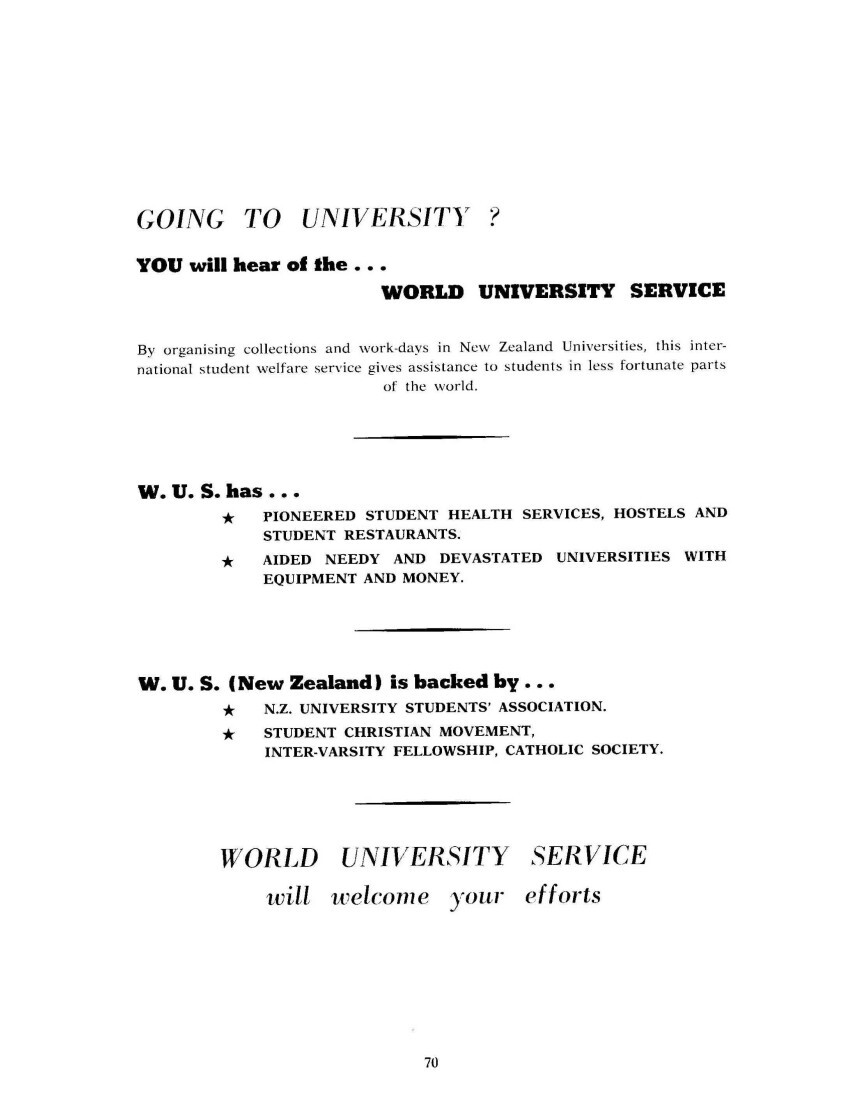
Page 71
[Advertisement]
Pioneer Coaching College
Coaching in Additional Mathematics
PARENTS ! Will YOUR child be at the 1964 accrediting party? Will he be able to attract the opposite sex with his U.E. diploma?
Don’t you love your child in spite of his low ability ?
Don’t risk his failure …
. . .he may commit suicide
Remember – the less you do for him, the more he is likely to do himself (in). Highly popular Mathematics classes are far too crowded for your child to get a fair share of attention. Secure expert coaching for your child in Additional Mathematics!
OUR THREE COACHES ARE ALL HIGHLY ADDITIONAL !
ALL THREE ARE EXPERTS IN ADDING !
(WE HAVE THE USE OF THE SCHOOL ADDING MACHINE)
ACT NOW FOR 1964
INDIVIDUAL COACHING: ANY NUMBER TAKEN AT ANY TIME !
FEES: £1 per hour (we cane free!)
Apply French Department, Rooms 1, 6, 7.
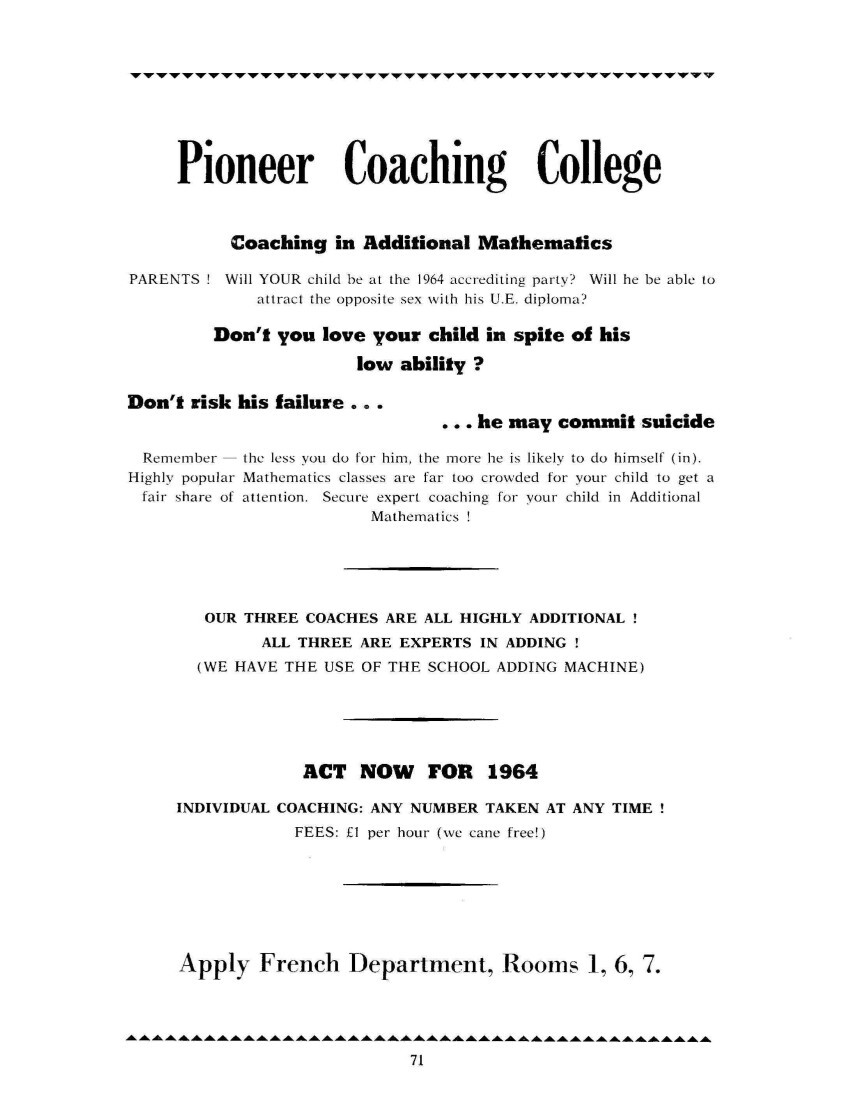
Non-commercial use

This work is licensed under a Attribution-NonCommercial 3.0 New Zealand (CC BY-NC 3.0 NZ).
Commercial Use
Please contact us for information about using this material commercially.Can you help?
The Hawke's Bay Knowledge Bank relies on donations to make this material available. Please consider making a donation towards preserving our local history.
Visit our donations page for more information.
Description
[List of names in this title still to be added – HBKB]

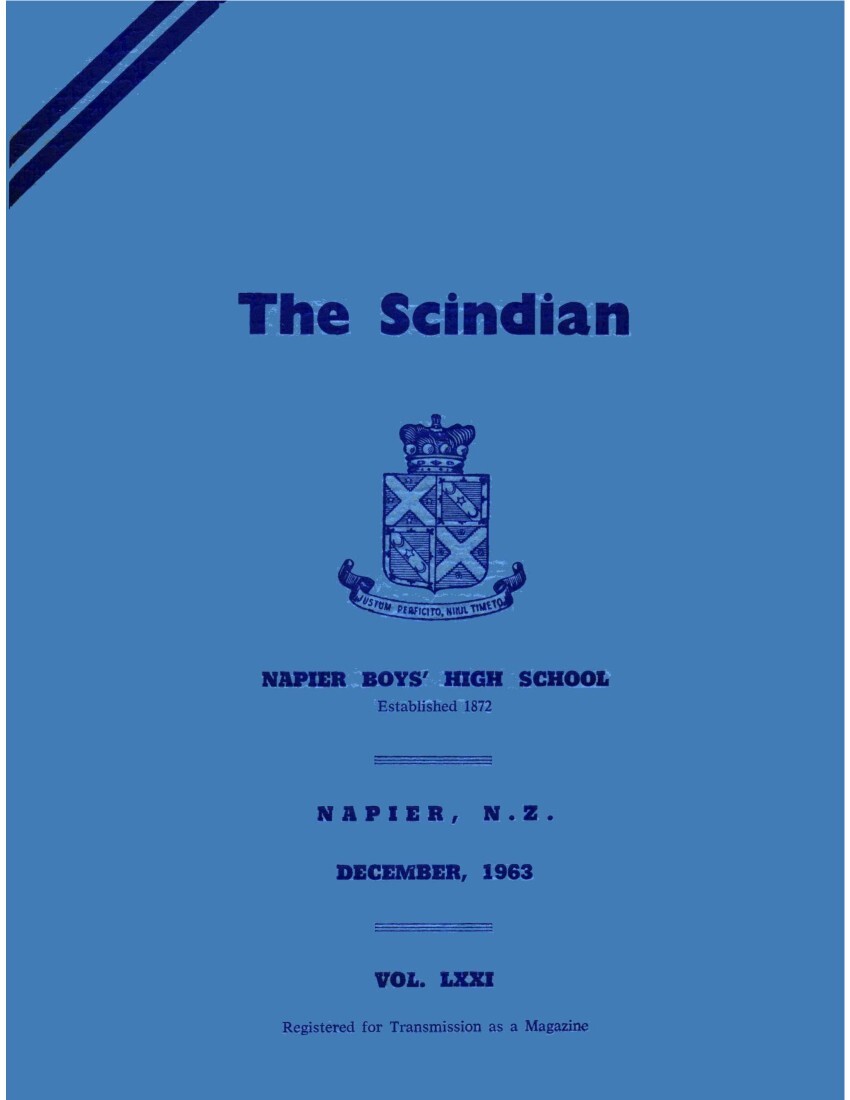

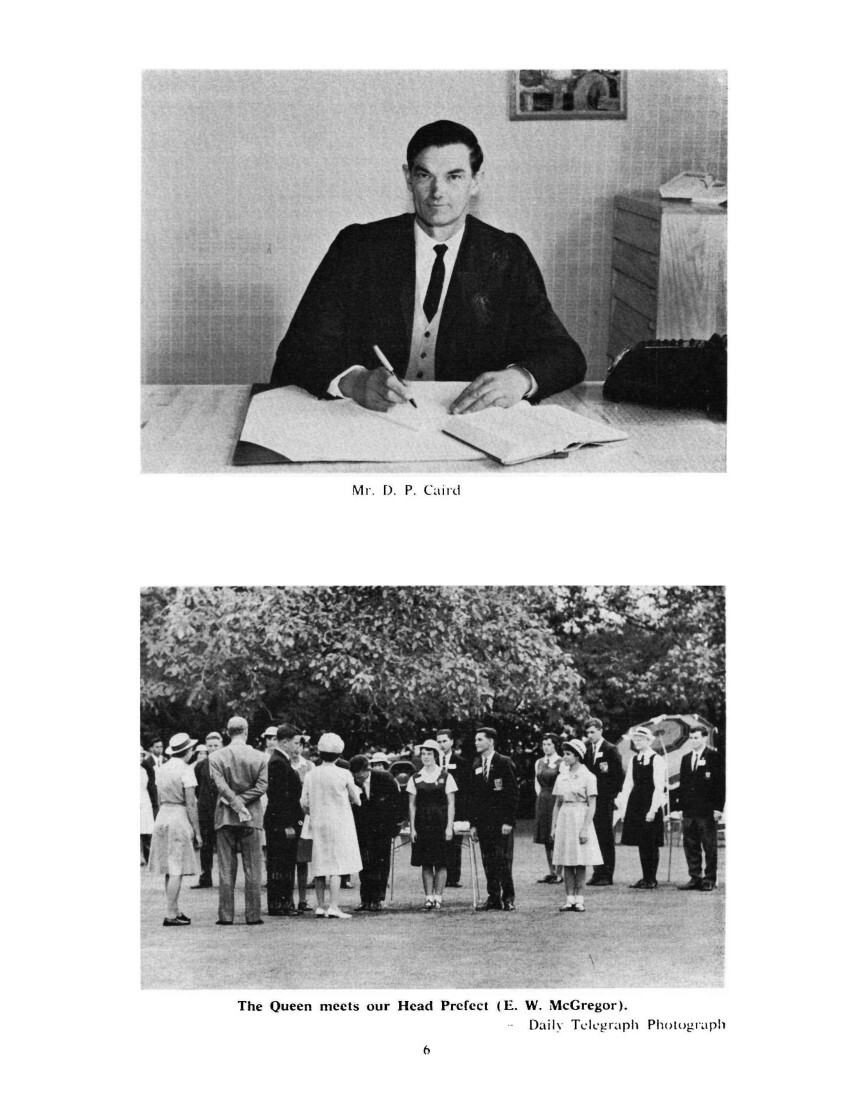

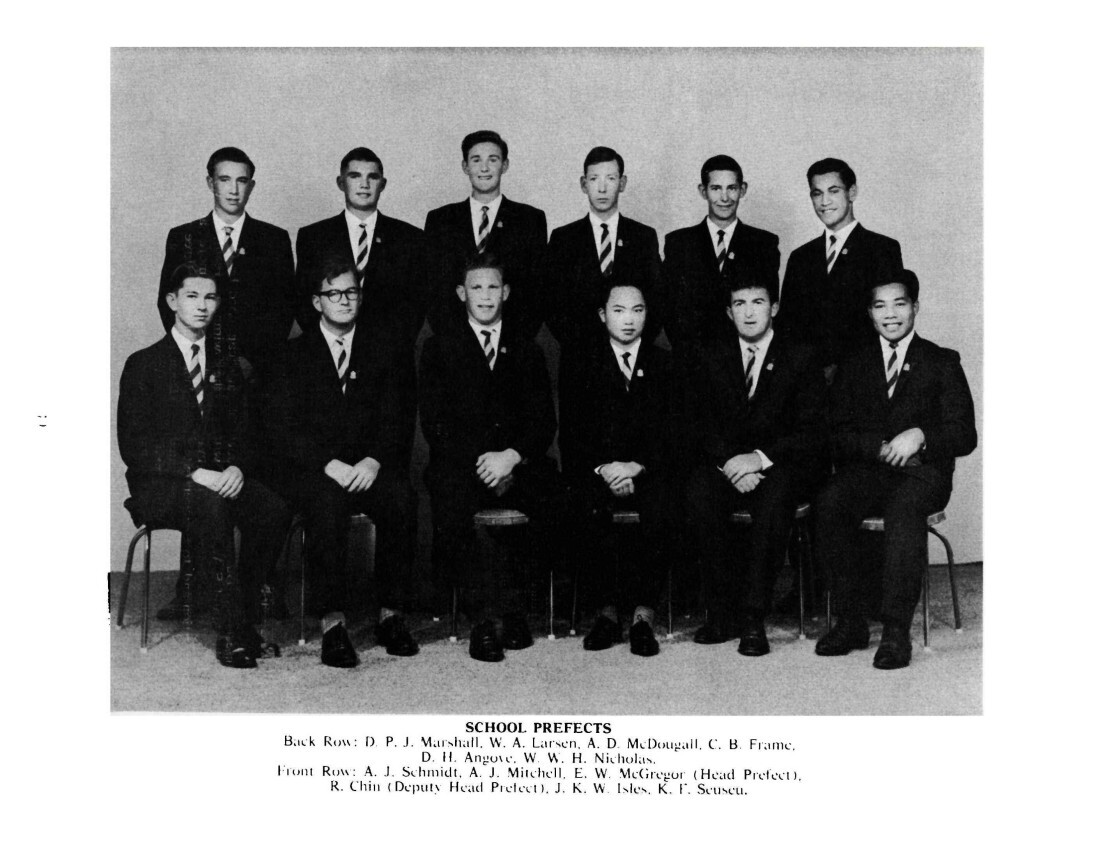
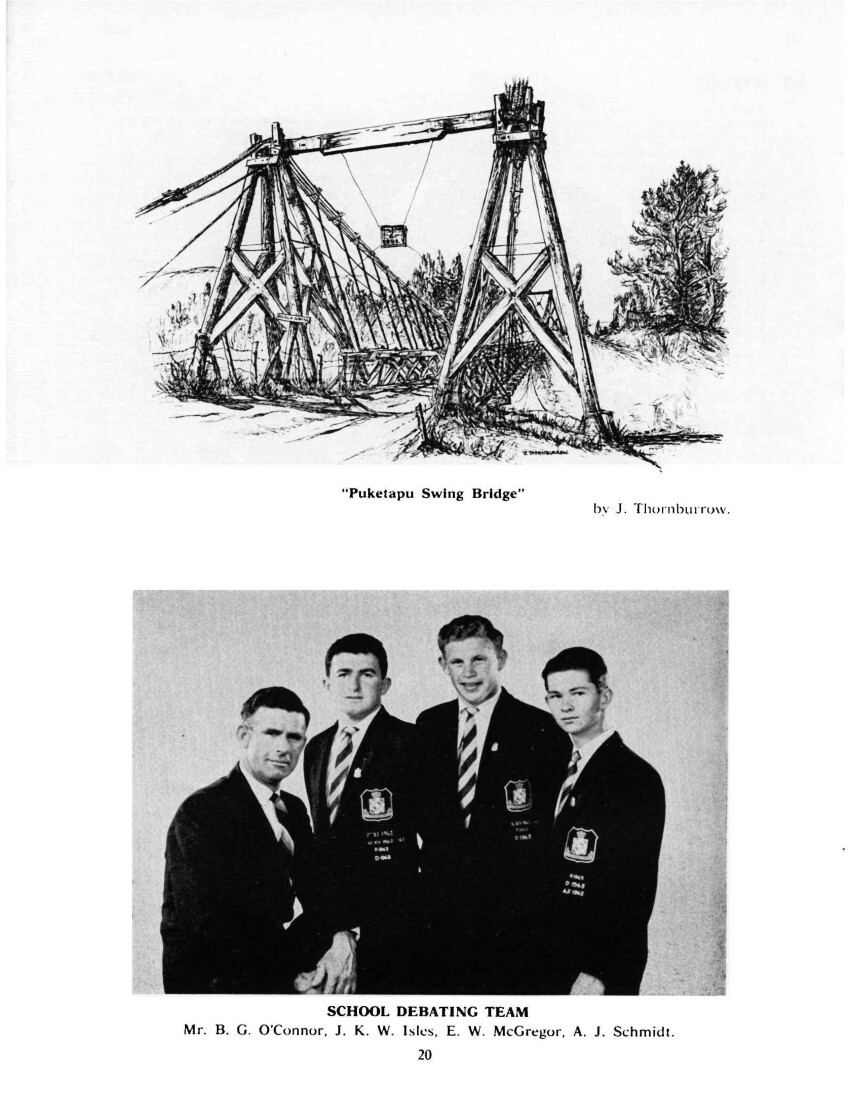
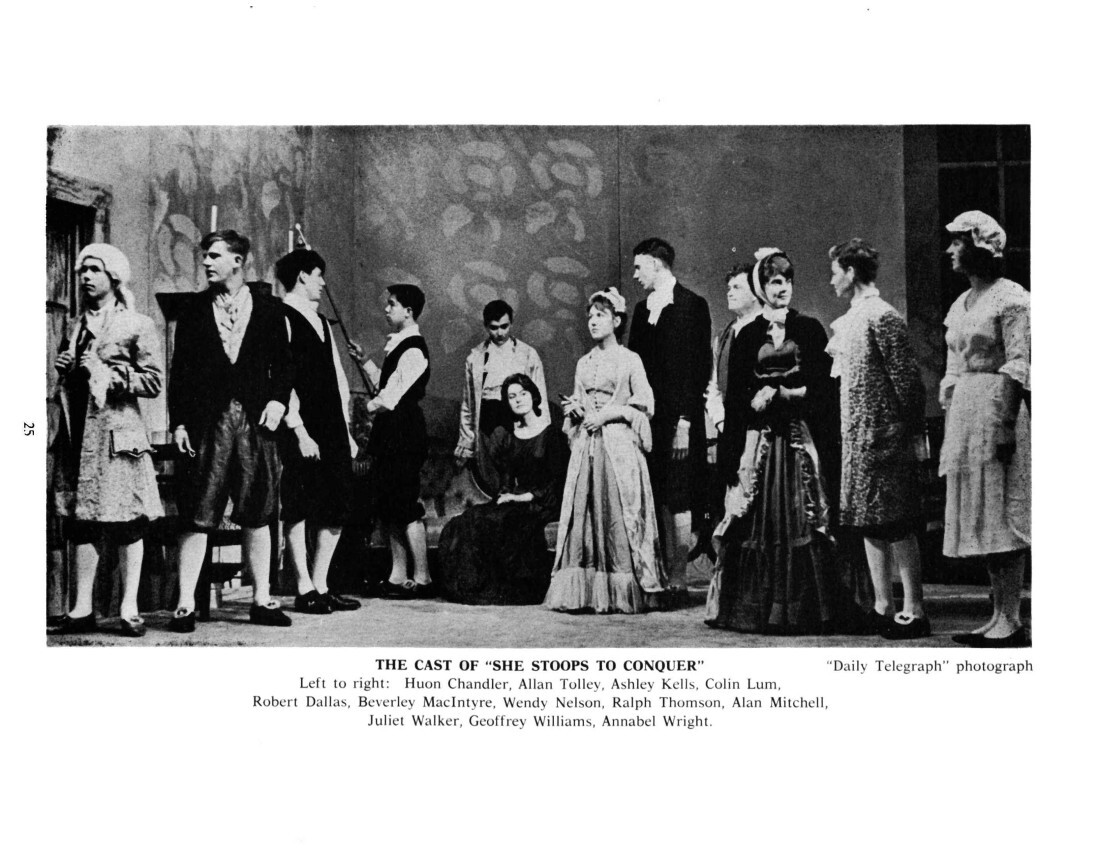
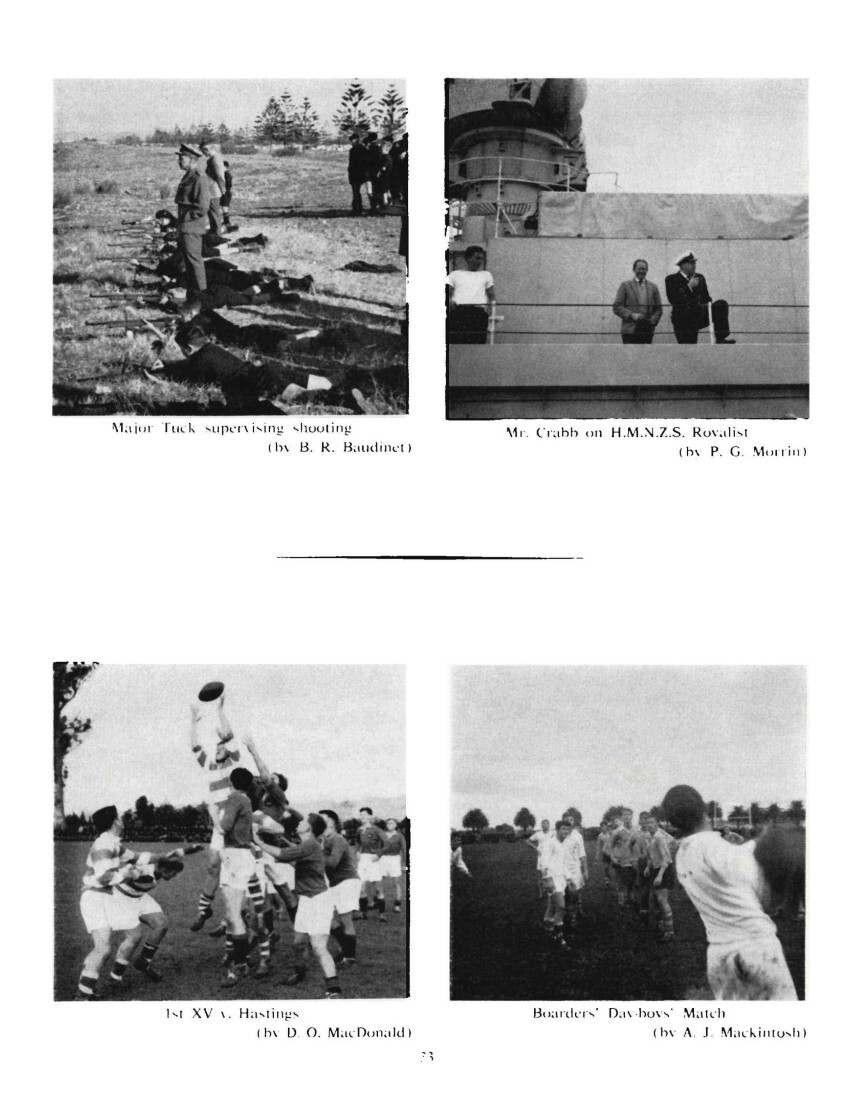











Do you know something about this record?
Please note we cannot verify the accuracy of any information posted by the community.